Going Awesome Places
Detailed itineraries + travel guides

6 Day Smoky Mountains Itinerary – 2 States & 1 Grand Adventure
Last Updated March 15, 2024 William Tang
You are here: Home » Travel Itineraries » 6 Day Smoky Mountains Itinerary – 2 States & 1 Grand Adventure
The legendary Great Smoky Mountains National Park conjures up images of classic blue silhouette of mountain ridges, black bears, elk, and rolling waterfalls. The national park spans both North Carolina and Tennessee and makes for quite the epic road trip. The question is, what’s the best way to do it?
With this 6 day Smoky Mountains itinerary, you’ll gain inspiration for how to make the most of a trip that covers both states and includes the best places to see, do, eat, and stay for those with an adventurous spirit.
What You’ll Get Out of This Article
- Day-by-day breakdown of the itinerary.
- Critical details for important activities and sights.
- Google Map of all locations on the itinerary.
- Access to a Google Sheet itinerary spreadsheet.
In This Article
What To Know Before Planning Your Road Trip
How to get around the great smoky mountains, how to use this smoky mountains itinerary, 7 driving tips for exploring the smoky mountains, best time to do this road trip, map of smoky mountains itinerary, itinerary day 1: north carolina – charlotte to waynesville, itinerary day 2: north carolina – valley and dome, itinerary day 3: north carolina – raft and rail, itinerary day 4: north carolina & tennessee – waterfalls, mountains and zorbs, itinerary day 5: tennessee – roaring and pink, itinerary day 6: tennessee – peak to peak, what to pack for a smoky mountains road trip, closing thoughts, frequently asked questions, read more about travel in the usa, learn how to save money on travel, travel resources for your next trip, great smoky mountains road trip guide.

The Great Smoky Mountains National Park is the most visited of all of the US national parks but for someone that’s never been there, it’s a daunting task to put together an itinerary, especially when you only have 6 days to work with.
If you love the outdoors, beautiful landscapes, wildlife, and exhilarating adventure, this one’s for you!
There are probably a million ways to see the Smoky Mountains.
Something you’ll learn is that most road trips will include a combination of the Great Smoky Mountains National Park itself and the surrounding towns and cities that flank it on both sides of Tennessee and North Carolina.
Since there’s so much to see, do, eat, and stay in the region, you’ll have to pick and choose what you want to do. Much of it will depend on your travel style, your group, the number of days you have, and how much of the national park you want to do versus the periphery.
As we’ve mentioned, this Smoky Mountains itinerary is meant to be guide for a trip that someone real has actually done, to give you an idea of one way to plan a trip here.
To help put this together, we employed our art of planning trips as a way to visualize the trip and stay organized. Keep reading to find out how you can get access to the 6 day Smoky Mountains itinerary spreadsheet.
Like most, if not all national parks in the United States, The Great Smoky Mountains and its surroundings are best explored by car.
This means that your best bet to getting around here is to come here by your own car if you’re doing a much larger road trip through the US or simply rent a car.
The easiest way to rent a car is to pick it up at the airport you’re landing in. The two major airports are Knoxville, Tennessee (TYS) and Charlotte, North Carolina (CLT). You can either book a one-way car or round-trip rental.
Looking for deals on car rentals?: The secret to saving money on rental cars are these car rental coupon codes . We’re talking about hundreds of dollars of savings so don’t miss out.
For those that don’t drive, there are a couple of options that you can look at:
- Base yourself in North Carolina (i.e. Waynesville, Bryson City) and do day trips.
- Base yourself in Tennessee (i.e. Gatlinburg, Pigeon Forge, Sevierville) and do day trips.
- Book a guided Smoky Mountains tour .
As with all of our detailed itineraries such as our 9 day Northern California road trip , 2 days in Istanbul , 8 day Iceland itinerary , 3 days in Kauai , and others, our goal is to share as much detail as we possibly can so you can be as prepared as possible.
That said, everyone is going to want something a little different with this Smoky Mountains itinerary so use this as a a place to start and adjust from there.
Where we’ve been able to, we provide alternatives and other recommendations for things like accommodations, activities, tours, and restaurants.
For this road trip, we arbitrarily decided to start in North Carolina and end in Tennessee but you could easily do it the other way around.

As you start planning your epic road trip, it’s worth noting a couple of things when it comes to driving around the Smoky Mountains:
- Rent from the airport – If you’re flying in and out of the region, you’d be better off renting from the airport than trying to find a city location. This would be a lot more efficient than having to find ways into and out of the city.
- Gas up often – Trust me, you don’t want to run out of fuel while in the national park or in more rural areas. A good rule of thumb is to fuel up when you’re at half gauge.
- No tolls – We’re happy to report that there are no tolls to speak of in and around the Great Smoky Mountains so there’s no need to stress here. To be doubly sure, make sure to turn off toll routes on your navigation app.
- SUV is a great idea – This isn’t mandatory but there are a lot of steep winding roads in and around the Smokies and not all of them are paved. Getting around in a compact sedan would be fine but we did enjoy having the extra confidence of the SUV.
- Many single-lane roads – There were a lot of rural roads that reminded us of our road trip in southern Ireland where the hedges went straight up to the road and the opposing traffic were too close for comfort. That was the easy part. On some of the roads you’ll find in the national park or winding up/down to a cabin, you’ll be faced with single-lane roads that also feature hairpin turns and steep drop offs on one side without guard rails. Make sure to drive safely.
- Watch for elk – Elk aren’t shy and will hang out near or on the roads so be alert, especially when you see the yellow elk warning signs.
- Pre-save points of interest – There is no cell service and hence no data in the entirety of the national park. For ease of mind, it’s worth saving pins on your Google Maps app and also make your maps available offline .

We’re not blowing any smoke here! The truth is that the Smoky Mountains National Park and both sides of North Carolina and Tennessee are amazing all-year round. It really depends on what you’re looking to do and see.
A better way to put it is that there isn’t a wrong time of the year to come to the Smokies.
One of the nicknames of the national park is “Wildflower National Park” and that’s because in the spring time, 1,500 different flowering plants bloom. The lush green foliage combined with the rainbow of colours from all of the flowers is a sight to see and an incredible opportunity for photographers.
Snowmelt and rain also means that the waterfalls will be full and gushing with water.
Wildlife wise, this is calving season for elk so you may be able to spot their babies. Spring is also bear season where they start emerging from their dens and coming out of hibernation. This happens between late March through early April.
The Great Smoky Mountains National Park has a great page on black bears that you should definitely read.
The weather is quite cool throughout the season and you’ll be faced with unpredictable rain but the benefit is that there’ll be fewer crowds and lower lodging prices.
The summer months are undoubtedly the most popular and busiest times in the Smoky Mountains. With the kids off from school and the weather the warmest, lookouts, trails, and activities in both Tennessee and North Carolina will be packed with people.
That said, you’ll have the whole national park available to you as all of its amenities are open and you’ll have access to all elevations.
Weather wise, it will get up to the 80’s and 90’s (27 ° C to 32 ° C) in July so you’ll want to plan to do most of your activities in the morning or late afternoon. That said, this’ll depend on what elevation you’re at. July also has the most rainfall in the year where the surprise afternoon thunderstorm will seemingly pop out of nowhere.
Summer is also great for wildlife viewing where you’ll see turkey, deer, bears, and elk be quite active.
Bear-wise, mating season begins in July so you’ll find them active in the early morning or late evening. This’ll give you opportunities to view them but you’ll also need to be careful on trails.
After a hot and humid summer, crisp and cool air descends and the fall colors emerge in mid-September.
There’s a quick dip in crowds and lodging prices after Labor Day but because of how popular the autumn season is, it spikes again once the colors start changing.
Whether you’re in the park or viewing it from the Tennessee or North Carolina side, you’ll see a carpet of orange, red, and yellow hues. The peak of the fall colours is in October and quickly fade when November hits.
Similar to spring, it gets cold at night and averages in the 70s (21 ° C) during the day.
For wildlife, this is also the best time to see the elk as this is when the antlers of males are fully grown and they challenge other bulls and bugle to attract females.
No surprise that this is the least visited season of the year in the Smoky Mountains. The advantage of coming here is that you won’t find crowd anywhere and it reveals a completely different landscape filled with frozen waterfalls and snow-capped mountains.
Extra care is required when travelling through the national park at this time because of the icy and slippery conditions. You also have to pay close attention to closures and weather warnings.
There’s something quite magical about staying in a cabin in the winter and cozying up by the fireplace.
While it does get cold at higher elevations, towns such as Pigeon Forge, Gatlinburg, Bryson City, and Waynesville don’t get much snow so it’s not as cold as you think.
Now if we were forced to choose, the best time to come to the Smoky Mountains is in the autumn season. You’ll see from our photos just how lush and green the forests are in the spring so just imagine how vivid the changing of the leaves would be in the fall.
If you want to avoid the massive crowds in the fall season, try to plan a trip in late September or early November.
6 Day Smoky Mountains Itinerary

The below is an interactive map showing you all of the locations mentioned in the itinerary. Click on each point of interest to find out more information and links to reviews or to book an activity.
TIP: You can make this accessible on your phone. Simply expand the map and then make a copy to your own account. This will give you access to the map on the Google Maps app.

You’ll be starting your 6 day Smoky Mountains itinerary on the North Carolina side and for those that are flying in, the Charlotte airport (CLT) will be the easiest to get to. If looking for more small town finds while in the area, check out our guide on quick trips around Charlotte .
All of the major car rental companies are accessible in the parking garage right across from the airport so you won’t need to take a shuttle. Once you pick up your car (we used Avis;s code AWD #A519319 for easy savings), you’ll hit the road and drive 2.5 hours to the foothills of the Smoky Mountains.
Make your way to your lodgings for the night, Boyd Mountain Log Cabins . Set in a family-owned Christmas tree farm with 150-acres overlooking the Smoky Mountains, you’ll find 8 authentic hand-hewn log cabins that date back 150-200 years. Each one has been relocated from other locations, rebuilt, restored, upgraded to modern standards, and tastefully furnished. They are also named after the locations where they originally stood.
The particular cabin we stayed at was Meadow Fork Cabin , a two-story cabin that can accommodate 8 people, has central heat and air conditioning, full dining room space, firepit, and picturesque front porch with matching rocking chairs.
SAVE ON CAR RENTALS
Never pay the regular rates when booking your rental car. Special codes can save you hundreds so don’t miss out.
After you settle in, you won’t want to leave. You can either grab a book on the mantle to read, play checkers on the porch, take a stroll around the pond or go fishing in the ponds which are stocked with rainbow trout, bluegill, bass and catfish.

For dinner, head into the cute town of Waynesville, North Carolina. The local watering hole you’ll want to visit is Boojum Brewing Company . They’re a microbrewery that has a refreshing line up of beers that range from hoppy IPAs, crisp pale ales, deep and silky stouts, and tangy sour ales.
Their taproom features 16 taps of their latest rotation of freshly brewed beer and they also have a fine menu of tasty pub snacks, burgers, steaks, and seafood. We highly recommend trying out their brew brew day pretzels and farmhouse stack starters. A local also had us try the Graveyard Fields and I absolutely loved it.
TIP: They have an outdoor patio in the back that has its own bar and tables. If there’s space, try to get a spot there!
Before you end the night, head over to the nearby grocery store, Ingles to pick up your road trip supplies. Grab everything you think you’ll need for your 6 days including snacks, water, other drinks, and breakfast. There’ll be other chances to drop by grocery stores but you’ll save a lot of time by just making this one stop.
Get some early rest because you’ll be up early the next day.
Day 1 Summary
Where you’ll eat:
- Dinner – Boojum Brewing Company Taproom – Relaxing and casual restaurant located in the heart of downtown Waynesville with a great selection of beers and seasonal pub faire.
Where you’ll stay:
- Boyd Mountain Log Cabins (Meadow Fork Cabin) – Authentic log cabins set in a Christmas tree farm that’s perfect for a retreat and family getaways. This is one of the best places to stay if you’re coming to the Waynesville and Maggie Valley area.
We also recommend staying here:
- Brookside Mountain Mist Inn – A lovely B&B that is known for its friendly hosts, comfortable rooms, and 3-course breakfast.
- Best Western Smoky Mountain Inn – If you’d rather stay in a traditional hotel, this one is highly rated and conveniently located in Waynesville.

Your first full day in North Carolina as part of this Smoky Mountains itinerary is going to be packed with hidden gems and the highest peak.
Waking up before the crack of dawn, make breakfast, pack your bags, and start heading out from Waynesville towards Cataloochee Valley . You’ll want to depart 30 minutes before sunrise.

Nestled within giant peaks is a historic community that prospered here in the late 19th and early 20th centuries. Cataloochee Valley is one of the remote areas to the Great Smoky Mountains National Park but in here you’ll find well-preserved historic frame buildings such as churches, schools, and homes.
Starting in 2001, a plan was put into motion to reintroduce elk into the park and they’ve since flourished in this valley, making it to best place to watch and photograph elk in the particularly vast and open fields.
When you arrive in the morning as the fog hovers over the field, the sun just starts to reach its arms to the mountain tips, and the air is still. This is a tranquil retreat that you’ll want all to yourself.
How come no elk in the photo above? While we were the first to arrive in Cataloochee Valley, we didn’t have any luck spotting elk on the field but we did see a ton of turkey. Here, you’ll also have a chance to spot white-tailed deer, black bears, birds.
There’s no guarantees to spot elk here but this is one of two spots that give you the best chance.
WHAT YOU NEED TO KNOW – CATALOOCHEE VALLEY
The Smoky Mountains is a massive national park but what’s unique about it is that it straddles both North Carolina and Tennessee. As a result, each side also has their own special areas of the park.
Cataloochee Valley is one such area and it’s one of the hidden gems that you have to visit that’s most easily accessible from North Carolina.
Website: Great Smoky Mountains National Park Cataloochee Valley
- This is an easy answer! It’s free. Unlike the other national parks which either have park fees or a reservation system, there are no gates to enter any part of the park. You simply drive right in or through.
Best time to visit:
- You’ll be coming here to see elk and the best time to see them is in the early morning or late afternoon when the temperatures are cooler.
Driving tips:
- The most direct way to get to Cataloochee is to take Cove Creek Road which is easily accessible from Waynesville, North Carolina.
- Cave Creek Road is a winding road that starts off as paved but once you pass through the residential area, it turns to a gravel road. You’ll be on this gravel road for 15-20 minutes and it’ll eventually turn into Old Cataloochee Turnpike.
- The gravel road is quite narrow and twists and winds quite a bit so drive carefully.
- Turn left into Cataloochee Entrance Road and the gravel road continues until right you’re about halfway down where it finally turns into a paved road.
- Technically, you can drive gravel roads from Tennessee along Mt. Sterling Road which eventually becomes 45 minutes of gravel road towards Cataloochee Valley but it’d be much easier to take I-40 into North Carolina and then up through Cove Creek Road.

Photography tips:
- Have your zoom lens prepared and ready to go before heading out.
- There is a great view back towards the towns near Waynesville on Old Cataloochee Turnpike right before you have to make that left onto Cataloochee Entrance Road.
- You’ll be tempted to go to Cataloochee Valley Overlook when you just get in. The view here is just ok so we’d recommend getting down to the valley floor first and spend your time with the elk.
- Sunrise is a great time to go because the lighting isn’t harsh, the sun just lights the trees at the top of the valley, and you might be able to catch the mysterious fog that hovers over the field.
- There are two single beam bridges across the creek that are photogenic so make sure not to miss them. One is near the school and the other is at the start of the Caldwell Fork Trailhead. Make sure to look down at the water where you might see trout passing through.
- The barn across from Hiram Caldwell House has two floors and has a giant opening that is great for portrait photography.
- Your chances of seeing elk diminishes significantly if you come during the day.
- You cannot fly a drone in the national park whatsoever.
General tips:
- Cataloochee Valley has 3 main fields for elk viewing. One is a smaller one by the Cataloochee Seasonal Quarters & Ranger Station, one right before the Palmer Chapel Methodist Church, and the largest is the field that covers the area between Hiram Caldwell House to the end of the road.
- There are a few parking lots marked on Google Maps and while you could certainly park there, Cataloochee Valley is more of a place where you drive to the field where elk can be spotted and park on the gravel pull offs.
- At first it wasn’t clear whether this was meant to be a driving safari. Yes, you’ll be driving to the various fields in the valley but once you’re there, you park, get out of your car and choose a spot on the gravel or edge of the field to watch the elk. There aren’t any fences here.
- The bathroom isn’t marked on Google Maps but there is one right between the Palmer Chapel Methodist Church and the marked parking lot. You don’t need the comfort station by the campground.
- If there are elk on the field, don’t walk on the field but if they’re not there, you’re allowed to get onto the grass.
- There are no gates to enter Cataloochee Valley so you can enter as early as you’d like or leave as late as you’d like.
- If you have the time, explore the historic buildings that have been preserved such as the Palmer Chapel, Hiram Caldwell House, the school, and Palmer House. You can enter many of the buildings and explore their interiors.
- There are several trails here including the Rough Fork Trail (takes you to Steve Woody House) and Big Fork Ridge Trail which is at the end of the road, Pretty Hollow Gap Trail, and Caldwell Fork Trail.
- Learn about the elk seasons of Cataloochee Valley to plan your trip.
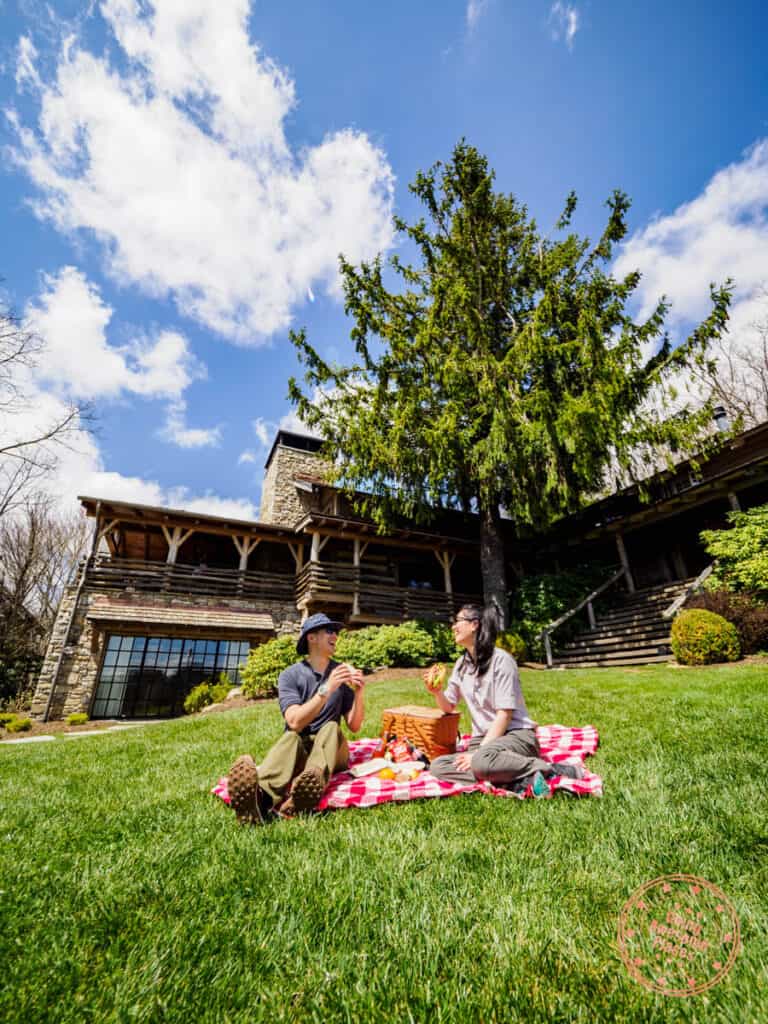
Next, you’ll see a whole other side of the Smokies. At an elevation of 5,000 feet and overlooking the Great Smoky Mountains National Park, you’ll find a luxury mountaintop retreat called The Swag .
It’s more than just a small rustic inn. It’s a hideaway and invigorating getaway that allows you to truly disconnect with its view of the mountains, boundless activities, authentic hospitality, and delicious dining.
While we didn’t plan early enough (at least a year or more in advance), we got a local tip that you can book a packed picnic lunch here without being a guest. This gives you access to the entire grounds, giving you the opportunity to hike up to Gooseberry Knob, watch the hummingbirds, explore the grounds, or enjoy book a spa treatment.
TIP: They have two vintage coolers right outside the main lodge where they stock ice cream and drinks. They’re free for all guests!
From the get-away-from-it-all feels, you’ll crank things up a notch with a visit to Dale’s Wheels Through Time . This is one of the top motorcycle museums in the United States. Curated and collected by Dale Walksler, his exhibits focus on an array of rare American motorcycles.
What makes Wheels Through Time more than just another museum is in their tagline of “the museum that runs”. Every single one of their machines on display can be fired up and they are more than willing to let you hear their beautiful growls.
In many ways, it feels like you’re walking through Dale’s personal workshop with bikes of all kinds, generations, and eras all under one roof. If you’re into Harleys, motorcycles from World War 2, or the most rare bike in the world , they have it all!

You’ll be driving through Maggie Valley and eventually into Bryson City. Check into your tiny home for the night at Gina’s Great Getaways , eat an early dinner at Nantahala Brewing’s Burger + Bar (or takeout to eat on the road), and start making your way back into the Great Smoky Mountains National Park.
This time, you’ll be heading up to the famous viewpoint, and tallest peak in the park, Clingmans Dome .
On the way though, make sure to be on the lookout for elk grazing on the side of the road. While we didn’t see elk at Cataloochee Valley, they were right by Highway 441 near the Oconaluftee Visitor Center , munching on grass, casually crossing the road, and causing quite the stir amongst the motorists passing by.

Clingmans Dome is a unique piece of architecture in the national park. At 6,643 feet, the observation tower was built in 1959 and features a spiral ramp that is in sync with the same 12 percent grade that the trail leading up to the tower has.
When you arrive, the panoramic views of the mountains and cascading ridges will take your breath away. This is just from the parking lot and visitor center area.
Continue hiking up the trail and this is when you actually start losing your breath because of how steep the path is. The 0.5 mile hike takes you to the base of Clingmans Dome where you’ll do the remaining spiral to get up to the top of the 45-foot circular observation platform.
The reason for the slightly awkward dinner option is because you’re trying to rush here to catch the sunset. It’s been a packed day so decompress out here with everyone else that has gathered here and watch nature’s finest light show.
WHAT YOU NEED TO KNOW – CLINGMANS DOME
At the highest peak in the national park is a unique spiral structure that offers 360 degree unobstructed views of the Smoky Mountains and cities below.
Clingmans Dome is built along state lines so half of it is in Tennessee and the other half is in North Carolina.
Website: Great Smoky Mountains National Park Clingmans Dome
- Sunrise or sunset for the best views from the tower.
- The road from the main Newfound Gap Road (Highway 441) is windy but easy to drive and newly paved.
- The drive towards Clingmans Dome has a number of scenic pullouts.
- While open all year round, the 7-mile road to Clingmans Dome from Newfound Gap Road closes from December 1 – March 31 so the only way to get there is by hiking.
- There is a large parking lot but during high-season it can fill quickly so come early.
- If you’re coming here for sunset, this means you’ll be driving in the dark through the national park so be careful and use your high beams (while not blinding oncoming traffic at the same time).
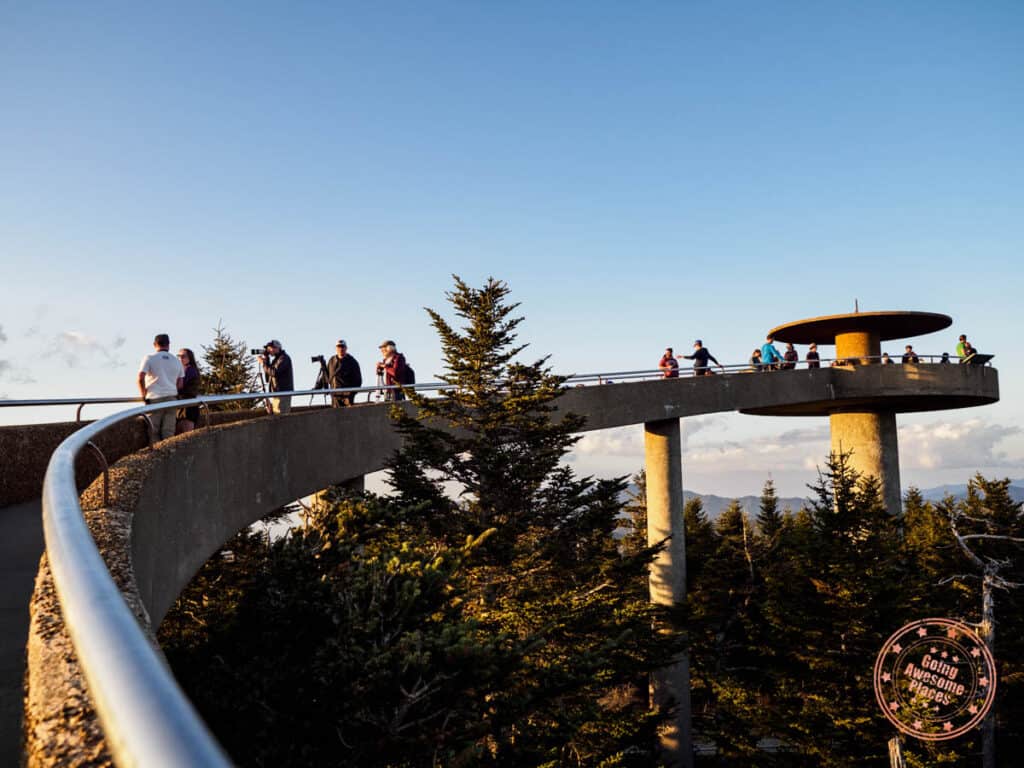
- Many photographers will try to capture the sunrise or sunset from Clingmans Dome but most photographers prefer sunset because the curve leading up towards the tower points west.
- Photographers will set up tripods along the ramp up and on the tower itself so you will want to go early to pick a spot. It does get quite busy at sunset.
- The best spot overall is actually on the ramp and not in the tower itself because there are less foreground trees obstructing the view of the mountain range.
- Right before the visitor center is a lookout point with log benches. This is a great spot to shoot the silhouette or mountain ridges.
- Pets and bicycles aren’t allowed.
- The trail up to Clingmans Dome is not wheelchair accessible.
- If you’re going for sunrise or sunset, make sure you have the right headlamp. The Fenix HM65R we’ve reviewed is highly recommended.
- Open all year round.
- The hike up to Clingmans Dome is only 0.5 miles and well-paved but don’t be fooled, the elevation change is quite large and so you’ll find yourself quite gassed when you reached the base of the tower.
- Since this is at 6,643 feet, the dome can be 10-20 degrees Fahrenheit (6-12°C) colder than where you came from so make sure to pack a jacket, even in the summer.
- The Appalachian Trail crosses Clingmans Dome if you want to do a short segment of it while you’re here.
- There are washroom facilities in the parking lot.
- If you can’t do the hike up to the dome, there’s actually a great view of the mountains looking westwards which is perfect for sunset. You’ll see many people lining up their camping chairs to watch from the parking lot.
- The visitor center is right by the trailhead and their hours can be found on the Visitor Centers page. There’s a bookstore, shop, and park information here.

For the next two nights, you’ll be staying in the Sweet Pea Tiny Home . As a tiny home, you’ll be amazed by how spacious and functional it is for its size. Inside, you’ll find a full kitchen, dining area, bathroom, bedroom. Outside, there’s a front porch, back deck, fire pit, and barbecue.
This Smoky Mountains itinerary is filled with unique stays like this but you need to know where to look, so hopefully this gives you a few ideas.
Day 2 Summary
What you’ll see:
- Cataloochee Valley
- Dale’s Wheels Through Time
- Clingmans Dome
- Breakfast – Make your own breakfast at the cabin.
- Lunch – The Swag – Exclusive luxury mountain lodge where you can book a picnic lunch to get a sneak peek. You won’t find it on their website so just call them to set it up.
- Dinner – Nantahala Brewing and Burger Bar – If you have time, come here for dinner or pick something up to go and eat it on the way up to Clingmans Dome.
Tours you can book:
- Clear Creek Falls Hike – This is a guided 4.5 hour hiking tour to Clear Creek Falls that starts and ends in Waynesville.
- Gina’s Great Getaways – They have a wide selection of getaway homes from a Lil’ Red Caboose to the Sweet Pea Tiny Home we stayed in. A heads up that their wifi is a bit slow because they’re in a remote area.
- McKinley Edwards Inn – This is located in the outskirts of Bryson City that runs like a B&B with a superb breakfast, great hosts, comfortable rooms, and is well-reviewed.
- Nantahala Cabins – If you’ll be spending time with the activities along Nantahala River, this place has a collection of cabins to choose from that range in sizes and budgets. Many of them hot tubs as well!
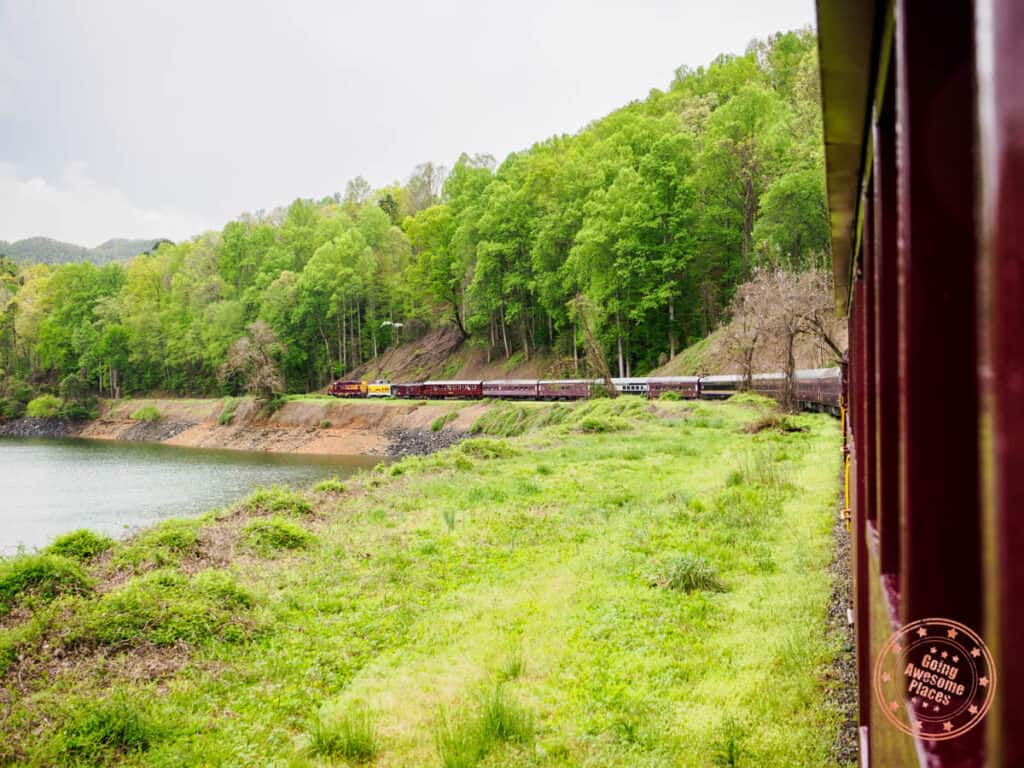
For your day 3, you’ll be combing two iconic activities in western North Carolina – riding the Great Smoky Mountains Railroad and rafting the Nantahala River.
Start your morning by heading into Bryson City. Park in the giant lot reserved for Great Smoky Mountains Railroad (GSMR) guests and stop by Mountain Perks across from the train depot for breakfast.
Check in at the GSMR office where they’ll provide you the tickets that you need. The beauty of the Raft & Rail package is that it’s a continuous experience that’ll start with your train ride through the Nantahala Gorge, where you’ll then get picked up by Wildwater on the other end to start the rafting segment of the trip.
Once they give the signal to board the train, you’ll make your way to your designated car and off you go.
Compared to the train ride we did in Sacramento in our Northern California road trip , I’d say the Nantahala Gorge Excursion is much more exciting, passing through Fontana Lake, Nantahala Gorge, two trestle bridges, ravines, waterfalls, and relocated towns created from the Fontana Dam.
This is a trip back in time as the diesel or steam-powered locomotive runs through tracks known as the Murphy Branch of the Western North Carolina Railroad. The brakeman responsible for your car will also come around to provide commentary on things you can see along the track.
WHAT YOU NEED TO KNOW – GREAT SMOKY MOUNTAINS RAILROAD
This is a must-do activity for those exploring the western edge of North Carolina. With 53 miles of track, 2 tunnels, and 25 bridges, Great Smoky Mountains Railroad (GSMR) offers two different tracks – one to Nantahala Gorge, and another to Tuckasegee River.
Take a step back in time with this classic train ride through the beautiful countryside and the same track that was part of the Murphy Branch built in the late 1880s.
They have two locomotives – diesel powered and steam powered.
Website: Great Smoky Mountains Railroad
- They have a number experiences and locomotives. It’s best to look at the calendar ahead of time especially if you’re set on riding a steam train.
- Each train ride also has multiple classes of service.
- For Nantahala Gorge , you can look at the Class Comparison table that has a clear table of what’s included in each class.
- Prices increase in October.
- Throughout the year, they’ll also have seasonal excursions.
- They also offer a special Raft & Rail combination. This is $121.75 for adults (13+) and $104.75 for children (7-12).
- Nantahala Gorge Excursion – 4 hour 30 minutes. 1 hour and 45 minutes in, you’ll reach the end and the train turns back. This includes a 1 hour layover at the Nantahala Outdoor Center.
- Tuckasegee River Excursion – 4 hours. 1 hour 30 minutes in, there’s a 1 hour 20 minute layover in the historic town of Dillsboro.
- GSMR runs all year round but their primary schedule is from April to October.
- The most popular time to visit is during the fall colours. You’ll notice that they run more trains most of October.
- GSMR has a large parking lot on Mitchell Street across from the railroad depot. When booking your tickets, the parking fee is mandatory and built in. Pre-paid parking is $6 per vehicle.
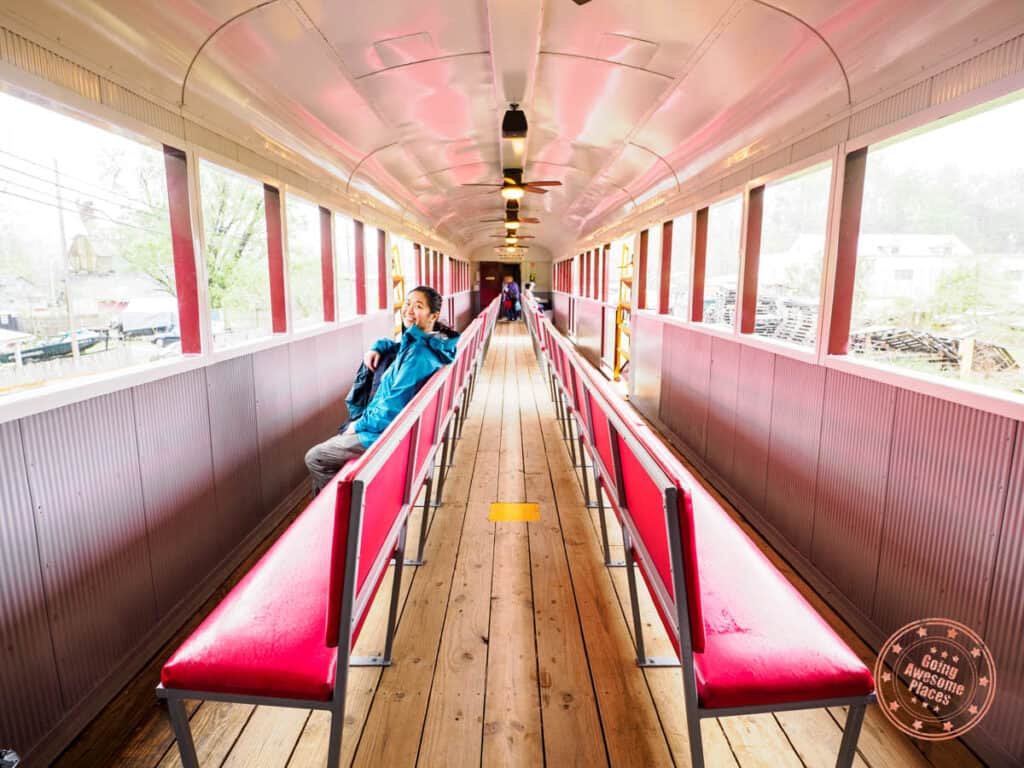
- The best car to book is the Open Air Gondola (or Premium Open Air Gondola) which is a covered open air car with benches on each side. This gives you unobstructed views.
- There’s a lot to see throughout the train ride so make sure your camera is already ready.
- For photos, look for the trestle bridges and big bends in the track which will allow you to take photos of the entire train.
- You need to arrive 1 hour before departure.
- There are bathrooms on board.
- You can walk between cars and you’ll have an opportunity to purchase lunch and drinks (including alcoholic beverages).
- Before you book, make sure to check out their deals page which has discounts for local residents, seniors, military, AAA, and others.
- For both primary excursions, they are one way trips up and the same track back to the railroad depot.
- During the train ride, a brakeman will be coming by to provide insightful and thoughtful commentary about the surroundings.
- With the open air gondola, you’re exposed to the elements so make sure you bring layers in case it gets cold.

After passing the Nantahala Outdoor Center and going further upriver, the train eventually comes to a full stop. For those that are on the Raft & Rail or Rail & Trail package, this is where you’ll disembark.
A Wildwater mini school bus will pick up the rafters, with the rafts themselves in tow. After a short ride, you’ll reach the launch site and riding down rapids in no time.
If you’ve done higher class rapids on the Ottawa River , you may have encountered class III to V. To set expectations, these are class I to III rapids which means that this is more of a low-intensity rafting trip that’s great for non-swimmers, multi-generation and groups with children 7+.
Your expert guide will take you down the fast-moving Nantahala River and navigate over a dozen different named rapids such as “Whirlpool”, “Patton’s Run”, and “The Bump”. The final drop is the biggest one called “Nantahala Falls”.
Paddling is quite minimal except for the occasions where your guide will say “give me 2!” where you’re then expected to do two strokes. At most you might have to do 5 continuous strokes together.
This is why we think this is great for those that want to experience rafting without it feeling scary or too serious. It’s extremely family friendly and many parts feel like one of those water rides in theme parks except this one’s in the real world.
There’s one stop along the way where you’ll be able to explore a natural rock cave that the Cherokee likely used.
WHAT YOU NEED TO KNOW – WILDWATER
The Nantahala River is not only abound with visual beauty but nestled in the gorge are 8 miles of clear and gushing water that creates the perfect condition for whitewater rafting for beginners. It’s great for families because the whitewater only goes up to Class III.
While there are many companies that ofter whitewater rafting excursions, Wildwater is the exclusive operator that works with the Great Smoky Mountains Railroad. The Raft & Rail package allows you to uniquely combine both the train with rafting experience. We’ll be focusing on this in the details below.
Website: Wildwater
- The Raft & Rail package is $121.75 for adults (13+) and $104.75 for children (7-12).
- Wetsuit rental – $10
- Wetsuit booties rental – $5
- The rafting experience itself takes 1 hour and 45 minutes.
- There is usually only one departure time available for Raft & Rail but check the schedule (most likely 10:30AM.
- Rafting is only available April – October.

How does raft and rail work?:
- Check into GSMR where you’ll receive all your tickets.
- In the waiting area is the cafe and this is where you exchange your boxed lunch tickets for your boxed lunches.
- Just outside on the other end of the waiting area is an outdoor Wildwater kiosk where a member of team will ask you to fill out the waivers and brief you on how the trip will work. This is also when they’ll ask whether you need paddle jackets, wetsuits, or booties.
- Board the Nantahala River Excursion train (could be diesel or steam) with everyone else. You will be on the Wildwater open air gondola car.
- Eat your lunch on the train ride.
- Once you reach the train’s turnaround point (2 hour 45 minutes to 3 hours in), you will disembark and the Wildwater team will pick you up in one of their small buses.
- You’ll head in the Nantahala National Forest where there’s a launch site. Gear up on the bus or on the ground as they get their rafts ready. There’s a few porta-potties here if you need it. You can leave your bags on the bus.
- After a safety briefing, you’ll help carry the rafts down the ramp to the water.
- Raft for 1 hour 45 minutes. The pick up point is right by the Nantahala Outdoor Center.
- The same bus will pick you up and once the rafts are loaded back on, they’ll drive you to the Wildwater outpost/office.
- At the office, you’ll be able to use their change rooms, take a hot shower if you want, buy souvenirs, and purchase photos.
- The bus will then drive you all the way back to Bryson City and drop you off to the parking lot. This will be around 4:30PM.
Difficulty:
- Beginner level rafting (no prior experience required).
- The rafting is exciting but does not require too much paddling so it is not strenuous.
- You will get wet but flipping is almost impossible with these classes of rapids.
- You can continue to park in the lot after you return to Bryson City so feel free to explore the city.
- Since the rafting is quite easy going, you’ll have a lot of opportunities to take photos. Make sure to bring a waterproof phone case .
- For video, bring your GoPro with orange floatie as many of their helmets have mounts. To mix things up, you can have a floating hand grip ready.
- If you want to bring camera gear, be prepared by bringing your own dry bag . There are a few loops at the front and back of the raft that you can clip to.
- They have a dedicated photographer capturing the final Nantahala Falls. Those are the photos you can purchase at the end. They don’t have a videographer.
- If you’re booking the Raft & Rail package , you will be in the Wildwater open air gondola car on the Nantahala River Excursion.
- To save time, fill out the trip waiver beforehand found on the Nantahala River Rafting page.
- For some reason it seems like it’s cheaper to book the Raft & Rail package through Wildwater (make sure to opt out of the “Trip Cancellation Guarantee”) but I believe they tack on the parking fee afterwards.
- Helmets are optional.
- There aren’t any official changing rooms at the launch site so it makes sense to wear your swimwear when you board your train.
- Pack your bags accordingly for both the train ride and rafting and think in advance how you’ll shift your gear around once you get on the Wildwater bus.
- The rafts rafts can carry up to 8 people + guide so these aren’t the massive rafts we had at OWL Rafting in Ontario’s Highlands .
- To be clear, Nantahala Outdoor Center (NOC) has their own rafting tours but it is not the same as Wildwater which is a different company. There are in fact a dozen or more companies that operate on the river. Wildwater is the only one that is partnered with GSMR.

Wildwater will eventually deposit you back to Bryson City where you parked. At this juncture, you can hang around town and grab dinner at a restaurant such as The Bistro at the Everett Hotel or if you wanted to see more of Nantahala River, you can drive back in.
Since Wildwater doesn’t linger around the rafting end point, you’ll be able to come back to get a glimpse of all the facilities around the Nantahala Outdoor Center (NOC). You’ll be able to walk the bridge where you’ll see the river rushing past, slalom gates used for canoe/kayak training, fishing from the shore, and a huge swathe of exhausted Appalachian Trail hikers.
River’s End is right along the side of the river and is an iconic spot for those hiker and paddlers alike. With a view of the river on one side, you’ll devour their yummy pizzas, burgers, world-famous sherpa rice , and seasonal entrées.
Day 3 Summary
What you’ll do:
- Raft and Rail Tour with Great Smoky Mountains Railroad and Wildwater
- Waterfalls and Breweries Tour – Combination of four waterfalls and five breweries in this small-group tour that leaves from Bryson City.
- Blue Ridge Parkway Day Tour – Since you won’t get to truly explore the Blue Ridge Parkway on your own, this could be a great alternative private tour.
- Breakfast – Mountain Perks – Right across from the GSMR depot, this is a popular spot in the city to grab a coffee or full breakfast.
- Lunch – Boxed lunch that’s part of the Raft & Rail tour .
- Dinner – Rivers End – Great location right beside the Nantahala River that serves yummy pizzas, burgers, and specialty entrees like the blackened local trout. This is a popular pitstop for Appalachian Trail hikers. Alternatively, The Bistro at the Everett Hotel is great if you’re looking for something in Bryson City.
- Gina’s Great Getaways – They have a wide selection of getaway homes from a Lil’ Red Caboose to the Sweet Pea Tiny Home we stayed in.

This is an exciting day of your Smoky Mountains itinerary because not only will you be seeing both sides of the national park, you’ll also be doing some of our favourite parts of the trip.
You’ll want to get an earlier start to your day and get to the Deep Creek section of the Great Smoky Mountains National Park. The reason for the early start is because this’ll give you an opportunity to see the 3 waterfalls here uninterrupted from large crowds.
Start with Juney Whank Falls which is closest to the parking lot. There’s a gradual climb on this trail but it’s a short hike. There’s picturesque wooden footbridge that crosses the falls and divides it into an upper and lower section. You’ll see a combination of cascades and sliding water.

Next is Tom Branch Falls which is the most easy to access out of all 3 waterfalls. Along the primary walkway you’ll have a wide open view of this elegant waterfall on the right side. Standing 75 feet high, it features a multilevel cascade.
To complete the trio of waterfalls, there’s Indian Creek Falls . This is a 45-foot sliding waterfall. From the trail, you’ll take stairs down to a viewing platform and it’s here that you get the best photos.
WHAT YOU NEED TO KNOW – DEEP CREEK
Another great part of the Great Smoky Mountains that you can only get to from North Carolina is Deep Creek which is well-known for its streams and waterfalls. What you’ll love about hiking here is that you can see 3 waterfalls in close proximity together.
Website: Great Smoky Mountains National Park Deep Creek
- To see all 3 waterfalls, you should budget 1.5-2 hours here.
- Early morning is a great time to go when the light isn’t too harsh for photography and there are fewer people on the trail.
- There is plenty of parking. Drive all the way to the Deep Creek Falls and Trail parking.
- If you’re looking for milky waterfalls, make sure you pack your ND filters and tripod (we use the Peak Design Travel Tripod ) or have a camera like the OM System OM-1 which has built-in ND filters that can be used hand-held.
- You can’t fly drones whatsoever here because you’re within the national park.
- There is some elevation change up to Juney Whank Falls. This loop is the only trail that takes you into the forest.
- The Deep Creek Trail to Tom Branch Falls and Indian Creek Falls is extremely wide and groomed gravel. This trail also has plenty of benches along the way.
- If you have difficulty walking, Tom Branch Falls is right along the easy-to-walk path , has no elevation change, and the waterfall can be viewed right across the creek.
- For a more challenging hike, you can ado the Deep Creek Horse Trail from Juney Whank Falls up to Indian Creek Falls before coming back down to the trailhead and catch Tom Branch Falls.
- There aren’t restrooms at the trailhead but you’ll find them in the picnic area.
- Pets are not allowed on the trail to see Juney Whank Falls nor both Indian Creek and Tom Branch Falls .
DEEP CREEK REVIEWS

If you didn’t end up making breakfast at your tiny home, make a brunch of it and grab a sandwich and coffee to-go from The High Test Deli and Sweet Shop .
Halfway through the trip, it’s only fitting to now make that crossing over the Great Smoky Mountains National Park . The first part of the drive will be familiar because it’s the same Newfound Gap Road (Highway 441) that you took earlier to get to Clingman’s Dome.
Along the way, take the obligatory sign in front of the national park sign. There’s a pull off for the sign so you won’t need to rush this part.
Make sure to stop at the Oconaluftee Visitor Center . There aren’t many shopping stops on this itinerary so this is your chance to pick up some souvenirs. Behind the center is also the Mountain Farm Museum which has historical buildings dating back to the early 1900s.
For those that are keen on learning more of the history of settlers in the area, Mingus Mill , an 1886 grist mill with functioning machinery, is also worth stopping by.
The first part of the drive is mostly uneventful as you’ll be going uphill and driving through what will feel like a tunnel through a thick forest of trees.
You’ll pass through a number of lookouts along the way but here are the ones you should focus on:
- Luftee Overlook – This viewpoint has an elevated view of not only Oconaluftee Valley but also the gentle bend in the road. You can’t cross the road so you’ll be taking photos from the parking lot.
- Newfound Gap – The Appalachian Trail cuts right across and this is perhaps the important stop you’ll make because it’s here that you’ll find the North Carolina/Tennessee State line sign, and also both UNESCO World Heritage Site and Biosphere Reserves plaques. The path below the parking lot offers stunning views of the mountains and road that you just took up.
- Morton Overlook – Once you get here, you’re starting to make the downhill drive. This is one of the famous overlooks that looks down the line of the valley of trees and you get a small sliver of the road in the foreground.
- Chimney Tops Overlook – The Chimney Tops sustained massive fire damage in 2016 and so the landscape is quite a bit different from before. This pull off on the left gives you a glimpse of how extensive the damage was. Mark this on the map because this will come up on you really quick and there isn’t any signage. Also, heads up that the Chimneys Picnic Area doesn’t have any view of the Chimney Tops.
- Carlos Campbell Overlook – Named after the director of the Knoxville Chamber of Commerce in the 1930s, advocating for the creation of the national park, you’ll see 3 peaks in one view. The official overlook has quite a lot of tree cover in the foreground so we recommend driving to the smaller pull off just a bit further downhill.
WHAT YOU NEED TO KNOW – GREAT SMOKY MOUNTAINS
The entirety of the Great Smoky Mountains National Park is a guide all on its own but here are some of the key things you should know when making the crossing on Newfound Gap Road.
Website: Great Smoky Mountains National Park
- The speed limit through the Smoky Mountains is at most 45 miles per hour (72 km/h) but is generally 35 miles per hour (56 km/h).
- There are a lot of pull offs on Newfound Gap Road and not only is that for scenic views but it also allows cars to let others pass if you find that you’re being pressured to drive faster.
- Overall the road is vert well-maintained, not too twisty, very safe with its rock barriers, and newly paved.
- Crossing North Carolina to Tennessee without stops is only 1 hour so it is not a long drive.
- As we mention above, there are a ton of scenic overlooks especially along Newfound Gap Road (Highway 441). You’ll be tempted to do a lot of them but you’ll be better off to plan the specific ones you want to do and then see how you feel when you’re there.
- Be on the lookout for wildlife and more specifically, bears! Bears aren’t shy and they’ll come right up to the road. Typically, if you see a big traffic jam with people looking into the forest, it’s most likely a bear.
- We spoke to a ranger at Oconaluftee Visitor Center and they said that the elk can be seen typically from the entrance to the park on Highway 441 all the way to Smokemont Campground but never any further.
- Two popular spots for elk are in the huge meadow beside the Oconaluftee Visitor Center, near Mingus Mill, and by the side of the road in the mile leading up to the visitor center.
- Always check for closures on the Great Smoky Mountains page. Their “Alerts in Effect” show all of the important notices at the top.
- Cellular service – There is no service once you enter the park. The edges of the park might have a bit of service but plan to be disconnected while here.
- If you want to support the national park, don’t buy souvenirs in town but at the visitor centers instead where the money can make a difference.
- The two major visitor centers are Oconaluftee on the North Carolina side and Sugarlands on the Tennessee side.
- If you plan on doing any hikes, try to get to the trailhead early in the morning because the parking lots and pull offs fill up very quickly.
Take the road straight into Pigeon Forge , Tennessee where you’ll see a dramatic change to a street filled with larger-than-life themed shows, rides, and a whole lot of fun.
Along the main parkway, stop at the popular Local Goat to satisfy your hungry with their selection of craft beer, and locally-sourced and sustainable menu items such a their highly-touted burgers, ribs, pastas, salad, and more. You’ll need to build up your energy reserves for what’s coming next!

How does being inside a giant-sized 11 foot beach ball filled with 10 gallons of water to get you wet while rolling down a 1000 feet hill sound? Absolutely ludicrous right?
Well, that’s exactly what you’ll find at Outdoor Gravity Park .
EXCLUSIVE DEAL WITH OUTDOOR GRAVITY PARK

We’ve secured a special deal with OGP where 1 roll and 1 video is $25 (discount of $14), and 3 rolls and 3 videos is $62 ($20 savings). This is the best offer you’ll find on the market right now.
The link below will take you straight to the booking platform Outdoor Gravity Park uses. The initial page shows the standard information about how the rolls and videos work. Once you’ve selected a date and time, you’ll see the discounted rates on the next page.
You may have heard of something called zorbing in New Zealand. It’s one of those bucket-list items that you’d do when there along with skydiving in Abel Tasman , or bungee jumping in Queenstown . One of the engineers of ZORB in Rotorua, came to Pigeon Forge to build his dream course.
Featuring 3 different tracks, you can fill up the zorb with up to 3 people on some or go solo on the most daring “Extreme Zig Zag” course.
There are a lot of fun and crazy things you can do in this region of Tennessee but this is easily the most extreme, wild, and fun.
WHAT YOU NEED TO KNOW – OUTDOOR GRAVITY PARK
Made popular in New Zealand, this is the only place in the United States where you can go zorbing. Don’t miss this! It’s ridiculously fun.
Website: Outdoor Gravity Park
Address: 203 Sugar Hollow Rd, Pigeon Forge, TN 37863, United States
Hours: Monday – Sunday 11AM – 4PM
- 1 roll is $24
- 3 rolls is $7 ($19 each)
- 5 rolls is $90 ($18 each)
- 10 rolls is $170 ($17 each)
- 20 rolls is $340 ($17 each)
- Video for one roll – $15 ($5 for additional rolls)
- Unlimited video for all of your rolls – $50
- Each track is slightly different but on average it takes about 30-45 seconds to get downhill.
- The park’s GoPros are free to use but the video needs to be purchased.
- They come with a selfie stick ( GoPro 3-Way ) and are already protected from fog. The cameras are not mounted and require you to hold the selfie stick.
- You are allowed to bring your own GoPro as well! Before you come, make sure to coat the lens with Rainx Anti Fog Repellent otherwise it will fog up.
- Your best bet is to have the stick fully extended and the camera pointed back at you in either wide or super wide mode.
How does it work?:
- You’ll get a wristband that indicates the number of rolls you get.
- After changing and getting ready, there’s a line you get into behind the main building for the mini bus.
- Once you get on the bus, it’ll take you uphill to the start of the course.
- Indicate to the staff which course you’re doing as they get the zorb ready.
- When it’s your turn, the staff will place a small pad over the entrance of the zorb to prevent your clothes or skin catching on the zipper.
- Holding the zorb in place, you’ll jump in head first. You’ll immediately get wet because of the water that’s inside.
- The staff will zip up the zorb (it’s double sealed).
- When the track is cleared and ready, they’ll open the gate and give you a gentle (ish) push.
- Cue the screaming.
- The common misconception is that your body will be rolling around as the zorb goes downhill. On the contrary, you actually stay relatively planted at the bottom with the water as the zorb rolls around you.
- At the end of the track, you’ll come to a complete stop. The staff will open up the zippers and you’ll come out feet first onto the grass.
- There are 3 available tracks. For the most bouncing and change of catching some air inside the zorb, do the “Extreme Zig Zag” track (you have to have done another track first in order to do this one). For the fastest speeds, choose the middle “Fast Tracks”. For the best of both, “FUNnel” is a great one to start with.
- Zorbs can fit up to 3 people (depending on the track). Each person rolling will cost 1 roll.
- The main building has change rooms and restrooms. There are no showers.
- You’re guaranteed to get wet so come prepared with a swim suit, your own towel (unless you’d like to buy one of theirs), and change of clothes.
- Outside of summer, you’ll get cold once you’re out of the zorb, so it’s a good idea to have a large towel to wrap around you to dry and warm up.
- When booking, you’ll have to pick a time slot. You have to arrive during that slot but you can go over time. Wait times are generally shorter at the beginning of your time slot and gets slower at the end.
- If you’re traveling in a large group, it makes one sense to purchase all the rolls so you can save money with the bundle prices.
- While you have to select the number of rolls when booking online, you can always add more when you’re there.
- They have discount packages so make sure to see if those suit you. You’ll find these on the checkout page.
- If you are military, first responder, or educator, use THANKYOU for a 10% discount.
- You must be 5+ to roll. Maximum weight is 275 pounds per person.
- We found that with two people, the water seemed to fling up and around the zorb quite a bit more which meant we were rubbing water out of our eyes. Going solo, there was much less water splashing on your face.

End off your night at the illustrious RT Lodge in Maryville, Tennessee. This rustic retreat and continues the line of unique stays you can find in the Smoky Mountains. Leaping off the pages of wedding magazines, Southern charm oozes throughout the classic revival property.
Sure, it’s a bit out of the way but you’ll love the nightly s’mores firepit, outdoor fire place accompanied by lounging rocking chairs, wooded grounds, free bike rentals, and lounge salons.
For dinner, you’ll eat at The Restaurant at RT Lodge which is an upscale dining experience to match the atmosphere and ambiance of the lodge. Executive chef, Chef Stockton, sources from local farmers and homegrown ingredients to prepare the most delectable dishes.
Day 4 Summary
- Deep Creek – Hike the waterfall loop for Juney Whank, Tom Branch, and Indian Creek waterfalls
- Luftee Overlook
- Newfound Gap
- Morton Overlook
- Carlos Campbell
- Outdoor Gravity Park – The only place in the United States you can go zorbing. Ridiculously fun!
- Museum of the Cherokee – Skip the line with this admission ticket to the museum to learn the history and culture of the Cherokee people.
- North Carolina Steams and History Tour – A 5 hour guided nature walk through the Smokies by A Walk In The Woods that starts at Oconaluftee Visitor Center.
- Audio Driving Tour – GyPSy Guide is a well-known self-driving guide that we also recommend for our 5 day Maui itinerary .
- Breakfast – The High Test Deli and Sweet Shop – They’re a take-out only restaurant which is perfect because you’ll be able to eat it along your drive through the Smoky Mountains National Park.
- Lunch – Local Goat – A highly rated restaurant that has a great selection on their menu. Don’t miss their ahi tuna burger, fall-off-the-bone ribs, steaks, and craft beer.
- Dinner – The Restaurant at RT Lodge – Pairing with the picture-perfect lodge is a gourmet dining experience that will impress with their upscale ambiance, creative dishes, and some of the best service you’ll find in a restaurant. Remember to make reservations (closed on Monday).
- RT Lodge – While a bit out of the way, is a spectacular luxury lodge that’s tucked in the forest for cozy rooms, high-class restaurant, plenty of lounging areas, and firepit. S’mores are free for all and breakfast is included as well.
- Blue Mountain Mist Country Inn -Located not far from Dollywood and Pigeon Forge, this is a rustic and intimate inn with exceptional service and includes breakfast.
- Twin Mountain Inn & Suites – A more traditional hotel located in Pigeon Forge that’s next to Dolly Parton’s Stampede and at the foothills of the Smoky Mountains. Pets are allowed, there’s a swimming pool, and breakfast is included.

The Tennessee side of the Smoky Mountains has a lot to offer and what you’ll find is that while the view of its peaks might be similar, they have a different take to it.
There’s no time to lose so enjoy a cup of coffee on the grounds of RT Lodge before setting off for brunch at the famed Applewood Farmhouse Restaurant .

The original farmhouse for the 65-acre apple orchard property was transformed into a family eatery and ever since then it’s become a staple of traditional southern dining in the town of Sevierville.
Your experience starts off with a complimentary basket of apple fritters and apple cinnamon muffins, side of apple butter, and cup of their Applewood julep. This is before you get your southern favourites including their must-order Savannah pecan pancakes, Smoky Mountain biscuit Benedict, and country omelets that you see above.
You may not have had a grandma living in the south but after your brunch here, you’ll get a really good taste of what it’s like if you did.
TIP: Ask for the table with swinging chairs. There are only two at the moment in the restaurant but they’re definitely one of the exclusive tables to dine in if they’re available.

Next up is the iconic Pink Jeep Tours made famous in Sedona, Arizona but now has their own set of tours in the Great Smoky Mountains.
Since you have already done Newfound Gap on your own, one of the tours that we recommend is the Roaring Fork Smoky Mountains Tour which takes you through the Roaring Fork Motor Nature Trail .
On this tour, you’ll travel in a custom open-air Pink Jeep Wrangler where the advantage of doing this versus on your own is having an expert interpretive guide provide great commentary about the area you’re driving through, make stops at the best locations, and help with group photos.
Being in an open-air jeep means that you’ll get awesome elevated views of the bridges, waterfalls, steams, and maybe even a bear. One surprise is that you will get an opportunity to get off the jeep as well and walk around the Ephraim Bales Cabin along with the lesser-known scenic streams that’s just behind.
At the end of the tour, you’ll be taken to a private-property 4×4 off-roading course and turn the adventure knob to a 10. The true power of the jeep will be on display, thundering up and down rocky hills like its nobody’s business.
WHAT YOU NEED TO KNOW – PINK ADVENTURE TOURS
Pink Adventure Tours (also known as Pink Jeep Tours) got its award-winning start in Sedona and specializes in off-road and road-based tours in the US. They now have locations also in Las Vegas, Grand Canyon, Branson, and the Smoky Mountains.
In the Smoky Mountains, they have several tours but we’ll be focusing on their Roaring Fork Smoky Mountains Tour.
Website: Pink Adventure Tours
- Adult – $74
- Child (2-12) – $67
- Private (up to 7 people) – $518
- Once you’ve picked your seat on the jeep, there’s not much moving around. That said, there are things to see on both sides of the jeep and since it’s open air, you can get up and peek over to the other side if you need to.
- Try to keep your gear minimal as there isn’t really extra space for luggage. There’s also quite a bit of bouncing around in the 4×4 adventure at the end.
- You need to arrive 30 minutes before departure.
- Use the bathrooms before heading out because there aren’t really any bathroom breaks along the way.
- Tighten your seatbelts real good during the 4×4 adventure because if you don’t, you’ll be flung around pretty hard.

Next, head to Five Oaks Farm Kitchen for an early dinner.
The restaurant pays homage to the legacy of Dr. John and Blanche Ogle who were important figures to the growth of the agricultural and breeding of Tennessee Walking Horses in the area.
In what feels like a giant two-story barn, you’ll be able to have a true Southern-style supper.
With choices like chicken and dumplings, cornbread, smoked beef brisket, chicken pot pie, meatloaf, and fried chicken leaping off the menu, you’ll eat just as well as the weary travellers that passed through these exact parts in the early 1900s.
TIP: Grab a jar of fresh raw mountain honey before you leave the restaurant.
Wind down in the comforts of RT Lodge for the night, taking full advantage of its grounds, and of course as many s’mores as you can eat.
Day 5 Summary
- Roaring Fork Interpretive Marker Overlook
- Ephraim Bales Cabin
- The Place of a Thousand Drips
- Pink Adventure Tours – Roaring Fork Smoky Mountains Tour
- Explore a Simpler Time Smoky Mountain Tour – 3 hour tour where you’ll hear stories of the Cherokee people and a glimpse of settlers’ daily lives.
- Old Growth Forest Cascade – This hike takes you to a towering waterfall deep in the old-growth forest.
- Hidden Cascades Hiking Tour – Starting from NOC Gatlinburg, your local guide will take you on a quiet rail down to see a beautiful cascade in the Smokies.
- Clingmans Dome Hike – If you happened to miss this earlier, you can join a guided tour up to Clingmans Dome.
- Ghost and Haunt Tour of Gatlinburg – Learn about the ghost and ghouls that haunt Gatlinburg in this 2-hour night walking tour.
- Thunder Streams and Falls – 3 hour hiking tour that takes you off the beaten path in the Smoky Mountains.
- Brunch – Applewood Farmhouse Restaurant – The oldest restaurant in Sevierville that’s the perfect spot to have Southern breakfast classics. Their apple fritters can’t be missed (because they’re complimentary)!
- Dinner – Five Oaks Farm Kitchen – An inviting Southern restaurant that carries the tradition of the Ogle family that’s filled with farmhouse ambiance and amazing service.

The fun doesn’t stop because you’ll be going wire to wire (literally and figuratively) on your last day of this Smoky Mountains itinerary.
Wake up bright and early for Day 6 because you’ll need to make the drive from Maryville to Gatlinburg . Gatlinburg is a mountainside town at the footsteps of the Smokies that’s filled with outdoor adventure.

One of the unmissable attractions you’ll find in town is the Gatlinburg SkyLift Park . On select days, they offer sunrise access which allows you to get up to their SkyBridge right at dawn.
From this side of the mountain, you’ll be able to watch the city below transition from night to day as the sun climbs up from behind the mountains in the distance. The view from up here is spectacular, especially when you’re on the suspension bridge.
WHAT YOU NEED TO KNOW – GATLINBURG SKYLIFT PARK
The main attraction here is the SkyBridge which features 5 panels of glass and incredibly views of Gatlinburg and the Smoky Mountains. You’ll also find their SkyTrail with The Tulip Tower, SkyDeck viewpoint, and of course the SkyLift 3-seat chairlift that takes you up from the town below.
Website: Gatlinburg SkyLift Park
Address: 765 Parkway, Gatlinburg, TN 37738, United States
Hours: Their hours of operation vary throughout the year. They are closed Jan 31 – Feb 3 for winter maintenance but are otherwise open all year round.
- Adult – $31.95
- Child (4-11) – $18.95
- Seniors (65+) – $24.95
- 3 and under – Free
Driving tips: There are two primary parking lots that are supposed to be $10. These are marked on the interactive map in the beginning of the article. Both are short walk to the Gatlinburg SkyLift Park chairlifts.

- They offer special sunrise access on specific days where you’ll be able to load the SkyLift 45 minutes prior to sunrise time. These tickets are slightly more expensive.
- Drones are not allowed here (we had special permissions to fly).
- If you purchase and redeem your ticket after 8PM, you’ll be able to access the SkyLift Park the next day as well.
- Re-entry is allowed throughout the day.
- Once you reach the other end of the bridge, there’s a small deck with gift shop. You can then connect this with the SkyTrail that follows the side of the mountain and goes back to the main SkyCenter.
- Being a suspension bridge, the SkyBridge does sway and is more noticeable when there are more people on the bridge.
GATLINBURG SKYLIFT PARK REVIEWS
Your last chance for true Southern food on your trip will be at Crockett’s Breakfast Camp . You won’t be able to make reservations here so come here immediately after the SkyLift Park.
Based on the story of the frontiersman, David C. “Crockett” Maples, you’ll be transported to the Old West with artifacts and decor matching a time of westward expansion and exploration.
With their menu printed on a traditional newspaper, have a hearty breakfast of all the southern favorites. Don’t miss their giant cinnamon roll while you’re here.

There are many attractions to choose from while in Gatlinburg but many of them will feel a little kitschy and from a different time. In seeking out an activity to truly round out your road trip in the Smoky Mountains, it only felt appropriate to find something that embraces the outdoors and magic of the mountains.
Touting the highest point in downtown Gatlinburg is Anakeesta . More than just another theme park, this is a whimsical and immersive outdoor experience that combines thrilling elements with a place to chill amongst sculptures, flowers, lights, and breathtaking viewpoints.
Great for all ages, you can spend as much time as you’d like here. Recommended activities are the Rail Runner mountain coaster which features the only single-rail coaster in the United States and the Dueling Zipline Adventure .
They also have some of the best dining experiences in Gatlinburg. We recommend having dinner at Cliff Top Grill & Bar which serves modern American cuisine with the Smoky Mountains serving as its backdrop.
WHAT YOU NEED TO KNOW – ANAKEESTA
More than just a theme park, Anakeesta is an immersive outdoor experience which combines its whimsical mountain atmosphere with thrilling rides, botanical gardens, lookout tower, meandering trails, shopping, dining, and play areas.
Website: Anakeesta
Address: 576 Parkway, Gatlinburg, TN 37738, United States
Hours: Changes throughout the year. Check their calendar for the day-by-day schedule.
General admission:
- Adult – $32.99
- Child (4-12) – $19.99
- Seniors (60+) – $25.99
Dueling Zipline Tour is $59.99 for all ages
Rail Runner is $14.99 for single rider and $18.88 for tandem rides.
Gem mining is $8 per “Paydirt” bag.
Duration: You can easily spend a full day or a few hours here. It depends on how many of the activities you want to do.
Driving tips: There are two primary parking lots that are supposed to be $10. These are marked on the interactive map in the beginning of the article. Both are short walk to Anakeesta.
- You cannot mount a GoPro on the Rail Runner vehicle itself but head and chest mounts are fine.
- For the Dueling Zipline tour, they have helmets with GoPro mounts on them so just request them. You are also allowed to use your phone or other device but you are responsible for its safety.
- Photos are taken before you take the chairlift and rides such as Rail Runner. You can purchase physical prints similar to other amusement parks or you can buy digital-only copies.
- Bears are known to be on the mountain slopes nearby so be on the lookout!
- If you love sunsets, plan to stay around and watch it from the top of AnaVista Tower.
- If you start your visit at night, your next day is free.
- General admission effectively includes everything in the park except for Dueling Zipline, Rail Runner, and Gem Mining activities.
- The ride up is called the Chondola. These are mostly regular 4-person chairlifts but you can also wait for a closed gondola (fits 6 people) which we’d recommend if you’re carrying a lot of gear or not comfortable with heights. These are much less frequent so you’ll have to wait 10-15 minutes for the gondola to come around. They come by 2 at a time.
- You can also go up the mountain by taking the Ridge Rambler which is an open air passenger truck.
- It is recommended to book the Dueling Zipline Tour beforehand as there are limited spots. You have to call to reserve.
- Save time on your check-in process for Rail Runner and Dueling Zipline by completing your waiver online.
- They recommend getting to the Anakeesta base 2 hours before your Dueling Zipline reservation to account for parking, lift and the 30 minutes you need to be there before your reserved zipline time.
- Bears are nearby but the park staff do a good job at making sure they don’t come into the park itself so you don’t need to worry.

Perhaps the most unique stay of the whole trip is on the last day or if you’re a big fan, you could arrange it so you’re here the entire time in Tennessee.
Luxury treehouses are real and bookable just outside of Gatlinburg in a place called Treehouse Grove .
If anyone’s watched Treehouse Masters on Animal Planet, you might’ve heard of Pete Nelson. As the host of the show, he’s built some of the coolest treehouses around America.
One of his team’s special projects was this community of treehouses nestled in the forest. With not a single tree cut down, these are modern cabins built around the trees, using them as foundation and support.
Each treehouse in the grove are unique but these are all equipped with modern furnishings, a kitchen, multiple bedrooms, screened porch and deck.
This may be one of the Great Smoky Mountains best kept secrets.
And that’s a wrap for your 6 day Smoky Mountains itinerary. The next day, you’ll be either flying out of the nearest airport which in this case is the McGhee Tyson Airport (TYS) in Knoxville, Tennessee. Otherwise, you’ll be continuing your road trip to the next exciting place!
Day 6 Summary
- Gatlinburg Skylift Park and SkyBridge
- Dueling Zipline
- Rail Runner
- Wine and Shine Walking Tour – The ultimate moonshine distillery tour where you’ll learn how moonshine is traditionally distilled. The tour includes plenty of samples!
- Impossibilities Magic Show – Family-friendly admission to the show ‘Impossibilities: An Evening of Magic, Mindreading, and Mayhem’ at the Iris Theater in Gatlinburg.
- Brunch – Crocketts Breakfast Camp – Southern breakfast favorites served in a space that takes you back to the days of the Western Frontier.
- Dinner – Cliff Top Grill & Bar at Anakeesta – Gourmet dining within the park that will surprise you with dishes such as their charcuterie board, bison burger, and ribeye.
- Treehouse Grove (The Maple) – These are luxury treehouses come to life. Built by Pete Nelson of Treehouse Masters fame, this is a tiny community of modern treehouses not far from Gatlinburg.
- Greystone Lodge on the River – Conveniently located right in the heart of Gatlinburg, this hotel offers an outdoor swimming pool, free private parking, fitness centre, and free breakfast. This means you don’t have to worry about parking when you’re in town.
- Bearskin Lodge on the River – This hotel isn’t quite as central but the nice thing is that all rooms are fitted with a balcony, microwave, fridge, free parking, and complimentary continental breakfast. Room layouts are spacious and the large outdoor pool is great for the kids.
The key to any successful road trip is to be prepared with all of the right gear. If you’ve followed the itinerary above, you’ll know that it is packed with a bunch of outdoor activities and each one is quite different from one another.
This list doesn’t cover everything but we’ve identified a bunch of key items to get you started with your packing list.
- Car USB adapters – As a road trip, you’ll want to make sure you bring your own charging gear. This’ll allow you to keep your devices and batteries topped up. Most cars have two cigarette adapters so bring two chargers if you have them. Photographers will likely want to make use of this so you can charge your camera and drone batteries on the fly.
- USB charging cables – Along those lines, remember all the variations of cables you’ll need (USB-A, USB-C, Micro USB, and Lightning) depending on what you’ll need to charge.
- Car phone mount – This one is easy to forget. Pack your own car mount so you’ll be able to navigate with ease.
- Binoculars – There’s a lot of wildlife in the national park so a good pair of binoculars is a good idea. Think birds but also the bigger animals like bears if they’re in the distance.
- Layers – Pack accordingly depending on the season that you’re in the Great Smoky Mountains National Park. It can swing from cold to hot quickly so have a sweater/fleece/hoody handy. One we recommend is the Arc’teryx Delta LT Hoody .
- Waterproof jacket – A jacket is handy for the cooler temperatures at sunrise, sunset, and at mountain peaks. Depending on the time of year, rain can also come and go. For this we recommend Arc’teryx Beta jacket for men and women.
- Buff Headwear – Along the lines of layers, something I swear by for all of our packing guides , are the same buffs that you see on Survivor which I use either as a headband, scarf, or wristband to wipe off sweat.
- Wifi hotspot – If you live outside of the US, you’ll need a hotspot for data. I recommend using something like Pokefi (use code GAP23200 to get $20 off) or Solis (rebranded from Skyroam).
- Sunscreen – Protect your skin. Yes, there’s a lot of cover from trees but the UV is strong so apply that 50 SPF Sun Bum before you head out.
- Headlamp – Especially for sunsets, this is going to be mandatory equipment. Check out our review of the Fenix headlamp which is the best one we’ve owned.
- Hiking shoes – A quality waterproof hiking shoe such as the Keen Targhee II for Men and Women is highly recommended. While there isn’t any big hikes in this itinerary, you might want to add them to yours so these will be very useful.
- Waterproof sandals – We usually pack the Keen Newport H2s with us for those hot days where we don’t want to wear shoes or when you need them for whitewater rafting.
- Water bottle – With your own bottle, you’ll be able to fill it with water. This will allow you to buy large 5L jugs of water if you don’t want to drink tap although it’s entirely safe to do so. For the coffee drinks, having a Hydroflask with a coffee sip lid will come in handy because you’ll be able to either pour or brew your own coffee in the morning in any of the cabins or lodges we stayed at.
- Dry bag for your phone – If you’re planning on going rafting in the Nantahala River, make sure to pack this to be able to have your phone with you.

Before starting to plan this 6 day Smoky Mountains itinerary, we certainly didn’t know much about the region but as we learned more about North Carolina and Tennessee, it was clear that we needed to do a lot more homework to figure out how to build a road trip that would do both states justice.
I’m not going to lie, this trip is one of our more ambitious out of all of our itineraries but we’re happy with how it turned out.
For us, we were seeking a trip that would allow us to be outdoors, to try new things, stay in cool accommodations, eat hearty Southern food, and of course capture the amazing scenery around the Great Smoky Mountains National Park.
We did just that and more!
Two resources that really helped us with our planning were the two tourism boards below so make sure to check them out as they are chock full of information.
You are not allowed to fly your drone anywhere in the national park.
The Great Smoky Mountains National Park are one of 15 free national parks to visit. This means that you don’t need reservations, and you won’t be crossing through any entrance gates to get into the park.
6 days is as tight as you’d want to make a Smoky Mountains road trip. If you have more time, 8-10 days would be a comfortable amount of time to see not only the national park but explore both the North Carolina and Tennessee side of the mountains.
The simple answer is in the fall. Between mid September to late October, the changing of the leaves attracts many visitors to see the rainbow of colours in the Smokies.
Each side of the Smoky Mountains has their own access to the national park which means completely different scenery and wildlife. For instance, Deep Creek in North Carolina is a wonderful place to see 3 waterfalls in close proximity to one another. Cataloochee Valley is another in North Carolina with elk viewing opportunities. Then you have places like the Roaring Fork Motor Nature Trail and Foothills Parkway which you can only access from Tennessee.
Straddling both Tennessee and North Carolina, both sides and the park itself are in the Eastern time zone.
The highest point of the national park is at Clingmans Dome which you can visit and is part of this 6 day Smoky Mountains itinerary.
- Epic 9 day Northern California road trip itinerary
- 4 Amazing Weekend Trips from Philadelphia
- Best island to visit in Hawaii for first time visitors
- 5 Weekend Trips From Nashville, Tennessee
- Utah and Arizona 10 day itinerary
- Our USA travel guide
- Hottest deals – Bookmark the travel deals page .
- Car rentals – stop getting ripped off and learn about car rental coupon codes .
- Hotels – Use corporate codes or get Genius 2 tier with Booking.
- Flights – Have you ever heard of the “Everywhere” feature ?
- Insurance – Make sure you’re covered and learn more about where to buy the best travel insurance .
If you’re in the process of planning your trip and putting together your itinerary, these are genuinely the best resources that the Going Awesome Places team stands by 100% .
Credit cards: Don’t get burned by hidden fees on top of terrible exchange rates. When we travel now, we use the Wise Card . Simply load it with the currency you need before you go and use it as a regular VISA or their digital wallet card. Use their free app to track how much you have and top up when you need to.
Flights: Of all the booking search engines, Skyscanner is the most helpful and easy to use thanks to their Everywhere feature . Kayak is also another that’s we will often check as well.
Car Rental: If you’re looking to save money, these car rental coupon codes will be a true game-changer. Otherwise, DiscoverCars and RentalCars are great places to start.

Airport Parking: You’ll need a spot to leave your car at the airport so why not book a spot at a discount. Use code AWESOME7 to get at least $5 off at Airport Parking Reservations or Park Sleep Fly packages.
Data: We’ve been a huge fan of wifi hotspot devices like PokeFi because their rates are so good and you can use it globally but recently, we’ve really loved using eSIMs. The best one is Airalo . Save money by getting region-specific eSIMs and use referral code WILLIA9500 to get $3 USD credit on your first purchase. Ubigi is another one that we’ve had success with where they uniquely offer 5G coverage. Use code AWESOME10 to save 10% on your first order.
Hotels: Our go-to is Booking.com because they have the best inventory of properties including hotels and B&Bs plus they have their Genius tier discounts . The exception is Asia where Agoda always has the best prices. TripAdvisor is also useful for reviews and bookings.
Vacation Rentals: Your first instinct will be to check Airbnb but we always recommend checking VRBO as well if you’re looking for a vacation rental.
Tours: When planning our trips, we always check both Viator and GetYourGuide to at least see what’s out there in the destination that we’re going to. They often have different offerings and prices so check both.
Travel Insurance: Learn how to buy the best travel insurance for you. This isn’t something you want to travel without.
- Insured Nomads – Popular insurance provider for frequent travelers and comes with great coverage and special perks.
- RATESDOTCA – Search engine Canadians looking for the cheapest insurance including multi-trip annual policies.
- SafetyWing – A perfect fit for long-term nomads.
- Medjet – Global air medical transportation.
- InsureMyTrip – Best for seniors, families, and those with pre-existing conditions.
If you need more help planning your trip, make sure to check out our Travel Toolbox where we highlight all of the gear, resources, and tools we use when traveling.
This article was brought to you as a result of a campaign with Travel South USA but all opinions are our own.
About William Tang
William Tang is the Chief of Awesome behind the award-winning Going Awesome Places which is focused on outdoor adventure, and experiential travel. His true passion lies in telling stories, inspiring photography and videos, and writing detailed itineraries and travel guides. He is a member of Travel Media Association of Canada (TMAC), Society of American Travel Writers (SATW), Adventure Travel Trade Association (ATTA), and Travel Massive. He has also been featured in publications such as Reader's Digest, Entrepreneur, Men's Journal, and Haute Living. Make sure to learn more about William Tang to find out his story and how Going Awesome Places started.
Leave a Reply Cancel reply
Your email address will not be published. Required fields are marked *
Save my name, email, and website in this browser for the next time I comment.
Find us on social media
- Lodging Discounts
- Pigeon Forge

FIND YOUR DREAM CABIN
Browse 1,600+ cabins in the Smokies and see how you can save on your stay.
Plan Your Smoky Mountain Vacation to Gatlinburg, Pigeon Forge and Sevierville
Whether you’re planning a family vacation, couples getaway, reunion, honeymoon or retreat, a Smoky Mountain vacation has everything you need, including more than 1,600 cabins, chalets, condos, campgrounds and bed & breakfast inns to choose from in Gatlinburg, Sevierville and Pigeon Forge TN.
PLACES TO STAY
Browse 1,600+ smoky mountain cabins, campgrounds and more..
You’ll love your stay in our Smoky Mountain cabins and other lodging partners , where you’ll find all the comforts of home but with luxurious amenities and magnificent mountain views that you can’t find anywhere else. Find spacious options that can accommodate anyone from couples to large groups!
Cabin Rentals Bed & Breakfasts Condo Rentals RV Campgrounds Glamping
Save on your stay in the Smoky Mountains.
Are you looking to save money on your stay in the Smoky Mountains? We showcase the best cabin specials in the Smoky Mountains, so you can rent the best Pigeon Forge or Gatlinburg cabin for you and your family at an affordable price, while still getting all of the same great amenities! Don’t wait to plan your vacation! Go ahead and click below to see all of the Pigeon Forge or Gatlinburg cabin deals, and see how you can save on area attractions while you’re here!
Smoky Mountain Cabin Deals & Discounts Area Attraction Coupons & Discounts
Discover things to do in the Smoky Mountains.
Whether you want to explore the beauty of the Smoky Mountains or experience the thrills at an amusement park, there are so many things to do in the Smoky Mountains. Gatlinburg , Pigeon Forge and Sevierville are home to attractions, restaurants and shops that you’ll want to return to year after year. From moonshine distilleries to kid-friendly attractions, there’s something for everyone in the Smokies. Click below to discover the best things to do and Smoky Mountain attractions.
Spring Wildflower Pilgrimage
As winter fades and the colors of spring begin to sparkle throughout the Smokies, Gatlinburg blossoms into the center of all things botanical during the Great Smoky Mountain Association’s ...
Smoky Mountain Bigfoot Festival
Set appropriately at the “foot” of the Great Smoky Mountains National Park, the second annual Smoky Mountain Bigfoot Festival is an epic full-day event packed with entertainment for the ...
Bruce Street Brewfest
Join us for the annual Bruce Street Brewfest presented by Gatlinburg Brewing Company in Historic Downtown Sevierville. It will include over 30 home and professional brewers, brewer competiti...
From Our Blog
Travel tips for your Smoky Mountain vacation.

Truth Traveler: New Virtual Reality Pigeon Forge Experience Opening in 2025
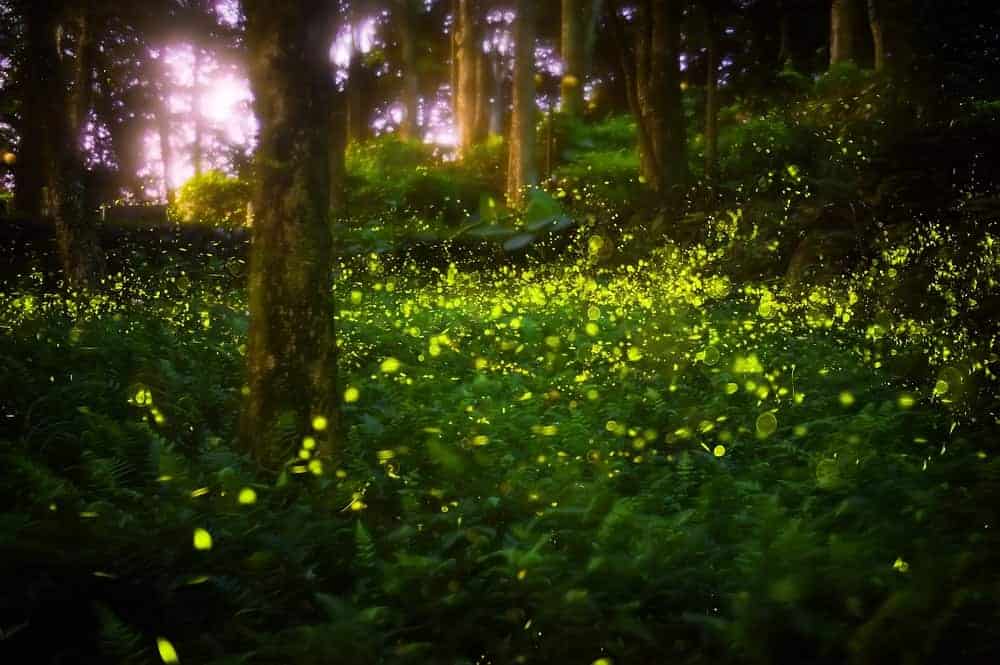
All the Details You Need: 2024 Synchronous Elkmont Fireflies Event in the Smoky Mountains
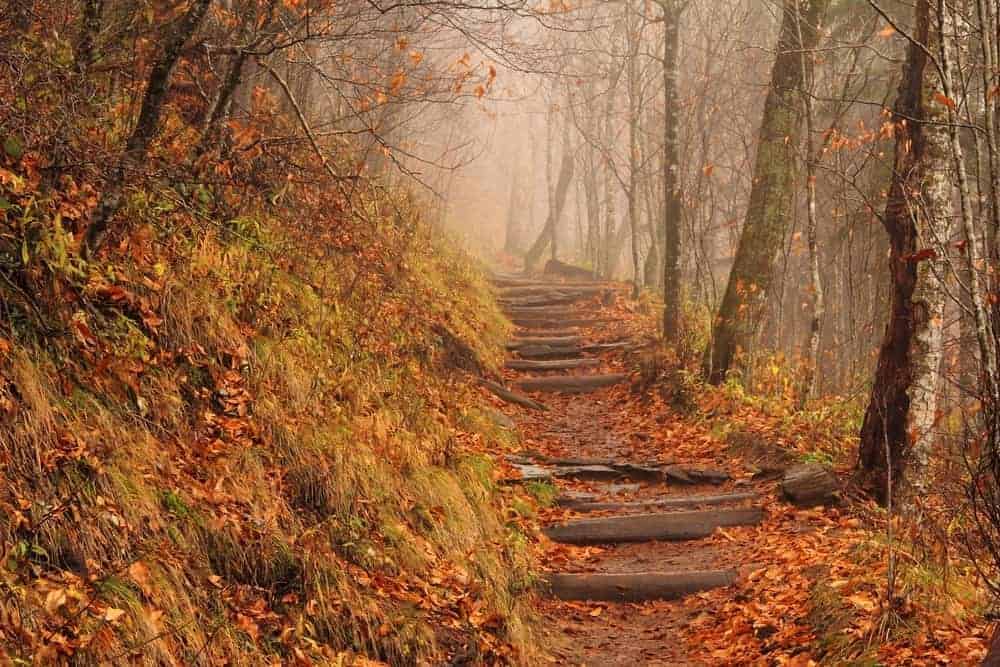
5 Picturesque Places to Escape the Crowds in the Smoky Mountains
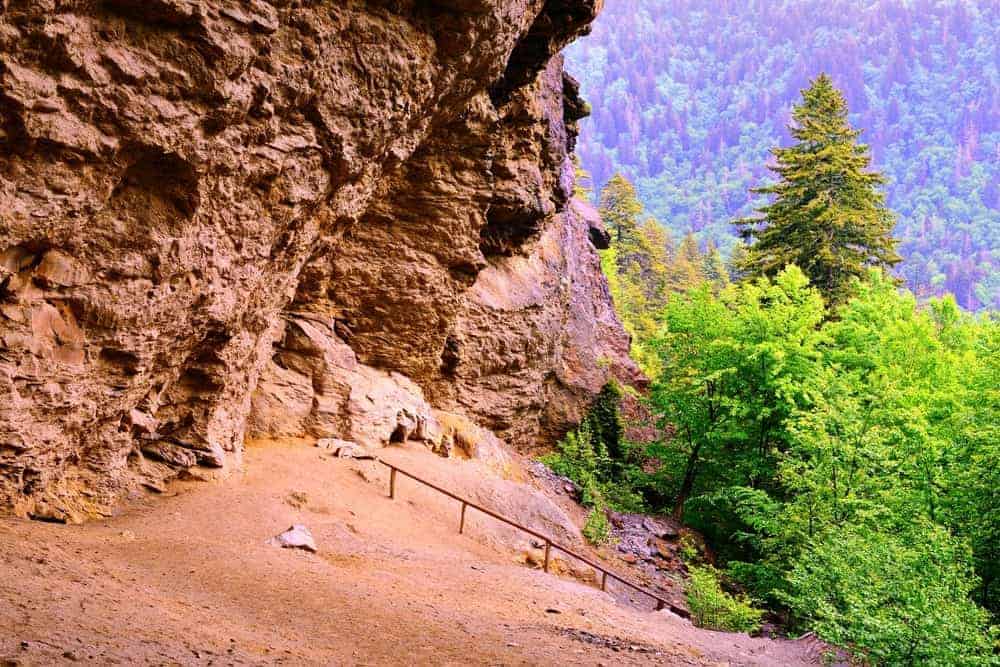
5 Special Sights to See Along the Alum Cave Trail

All About the New Dolly Parton Experience at Dollywood

High on the Hog: Top 5 Restaurants for BBQ in Pigeon Forge
Insider's view.
Get an inside look at some of the most popular places to visit in the Smoky Mountains! We’re taking you behind-the-scenes in the Smokies with videos of all the great things to do in the area.
Great Smoky Mountains National Park Travel Guide
Courtesy of Henryk Sadura | Getty Images

15 Best Things To Do in Great Smoky Mountains National Park
Updated June 10, 2022
Great Smoky Mountains National Park is a mecca for outdoor lovers. Along with its abundant wildflowers and wildlife, the park offers stunning waterfalls along wooded trails ( Grotto Falls ), strenuous climbs ( Clingmans Dome or Chimney Tops ) and scenic
- All Things To Do

Newfound Gap Newfound Gap free
Also known as notches or passes, gaps are the low points in a mountain ridge. Newfound Gap, which sits at an elevation of 5,046 feet, is the lowest drivable pass in the park. Scenic, roughly 30-mile-long Newfound Gap – U.S. Route 441 – runs through the center of the park from the Sugarlands Visitor Center near Gatlinburg, Tennessee , over the mountains and into Cherokee, North Carolina. Mile markers denote several interesting attractions along the way, including Newfound Gap, Mingus Mill, the Oconaluftee Visitor Center and Mountain Farm Museum, and the Smokemont Campground and Nature Trail.
Recent travelers who drove along this route raved about the mountain views and photo ops, although some warned that the road can be narrow and winding at times. Many recommended the Newfound Gap parking area for its scenic overlooks and access to trailheads, noting that the Appalachian Trail also crosses here. If you're visiting on a weekend, prepare for crowds: some travelers said they were unable to find parking at many of the stops.

Sugarlands Visitor Center Sugarlands Visitor Center free
According to recent travelers, the Sugarlands Visitor Center should be your first stop in the park. The visitor center features extensive natural history exhibits and screens a free 20-minute film about the park. The center also houses a bookstore, a gift shop, restrooms and a variety of information, including trail maps. There are also several ranger-led programs offered seasonally.
Recent visitors recommended picking up both driving and trail maps here, as well as getting your cancellation stamp if you have a NPS passport. Most travelers appreciated the helpful staff and the gift shop, as well as the clean restrooms. However, some lamented the limited parking during peak seasons.

Roaring Fork Motor Nature Trail Roaring Fork Motor Nature Trail free
The Roaring Fork Motor Nature Trail, a nearly 6-mile-long, one-way loop road, offers spectacular mountain scenery and access to two of the region's most popular waterfalls: Rainbow Falls and Grotto Falls . You can walk behind the 25-foot high falls at the Grotto via the Trillium Gap Trail. You'll also see historic log cabins, grist mills and an array of wildlife from birds and deer to black bears.
Recent visitors who raved about the beautiful waterfalls and mountain scenery on this motor trail said this is a must-see and a great place to spot bears in the wild. However, some summer tourists bemoaned the fact that the trail was crowded and offered limited parking areas. To avoid the midday rush of visitors, plan your drive in the morning to beat the crowds.

Popular Tours

Arctic Circle and Northern Lights Tour from Fairbanks
(688 reviews)
from $ 290.00

Thundering Streams and Falls of the Smokies Guided Hiking Tour
(107 reviews)
from $ 76.00

3-Hour Nantahala River Fully Guided Rafting Experience
(68 reviews)
from $ 65.40

Cades Cove Cades Cove free
Surrounded by mountains, Cades Cove is an isolated, fertile valley that was once home to many of the early Southern Appalachian settlers. You'll see 19th-century cabins, three churches and a working grist mill, as well as other historic outbuildings. The 11-mile, one-way loop road surrounds the Cades Cove valley and is one of the best places in the park to view wildlife. Once a hunting ground for the Cherokee American Indians, the area is now home to deer, black bears and wild turkeys. Several hiking trails, including one to Abrams Falls , begin here. Longer hikes, including Thunderhead Mountain and Rocky Top, also start here but are better suited for experienced hikers due to their steep inclines and narrow pathways.
Because the loop road is closed to motor traffic on Wednesdays from early May until early September, it's a favorite among cyclists. If you don't have your own set of wheels, you can rent bikes at the Cades Cove Campground Store (rentals for adults cost $15.00 per hour).

Clingmans Dome Clingmans Dome free
Clingmans Dome is not only the highest point in Tennessee, but also in the park itself. On a clear day, you may be able to see more than 100 miles. Take a jacket along – even in the summer – as temperatures at the 6,643-foot peak will be much colder than those in the lower elevations. There are several scenic pullouts along Clingmans Dome Road, which ends in a parking area at the trailhead. The trail is paved, but very steep, and leads to an observation tower at the summit. There are also several other trails that start at Clingmans Dome Road and its parking area, including the Appalachian Trail , which crosses Clingmans Dome and is the highest point along its route from Georgia to Maine.
Recent travelers called this the most amazing sight in the mountains, despite the steep trail. Many advised visiting on a sunny day, as clouds and fog can obscure the stunning views from the dome, or arriving during sunset. Some noted that parking is limited and especially hard to snag at peak times during the summer and on weekends. Most also advised bringing warm clothing, as the weather at the top of the summit can often get windy.

Cades Cove Visitor Center Cades Cove Visitor Center free
The Cades Cove Visitor Center is located about midway on the 11-mile, one-way Cades Cove Loop Road. One of the most popular areas in the park, the Cades Cove valley is known for its abundant wildlife, including white-tailed deer, black bears, turkeys, raccoons and other animals. The visitor center features both indoor and outdoor exhibits detailing Southern mountain life. Visit the Cable Mill, a grist mill that operates in the spring, summer and fall, and the historic Becky Cable House, or explore the exhibits inside the center. Several ranger-led programs are available seasonally and the visitor center offers a bookstore, public restrooms and trail maps for hikers.
Recent travelers complimented the friendly staff members and extensive information available at the Cades Cove Visitor Center, but noted that public restrooms are scarce on the Cades Cove loop, so many recommended utilizing the ones at the center before embarking on the 11-mile drive. Many also praised the well-stocked gift shop. Some reviewers noted that on busy weekend days during peak seasons traffic was very slow on the loop road.

Abrams Falls Trail Abrams Falls Trail free
Named for a Cherokee chief whose village once occupied a spot alongside the creek, Abrams Falls is small, but mighty. While the falls are only 20 feet high, they pump out a large volume of water, creating a long, deep pool at its base. The 5-mile, round-trip hike through the forest is considered moderate for experienced hikers, but difficult for novices, and rangers recommend carrying a supply of water and wearing sturdy hiking shoes. Swimming in the pool at the base of falls is extremely dangerous, due to strong currents and an undertow.
Many recent visitors said this hike offered a great way to escape the summer heat, with many recommending hikers pack a picnic lunch to enjoy by the water. Some also advised using hiking poles on the rough and unpaved path and wearing your best waterproof hiking boots (sections of the trail cut across water). Hikers also suggest setting out on the trail early in the morning or later in the afternoon to enjoy some peace and quiet, although many agreed this trail is less crowded than others in the park.

Grotto Falls Trail Grotto Falls Trail free
Located along the Trillium Gap Trail – off the Roaring Fork Motor Nature Trail – Grotto Falls is a nearly 3-mile-long, round-trip hike that runs behind a 25-foot waterfall. Summer hikers love the cool environment through the old-growth hemlock forest and by the falls, although park officials caution that swimming or climbing on rocks near the falls is prohibited.
Although some recent visitors said Grotto Falls was doable for amateur hikers, most cautioned that the rough and slippery trail – and its exposed tree roots – is not recommended for novices or children. Many also commented on the uphill climb and the stream crossings, which can be very slippery, but all visitors were impressed with the amazing waterfall. Some reviewers also recommended wearing sturdy hiking shoes with good traction, due to the mud, and keeping an eye out for bears.

Great Smoky Mountains National Park Self-Guided Driving Tour
(201 reviews)
from $ 16.99

Historic River Town Ramble
(26 reviews)
from $ 85.00

25+ National Parks Self-Guided Driving Tours Bundle
(4 reviews)
from $ 84.99

Laurel Falls Laurel Falls free
Named for the mountain laurel (an evergreen shrub) that blooms throughout the park, Laurel Falls is one of the most popular trails in the park. The path has an upper and a lower section, divided by a walkway at the base of the upper falls (which measure 80 feet in height). Although the round-trip hike is only 2.6 miles, it takes about two hours, due to the rough and uneven pavement and steep incline. Because of its popularity, the trail is busy year-round, especially on weekends and during the peak summer season.
Some recent hikers thought the trail was somewhat dangerous, mentioning steep drop-offs with no handrails and the rocky nature of the trail itself, while other more experienced hikers found it easy. All agreed that it was incredibly scenic and a great location for photos, especially in May and June, when the laurel is in bloom. Many advised that the lack of ample parking required some extra walking to reach the trailhead and noted that the area is known for its bear population, cautioning visitors to carry bear spray and refrain from discarding food along the trail.

Chimney Tops Chimney Tops free
Chimney Tops is one of the few mountains that has a bare rock summit and the views from the top are spectacular, according to travelers. The more than 4-mile out and back trail is a short climb, but a very steep and strenuous one that requires scrambling over rocks to reach the top, so it's not for novice hikers or young children. Even with the high degree of difficulty, it's still one of the most popular trails in the park.
Hikers who visited recently noted that although climbing the pinnacles is not possible due to fire damage from 2016, the vistas from the viewing platform (which is part of the lower portion of the trail that is still accessible) are worth the trek. Some recommended taking a break at the scenic picnic area by the stream, located below the chimneys. Many also cautioned that the area is bear territory.

Oconaluftee Visitor Center Oconaluftee Visitor Center free
The Oconaluftee Visitor Center is the main welcome and information center for the North Carolina side of the park. It is the first new visitor center to be constructed in the park since the 1960s and features eco-friendly materials and an energy-efficient design. Here, visitors can enjoy a bookstore, a gift shop, restrooms, trail maps and a museum detailing the history of the park. Adjacent to the center also lies the Mountain Farm Museum, a preserved 19th-century farmstead, including a barn, spring house, an apple house and a working blacksmith shop. Farm life demonstrations and ranger programs are conducted seasonally. For hikers, a short, 1.5-mile trail runs along the Oconaluftee River, leading from the Oconaluftee Visitor Center to the outskirts of Cherokee, North Carolina. It is one of two trails in the park that allows pets and bicycles.
Recent travelers loved watching the elk that roam the fields next to the visitor center and recommended visiting the Mountain Farm Museum. Many also praised the center's gift shop and clean restrooms. However, some reviewers noted crowds during peak seasons.

Alum Cave Trail Alum Cave Trail free
Visitors looking for a challenging hike filled with sweeping mountain vistas and unique geological landmarks should consider the Alum Cave Trail to Mount LeConte. This popular 11-mile out and back trail passes under Arch Rock, a narrow natural tunnel formed over time due to wind and water erosion, and leads to the Alum Cave Bluffs and overlooks, such as Inspiration Point and the summit of Mount LeConte. Much of the trail passes through old-growth hardwood forest, where beautiful rosebay rhododendron blooms in summer.
Recent visitors loved Arch Rock and Alum Cave, with several travelers noting that the trail gets steeper and more difficult on the second leg. Many also praised the well-maintained trail and beautiful mountain views, but warned that the summit of Mount LeConte is often shrouded in clouds. Some hikers also cautioned that the trail becomes covered in ice in winter, so some recommended bringing spikes for your shoes and hiking poles and arriving in the afternoon to allow time for the sun to melt the ice.

Cataloochee Valley Cataloochee Valley free
One of the most remote places in the park, Cataloochee Valley is a tranquil place to spend an afternoon. Several well-preserved 19th- and 20th-century historic buildings can be found in the area, remnants of a pioneer community that once flourished on the grounds. Two churches, a barn, a school and several homes can be toured, and a self-guided auto tour booklet (which can be purchased online for $1) gives brief histories of each structure. The valley is also known for its herds of elk, the result of a 2001 project that reintroduced elk to the park. Arrive at dawn or dusk for the best chances of seeing them grazing the valley fields. In addition to ample wildlife viewing opportunities, this section of the park features hiking trails, fishing in Cataloochee Creek and a primitive campground.
While many visitors complimented Cataloochee's beautiful scenery and roaming herds of elk, some complained about the less-than-stellar restrooms and dangerous, narrow gravel road leading to the valley. Many travelers recommended driving cautiously (the road is winding with steep drop-offs) and using a four-wheel-drive vehicle if possible.

Scenic Blue Ridge Parkway Self-Guided Driving Audio Tour
(23 reviews)
from $ 24.99

Great Smoky Mountains National Park and Cades Cove Self-Driving Bundle Tours
(57 reviews)

Museum of the Cherokee People Admission Ticket
(91 reviews)
from $ 8.00

Rainbow Falls Trail Rainbow Falls Trail free
Read More »

Elkmont Elkmont free

Explore More of Great Smoky Mountains National Park

Best Hotels

When To Visit
If you make a purchase from our site, we may earn a commission. This does not affect the quality or independence of our editorial content.
Recommended
The 18 Best Napa Valley Wineries to Visit in 2024
Lyn Mettler|Sharael Kolberg April 23, 2024

The 25 Best Beaches on the East Coast for 2024
Timothy J. Forster|Sharael Kolberg April 19, 2024

The 50 Best Hotels in the USA 2024
Christina Maggitas February 6, 2024

The 32 Most Famous Landmarks in the World
Gwen Pratesi|Timothy J. Forster February 1, 2024

9 Top All-Inclusive Resorts in Florida for 2024
Gwen Pratesi|Amanda Norcross January 5, 2024

24 Top All-Inclusive Resorts in the U.S. for 2024
Erin Evans January 4, 2024

26 Top Adults-Only All-Inclusive Resorts for 2024
Zach Watson December 28, 2023

Solo Vacations: The 36 Best Places to Travel Alone in 2024
Lyn Mettler|Erin Vasta December 22, 2023

26 Cheap Beach Vacations for Travelers on a Budget
Kyle McCarthy|Sharael Kolberg December 4, 2023

The 50 Most Beautiful White Sand Beaches in the World
Holly Johnson December 1, 2023

Plan, Ready, Go®
Great Smoky Mountains National Park Itinerary for a Perfect Trip
If you’re looking for an epic adventure, look no further than the Smokies. This Great Smoky Mountains National Park itinerary and travel guide will help you make the most of your trip.
Great Smoky Mountains National Park is located in eastern Tennessee and western North Carolina, and it’s home to some of the most beautiful scenery in the United States. There are plenty of things to do in this park, so it’s the perfect destination for everything from a fun day trip to a romantic weekend getaway to a big vacation with the whole family.
In this article, I’ll cover important topics like the best time to visit, where to stay, what to see and do, and more.
Plan the perfect trip to the Smokies with this FREE printable travel planner.
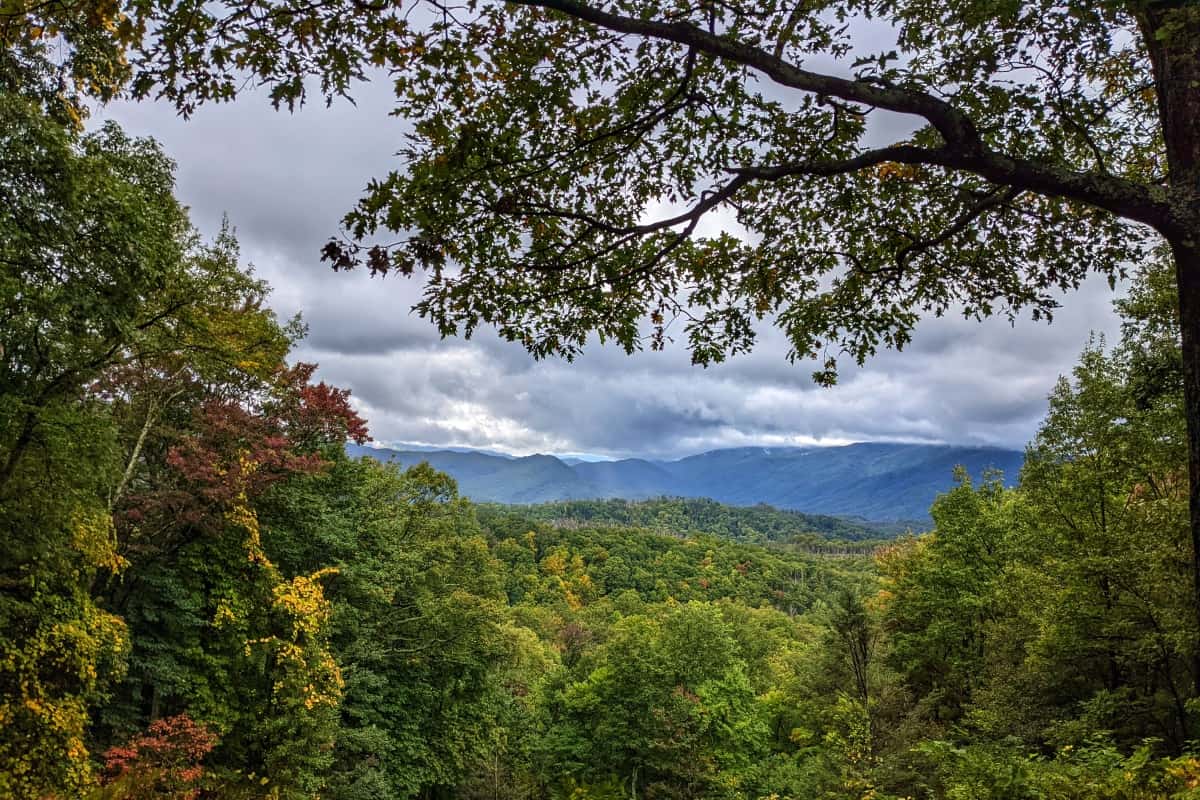
This post includes affiliate links. If you make a purchase through one of these links, I may earn a small commission at no additional cost to you. As an Amazon Associate, I earn from qualifying purchases. See disclaimer.
Great Smoky Mountains National Park facts
Here are some interesting facts about Great Smoky Mountains National Park to help you get to know the Park a little better before your trip.
- Entrance to Great Smoky Mountains National Park is free , and it’s open 24 hours a day all year round. (Effective March 1, 2023, parking tags are required to park in GSMNP for more than 15 minutes.)
- The Park covers more than 520,000 acres.
- The land area that the Park covers is split almost evenly between Tennessee and North Carolina.
- Great Smoky Mountains National Park is the most visited of all 63 U.S. National Parks …by quite a lot. More than 14 million guests visited GSMNP in 2021.
- The Park includes 10 campgrounds , not including backcountry camping options.
- Great Smoky Mountains National Park includes 384 miles of road .
- Clingmans Dome is the highest point in the Park at 6,643 feet . It’s also the highest point in Tennessee and the third-highest point east of the Mississippi River.
- Great Smoky Mountains National Park was designated a World Heritage Site in 1983 .

Great Smoky Mountains National Park itinerary
Now for the good stuff. There are so many things to do in Great Smoky Mountains National Park that building an itinerary is a challenge.
My recommendation is that you plan to spend at least two full days in the Park , but more is certainly good as well.
Shake things up and make this itinerary your own. How you put these pieces together may largely depend upon where you are staying on your trip to the Smokies (and what entrance you’re using).
Be advised: drive times inside the Park can be quite long. There are essentially only a few major driving routes within the park.
Get a park map and get familiar with it and use it. Do not rely on GPS to get you around the park. It may steer you wrong. You can pick up a map at any visitor center.
TIP: Keep track of all the amazing sites you’re seeing in the park with this printable Great Smoky Mountains National Park bucket list . On a quest to visit all 63 U.S. National Parks? Grab your own copy of the printable national parks tracker to check off your progress as you visit each park.
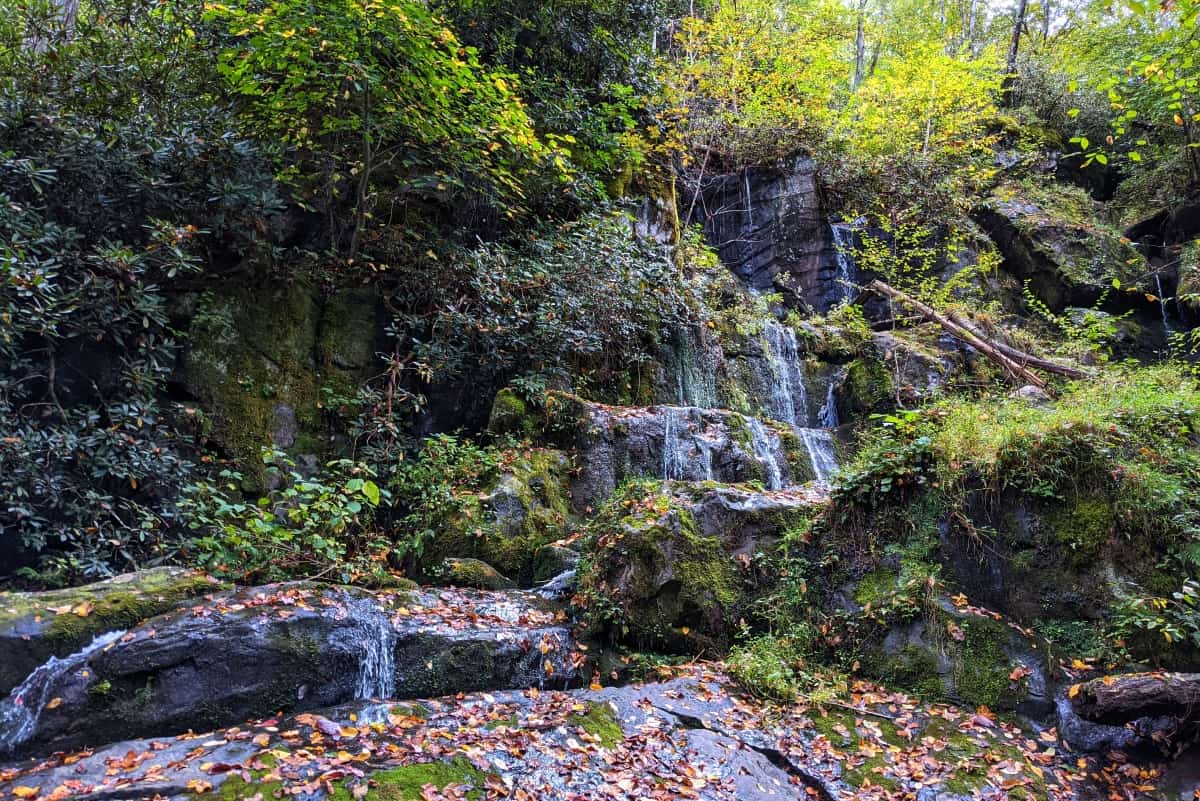
Visitor Center
Make your first stop at the Oconaluftee or Sugarlands Visitor Center to pick up a park map and any other information you need for your visit to Great Smoky Mountains National Park.
If you’re staying in Townsend, Tennessee, the closest Visitor Center to you will be in Cades Cove. I would recommend you start your itinerary with Cades Cove anyway if you’re staying in Townsend, so there you go.
If you don’t want to go to the Visitor Center you can download a park map from the National Park Service website.
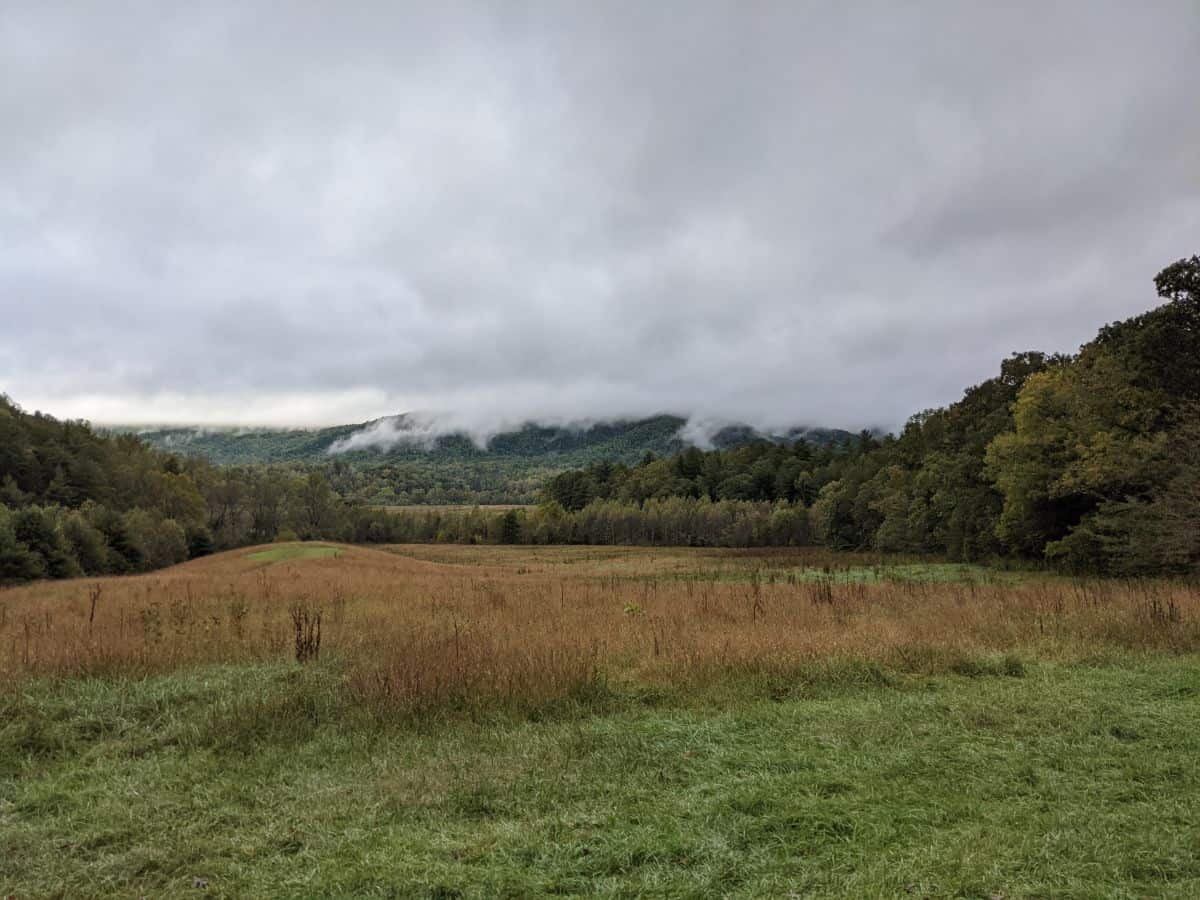
I recommend everyone start their trip to Great Smoky Mountain National Park with a drive through Cades Cove. It’s on the western side of the Park and it’s hugely popular. Plan to arrive at the entrance to the loop at the time it’s opening or even a few minutes before.
For a very nominal fee (it was $1 when we bought it) you can purchase a small booklet that will give you more information about Cades Cove and all of the stops on the scenic drive.
The Cades Cove Loop Road is a great place to see wildlife, so keep your eyes peeled for deer, bears, and other animals.
Let me stop here to say one thing. PLEASE DO NOT block the roadway so that you can get a better look at the black bears. It is unkind to back up traffic for 20 minutes so you can get your perfect photo. If there is not a safe place to pull over, keep moving .
Okay, rant over.
Plan to spend at least two hours driving through Cades Cove, longer if you’re there during peak travel times or a busy part of the day. I’d say it’s safest to plan to spend your entire morning there exploring.
Pack your patience. There may be times when the traffic is stopped or very slow because of road congestion.
There are so many things to see in Cades Cove and there are hikes in that area as well as one of the three Park Visitor Centers. Plenty to fill up at least your morning if not your full day.
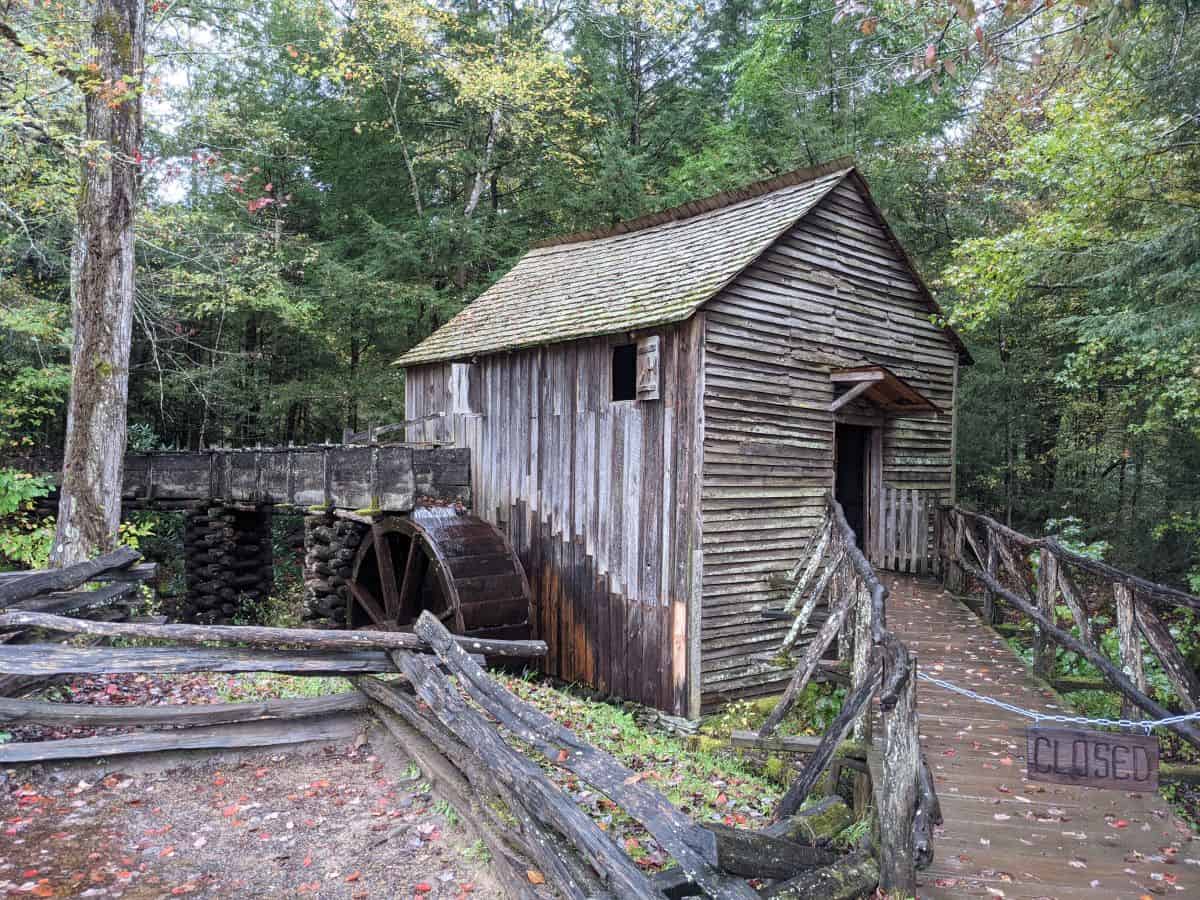
Laurel Falls Trail
The popular Laurel Fall Trail hike is a must-do in Great Smoky Mountains National Park. This trail can also get quite busy, so you might want to save this for first thing in the morning on your second day in the Park rather than right after Cades Cove.
Use your best judgment, and keep in mind that parking at the trailhead is quite limited .
Plan for this 2.6-mile roundtrip hike to take you about 2 hours . It’s considered moderate in difficulty.
Roaring Fork Motor Nature Trail
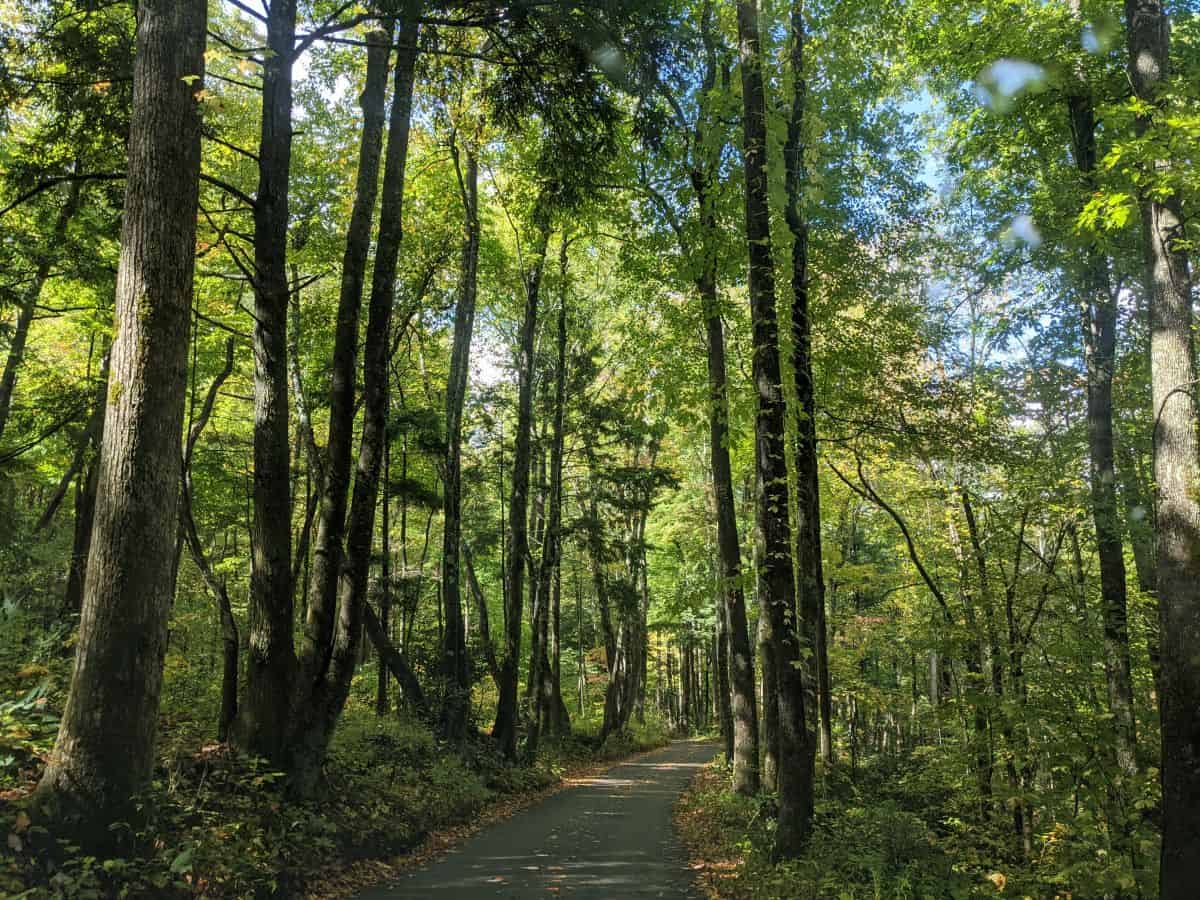
The other scenic drive in Great Smoky Mountains National Park is not to be missed. If you’re not much of a hiker, you can definitely do both Cades Cove and the Roaring Fork on the same day. Or do one scenic drive each of your two days in the Park.
The Roaring Fork Nature Motor Trail is on the east side of the Park near the Orchard Park entrance. In our experience, it wasn’t nearly as busy as Cades Cove.
The entire drive is about 5.5 miles on a one-way road. It does get a bit narrow at times so drive with care. This trail is a great way to see the park’s beautiful scenery. Please give it a try.
Newfound Gap
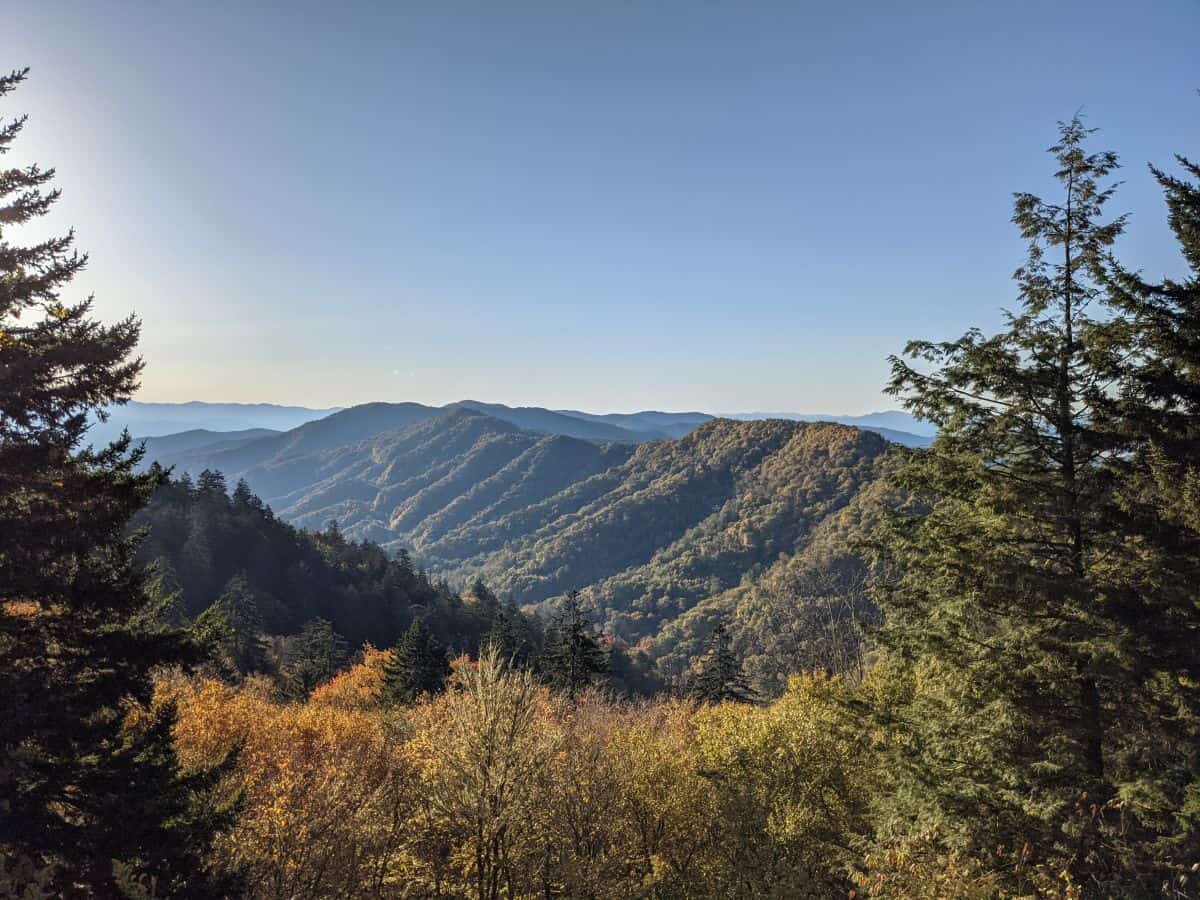
For beautiful views head to Newfound Gap…in fact, the entire drive along Newfound Gap Road from Cherokee to Gatlinburg (or the reverse) is just stunning.
There are several places to pull over and enjoy the amazing views along Newfound Gap Road. Take advantage, please. You won’t be sorry.
You’ll climb (in your car) about 3,000 feet. Please note that the temperatures at Newfound Gap will likely be quite a bit cooler than the surrounding lowlands.
The Appalachian Trail crosses Newfound Gap Road, so if you feel like stretching your legs and giving it a try go ahead. Then you can tell everyone you hiked the Appalachian Trail.
Clingmans Dome
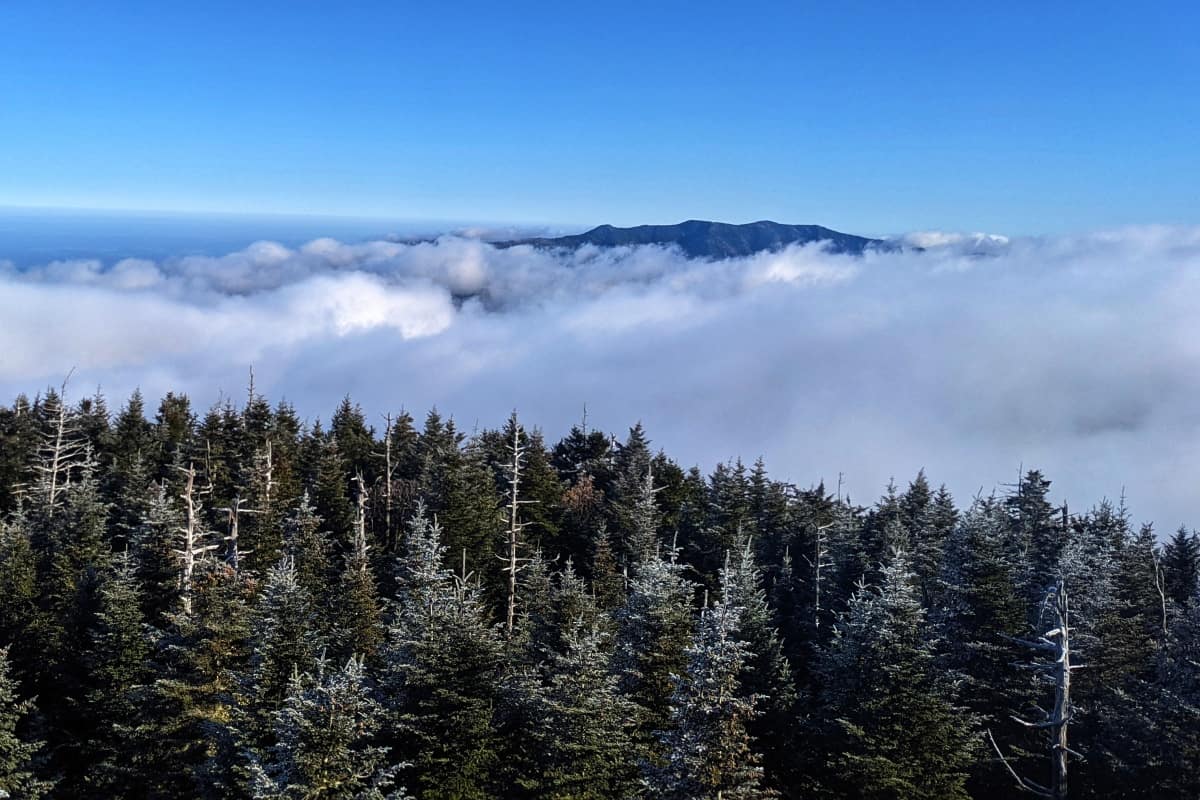
Just south of Newfound Gap, you’ll find the turnoff from Newfound Gap Road to Clingmans Dome Road.
This 7-mile road will take you up to the parking area just about half a mile from the top of Clingmans Dome (6,643 feet), which is the highest point in the Park. The road is closed to vehicles generally from Dec. 1 through March 31.
There’s plenty of parking up there, vault toilets, and a gift shop/visitor information center.
The half-mile hike up to the top of Clingmans Dome is paved and quite steep. Please wear appropriate footwear.
There’s also an observation tower at the top of Clingmans Dome that offers stunning views of the surrounding mountains and forests. It is said that on a clear day, you can see 100 miles.
Even if you aren’t sure you want to do the hike, the view from the parking lot is still quite wonderful and worth the drive.
Please note that it can get COLD up there. SIGNIFICANTLY colder than the surrounding lower elevations.
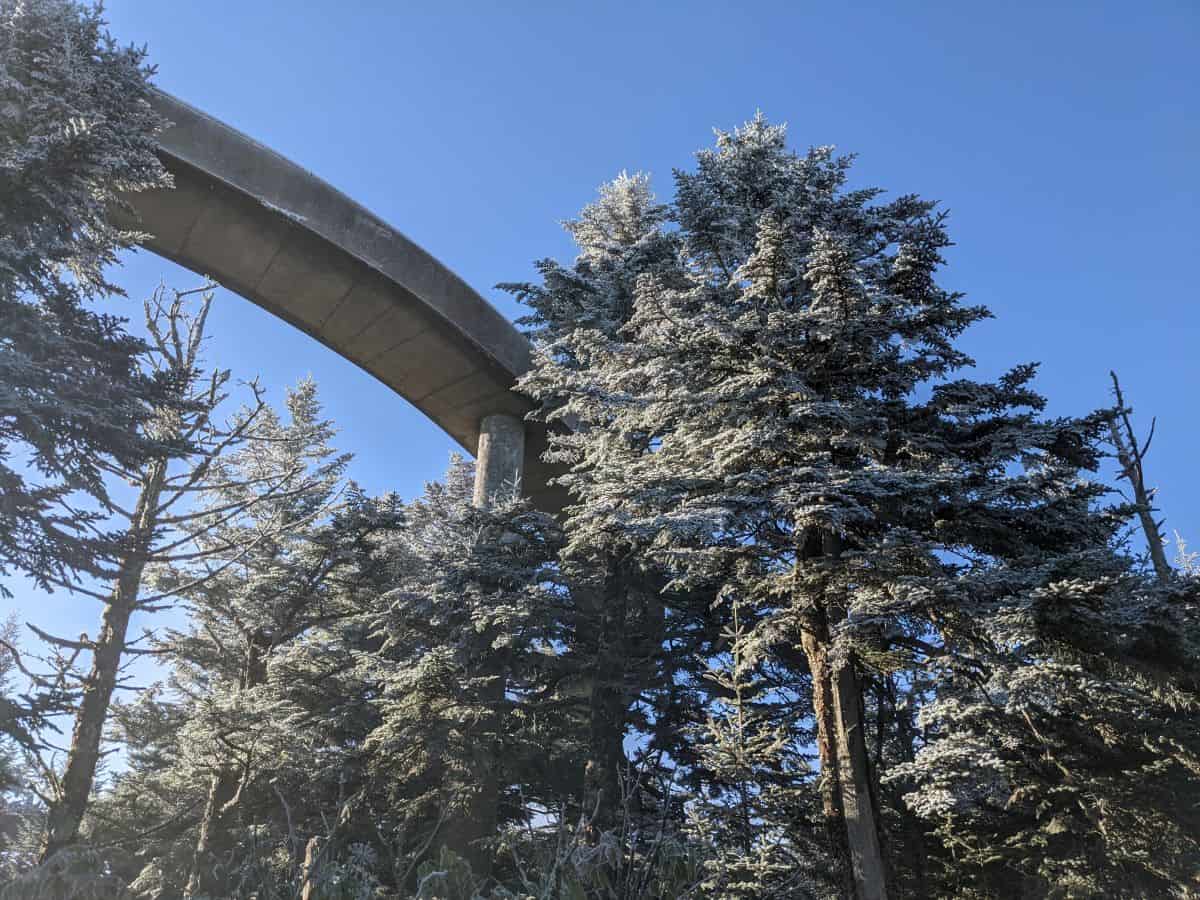
Other things to add to your Great Smoky Mountains National Park itinerary
Cataloochee valley.
The isolated Cataloochee Valley offers guests the opportunity to see the historic valley as it was. It preserves several historic buildings. There are also opportunities for wildlife viewing. Use caution when driving on the narrow roads.
More hikes in Great Smoky Mountains National Park
Great Smoky Mountains National Park is home to more than 150 official hiking trails from short, easy, kid-friendly hikes to quite long hikes requiring significant hiking experience.
Here are a few of the most popular hikes in the Park that I haven’t already touched on.
- Rainbow Falls, 5.4 miles, moderate
- Alum Cave Bluffs, 2.5 miles one way
- Abrams Falls, 5 miles roundtrip, moderate to difficult
- Grotto Falls, 3 miles roundtrip, moderate
If you’re traveling with children you might enjoy the short, easy Cataract Falls Trail. The falls are about 0.7 miles from the Sugarlands Visitor Center.
Best time to visit Great Smoky Mountains National Park
The best time of year to visit Great Smoky Mountains National Park varies depending on what you want to do.
The park is busiest from May through October , and the fall colors are at their peak in October. On average, over the last decade or so, June, July, and October have been the busiest months.
If you’re interested in hiking, the spring and autumn months are the best time to visit, as the summer months are hot and humid. Again, expect to encounter many people if you’re there in October.
If you’re looking for an amazing natural phenomenon to witness, look no further than the synchronous fireflies at Great Smoky Mountains National Park.
Every year, around the end of May or the beginning of June, this park hosts a special event in the Elkmont area where visitors have a chance to see large numbers of these fireflies light up at once.
Vehicle passes are awarded by a lottery system, so there’s, unfortunately, no guarantee that you’ll be able to see them.
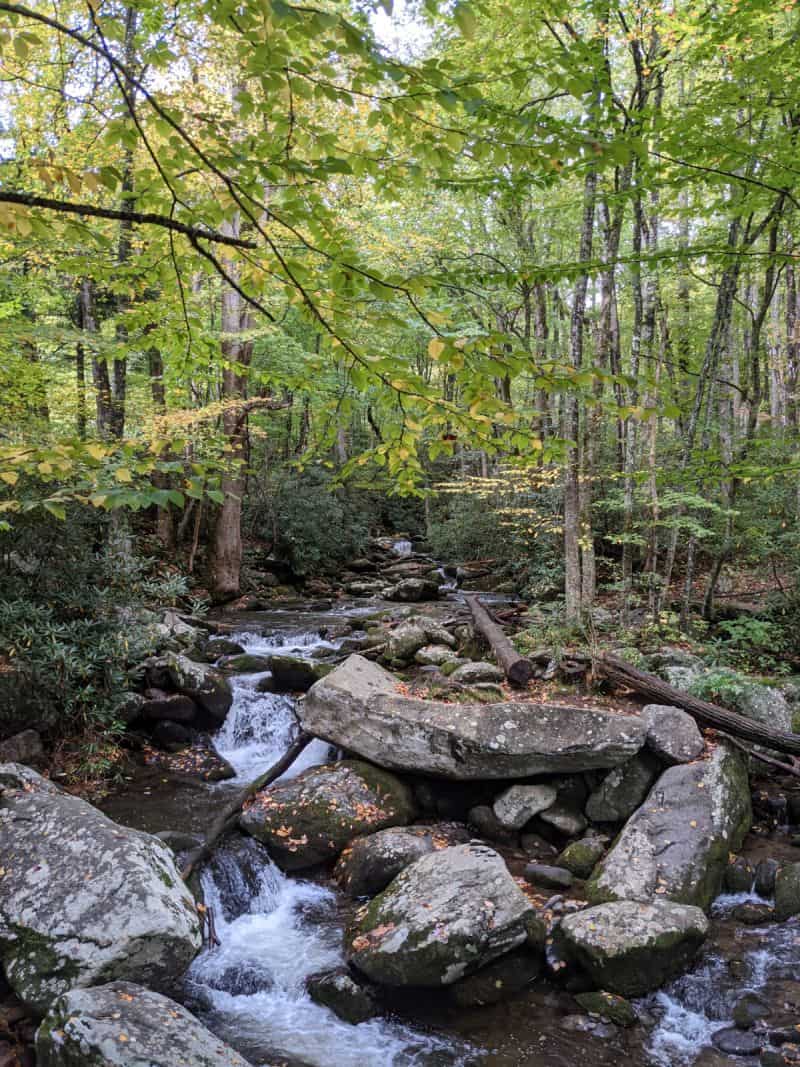
Where to stay on your trip to Great Smoky Mountains National Park
For a complete discussion of where to stay on your trip, see my article all about where to stay in the Smokies.
Campgrounds in Great Smoky Mountain National Park
Camping is a great way to experience Great Smoky Mountains National Park.
There are 10 developed frontcountry campgrounds in the park , and they offer a variety of amenities including restrooms (with cold running water and flush toilets), fire grate, and picnic tables. Most of the campgrounds are available seasonally, with a couple open all year round.
Backcountry camping, group camping, and horse camps are also available. Most of the campgrounds are also located near popular attractions, so you’ll be able to enjoy the beauty of the park while you’re camping.
Hotels near Great Smoky Mountains National Park
There are no motels or inns in Great Smoky Mountains National Park. LeConte Lodge is only accessible on foot after hiking at least 5 miles.
If you prefer to stay in hotels, your only option will be to stay in one of the gateway towns at the major entrances to the Park.
Gatlinburg, Tennessee
You’ll have the most hotel options if you stay in Gatlinburg, Tennessee. It’s located just outside the park, and it also offers a variety of restaurants, shops, and other attractions.
Here are a few highly rated hotel options in Gatlinburg:
The Park Vista offers beautiful views of the Smoky Mountains, and every room comes with a balcony.
Margaritaville Resort is cram-packed with amenities and just a short drive to Great Smoky Mountains National Park.
Fairfield Inn and Suites is a favorite affordable hotel brand for me and Hubby. Their downtown Gatlinburg location is very close to the start of the Roaring Fork Motor Nature Trail (see below).
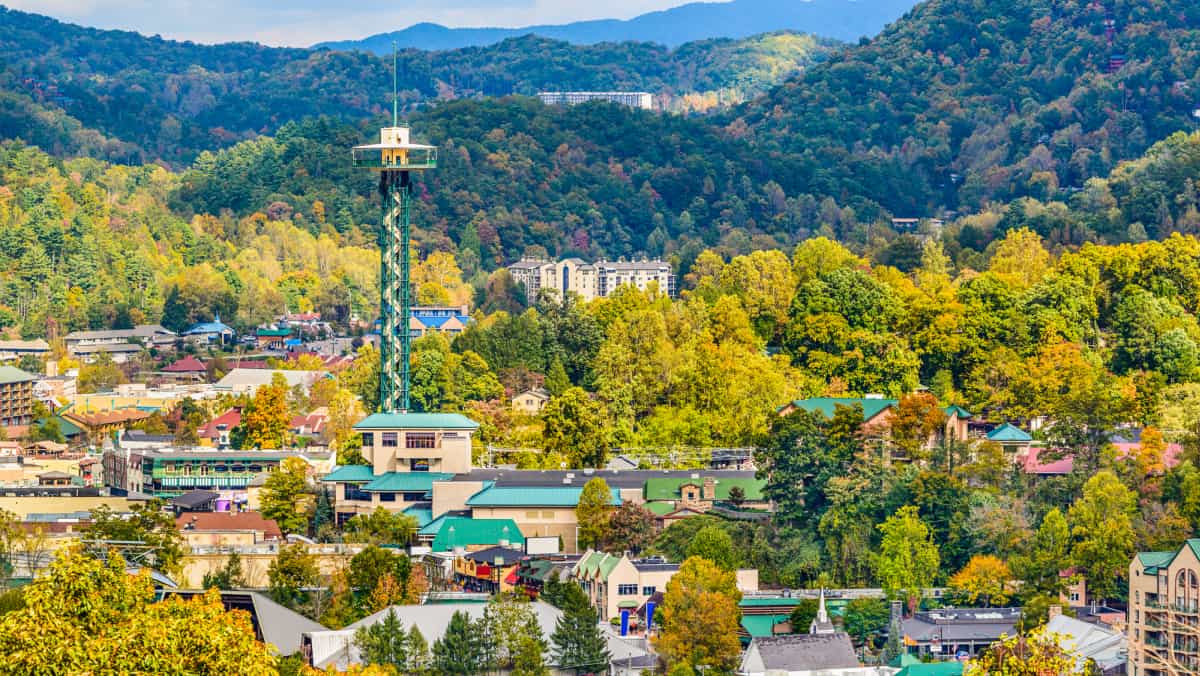
Cherokee, North Carolina
Cherokee is another great option as it’s very near the Park and the Oconaluftee Visitor Center.
Major attractions in Cherokee, aside from the Park, are Harrah’s Cherokee Casino, the Museum of the Cherokee People, and the Blue Ridge Parkway. Cherokee is the southern terminus of that famous scenic route.
Cherokee lodging options include:
- Stonebrook Lodge : We enjoyed our stay here, just minutes from Great Smoky Mountains National Park. Offers free parking and comfortable rooms but a subpar continental breakfast. We opted to grab a wonderful breakfast at Peter’s Pancakes and Waffles in town.
- Great Smokies Inn : Just minutes from the Oconaluftee Visitor Center and the southern end of the Blue Ridge Parkway.
Townsend, Tennessee
Townsend, Tennessee, is located on the “quiet side” of Great Smoky Mountains National Park. It also has the benefit of being the closest town to the popular Cades Cove scenic drive (more on that below).
Highland Manor Inn is just four minutes from the west entrance to Great Smoky Mountains National Park. Guests love how close the property is to the Park.
Other hotel options for staying near Great Smoky Mountains National Park
Further from the park, but also popular are Pigeon Forge and Sevierville , Tennessee. Pigeon Forge includes a lot of tourist attractions.
Guests love the Residence Inn Pigeon Forge for its location and spacious rooms.
Those who prefer to avoid major hotel chains may like The Inn on the River . Guests enjoy the service and location. It’s about 13 miles from the Sugarlands Visitor Center and about a 10-minute drive from Dollywood.
Sevierville is located about 17 miles from the Sugarlands Visitor Center (inside the Gatlinburg entrance). You would need to plan on a 35 – 40 minute drive to be inside the park from Sevierville…potentially longer if the Gatlinburg traffic is really congested.
When is it not, right?
To really save money during peak fall colors time, when hotel rates were higher than we wanted to spend, we chose to stay at the Fairfield Inn & Suites Knoxville Airport Alcoa .
We had a fine stay. And while it was nice to save $100/night on the hotel room, we ended up doing A LOT more driving than I think I would want to do on a return visit to the Park.
Great Smoky Mountains National Park entrances
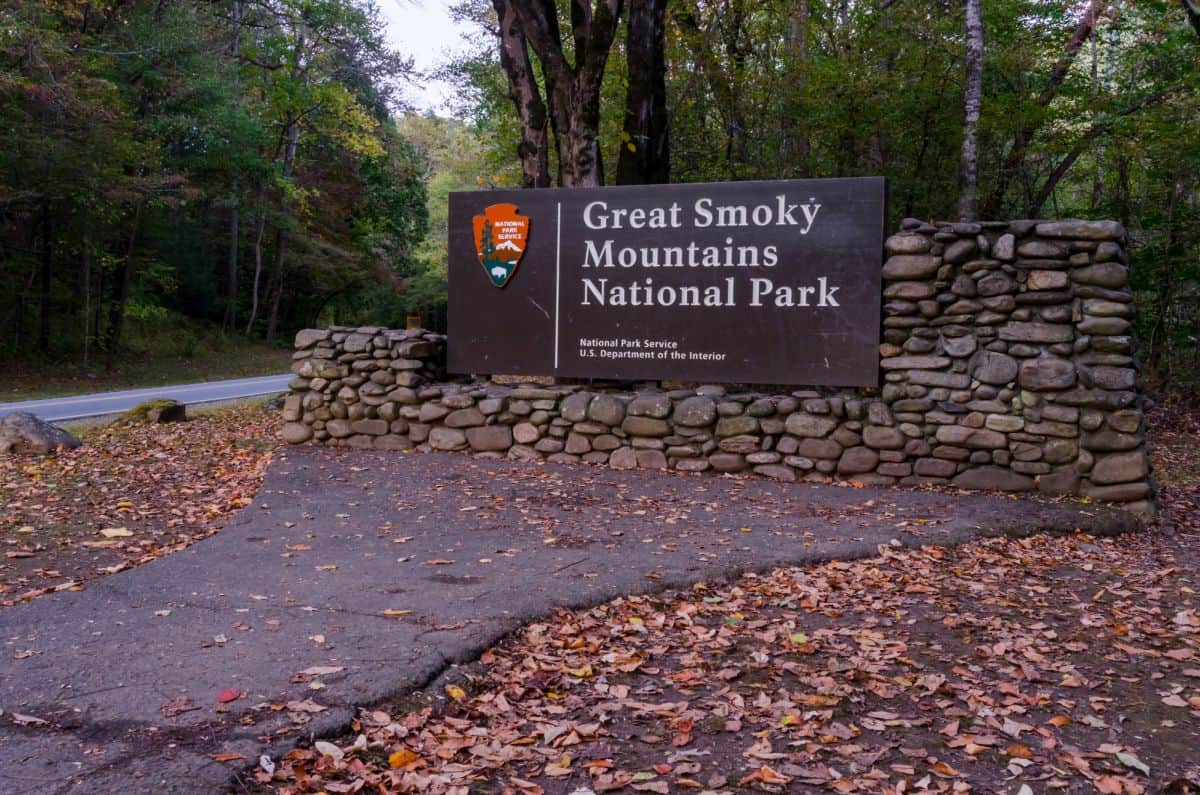
There are several entrances to the Great Smoky Mountains National Park, and each offers its own unique experience.
The most popular entrance is located in Gatlinburg . The entrance is the closest to popular Gatlinburg attractions, and it’s also where you’ll find the greatest concentration of hotels and restaurants.
One downside is that this entrance is also quite popular and can get VERY congested during peak travel times . Those staying in Gatlinburg always seem to want to enter and leave the Park at about the same time.
We live in Upstate South Carolina and use the Cherokee, North Carolina, entrance . From there you can follow the beautiful scenic drive along Newfound Gap Road through the Park. It’s also a great option if you’re looking to avoid the crowds at the Gatlinburg entrance.
Finally, for an even less crowded entrance into the park Townsend, Tennessee , is the entrance you’re looking for. It also has the benefit of being the entrance closest to the popular Cades Cove scenic loop.
Great Smoky Mountains National Park Visitor Centers
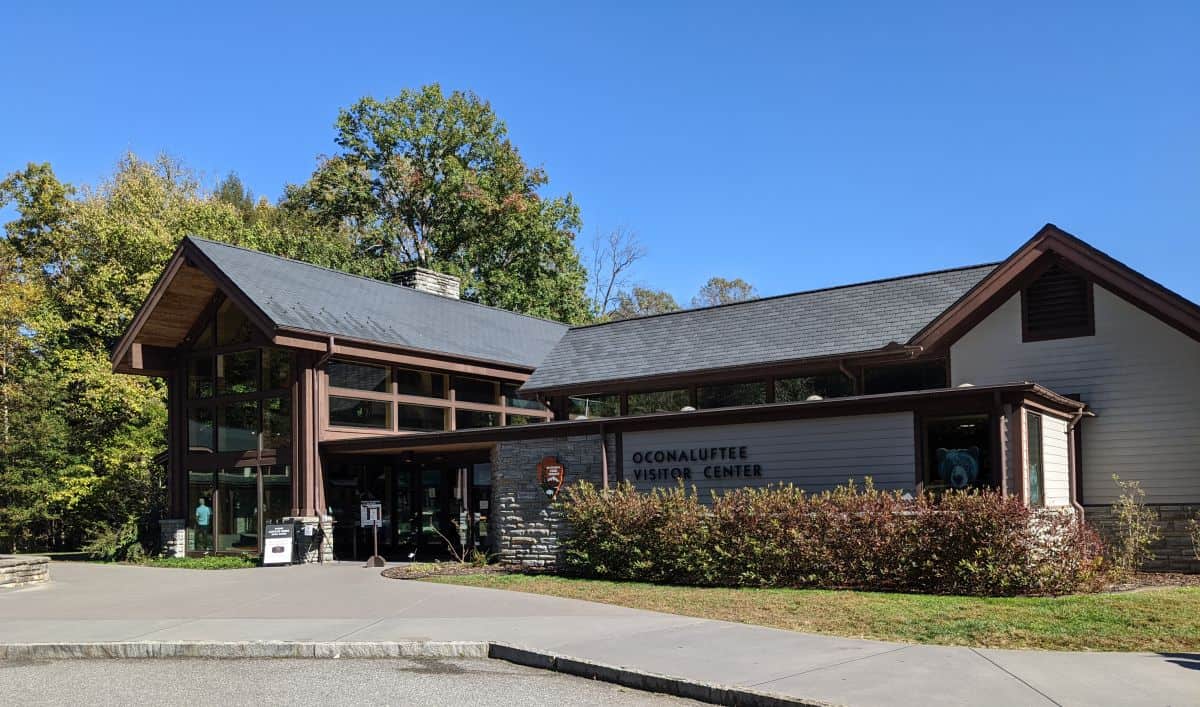
There are three visitor centers in Great Smoky Mountains National Park as well as a small “contact station” at Clingmans Dome.
We always make it a point to stop at a Visitor Center for any National Park trip. You’ll want a park map at least. Plus there are restrooms, gift shops, and you can talk to a park ranger if you have any questions.
The Sugarlands Visitor Center is the most popular in the park . It’s located near the Gatlinburg, Tennessee, entrance.
The Sugarlands Visitor Center also offers a variety of ranger-led programs, so it’s a great place to learn about the park. The Backcountry Permit Office is also at the Sugarlands Visitor Center.
The Oconaluftee Visitor Center is closest to the Cherokee, North Carolina , entrance. Like the Sugarlands Visitor Center, here you can find a gift shop, helpful National Park Service staff, maps, restrooms, and more.
The third Visitor Center is on the Cades Cove Scenic Loop . This center is much smaller than the other two, but you’ll still find a gift shop, restrooms, etc. There are also several historic buildings nearby that you can explore including a grist mill.
Picnic areas in Great Smoky Mountains National Park
Great Smoky Mountains National Park is a great place to enjoy a meal outdoors, and it offers a variety of great picnic areas to choose from.
The picnic areas are:
- Collins Creek
- Metcalf Bottoms
- Twin Creeks
Some picnic areas are open seasonally and some offer pavilions that can be reserved for groups.
If you’re having a hard time choosing where to enjoy your picnic, I’d suggest you check out Chimneys . It’s located on the West Prong Little Pigeon River and several of the picnic sites are right on the river. Guests are welcome to enjoy the cool water of the river on hot days.
Cades Cove is also a popular picnic spot. You’ll find it near the entrance/exit to the scenic loop.
What to take with you on your Smoky Mountains hike
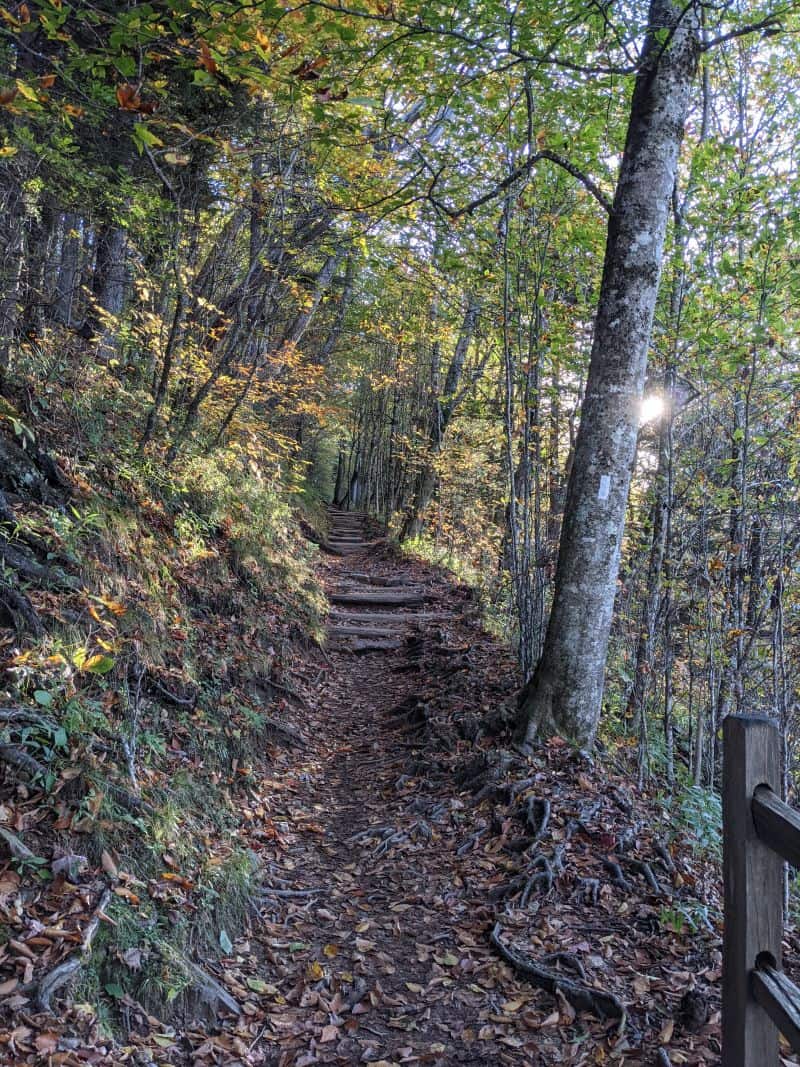
Hiking is a lot more fun when you’re prepared with the right shoes and clothing. The correct outfit can increase your comfort and make the whole hike much better.
It’s best to dress in layers while hiking so you can peel off or put on clothes as the temperature changes. Make sure you pack weather-appropriate outerwear and plenty of snacks and water.
My hiking favorites
Hiking shoes —I prefer to wear waterproof hiking shoes over hiking boots. Trail running shoes can also be a good option depending on the hike if that’s your preference.
I love my waterproof Keen hiking shoes. You can check the price on Amazon here.
Waterproof shell —The weather can change rapidly, so it’s important to make sure you carry with you some protection from the elements…even if the forecast is for a lovely and dry day.
I love my Columbia Arcadia II jacket. You can check out the price on Amazon here.
Trail pants —I love my Columbia Saturday Trail Pants. They’re really lightweight and comfortable. You can check them out on Amazon here.
Tips for visiting Great Smoky Mountains National Park
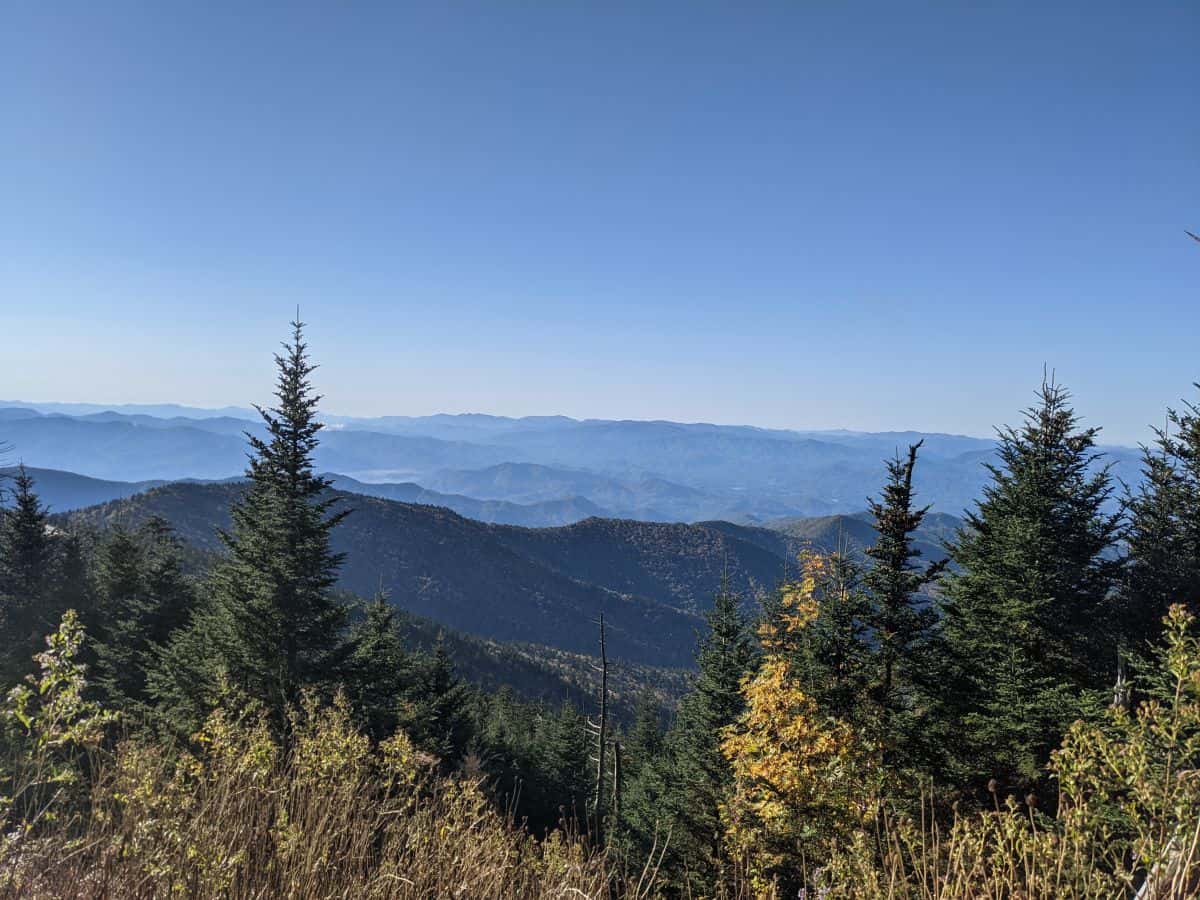
When visiting any national park, it’s important to be aware of the rules and regulations in place. Great Smoky Mountains National Park is no exception.
Some important things to keep in mind when visiting the Smokies:
1. Pets are prohibited on nearly all trails in the park.
2. Be sure to leave no trace. If there are no garbage cans around, pack out whatever you bring in with you.
4. Stay on the trails while hiking and don’t take any shortcuts. This helps protect the natural resources in the park and protects your safety.
5. Obey all speed limits and traffic laws while driving in the park. This helps keep everyone safe and ensures that visitors have a pleasant experience.
6. Come prepared for all types of weather, as conditions can change rapidly in the Smoky Mountains.
Final thoughts on your Smoky Mountains itinerary
If you’re looking for a great hiking destination with some beautiful scenery, Great Smoky Mountains National Park is definitely worth checking out.
With plenty of trails to choose from, there’s something for everyone – whether you’re a beginner or an experienced hiker.
And if you’re looking for some beautiful scenery, be sure to visit Cades Cove, Roaring Fork Motor Trail, Newfound Gap, and Clingmans Dome.
More articles about National Parks
- Inspiring books about U.S. National Parks
- The best National Parks in the Southern United States
- The top National Parks on the East Coast
- The best national parks gifts (for any budget)
- Hiking Congaree National Park
Pin this post!
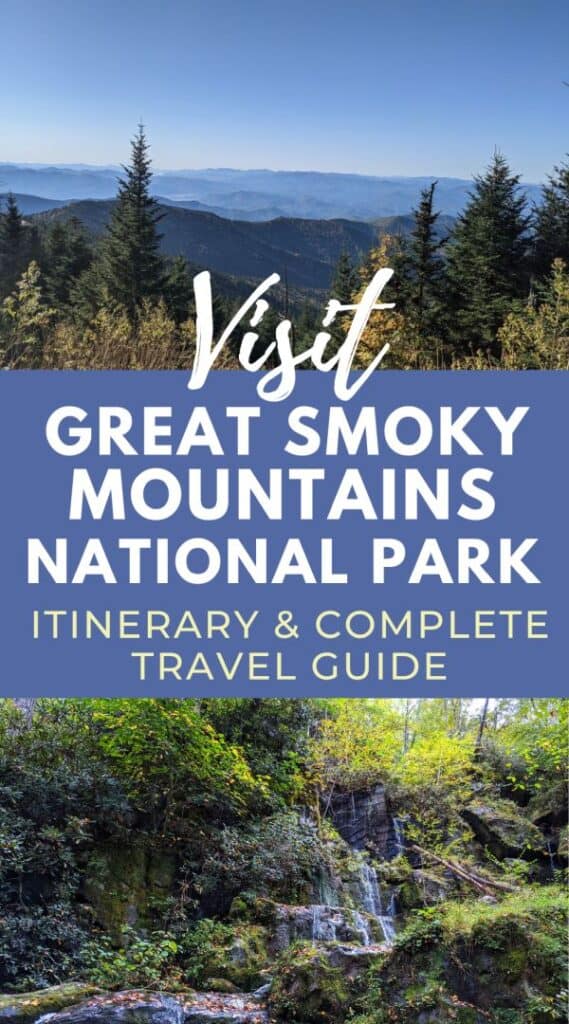
Darcy Vierow is a busy professional and travel planning expert with years of experience maximizing travel with limited time and on a less-than-average salary. Her tips have been published by Forbes, MSN.com, Yahoo! News, Yahoo! Finance, Aol, Newsbreak and GOBankingRates. Read more about Darcy Vierow .
Leave a Reply Cancel reply
Your email address will not be published. Required fields are marked *
By using this form you agree with the storage and handling of your data by this website. *
Privacy Overview
- Skip to global NPS navigation
- Skip to this park navigation
- Skip to the main content
- Skip to this park information section
- Skip to the footer section

Exiting nps.gov
Alerts in effect, plan your visit.
Last updated: August 11, 2022
Park footer
Contact info, mailing address:.
107 Park Headquarters Road Gatlinburg, TN 37738
(865)436-1200
Stay Connected
Join the Adventure: Start Your National Park Bucket List
National Park Bucket List
Best Great Smoky Mountains Itinerary for 4 Days in the National Park
Mountain peaks, gushing waterfalls, and historic coves are all a part of this Great Smoky Mountains itinerary in the popular national park on the North Carolina and Tennessee border.

With over 800 miles of trails, 2,000 miles of streams and waterways, dozens of waterfalls, and mountain peaks topping 6,000 feet, there’s a lot to take in at Great Smoky Mountains National Park. The most visited national park in the country straddles the border of Tennessee and North Carolina, covering over 500,000 acres.
Over 14 million vacationers flock here each year to drive scenic routes like Cades Cove, hike in the mountains, and chase waterfalls like Laurel Falls and Rainbow Falls. Whether you come for the family fun of Gatlinburg or to trek part of the Appalachian Trail (about 70 miles crosses through here), there’s a Great Smoky Mountains National Park itinerary to fit your travel style.
The 4-day Smoky Mountain itinerary below is perfect for first-timers, covering the most popular places to hike, drive, and sightsee. Adventurers will find ideas for some of the top hikes in the hills, including a summit or two. More low-key visitors can stick to the scenic routes, historic landmarks, and bucket-list waterfalls. There are enough options to pick from to easily fill 3 to 5 days or more in the park.
Keep reading for an action-packed Great Smoky Mountains itinerary and check out these other East Coast national parks for your bucket list.
Great Smoky Mountains National Park Map
This map has pins showing all of the locations in the Great Smoky Mountains National Park itinerary below. Click on the square in the top right corner to open a Google Map that you can save to your own account.
4-Day Great Smoky Mountains Itinerary
The 4-day Great Smoky Mountains National Park itinerary below has all of our favorite hikes, drives, historic sites, and more!

Day 1 — Little River Gorge Road and Cades Cove
Start your 4-day Smoky Mountain itinerary with a couple of classic drives through the park in the Cades Cove valley and along Little River Gorge Road. If you’re arriving from Knoxville or the west, you can start with Cades Cove before heading towards Gatlinburg on Little River Gorge Road. If you’re already in Gatlinburg, hike to Laurel Falls first before heading towards Cades Cove on Little River Gorge Road. You can either return on the same route or make a loop by driving through Townsend and Wears Valley.
The order of activities below assumes you’re staying in Gatlinburg. If you aren’t, check the map above for locations to craft a route that fits best.
Sugarlands Visitor Center
If you’re staying in Gatlinburg, pop by the Sugarlands Visitor Center before taking off for the day. It’s about 4 miles from the town and has a gift shop, natural history exhibits, park maps, trail information, and rangers on hand to answer questions.
Fighting Creek Nature Trail
Departing from the Sugarlands Visitor Center, the 1.4-mile Fighting Creek Nature Trail makes a loop through the woods and past a historic cabin. Anyone planning to hike to Laurel Falls or Abram Falls on this day should skip it to get an earlier start, but the nature trail is great for families with little kids or anyone who isn’t up for the more challenging paths.

Laurel Falls
Laurel Falls is one of the most popular destinations on a Great Smoky Mountains itinerary, with a paved trail to an 80-foot-tall waterfall. The moderately difficult path is 2.6-miles, roundtrip. The waterfall is extremely busy throughout the day, and parking is limited, so it’s best to go early in the morning or late in the afternoon.
Little River Gorge Road
As its name implies, Little River Gorge Road follows the bends of the Little River, spanning about 17 miles between the Sugarlands Visitor Center and Townsend, Tennessee. Driving the route without any traffic would take a little over 30 minutes, but you’ll want to make a few stops along the way.
The trailhead for Laurel Falls is near the start of the drive on the Sugarlands end, so after hiking here, continue west on the road. Several pullouts offer views of the Little River, but be sure to park at the Sinks for a gushing short waterfall under a bridge and Meigs Falls for a delicate cascade in the distance.
There are a few trailheads along this road as well, including the Metcalf Bottoms Trail , an easy, 1.5-mile roundtrip walk to an old schoolhouse, and the Meigs Creek Trail , a moderate, 6.5-mile roundtrip trek from the Sinks that follows a creek. If you’re squeezing Little River Gorge Road and Cades Cove into one day, I would advise skipping these hikes. On longer trips, you can stretch out the drive and try out some of these less-crowded trails.
The Metcalf Bottoms picnic area about midway along the road makes a great spot to stop along the river for lunch or a bathroom break. It has the only flush toilets and running water on this route past the visitor center.

Cades Cove Scenic Loop
One of the most-visited sections of the park, Cades Cove sits in a green valley at the foot of the mountains and holds the remains of settlements from the early to mid-1800s. A one-way, 11-mile loop road circles the area, with pull-offs for scenic views and historic sites. Plan to spend at least a couple of hours to half a day or more driving the loop, depending on stops, hiking plans, and traffic.
Be sure to download a map or grab one at the entrance before starting the driving tour, because you won’t be able to backtrack if you miss a stop. Along the way are three white clapboard churches with cemeteries, several log cabins, barns, a gristmill, and other structures. John Oliver Place, Cades Cove Primitive Baptist Church, Cades Cove Methodist Church, and Cades Cove Missionary Baptist Church are all on the first half of the drive. The second half has more homesteads like the Tipton Place and Dan Lawson Cabin.
The trailhead to Abram Falls (trail details in the next section) is about midway through the drive, before the Cades Cove Visitor Center , where you’ll find a restroom, information center, and a few more historic buildings.
In addition to the old-timey attractions, Cades Cove is a great place to look for wildlife. So much so that traffic often gets backed up when black bears are sighted. Park at spots like the Valley View for safe wildlife watching from your vehicle, and never approach, feed, or disturb any animals you see. Sunrise and sunset are the most active times, so plan your trip around then for the best chance to spot bears, white-tailed deer, wild turkeys, and more.
The Cades Cove Campground area at the start and end of the loop has a ranger station, a small store and deli (think ice cream, hot dogs, and nachos), and a bike rental shop. The loop road closes to vehicles on Wednesdays from May through September so that cyclists and pedestrians can sightsee.
Abram Falls
With a gushing drop 20 feet high and a picturesque pool at the base, Abram Falls is a favorite hiking destination in Cades Cove. The trailhead parking is about midway along the loop road, down a short, unpaved street.
The moderately-difficult hike is 5 miles round-trip, along a creek and through a pine and oak forest. This hike will add an extra 3 hours or so to your Cades Cove tour.

Day 2 — Newfound Gap Road
Every Great Smoky Mountains itinerary should include a scenic drive on Newfound Gap Road, which spans about 35 miles between Gatlinburg, Tennessee, and Cherokee, North Carolina, through the middle of the park. The highway climbs some 3,000 feet through forests of pine, oak and spruce. Along the way are lookouts with sweeping views of the mountains and trailheads for popular hikes like Alum Cave Bluffs and Chimney Tops.
Plan to pull over at the Chimney Tops Overlook, Ben Morton Overlook, and the Newfound Gap view on the state border where the Appalachian National Scenic Trail passes through. Continuing over to the North Carolina side, you’ll pass the road to Clingmans Dome before winding down to the verdant banks of the Oconaluftee River.
Just before Cherokee, look for the 1880s Mingus Mill , an operational grist mill, and the Mountain Farm Museum at the national park’s Oconaluftee Visitor Center. Keep reading for a few trail descriptions and notable stops on this route.

Chimney Tops Trail
While it’s only 3.5 miles roundtrip, the Chimney Tops Trail is considered strenuous for its 1,400-foot elevation gain in less than 2 miles. The payoff, though, is sweeping views of Mount Le Conte and the Chimney Tops pinnacles.
The trailhead is along Newfound Gap Road about 7 miles from the Sugarlands Visitor Center. Previously, hikers could follow a ridge to the top of the pinnacles, but wildfire damage has shut down access to the last quarter-mile climb. Now, the final destination is an observation deck below the summit.
Alum Cave Bluffs Trail
Mountain views, rock tunnels and steep cliffs are featured on the popular Alum Cave Bluffs Trail. Crossing log bridges and winding through old-growth woods, the strenuous trail climbs some 1,200 feet to the eponymous bluffs before continuing on to the summit of Mount Le Conte.
On the way, you’ll pass through a tunnel formed by Arch Rock and see valley views from Inspiration Point before standing beneath the shade of the massive bluffs. Turning around at the Alum Cave Bluffs makes for a 5-mile, round-trip hike while climbing the exposed cliffs to Mount Le Conte turns it into a 10-mile trek.
While there are a couple of large parking lots at the trailhead, they often overflow, with cars stretching down the sides of the highway on especially busy days. To avoid adding extra mileage walking to and from your vehicle, plan to start this hike early in the morning.

Appalachian Trail to Charlies Bunion
Just over 70 miles of the 2,190-mile-long Appalachian Trail pass through Great Smoky Mountains National Park. The highest peak on the trail is here as well — Clingmans Dome at 6,643 feet. Hikers who want a little taste of the bucket-list footpath can hop on at spots where it crosses through like Clingmans Dome or Newfound Gap.
One popular excursion on the trail from the park is the hike to Charlies Bunion, a rocky outcrop with views of peaks and valleys. Starting from the Newfound Gap parking lot, the round-trip hike is 8 miles and moderately difficult, with an elevation gain of 1,600 feet.
Andrews Bald Trail
The hike on the Forney Ridge Trail to Andrews Bald departs from the Clingmans Dome parking lot and leads through old-growth forests to an open field of grass and seasonal wildflowers on the bald. Round trip, it’s a moderate, 3.6-mile hike and a great option for visitors who are short on time but want to hike in the mountains.
Unlike the other paths on this list, this one starts with a 1,200-foot descent, with an uphill climb to return. The trail keeps going past Andrews Bald for another few miles.

Clingmans Dome
The tallest peak in the park and the whole state of Tennessee, Clingmans Dome is 6,643 feet high. An observation tower at the top with a rounded deck has panoramic views for over 100 miles on a clear day.
The 7-mile road to the peak branches off from Newfound Gap Road and closes seasonally due to weather conditions at the higher elevation. A very steep 0.5-mile paved trail leads to the tower from the parking area. There’s a small visitor center and store near the start of the walk.
Sunset and sunrise from the viewing deck at Clingmans Dome are simply spectacular, so plan your day to fit one in if you can. If you’re driving Newfound Gap Road round trip from Gatlinburg, you can skip Clingmans Dome on the way out to Cherokee and head up before sunset on the return trip.
Oconaluftee Visitor Center and Mountain Farm Museum
Just a couple of miles from Cherokee, North Carolina, the Oconaluftee Visitor Center marks the southern entrance to Great Smoky Mountains National Park. Here you’ll find a gift shop, restrooms, park maps and information, and water fill-ups.
Inside the center, exhibits tell the story of the Smokies, from native residents to the early settlers to the formation of the national park in the 1920s and 30s. Outside, the Mountain Farm Museum preserves a village of old log buildings, including a barn, farmhouse, corn crib, smokehouse, and more, with seasonal historic demonstrations.

Mingo Falls
Though it’s not within the national park bounds, Mingo Falls is absolutely worth a brief excursion while you’re on the North Carolina side of the Smokies. The cascade of 120 feet is one of the tallest waterfalls in the state, made more spectacular by how close you can get to the gushing drop.
The short and steep hike up steps and a rocky dirt path is only about a quarter mile each way and leads to a wooden bridge with a straight-on view of the waterfall. Located on Cherokee Nation land, the trailhead is just 6 miles from the Oconaluftee Visitor Center.
The town of Cherokee, North Carolina, is just a couple of miles from the southern entrance to Great Smoky Mountains National Park and from the southern entrance to the Blue Ridge Parkway. It’s also the closest gateway town to the national park on the North Carolina side for overnight guests and is generally a bit cheaper and less crowded than Gatlinburg in Tennessee.
If you have enough time, consider visiting one of the cultural attractions here. The Museum of the Cherokee Indian has art, culture and history exhibits and the Oconaluftee Indian Village is a replica 18th-century Cherokee community with craft demonstrations, living history reenactments, and special performances, including a seasonal evening play that tells the story of the Trail of Tears. Harrah’s Cherokee Casino Resort has restaurants, nightlife, events and a hoard of amenities.
For a short stop before heading back to Gatlinburg, you can browse the shops along Tsalagi Road or picnic in Oconaluftee Island Park on the river.

Day 3 — Roaring Fork Drive and Waterfalls
Day 3 of this Great Smoky Mountains National Park itinerary takes you to a couple of the most loved waterfalls in the park. Active travelers can hike to both on the same day on either two shorter individual trails of around 8 miles total or connect them on a longer route that goes up Mount Le Conte.
If you only have time for one hike, Grotto Falls is the easier of the pair, but still moderately challenging with some uphill walking.
Rainbow Falls
On bright afternoons, the sun hits the mist of Rainbow Falls, creating a hazy blur of colors off the 80-foot drop. With a trailhead less than 5 miles from Gatlinburg on the Tennessee side of Great Smoky Mountains National Park, the cascade is a popular hiking destination on a Great Smoky Mountains itinerary.
The 5.4-mile, round-trip trek follows Le Conte Creek, crossing water a few times on bridges and rocks. It’s considered a moderate to difficult hike, with about 1,700 feet of elevation change and takes a good three to five hours to complete. Adventurous travelers can stretch it out into a longer day hike by continuing on to the summit of Mount Le Conte, a 13.4-mile, round-trip journey.
Parking at the trailhead fills up fast, so plan to arrive early in the morning for this hike.

Grotto Falls
Just a couple of miles past the Rainbow Falls trailhead on the one-way Roaring Fork Road, the hike to Grotto Falls is 2.6 miles round trip. While the waterfall is only 25 feet high, the cave-like setting and the ability to walk behind the cascade make this a crowd-pleaser.
The trail is moderately difficult with less than 600 feet of elevation change and only takes a couple of hours, so you’ll see plenty of families along the way. For a more adventurous take, you can continue on the Trillium Gap Trail through hemlock forests to the peak of Mount Le Conte. Hiking a loop back down the Rainbow Falls Trail makes for about a 15-mile route.
There are only a few parking spots at this trailhead, and roadside shoulder space is sparse, so plan to either start very early in the morning or be prepared to add another mile or so onto the walk if you have to park further down the road. Roaring Fork Motor Nature Trail is a 5.5-mile one-way drive, so you’d have to loop all the way back around for another chance to park.
LeConte Lodge
Near the top of Mount Le Conte, the LeConte Lodge offers overnight accommodations in log cabins. You have to book months in advance to get a spot, but the sunrise views from 6,400 feet up are hard to beat. The only way to get there is hiking one of a handful of paths up the mountain, including the Trillium Gap Trail, Rainbow Falls Trail and Alum Cave Trail.

Roaring Fork Motor Nature Trail
Driving the Roaring Fork Motor Nature Trail is the perfect end to a day of waterfall hiking. A one-way road, the 5.5-mile route passes through verdant forests with rushing streams, log cabins and an old gristmill along the way.
Plan to pull over at a few historic buildings like the Noah Bud Ogle Cabin (just before Roaring Fork Road begins), Alex Cole Cabin, Ephraim Bales Cabin, and Alfred Regan House and Tub Mill. It’s the perfect little historic road trip and a more compact substitute for Caves Cove if you’re short on time.
Towards the end, look for a spot called the Place of a Thousand Drips to see a network of mini falls combining into a larger display. The 1920s Ely’s Mill at the end of the drive has a family-run crafts shop, cabin rentals and a wedding venue.

Day 4 — Foothills Parkway, Gatlinburg or Dollywood
On your final day in Great Smoky Mountains National Park, you can hike a trail you haven’t had time for yet from day 2 or 3, explore Gatlinburg attractions, or drive the Foothills Parkway for scenic views. The Dollywood theme park is also just 10 miles north of Gatlinburg in Pigeon Forge for a change of pace.
Foothills Parkway
The Foothills Parkway corridor traces the top of the national park a few miles north, with views of the Great Smoky Mountains from overlooks along the way. Commissioned in 1944 as a 72-mile route connecting Interstate 40 and U.S. Route 129, the roadway has less than 40 completed miles to date in a couple of different sections.
The longest part you can drive is the west end, between Wears Valley and Chilhowee Lake on the Little Tennessee River. A short section on the northeast side between Crosby and I-40 is only about 5 miles long.

While I recommend spending as much time as possible in the national park, Gatlinburg does have some fun activities for family vacations, as long as you don’t mind dealing with crowds for much of the year.
The downtown strip offers kitschy museums, arcades, souvenir shops and chain restaurants. Parking is tight but a trolley shuttles visitors from a park and ride lot at the welcome center. Some of the top things to do in Gatlinburg are the Space Needle , a 407-foot-high observation platform with 360-degree views, Gatlinburg Skylift Park , with a chairlift and 700-foot-long elevated pedestrian cable bridge, and Ober Gatlinburg , with an aerial tram to the top of Mount Harrison for an amusement park in summer and skiing and tubing in winter.
For a change of pace from all the outdoorsy activities in Great Smoky Mountains National Park, you can spend a day at Dollywood. Dolly Parton’s Appalachian-style theme park in Pigeon Forge has dozens of roller coasters and rides, toe-tapping shows, and tons of Southern food.
Dollywood is less than 15 miles from the northern end of the national park.
Great Smoky Mountains National Park Guide and Tips
Use these Great Smoky Mountains National Park tips to help plan your trip!

Where to stay near Great Smoky Mountains National Park?
On the Tennessee side of the park, Gatlinburg is the top place to stay, with an amenity-filled and touristy downtown district just outside the park. There are plenty of hotels and cabins to choose from here. About 10 miles north, Pigeon Forge has cheaper options when Gatlinburg fills up and is home to the Dollywood theme park. The communities of Wears Valley and Townsend to the west of Gatlinburg are much quieter with cabins and RV parks but fewer amenities. Townsend is convenient to the Cades Cove area, about 10 miles from the entrance.
On the North Carolina side of the park, Cherokee is less than 5 miles from the park entrance and has a large casino resort plus some cheaper hotels and campgrounds. Bryson City on the Tuckasegee River is 10 miles west of Cherokee and has a railroad with train rides through the park.
Airport Near Smoky Mountains National Park
The closest airport to Great Smoky Mountains National Park is McGhee Tyson Airport in Alcoa, Tennessee, near Knoxville. It’s about 25 miles from the Townsend entrance and 40 miles from Gatlinburg and the Sugarlands Visitor Center on the north end of the park. The last time I did this Great Smoky Mountains itinerary, I flew into Knoxville and drove through the park, to Asheville, and back.
On the North Carolina side, Asheville Regional Airport is about 60 miles from Cherokee, the Oconaluftee Visitor Center, and the southern entrance to the park.
Read Next: U.S. National Parks Bucket List by State
How many days do you need in the Smoky Mountains?
You could spend anywhere from a day in the Great Smoky Mountains National Park passing through on a road trip, to a week or more for a relaxed stay at a cabin or an extended hiking adventure.
I recommend a minimum of a 2-day itinerary in the Smoky Mountains to drive Newfound Gap Road through the park and visit Cades Cove. With 3 days in Great Smoky Mountains National Park, you should have time for a couple of hikes to spots like Grotto Falls, Rainbow Falls or Alum Cave Bluffs. With a 4 day Smoky Mountain itinerary , you can spend a full day on a longer hike or explore the attractions around Gatlinburg or Cherokee. A 5-day itinerary in Great Smoky Mountains should be enough time to hike all the trails on the list above or spend some time relaxing in a cabin outside the park.
What should you not miss in the Great Smoky Mountains?
There are so many things to do in the Great Smoky Mountains, with over 800 miles of trails in the national park and some 40 waterfalls you can see along the streams and rivers. On your first visit, you should not miss the Cades Cove scenic drive, a waterfall hike (Laurel Falls, Grotto Falls, Rainbow Falls and Abram Falls are the most popular), a drive along Newfound Gap Road to see the mountain lookouts, and a walk up to the Clingmans Dome observation tower. This Great Smoky Mountains itinerary includes the most popular things to do on your first trip.

What is the best month to visit the Smoky Mountains?
The best month to visit the Smoky Mountains will depend on your goals and activities for the trip. Do you want to visit in spring for the gushing waterfalls in Great Smoky Mountains National Park? Autumn for the colorful leaves? Summer for warm temps on mountain hikes?
If you’re looking to avoid the crowds, summer when schools are out and October for fall foliage tends to be the busiest times in the park, plus weekends and holidays throughout spring, summer and fall. Great Smoky Mountains National Park has over 14 million visitors per year, though, so it’s hard to completely avoid people unless you visit in a chilly month like January or February .
This Great Smoky Mountains itinerary is perfect for spring, summer and fall.
Spring in the Smoky Mountains
In spring, the weather changes from snowy and grey in March to daytime temps in the 70s and 80s later in the season. The trees are usually still bare throughout April, but the park won’t be as crowded yet if you avoid the weekend.
Summer in the Great Smoky Mountain
In summer, the lower elevations can hit the 90s and humidity is high, though up in the mountains, it’s much cooler. Mount Le Conte rarely reaches temperatures in the 80s. Rain and thunderstorms in the afternoon are also common is the summer, and visitation peaks from June through August.
Fall in the Smoky Mountains
Fall drops from average highs in the 80s at lower elevations in September to the 60s in November. The leaves can start changing at higher elevations in mid-September, but the lower spots don’t typically peak until sometime between mid-October and early November.
Winter in the Great Smoky Mountains
Winter conditions can vary from tepid in the Gatlinburg area to subzero and snowy in the mountains. The average highs in the lower elevations through winter are in the low 50s, with lows below freezing. In the high elevations, average highs are just above freezing and lows are around 20. January and February see an average monthly snowfall of around 20 inches. Icy conditions will cause some park amenities and roads to close, including the route up to Clingmans Dome, which typically closes for the season by late November. Nevertheless, winter can be a great time to visit to avoid crowds!
Tickets and Passes for Great Smoky Mountains National Park
Great Smoky Mountains is one of just a few national parks with no entrance fee. You do have to pay for things like camping reservations and backcountry permits, but there is no charge to enter the park. A proposed parking fee is being considered for 2023 and beyond.
Similar Posts

12 of the Best National Parks to Visit in February in the USA

10 of the Best National Parks to Visit in April in the USA

The Best Zion Bryce Grand Canyon Itinerary for 4 to 7 Days

11 Best East Coast National Parks You Need to Visit

The Best 2 Days in Zion National Park Itinerary for Your First Time

12 of the Best Things To Do in New River Gorge National Park
Leave a reply cancel reply.
Your email address will not be published. Required fields are marked *
Save my name, email, and website in this browser for the next time I comment.
- FREE NP ebook
- Hiking Basics
- Backpacking
- Gear Guides
- Gift Guides
- New Hampshire
- North Carolina
- West Virginia
- National Park Planning
- Bryce Canyon
- Cuyahoga Valley
- Death Valley
- Great Smoky Mountains
- Joshua Tree
- New River Gorge
- Shop Itinerary Guides & Digital Products
- Refund and Returns Policy
- Work With Me
- About Brooke In Boots
- Privacy Policy and Disclaimer
- Appalachian Trail Hikes
- FREE NP EBOOK
Ultimate 2 Day Itinerary Great Smoky Mountains
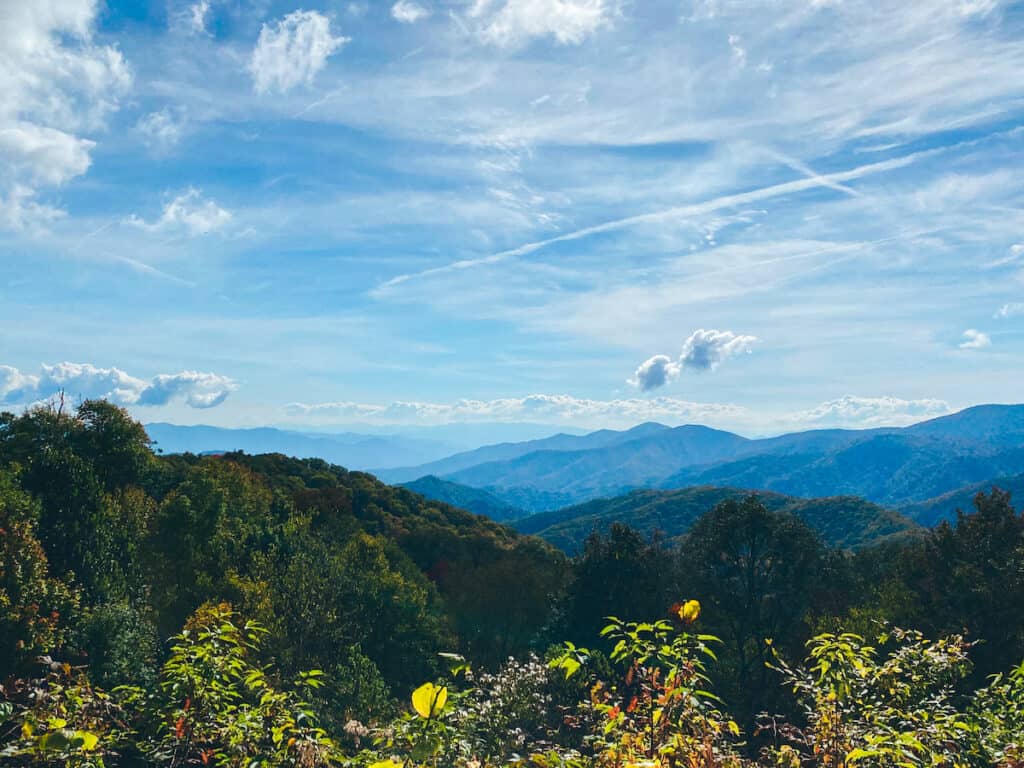
Great Smoky Mountains National Park is famous for its rolling mountains, lush waterfalls, and that classic “smoky” mountain haze. There are hundreds of miles of epic hiking trails, dozens of waterfalls, and miles of scenic drives. With so much to do, planning the perfect 2 days in the Smoky Mountains can feel pretty overwhelming!
While I usually prefer the dramatic western National Parks, after visiting the Smoky Mountains 3 times, I have to say the deep forests and endless rolling mountains of this park have definitely grown on me!
To help plan your ultimate trip, I put together this 2 day Great Smoky Mountains trip itinerary. This guide is perfect for first time visitors, and ensures that you don’t miss out on the highlights of the most visited National Park, even if you only have 1 weekend.
From the iconic views of Clingmans Dome , exploring the history of Cades Cove, to hiking iconic trails like Mount LeConte or Laurel Falls , your two days in the Great Smoky Mountains will be nothing short of epic.
Disclosure: This post contains some affiliate links, which means if you buy something, my blog will receive a small commission at no extra cost to you. I will never recommend products or links on this blog that I have not personally used or fully endorse.
Table of Contents
A Quick Look at Your 2 Day Great Smoky Mountains Itinerary
On Day 1 of your Great Smoky Mountains Itinerary, you’ll see:
- Alum Cave Trail
Drive Newfound Gap Road
- Oconaluftee Visitor’s Center and Mountain Farm Museum
- Optional: Andrews Bald
- Clingmans Dome
On Day 2 of your Great Smoky Mountains Itinerary, you’ll see:
- Cades Cove Loop Road
- Laurel Falls

Important Things to Know About Great Smoky Mountains National Park
Before planning your 2 day itinerary to the Smoky Mountains, there are a few important things you need to know.
Where is Great Smoky Mountains National Park?
Great Smoky Mountains National Park is located in both states of Tennessee and North Carolina, in the Southeastern area of the United States. The nearest towns to Great Smoky Mountains are Gatlinburg and Pigeon Forge, Tennessee and Cherokee, North Carolina.
The Great Smoky Mountains, or “the Smokies” are part of the Blue Ridge mountains, which is a subsection of the greater Appalachian Mountain chain. The Appalachians are thought to be one of the oldest mountain ranges in the world.
How to Get to Great Smoky Mountains National Park
There are no shuttles around Great Smoky Mountains, so you’ll want to fly into one of the closest airports to the Great Smoky Mountains , rent a car, and drive to the Park.
The nearest airport to Gatlinburg, Tennessee (Sugarlands Entrance) is Knoxville McGhee Tyson Airport. The nearest airport to Cherokee, North Carolina (Oconaluftee Entrance) is Asheville Regional Airport, in Asheville, North Carolina.
>> Click here to book your flight to Knoxville McGhee Tyson Airport
>> Click here to book your flight to Asheville Regional Airport
The nearest international airport to Great Smoky Mountains is Greenville-Spartanburg International Airport in Greenville, South Carolina.
>> Click here to book your flight to Greenville-Spartanburg International Airport
This map shows the major highways, towns, and interstates near Great Smoky Mountains.

Does Great Smoky Mountains charge an Entrance Fee?
There is no entrance fee to visit Great Smoky Mountains National Park.
The park was chartered in 1934 and dedicated by President Franklin Roosevelt in 1940. Before the Park’s creation, much of the Smokies was privately owned. When the states of Tennessee and North Carolina transferred the land to federal control, Tennessee mandated that the main roadway through the park, Newfound Gap Road (US 441), must stay toll-free. As a result, there is no charge to enter Great Smoky Mountains.
But, you DO have to pay for parking, starting in 2023. Beginning March 1, 2023 Great Smoky Mountains National Park will require all visitors to purchase and display a “Parking Tag” while parking inside the National Park.
All visitors who park for more than 15 minutes in Great Smoky Mountains, including at trailheads, scenic points, Visitor Centers, ect. must purchase and display a paid Parking Tag. One Parking Tag is required per vehicle.
Parking Tag fees are $5 per day, $15 per week, and $40 annually.
Parking Tag sales are not limited or capped, meaning you do not need advanced reservations to enter the Park. Parking tags do NOT guarantee a parking spot, so be sure to arrive early to trailheads and popular spots!
Learn more about the Great Smoky Mountains Parking Fee program, where to buy Paring Tags and Parking Tag exceptions here.
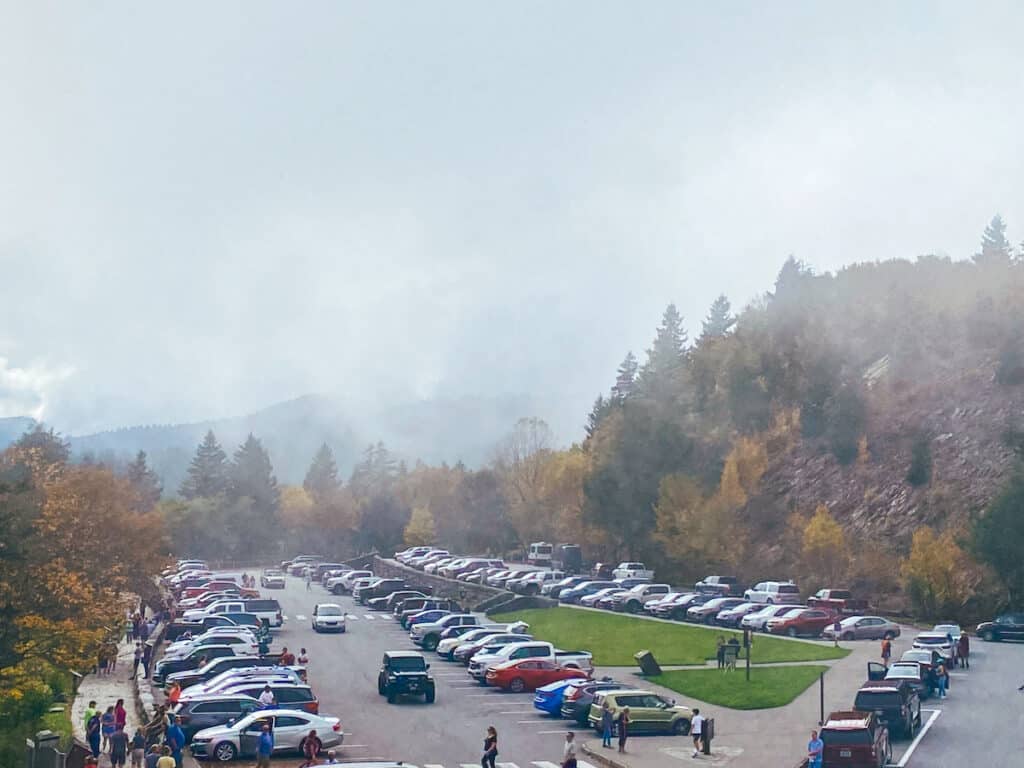
Is Great Smoky Mountains Dog Friendly?
Great Smoky Mountains is only semi pet friendly. Pets are allowed in campgrounds and picnic areas, and along 2 short walking paths – the Gatlinburg Trail and Oconaluftee River Trail. Pets are also allowed anywhere your vehicle can go, such as roadside pull-offs and sidewalks.
Pets are not allowed on other trails and must be leashed at all times.
How Many Days Should I Spend in Great Smoky Mountains?
Wondering how many days to spend on your Great Smoky Mountains itinerary?
If you are short on time, 2 to 3 days is enough to explore the highlights of Great Smoky Mountains National Park. However, if you have more time, there are virtually endless opportunities for hiking, wildlife viewing, and scenic drives in this beautiful park.
Thanks to its convenient location and tons of things to do, the Smokies are one of those Parks people return to again and again.
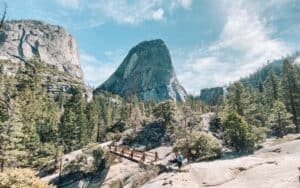
Want to learn more about planning an epic National Parks trip? Grab my free Ultimate National Parks Planning Guide , including 70+ pages of National Park packing checklists, planning tips, and everything you need to know to start planning a trip to all 63 National Parks!
What is the Best Times to Visit The Smokies?
The best time to visit Great Smoky Mountains is in the Spring or Fall , when there are fewer crowds than summer.
Summer in the Smokies brings heat, humidity, and lots of crowds. Trailhead parking lots and often fill by early morning, and scenic drives like Cades Cove can be bumper to bumper in the afternoon.
To avoid the worst of the crowds, avoid visiting during weekdays and holidays. For popular trails, like Clingmans Dome, Alum Cave, or Laurel Falls start hiking before 8AM (or earlier) or after 6PM, when most visitors have left the park.
In winter, most facilities in the park remain open year-round, except for some campgrounds and historic structures. The primary roads through the park – Newfound Gap Road, Cades Cove Loop, and Little River Road are open year-round. Clingman’s Dome Road and Roaring Fork Motor Nature Trail close in the winter. Check current conditions for park roads here .
Be sure to check park conditions before heading out in winter, and bring proper winter gear if you plan on hiking in snowy conditions.

The Great Smoky Mountains are Indigenous Land
The Smokies are ancestral lands of the Cherokee people, who called the place Shaconage or “place of blue smoke.” Most Cherokee Indians peoples were forcibly removed from the area in the 1800s during the march known as the “Trail of Tears.” Learn more about the Cherokee history in the Smokies here .
The Perfect Great Smoky Mountains 2 Day Itinerary
Are you ready to plan an unforgettable great smoky mountains weekend? Because of its easy accessibility, you’ll be surprised how much of this park you can see with 2 days in the Great Smoky Mountains.
This itinerary assumes you have 2 full days to spend inside the Park, and are staying on the Tennessee side.
Staying in North Carolina? If you are visiting from or staying in North Carolina, you will want to do the Day 1 itinerary in reverse, visiting the Oconaluftee Visitor’s Center first, before driving Newfound Gap Road west towards the Sugarlands Visitor’s Center.
2 Day Itinerary Great Smoky Mountains Map
This map shows all your stops on your 2 day Great Smoky Mountains itinerary.
How to Use This Map: Click the Icons on the map to see more information about each location. Click the star at the top of the map to add the map to your Google Maps account.
Want to take this itinerary to go? The 3 Day and 2 Day Great Smoky Mountains Itineraries include over 20 pages of daily itineraries, an in-depth Cades Cove guide, a detailed guide to the best hikes in Great Smoky Mountains, plus lodging and dining information, and tips for how to beat the crowds! Get your guide and learn more, here.

Great Smoky Mountains Itinerary Day 1
Your first day of your Great Smoky Mountains weekend is all about those iconic Smokies views. To maximize your time and avoid crowds, start as early as possible, ideally before 8am. Pack a lunch and enjoy a picnic on the go, or visit the many restaurants in Gatlinburg to relax before returning to the Park for must-see sunset.
If you only have one day in Great Smoky Mountains, this is also the perfect itinerary to visit the must-see areas of the park on limited time.

Hike Alum Cave Trail
5 miles round trip to Alum Cave Bluffs / Moderate / All Trails
10.9 miles round trip to Mt LeConte / Strenuous
Start your first day early in the Great Smoky Mountains with one of the most iconic hikes in the Park. The Alum Cave Trail ascends through forest and rocky cliffs to the summit of Mt LeConte.
The Trailhead is located on Newfound Gap Road, about 9 miles from the Sugarlands Visitor Center. Parking is really limited here and the spots fill up quickly, so try and get here as early as possible (before 8am).
The trail begins by following the Alum Cave creek through hardwood forest. Next, at 1.5 miles, hikers traverse through “Arch Rock” tunnel before ascending to Inspiration Point at 2 miles.
Most hikers turn around at Alum Cave Bluffs, about 2.3 miles from the trailhead.
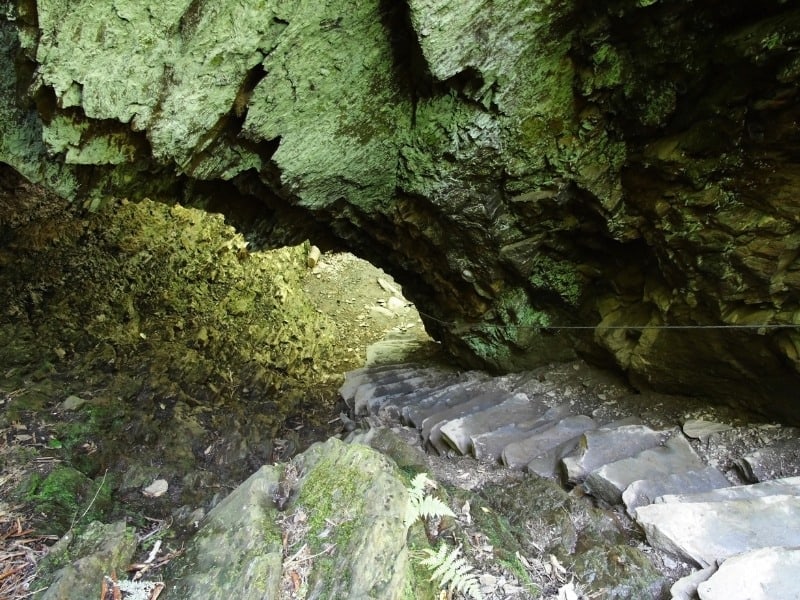
Looking for more of a challenge? Continue on Alum Cave Bluffs to ascend 6,575′ Mt LeConte. LeConte Lodge is located at the peak, the only hotel-style lodging located inside the Park. The Park uses llama trains to pack up supplies (and pack out trash) from the Lodge. If you’re lucky you might spot them on their weekly trek!
We weren’t lucky enough to see llamas on our trip, but fingers crossed we catch them next time!
Optional: Stop by the Sugarlands Visitor’s Center
After your hike, you can backtrack slightly to stop at the Sugarlands Visitor Center.
I’ll admit, this stop is never optional in my book, mostly because I’m a huge museum geek, and need to get my Passport stamp.
The Visitor Center is also an important stop to collect maps and ask advice from Park Rangers about trail conditions, parking availability, weather, and any other important information you’ll need before heading out.
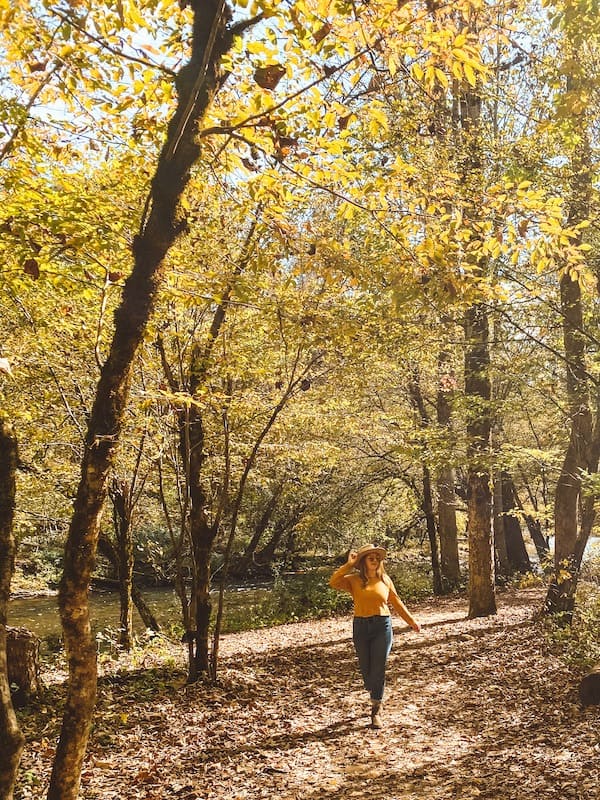
If you’re driving from the Tennessee towns of Gatlinburg or Pigeon Forge, your first stop is at the Sugarlands Visitor’s Center. If entering from Cherkoee, North Carolina, you will start at the Oconaluftee Visitor’s Center.
Both Visitor’s Centers have a small gift shop to stock up on your stickers, mugs, magnets and of course National Park Passport Stamps .
Stamps, stickers and journals are the perfect way to document your National Park Travels. I collect all my stamps and memories in my official Passport stamp collection book.

Once you have your maps, stickers, and stamps from the Visitor’s Center, return to US 441 South, known as Newfound Gap Road. This highway runs through the heart of Park from Tennessee to the town of Cherokee, North Carolina.
Take your time on this 33 mile scenic road, and savor those incredible views at every turn. The road ascends nearly 3,000 feet in elevation to Newfound Gap (5,046′), the lowest driveable pass through the Smoky Mountains. Don’t forget to bring a jacket! Temperatures are often 10 degrees cooler at the high elevation passes compared to nearby Gatlinburg.

Must See Stops on Newfound Gap Road
Campbell Overlook : Scenic vistas of the Smokies, approximately 2 miles south of the Sugarlands Visitor Center.
Chimneys Picnic Area : If you’re traveling around lunchtime, the Chimneys Picnic Area, about 5 miles south of Sugarlands is the perfect spot to relax and refuel.
Chimney Tops Overlook : Just past the Picnic Area, this turnoff has views of the iconic “Chimney Tops” formations soaring 2,000 feet overhead.
Morton Overlook : Beautiful at any time of day, Morton Overlook is a popular spot for sunset.
Newfound Gap : At 5,046 feet in elevation, Newfound Gap straddles the state line between Tennessee and North Carolina. The Appalachian Trail runs right through the overlook as hikers descend from Clingmans Dome.
Note the turnoff for Clingmans Dome Road here. You’ll be coming back this way for the hike to Andrews Bald and Clingmans Dome for sunset. If you don’t have time to drive all the way to Oconaluftee, Newfound Gap makes a good spot to turn around, or head straight for Clingmans Dome parking.
If you have time, continue south on Newfound Gap Road towards Mingus Mill and the Oconaluftee Visitor Center.
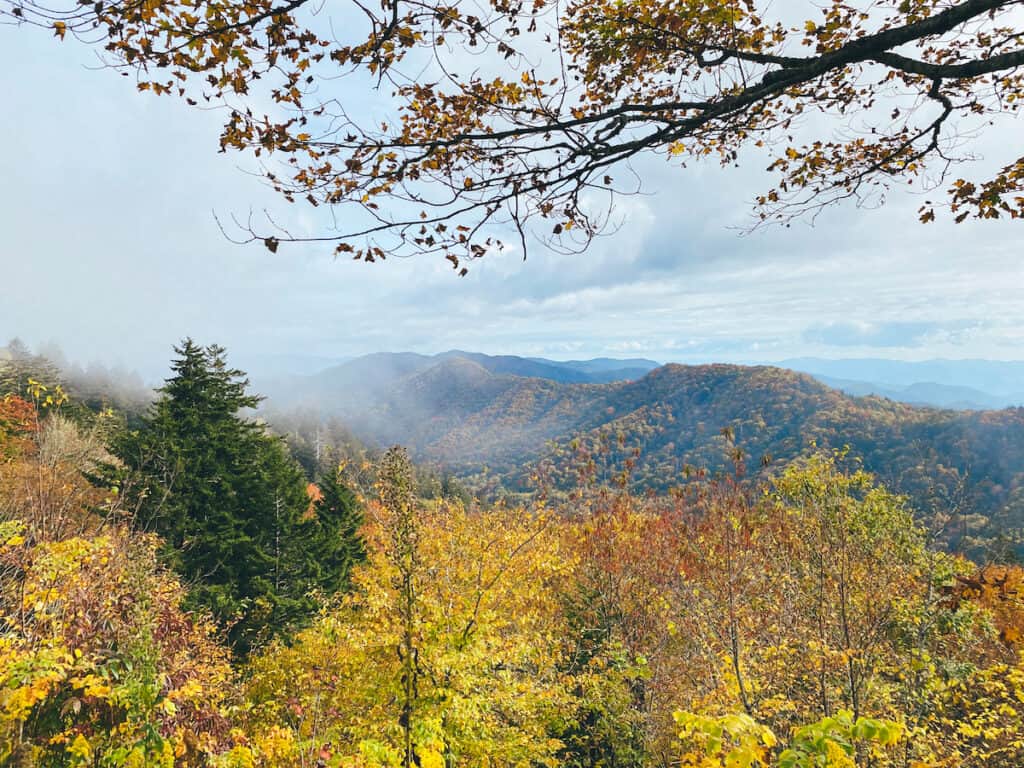
Mingus Mill : This historic grist mill, built in 1886, is located about 2 miles north of the Oconaluftee Visitor’s Center. Rangers operate the mill and give demonstrations to visitors March through November. If you plan on driving Cades Cove tomorrow, you can skip the Mill. Otherwise, the Mill is a great introduction to the historic buildings preserved throughout the Park.
Oconaluftee Visitor Center & Mountain Farm Museum
At the southern end of Newfound Gap Road lies the Oconaluftee Visitor’s Center and the town of Cherokee, North Carolina. The Oconaluftee Center includes exhibits about the Cherokee and later European settlers who have made the region home for hundreds of years.
The Mountain Farm Museum next to the visitor center is a huge interactive museum of preserved pioneer farm structures, including farmhouse, barn, and working blacksmith shop. Look closely and you can see the chickens that still call this farm home.
Keep your eye’s open for the herds of Elk that make this area home, especially in Fall.
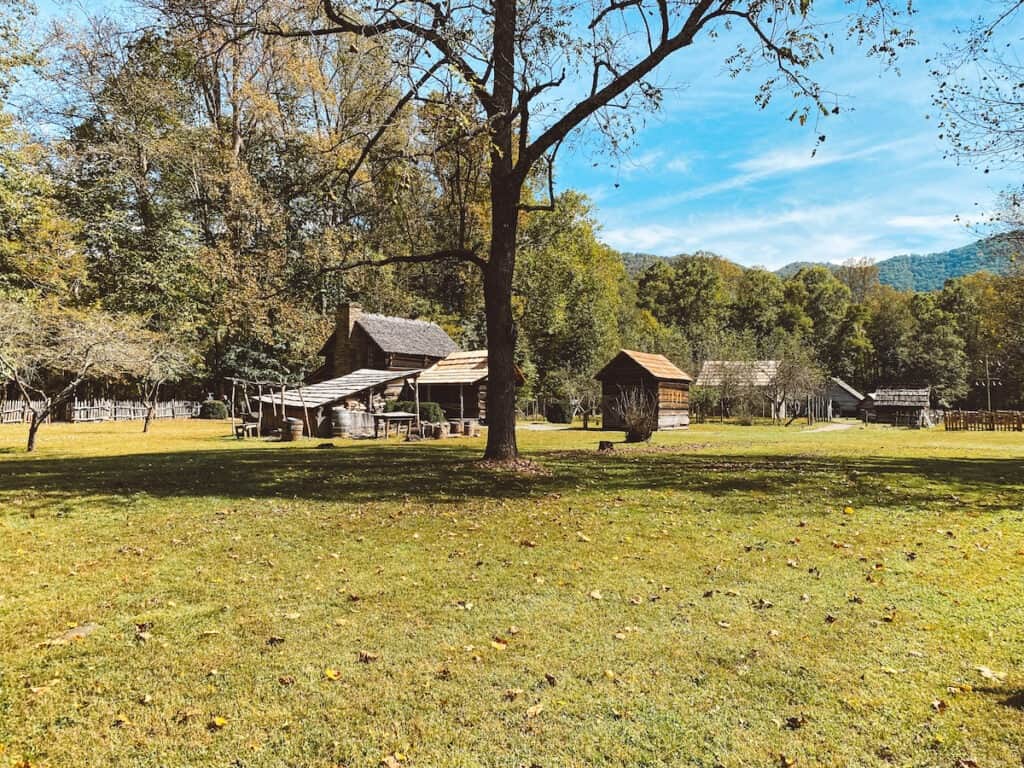
Optional: Hike to Andrew’s Bald
3.6 Miles / Moderate / 875 feet elevation gain / AllTrails
After stretching your legs inside the Center, return to your car and head north on Newfound Gap Road, retracing your route to Clingmans Dome Road, across the highway from the Newfound Gap Overlook you visited earlier.
The road climbs and ends at the Clingmans Dome parking lot. Warning, parking here can be a bit of nightmare during the summer. Be patient, and try and visit later in the afternoon, after 4pm, when many visitors start to leave the Park for the day.
If you have the time, Andrews Bald is the perfect companion to a sunset on Clingmans Dome. The 3.6 moderately difficult hike leads to one of the many “balds” in the Smokies, so called because these mountaintops are not covered by trees, but grass, rhododendron, and laurel.
From the Clingmans Dome parking lot, set out on the paved road towards Clingmans Dome. Shortly after the Park’s large interpretive signs, less than 0.1 miles from the parking lot, you will see a small trail and sign and on your left for “Forney Ridge Trail” to Andrews Bald.
Follow the Forney Ridge Trail as it descends for the first 1.1 miles through forest. Continue to follow signs for Andrews Bald at all trail junctions. The trail then heads uphill to Andrews Bald, with panoramic views of the surrounding mountains. The trail continues past the Bald, but turn around after you’ve soaked in the view and return the way you came, following signs for Clingmans Dome parking.
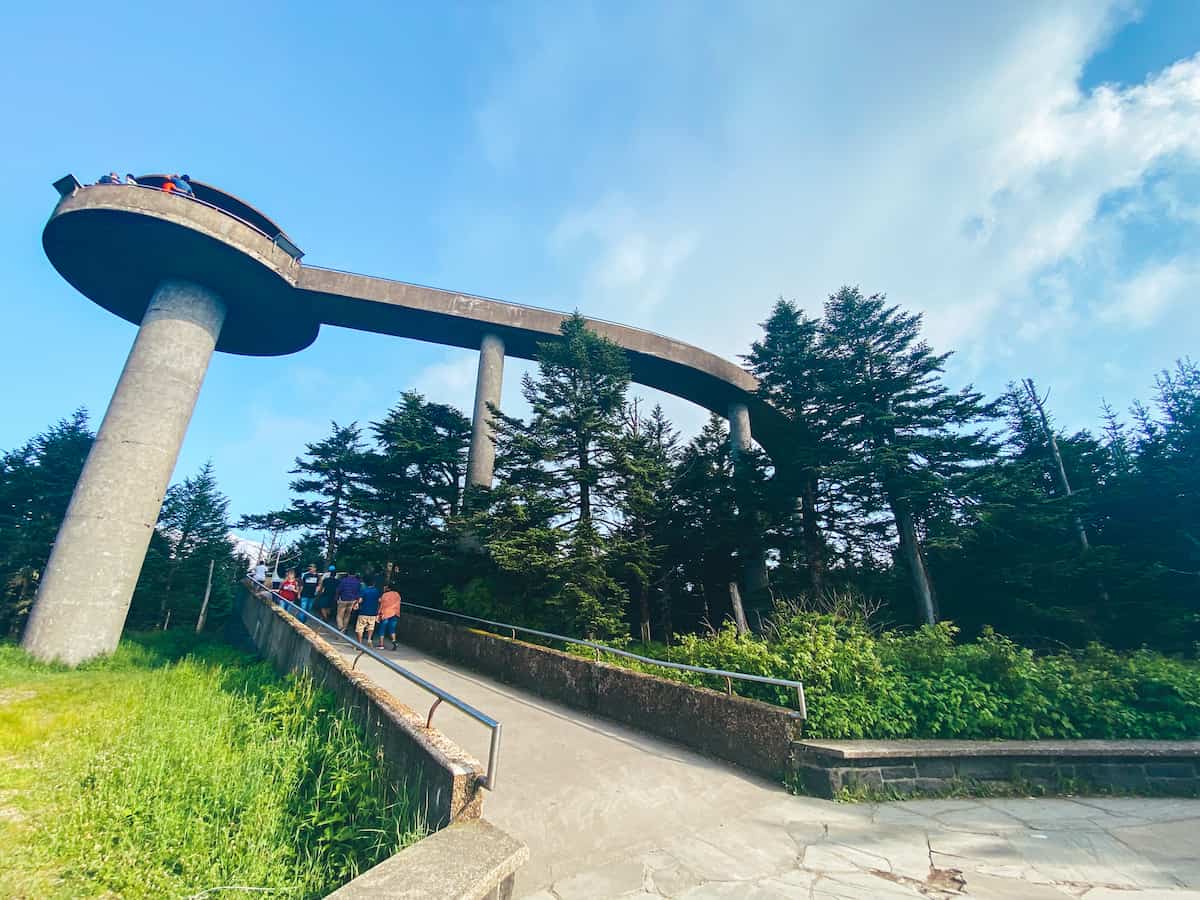
Sunset at Clingmans Dome
If you skipped hiking Andrew’s Bald, you’ll return to Newfound Gap Road and retrace your drive back towards Gatlinburg. At the crest of the highway, follow signs for Clingmans Dome Road. Clingmans Dome Road is across from the Newfound Gap Overlook you visited earlier.
The road climbs and ends at the Clingmans Dome parking lot. From here you can hike the steep 1 mile round-trip trail to the Observation Tower.
Observation Tower Trail
1 Mile / Easy / Not Wheelchair Accessible Due to Steep Grade / All Trails
At 6,643 feet, Clingmans Dome is the highest point in the Smoky Mountains. The Appalachian Trail crosses at the base of the observation tower, and is the highest point on the AT. At the summit of the Dome, the 45 foot high Clingman’s Dome Observation Tower provides 360 degree views of the surrounding mountains.
The area is subject to clouds and stormy conditions, even in the summer. Make sure to check weather conditions at the Dome before committing to your hike. Arrive early and expect big crowds at the Observation Tower.
From the Clingmans Dome parking lot, follow the paved trail to the Observation Tower. The trail is paved, steep, and usually crowded. If you aren’t used to hiking at higher elevations, take you time and rest on the many benches on the side of the trail.
At 0.5 miles, the path intersects with the Appalachian Trail before reaching the base of the Observation Tower. Use the 375 foot circular ramp to access the observation deck at the top of the Tower for 360 degree views of the Park.

Great Smoky Mountains Itinerary Day 2: Cades Cove & Laurel Falls
Day 2 of your 2 day itinerary in the Smoky Mountains is the perfect opportunity to explore more of the Park’s scenic drives and historic structures.
Cades Cove Loop Road Scenic Drive
Cades Cove is a broad valley surrounded by Smoky Mountains on all sides. The Cades Cove Loop Road is an 11 mile scenic tour of the many historic structures and sights of the Cove, and one of the most popular spots in Great Smoky Mountains Park.

Cades Cove Loop Road is vehicle free, every Wednesday, May 5 through September 1. During these times, the loop is only open to hikers and bicycles to enjoy.
The Cades Cove Loop road is an 11 mile scenic drive through the broad Cades Cove valley. The area was first settled by Europeans in the early 1800s, and many historic structures have been preserved here from this era.
While driving the Loop Road theoretically can take less than an hour, its really an all-day event. Plan to get out of your car and explore the historic buildings and enjoy a short hike or two.
Some of the must-see stops in Cades Cove are:
- John Oliver Cabin
- Primitive Baptist Church, Methodist Church, and Missionary Baptist Church
- Elijah Oliver Place
- Cades Cove Visitor Center and Historic Grist Mill
- Abrams Falls
- Whitehead Cabin
- Dan Lawson Place
- Tipton Oliver House
- Carter Shields Cabin
The Visitor Center, located about halfway around the loop is a good spot to stretch your legs and enjoy a picnic.
The Historic Grist Mill next door is a working water-powered mill that still operates to this day! You can learn all about farming history in this super remote valley, and take home a bag of mill-ground cornmeal from the giftshop!
There are plenty of homesteads and cabins around the loop, but our favorite was the Whitehead Cabin, located off the main road on Forge Creek Road, just past the visitor center. Since this spot isn’t on the main Cades Cove Loop road, its not as crowded and you might actually get a moment to yourself!

For a complete guide to visiting Cades Cove, including how to get there, what to see, and tips for beating the crowds, check out my new guide, 17 Best Things to Do in Cades Cove .
Hike to Laurel Falls
2.4 Miles / Easy / Not wheelchair or stroller accessible / AllTrails
Once you’ve had your fill of grist mills and historic log homes, exit Cades Cove via Laurel Creek Road and drive back towards the Sugarlands Visitor’s Center. Laurel Creek Road becomes Fighting Creek Gap Road at the intersection of Elkmont Road, about 40 minutes from Cades Cove.
Just past Elkmont Road, park at the designated parking lot for Laurel Falls. This is one of the most popular things to do in Great Smoky Mountains National Park. The parking lot is frequently full during summers and weekends. Overflow parking lots are located further down Fighting Creek road. Park and walk to the trailhead, following the signs.
The 80 foot high Laurel Falls are named for the mountain laurel that blooms here in Spring. The trail is well marked and mostly paved. However, strollers and wheelchairs are not recommended, as the old pavement is cracked and crumbling in many places.

From the Laurel Falls trailhead, the trail climbs gently through verdant forest. Keep your eyes open for black bears, especially early in the morning, as there have been sightings on the trail. The Falls are divided into an upper and lower section divided by a wooden bridge. Take care on slippery rocks and watch small children around steep drop offs.
Bring plenty of water, especially on humid summer days. This hike can be done with a sturdy pair of sneakers or hiking boots.
Return to your car and head back to your lodging.
Grab dinner in Gatlinburg after a busy 2 days in Great Smoky Mountains. Our favorite restaurant was The Park Grill in Gatlinburg . For a more upscale option, check out The Appalachian in nearby Sevierville. For pizza and brews, check out Gatlinburg Brewing Company.
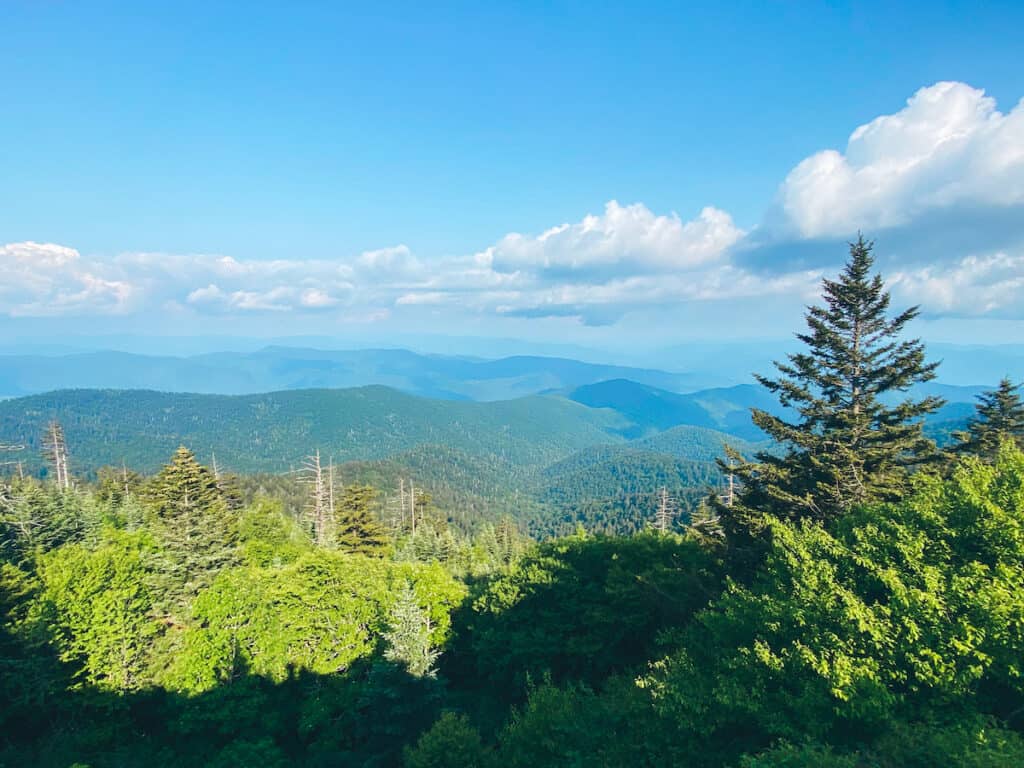
More Things to Do in Great Smoky Mountains National Park
Have more than 2 Days in the Park? Want to try something different? Check out these other things to do in Great Smoky Mountains National Park.
Roaring Fork Motor Nature Trail
Located a short distance from Gatlinburg, the Roaring Fork Motor Nature trail is a 5.5 winding, scenic drive through hardwood forests and historic cabins and grist mills.
The Motor Nature Trail is a great alternative if you don’t want to commit to the longer and more crowded Cades Cove Loop.
There are tons of great hikes that leave from the Roaring Fork Motor trail (or nearby) including Rainbow Falls (5 Miles / Moderate) and Grotto Falls via Trillium Gap Trail (2.6 Miles / Moderate).
Learn more about the Roaring Fork Motor Nature Trail here .
Hike Charlies Bunion via Appalachian Trail
8 Miles / Difficult / 1,600′ Gain / AllTrails
Take a day hike on the world-famous Appalachian Trail, which runs 2,190 milesand through the Smokies on its way from Georgia to Maine.
This moderate hike traverses multiple peaks on its way to Charlie’s Bunion, a large outcropping with classic smoky mountain views. The Trail leaves from Newfound Gap where the Appalachian Trail crosses with Newfound Gap Road.
This hike takes about 4 hours round trip. Make sure to bring plenty of water, snacks, and appropriate hiking gear.
Hike or Backpack Gregory Bald
11.6 Miles / Strenuous / 3,350′ Gain / AllTrails
A strenuous day hike that is also popular for backpacking. To get to this hike, you’ll need to drive on the unpaved Forge Creek Road (most passenger cars can make it, just drive carefully). Forge Creek road closes in winter, so plan to do this hike March – November.
After a steady climb for 5.5 miles, the summit has stunning views of the surrounding Smokies and Cades Cove.
Where to Stay Near Great Smoky Mountains National Park
Lodging inside great smoky mountains..
Lodging options inside Great Smoky Mountains are limited. There is only one hotel inside the park, Le Conte Lodge, which is accessible only by foot via a 5.5mile hike. Reservations for Le Conte fill many months in advance, but cancellations do occur if your plans are flexible.
There are 10 frontcountry campgrounds that are accessible by car inside the park. Campgrounds have cold running water and flush toilets, and campsites have fire rings and picnic tables.
Backcountry camping for backpackers and Appalachian Trail hikers is available at designated primitive campsites and shelters. All backcountry campers must have a permit before setting out. Backcountry permit information is available on the Park’s website .

Lodging Outside the Park
If you only have two days or less to visit Great Smoky Mountains, I recommend staying in the towns of Pigeon Forge or Gatlinburg on the Tennessee side of the Park. These towns are located just outside the Sugarlands entrance and Visitor Center, and most hotels are within 20 minutes of the park.
There are a variety of chain hotels like Fairfield Inn & Suites by Marriott and family-friendly mountain resorts like the Greystone Lodge on the River. Personally, we love to book a vacation home rental with a kitchen – and there are tons of cabins and mountain homes to book nearby.
>> Click here to book hotels in Gatlinburg, Tennessee
Between the neon lights, go-carts, and endless fast food options, Pigeon Forge and Gatlinburg can feel a lot like Las Vegas in the woods (or “Appalachian Disneyland” as my husband said). However, the direct access to the park, plenty of lodging and food options, and easy access to the highway make it the easy choice for a short visit.
What to Pack for Your 2 Days in Great Smoky Mountains
Don’t forget to grab your free National Parks packing list, inside my printable resources guide – here!
Hiking Backpack: Your backpack should be lightweight with enough support to carry a full day’s worth of supplies without hurting your back and shoulders.I use the Osprey Sirrus 24 daypack which has plenty of storage and space for a 2L hydration reservoir .
Rain Jacket : Rain is common in the Smokies in all seasons. The North Face Venture 2 jacket is waterproof, windproof, and packable.
Hiking Shoes and Socks: Most trails on this Great Smoky Mountains Itinerary can be done with a good pair of sneakers, but I always recommend using hiking boots or hiking shoes for the best comfort and safety. I swear by the Merrell Moab 2, available both as a hiking shoe and hiking boot . If you’re looking to upgrade to a more hardcore option, I love my Salomon X Ultra 3 Mid boot .
Remember, the best hiking shoes are only as good as the socks you wear. Darn Tough socks come in a variety of fun colors and have never let me down! Trust me, these bad boys are worth it to avoid blisters and comfortably break in any boot.
Bug spray: As someone who has some kind of invisible “All You Can Eat Buffet” sign above my head that only mosquitos can see, I use repellant sprays with DEET or Picaridin .Many other hikers prefer a DEET-free spray made with essential oils such as lemon and eucalyptus.
Hiking Tops: Look for tops that are moisture wicking and quick drying.Try the Patagonia Capilene Cool tanks and shirts , or check out more women’s performance tops on Backcountry.com .
Hiking Pants: For long pants, check out the Columbia Saturday Trail Pant . If you’re more a leggings gal, I wore my trusty Girlfriend Collective High-Rise Pocket Legging .
Water: Plan to bring 1/2 liter of water for every hour of hiking.
Explore More National Parks
Get the Ultimate National Parks Planning Guide (for free!) sent to your inbox, full of important planning information, printable packing lists, and the best things to do in all 63 National Parks.
Big Bend: Epic Big Bend Itinerary Guide
Bryce Canyon: One Epic Day in Bryce Canyon National Park
Cuyahoga Valley: 17 Best Things to Do in Cuyahoga Valley National Park
Great Smoky Mountains: The Ultimate Great Smoky Mountains Itinerary in 2 Days
Joshua Tree: The Perfect Day Trip to Joshua Tree National Park
New River Gorge: The Best Hikes in New River Gorge National Park
Yosemite: Epic Yosemite 2 Day Itinerary – How to Spend 2 Perfect Days in Yosemite
Zion: Ultimate 2 Days in Zion National Park Itinerary
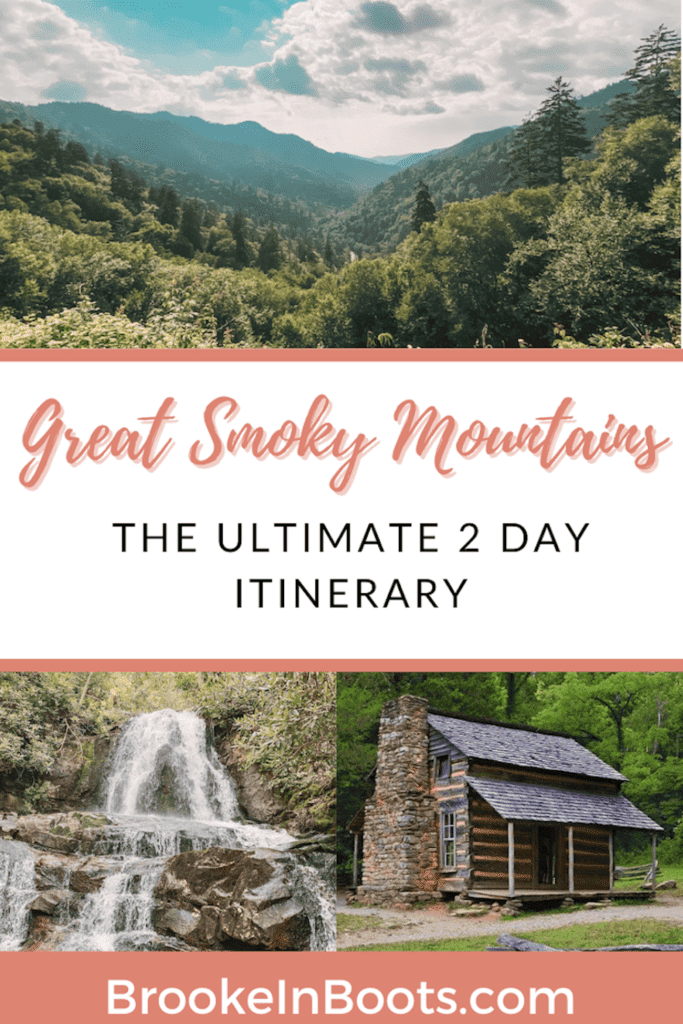
- These 14 National Parks Require Reservations in 2024
- The 7 Principles of Leave No Trace for Hikers
- Closest Airports to Big Bend National Park & How to Get There
- Closest Airports to Joshua Tree National Park & How to Get There
One Unforgettable Day in Death Valley...

Epic 3 Day Yosemite Itinerary: Ultima...
The top 6 road trips in Great Smoky Mountains National Park

Jan 27, 2023 • 6 min read
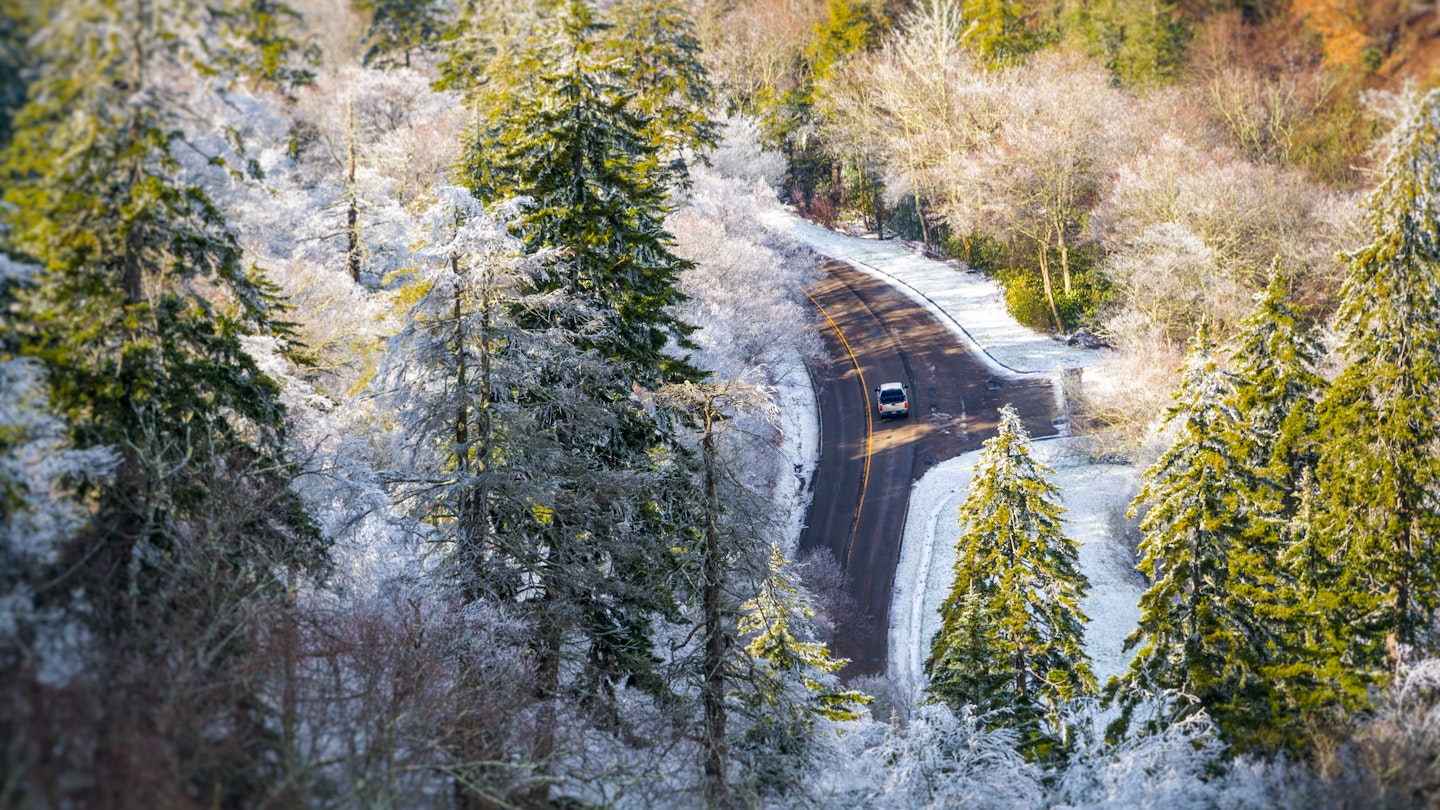
These are the best road trips to and around Great Smoky Mountains National Park © Daniel Korzeniewski / Shutterstock
A drive through and to Great Smoky Mountains National Park has many breathtaking advantages.
Whereas hiking gets you up close and personal with waterfalls, wildlife and often rock-draped hikes, a drive provides a fuller scope of this multi-faceted, 520,000-plus acre wonder. Plus – as you will see – there are plenty of labeled “Quiet Walks” to pit-stop at, should you need to stretch your legs in the wild itself.
Most routes in the park include swirling fog, rigid peaks and towering hardwoods. And, via one loop, there’s even a centuries-old European settlement to explore. Getting to the park can be half the fun, too, with diverse routes including small-town charm, sprawling destinations with family-friendly establishments and additional parks to hit.
When you pull out your map for your Great Smoky Mountains National Park visit, factor in these scenic road trips.
1. Cades Cove Loop
Best inner-park road trip loop Cades Cove–Cades Cove; 11 miles
Among the loops and build-your-own adventure possibilities within Great Smoky Mountains National Park, this oval route is perhaps the most popular. This is largely due to its wildlife, which includes white-tailed deer, the periodic turkeys and groundhogs and, yes, black bears. There are plenty of historic structures to gawk at within Cades Cove , too, including barns, churches and even a working gristmill dating back to the early 1800s that were all once part of a European-settled community.
If the traffic crawls too much for your liking or if you need a solid stretch, there is a visitor center mid-loop as well as several trails stemming from the loop, including the 5-mile Abrams Falls trek. For campers, Cades Cove Campground is open year-round and has nearly 160 sites.
Planning tip: Cades Cove Loop is open from 8am to sunset daily, with crowds typically steady post-10am.
2. Newfound Gap Road from Gatlinburg to Cherokee
Best road trip for first timers Sugarlands Visitor Center–Oconaluftee Visitor Center; 29 miles
Look at any map of Great Smoky Mountains National Park and there’s a north–south route that beautifully cuts right through the middle of the park – that would be the Newfound Gap Route . Considered the lowest-elevation pass through the park, this is where the hardwoods and spruce firs particularly tower over the oft-foggy landscape.
There is so much beauty to take in and fortunately, there are plenty of viewpoints to do so, notably the Carlos C. Campbell Overlook . At approximately mile 15 of the drive at the Tennessee – North Carolina state line, note the Rockefeller Memorial – this is where the park was officially dedicated by President Franklin Roosevelt in 1940.

3. The Foothills Parkway
Best road trip for fall foliage Wears Valley–Route 129; 32 miles
It’s an impossible task to pinpoint the absolute best spot for fall foliage in Great Smoky Mountains National Park. However, the western portion of The Foothills Parkway is tough to beat with winding tree-clad vistas and plenty of viewpoints for stopping and taking it all in. There are 19 scenic overlooks in total. Prioritize Overlook #8 in Emerine Gap, where you can take in prime park and city views – with the quaint town of Maryville and towering Smokys visible.
There is an eastern portion of The Foothills Parkway , too, which runs between Interstate 40 and the town of Cosby. This stretch runs less than 6 miles and includes four overlooks, with vistas of Inadu Knob and Mt Cammerer .
Planning tip: The Eastern and Western portions of The Foothills Parkway do not connect. Should you want to experience both stretches, Route 321 is currently the best straight shot between the two.
4. Knoxville to Gatlinburg via Sevierville and Pigeon Forge
Best kid-friendly road trip Downtown Knoxville–Sugarlands Visitor Center; 45 miles
For folks flying in to experience the Smoky Mountains, many journeys begin at Knoxville ’s McGhee Tyson Airport. After snagging a rental car, head north and make a pitstop in Knoxville for some barbecue at Sweet P’s BBQ and Soul House and then Cruze Farm for some fresh-churned ice cream. From there, take Interstate 40 to Tennessee Road 66, where you’ll eventually run through the tourist- and kid-friendly towns of Sevierville , Pigeon Forge and eventually Gatlinburg .
Stop in Sevierville to experience its revitalized downtown with a statue of local icon Dolly Parton in front of the town’s courthouse. In Pigeon Forge, in addition to Dollywood , pop by The Historic Old Mill to see grits and grains ground before your eyes. The Island area of Pigeon Forge is loaded with attractions like a 200ft-tall Ferris wheel . In Gatlinburg, before reaching the park’s entrance, there are numerous mini-golf courses, waterparks and ziplining opportunities. The Gatlinburg Space Needle is a nice spot for vistas, towering 400ft above the town.

5. Asheville to Gatlinburg via Cherokee
Best road trip to visit breweries Downtown Asheville–Sugarlands Visitor Center; 86 miles
If you’re not flying into Knoxville, odds are you’re landing on the North Carolina side, perhaps in Asheville . “The Land of the Sky” has deservingly earned its reputation as a craft beer hot spot. So, if you’re the lucky one who isn’t driving, prioritize some sips at the likes of Hillman Beer and heavyweights such as Sierra Nevada and New Belgium .
After you’ve stocked up on some beverages in Asheville, cruise through Maggie Valley , which is home to the double cascading Soco Falls. Cherokee is the last town before entering the park, where you can keep the party going at Harrah’s Cherokee Casino Resort . For history lovers, the Museum of the Cherokee Indian is open year-round and sheds light on the tribe’s 11,000-year history.
Detour: The entrance to Pisgah National Forest is 30 minutes north of Downtown Asheville, home to Mt Mitchell, the highest peak east of the Mississippi River.
6. Atlanta to Cherokee via Blue Ridge, Georgia
Best road trip for a multi-day adventure Downtown Atlanta–Oconaluftee Visitor Center; 178 miles
Hartsfield-Jackson Atlanta International Airport is the busiest airport in the US. Odds are if you want a nice deal in flying into the Southeast USA , you may find it flying into Atlanta . From Georgia’s capital city, the Oconaluftee Visitor Center on the North Carolina side of Smoky Mountains National Park is within a four-hour drive.
Don’t take the quicker Interstate 85 to Route 23 journey. Instead opt for the Interstate 75 to US Route 74 option that takes you through the charming southern towns of Canton and Blue Ridge, Georgia as well as the Nantahala National Forest . In the national forest there are more than 600 miles of trails for biking, hiking and horseback riding. So, plan a night or two to camp in the forest for sure, with the Jackrabbit Mountain grounds having 100-plus sites.
Explore related stories

Sustainable Travel
Apr 29, 2024 • 11 min read
Step away from the gas pump and strap on your seat belt: these are the best US road trips for electric vehicles.

Apr 14, 2024 • 8 min read

Jan 5, 2024 • 6 min read
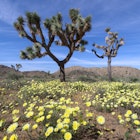
Jan 5, 2024 • 7 min read
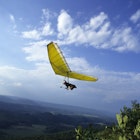
Apr 17, 2023 • 8 min read
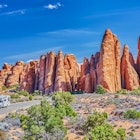
Mar 24, 2023 • 6 min read
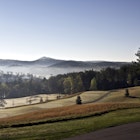
Aug 31, 2022 • 5 min read

Aug 19, 2022 • 6 min read

Jul 10, 2022 • 5 min read
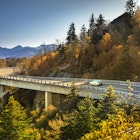
Apr 12, 2022 • 5 min read
- New Zealand

A Gorgeous 3-Day Great Smoky Mountains Itinerary
Due to the global pandemic, travel looks different right now depending on where you're going from/to. Please check for travel restrictions and adhere to all local guidelines before planning a trip to any destination you may read about on this site. Please note: this post may contain affiliate links. If you purchase something by clicking the links, I will get a small compensation, at no extra cost to you.
Sharing is caring!
Welcome to the number one most visited national park in America, the Great Smoky Mountains! And for good reason too. This national park is one of the best parks on the East Coast and is home to incredible waterfalls, scenic mountain views, diverse wildlife, stellar hiking trails, and Native American and pioneer history.
With this Great Smoky Mountains itinerary, you’ll not only hit the highlights, but also visit some hidden gems. Plus, I’ll be covering where to stay, how long you need to visit, and tips to make your Smoky Mountain trip the best!
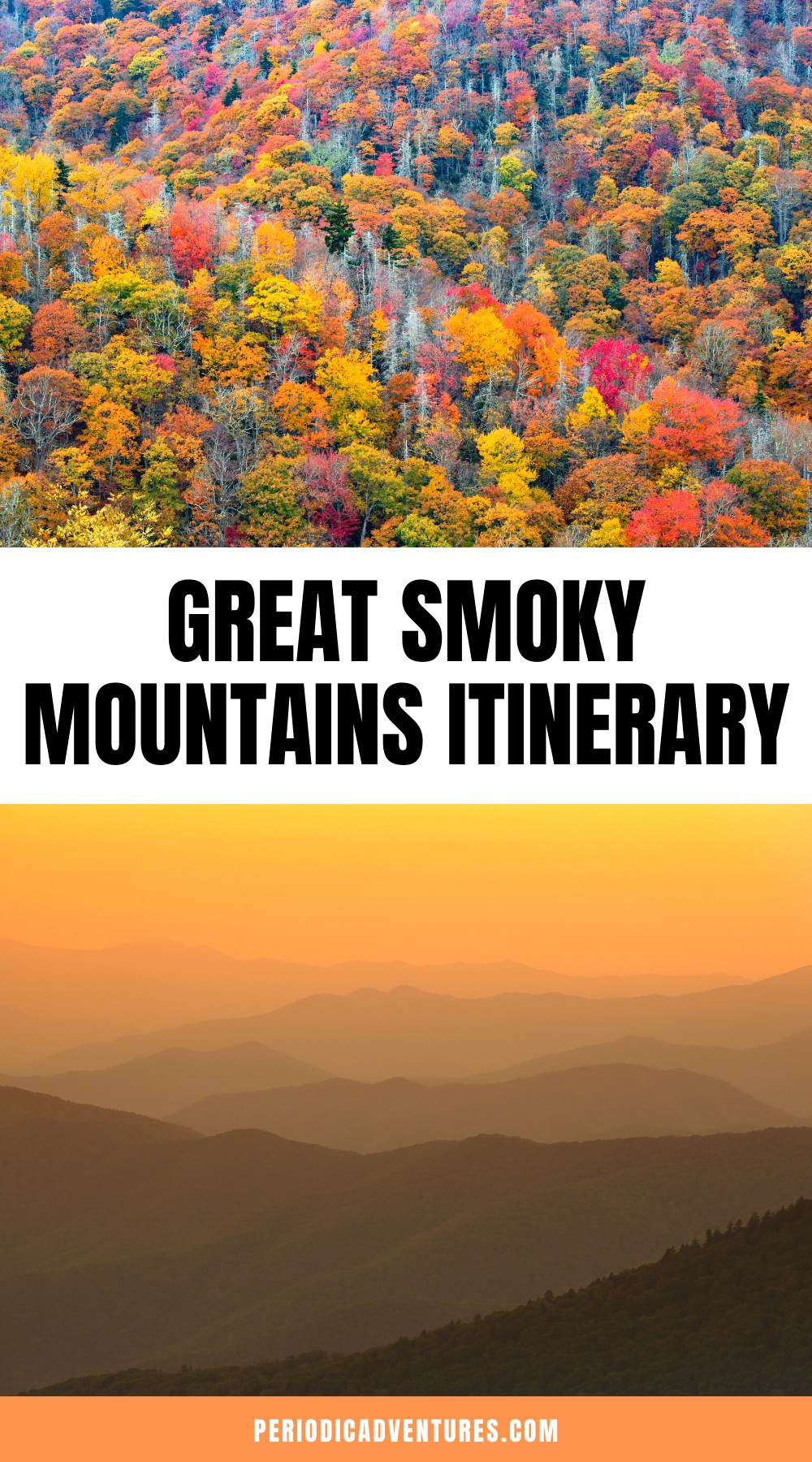
Great Smokies Overview
🛎️ Accommodation:
- Knoxville — The Graduate ($150+ per night)
- Pigeon Forge — Music Road Resort ($115+ per night)
- Gatlinburg — Howard Johnson ($45+ per night)
🥾 Must do hike: Clingman’s Dome for 360-degree views
🐻 Don’t forget to pack: Bear Spray (only if driving)
The Best Time to Visit the Smokies
Fall is hands down the best time to visit the Smoky Mountains for the most scenic views. The leaves change colors spectacularly and the temperatures are nice and cool for optimal hiking conditions. It’s truly one of the best places to visit in fall in the US !
However, autumn brings the most crowds and naturally, accommodation is more expensive and can book up quickly.
That said, if you’d rather opt for a less crowded time, spring is lovely . Plus, flowers start to bloom creating a beautiful scene.
Summer can get crowded as well, since kids are off school. Winter can be an adventurous time to visit, especially if the mountains get fresh snow. But, check for road closures, as some areas are not accessible in the winter.
Overall, fall is best for views, spring is best for fewer crowds.
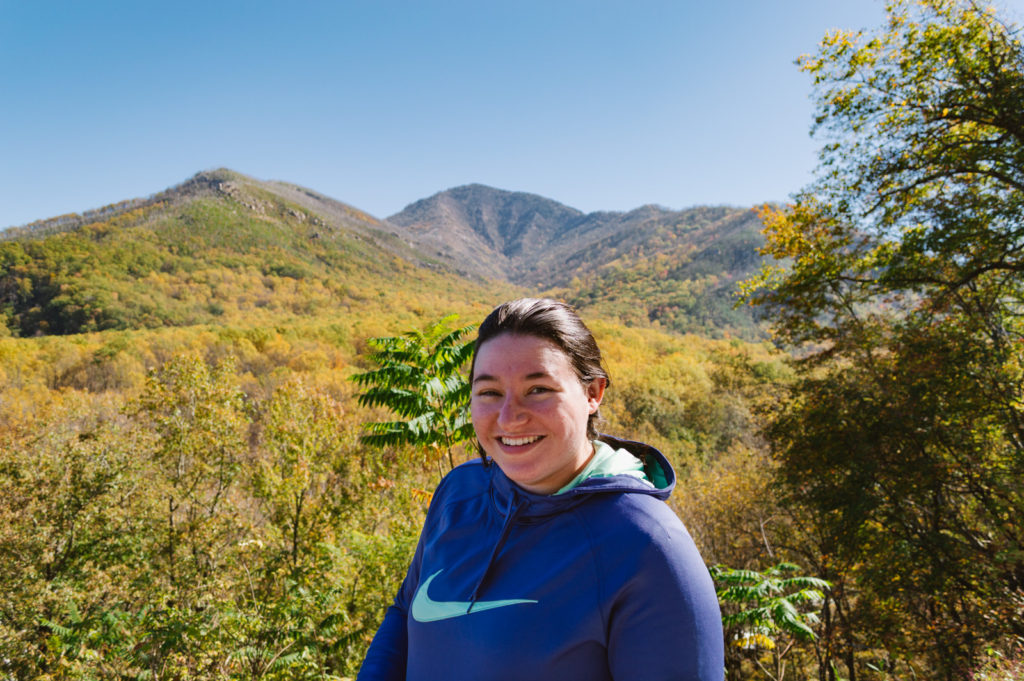

How long do you need to visit the Smoky Mountains?
You’ll want 3 days in the Smoky Mountains to see the most. I recommend maximizing your PTO to extend a weekend by one day or visiting on a holiday weekend if you don’t mind battling the crowds.
You can still do a lot in just 2 days, especially for my non-hikers ( hi, it’s me…I’m the problem it’s me ).
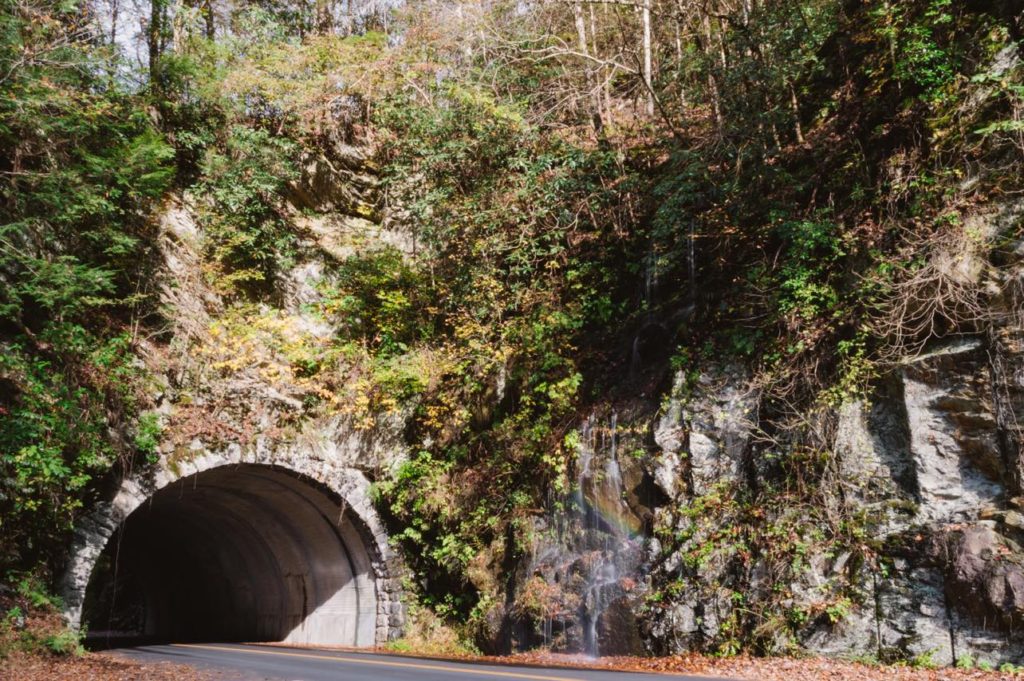
Where should you stay when visiting the Great Smoky Mountains?
The closest big city is Knoxville, Tennessee . If you’re flying, you’ll likely fly into Knoxville into McGhee Tyson Airport (TYS).
The city is about an hour and a half from Great Smoky Mountain National Park, but accommodation may be cheaper there because it’s farther out. We’ve enjoyed the Graduate in Knoxville with a small town, college vibe with adorable rooms!
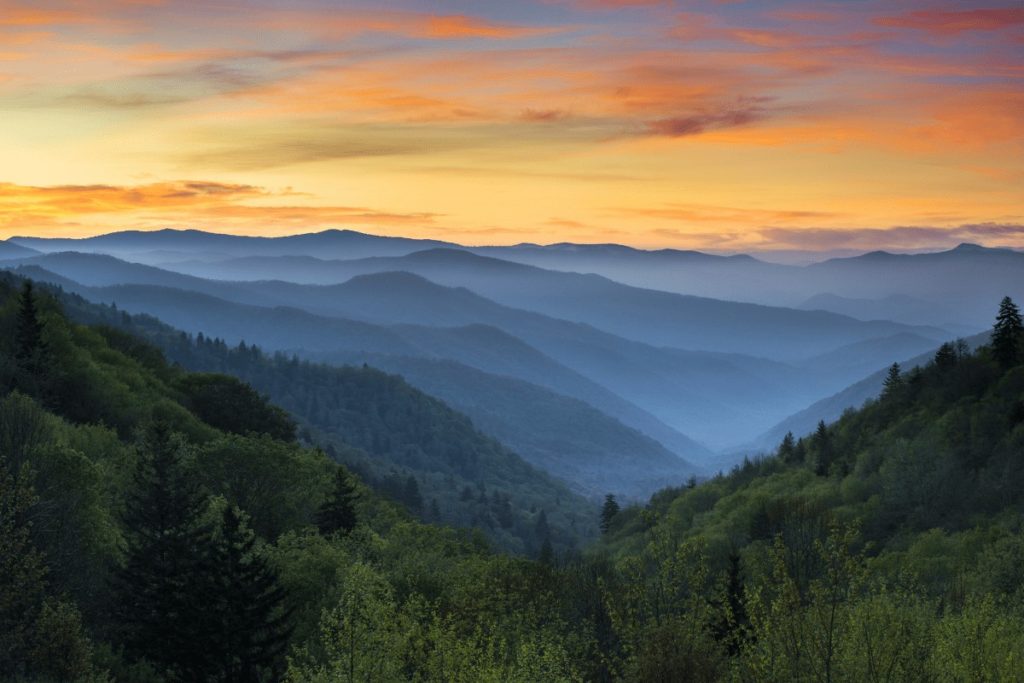
On that same note, Pigeon Forge is another bigger city (although smaller than Knoxville) just 25 minutes from the park so check for accommodation there as well. We’ve loved The Wayback Hotel in Pigeon Forge , a retro themed hotel best for adults. For families, Music Road Resort is in a great location to attractions nearby and has great reviews for only $115 a night.
To be closest to the park, check out Gatlinburg . This is a tourist mountain town with whacky attractions, shops, and plenty to do for adults (not just families) that will keep you entertained anytime you’re not in the park. However, it can get crowded since it is closest to the Smokies.
Depending on the season, you’ll find hotels like the Howard Johnson for only $45 a night.
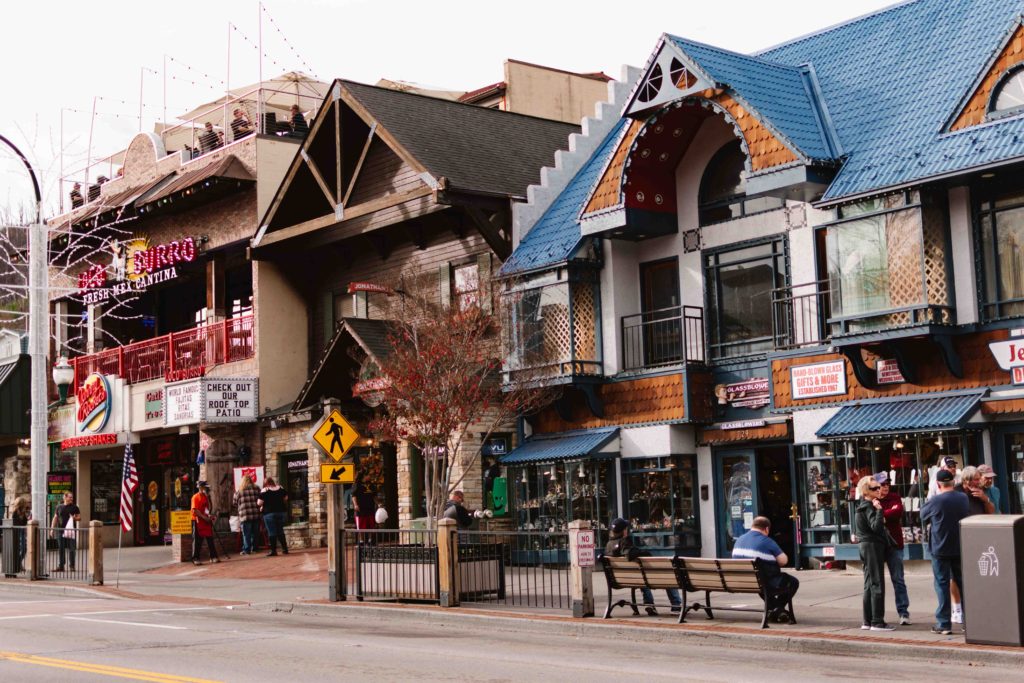
I also highly recommend camping in Great Smoky Mountains National Park. There are several campgrounds that you can reserve up to 6 months in advance. Note that they are not all open year round because of winter closures, so check Recreation.gov for the most up-to-date calendars.
We absolutely loved the Elkmont Campground because of it’s proximity to a river (who doesn’t love the sound of water?).
Note that there are very specific rules regarding firewood and you’ll likely need to bring cash to purchase their pre-treated wood.
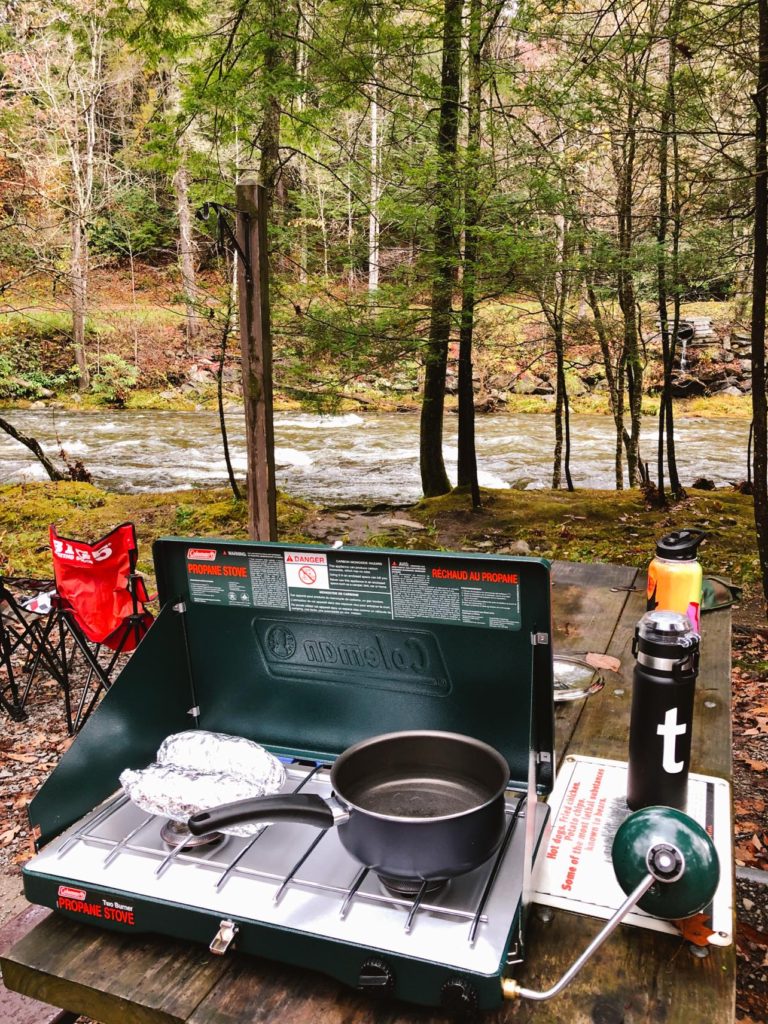
Related read → Camping tips for beginners
New in 2023: Parking Tags
One of the reasons Great Smoky Mountains National Park is the most visited national park is because it has no entrance fee. Yepp, the $30 national park entrance fee is not in effect here. Huzzah!
However, new in 2023, you now need a parking tag for your car if parking longer than 15 minutes.
For all vehicle types and sizes, the available parking permits are as follows:
- $5 – daily tag
- $15 – weekly tag
- $40 – annual tag
You can purchase your tag at any Welcome Center or Visitor Center, plus there are a couple automated machines found in the park. Given those can be trickier to find, I’d definitely stop by the first Visitor/Welcome Center you see. On this itinerary it will be the Sugarlands Visitor Center, or if you’re traveling from South to North, the Oconaluftee Visitor Center.
One final note, the parking tags are license plate specific so have yours handy when you go to pay. If you have a rental car, I like to take a quick picture on my phone of the license plate so I have it whenever I need it.

Map of this Great Smoky Mountains Itinerary
To start your itinerary, today you’ll be enjoying the northwest end of the park.
Sugarlands Visitor Center
Visit Sugarlands Visitor Center to pick up a free park map. Cell service is dodgy in the park, so a map is very helpful!
They’re printed on the back of seasonal newspapers so if you can’t find them, just look for stacks of newspapers. If you still can’t spot them, just ask them at the counter.
You’ll also see some specialized maps for specific things to see in the park like waterfalls, hikes, birdwatching, or historic structures. For a dollar or two, you can purchase one. These are helpful if you want to focus on one aspect in particular, but they’re not necessary.
Inside the visitor center, learn about local plant and wildlife with their indoor exhibits. Be sure to stop by the restrooms before you go farther on this itinerary.
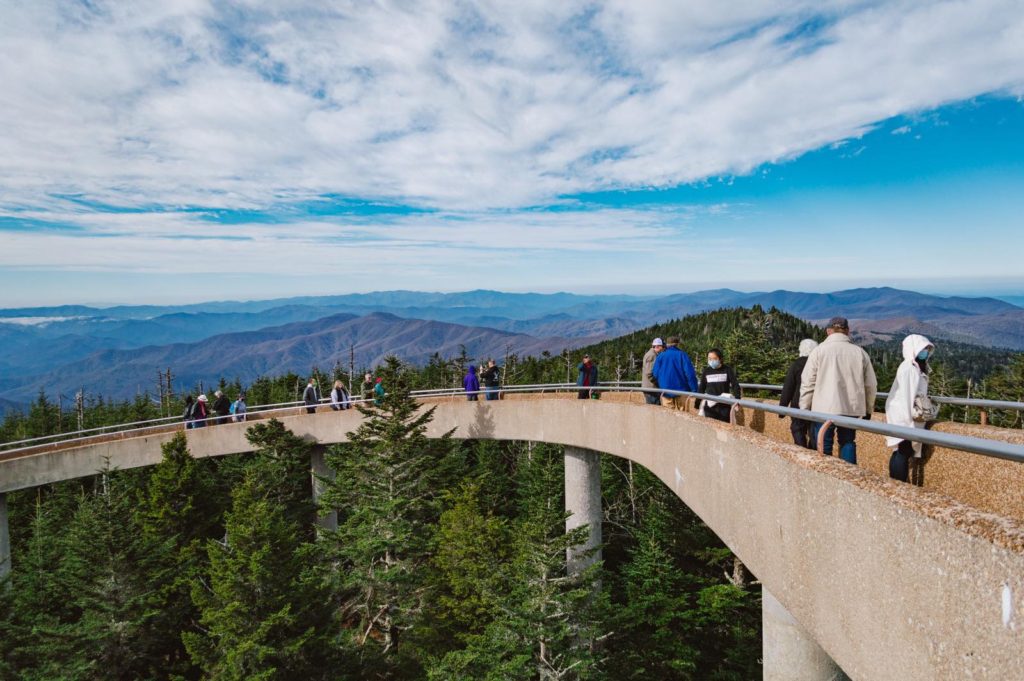
Laurel Falls
To start exploring the park, I recommend visiting Laurel Falls first thing in the morning after you grab a map and make a bathroom stop. Laurel Falls is located west of the Sugarlands Visitor Center.
Parking is limited and since it can get quite crowded as the day goes on, it’s best to hit this spot first.
The trail itself is paved and is a 2.5-mile out-and-back trail with a 400-ft elevation gain. It’s an easy enough trail ( if this girl with asthma can do it, I promise it’s okay ). It takes about an hour and 15 minutes to complete.
The waterfall itself is gorgeous and multi-tiered. There is a bridge so you can walk over it and stairs to descend closer to its base. Be careful if climbing the rocks off the path as they can be slippery and muddy.
You’ll also be able to see the surrounding mountains from the trail once you get a bit higher, out of the forest area.
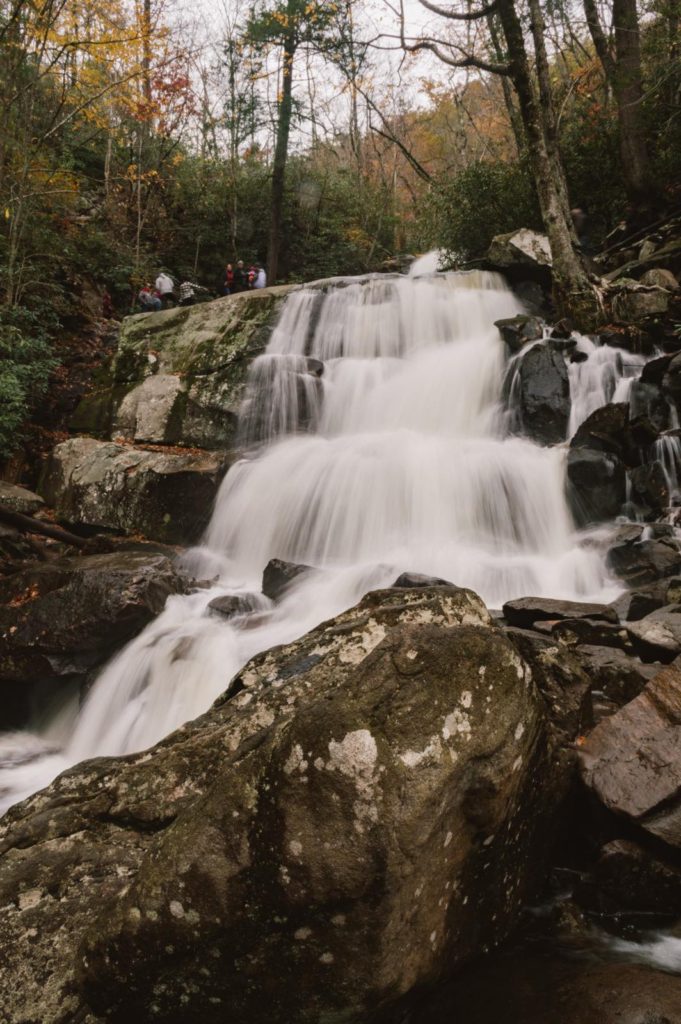
Meigs Falls
Once you have your waterfall fill ( impossible, I know ), make your way toward Cades Cove via Little River Road. Along this road, you’ll want to pull over at Meigs Falls. You can see this one from the road so it’s a great spot for low effort, high reward.
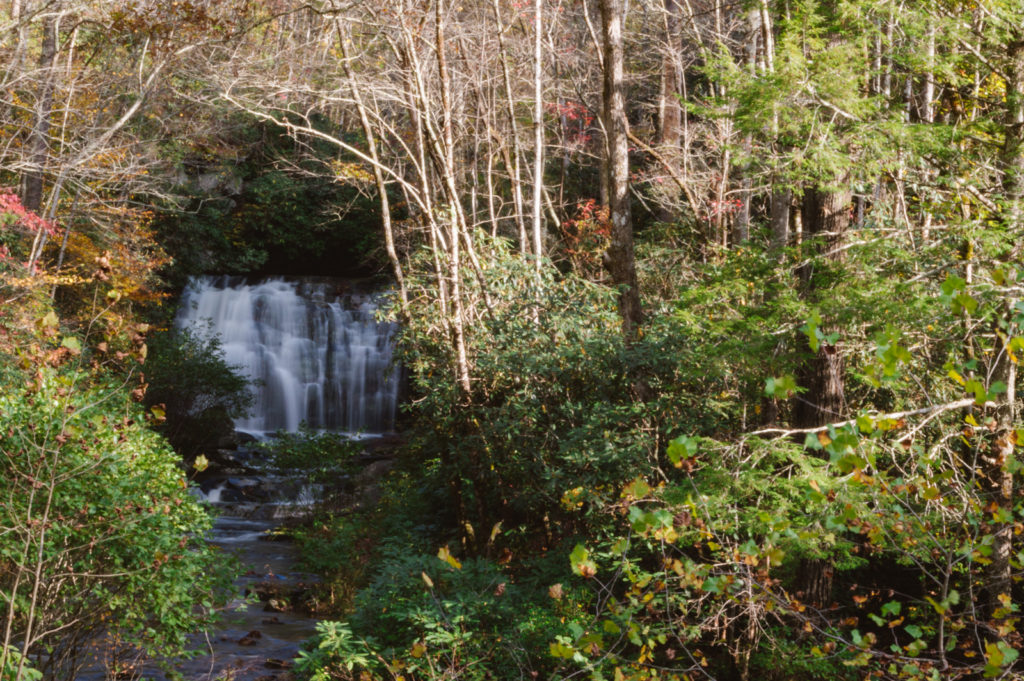
Continue on Laurel Creed Road to Cades Cove Loop Road, which must be driven in a counter-clockwise direction. There will be signs directing you, so don’t sweat it!
Cades Cove is a picturesque valley with lots of places to stop, specifically for historic structures and wildlife. You can walk to John Oliver Cabin, Elijah Oliver Place, Cable Mill, and the Primitive Baptist Church, among other spots along the loop.
There are also horses, turkey, and occasionally bears that roam this area. Be safe and stay a safe distance away no matter what.
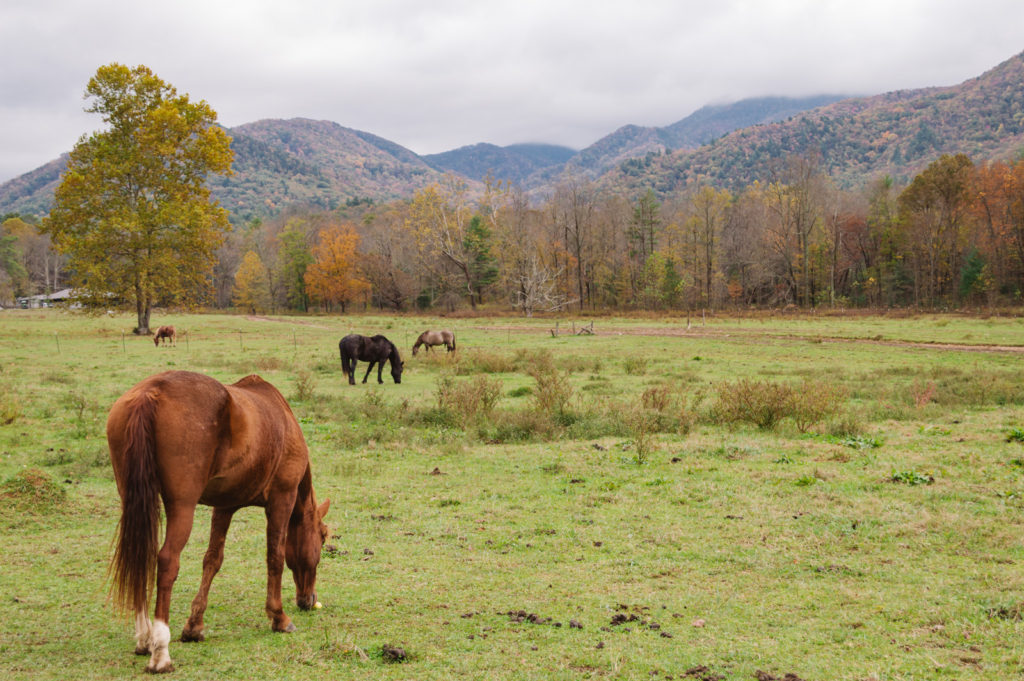
Cades Cove takes around 2-3 hours to drive, even though it’s only an 11-mile loop road. That is because the traffic is extremely slow, especially in the fall and summer. It’s a single lane road so be prepared to stop and be in the car (with no escape) for a couple hours.
What we did and what I recommend, is to pack a lunch (like my favorite, cold cut sandwich makings). Then when you find a good pull-off spot, you can take a break for lunch surrounded by the beauty of Cades Cove.

Elkmont Ghost Town
The last thing on the itinerary for today is to check out Elkmont Ghost Town.
The area was originally settled in the 1840s and gained popularity in the early 1900s when a lumber company was formed. However, the national park was established in 1934 and by 1992 the residents’ leases expired and the town was abandoned.
Now the historic structures sit there for travelers to visit.
Elkmont Ghost Town is located near Elkmont Campground so follow the signs for the campground at first. When you see a sign for the Elkmont Nature Trail turn left and you’ll find the parking lot for the ghost town.
Get out and walk around the town to get a feel for these historic buildings. You can walk inside some of them to see the size of rooms and feel the old wood floors creak under you. In the fall, it makes for an especially spooky time!
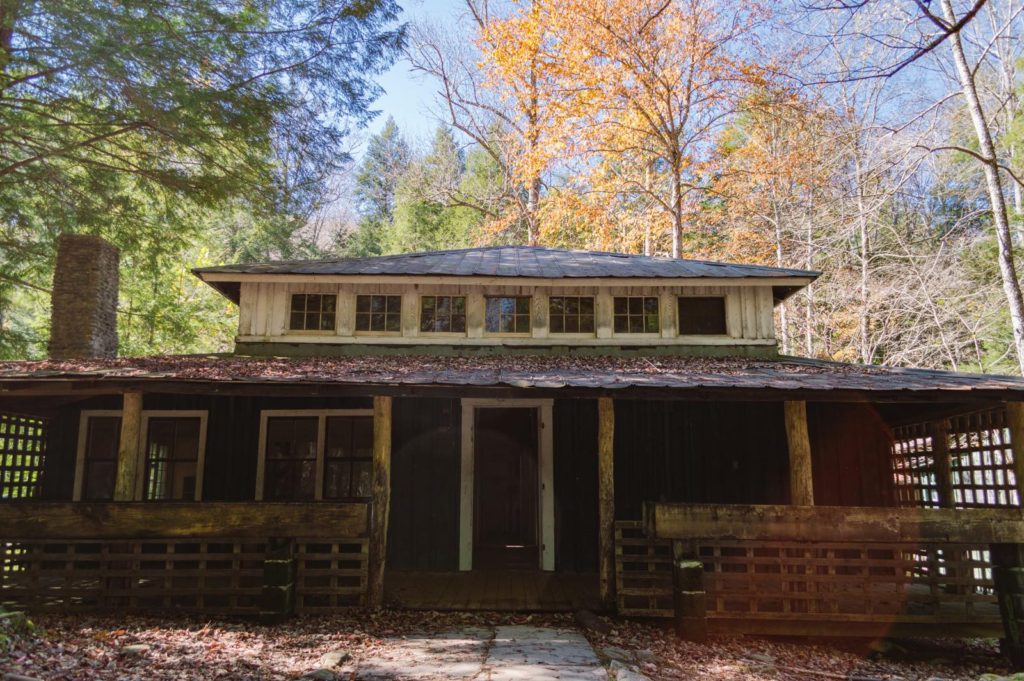
Dinner in Gatlinburg
For dinner, I recommend exiting the park and picking a spot in Gatlinburg. Big Daddy’s Pizzeria has great wood-fired pizza or try Delauder’s BBQ for a budget-friendly barbeque spot!
Good morning! Start your day with coffee at Gatlinburg Grind or if you’re like me and prefer a full breakfast, Crockett’s Breakfast Camp is a yummy option in Gatlinburg.
Alum Cave Bluffs
Make your way into the park to Alum Cave Bluffs trail. This is another one of the most popular things to do in the Smokies so by visiting first thing in the morning, you’ll get prime parking and avoid the crowds.
The trail itself can be hiked in different lengths depending on what you want to see. The most popular (and my recommended hike) is the 2.3-miles to Alum Cave Bluffs. However, you can continue on for 8.7-miles to Mount Le Conte for incredible views.
On the Alum Cave Bluffs trail (the shorter one), you’ll see log bridges, a narrow tunnel, and a “cave” with mountains surrounding you. I put cave in quotes because it’s not really a cave, but more like a rocky overhang that makes you feel like you’re in a cave.
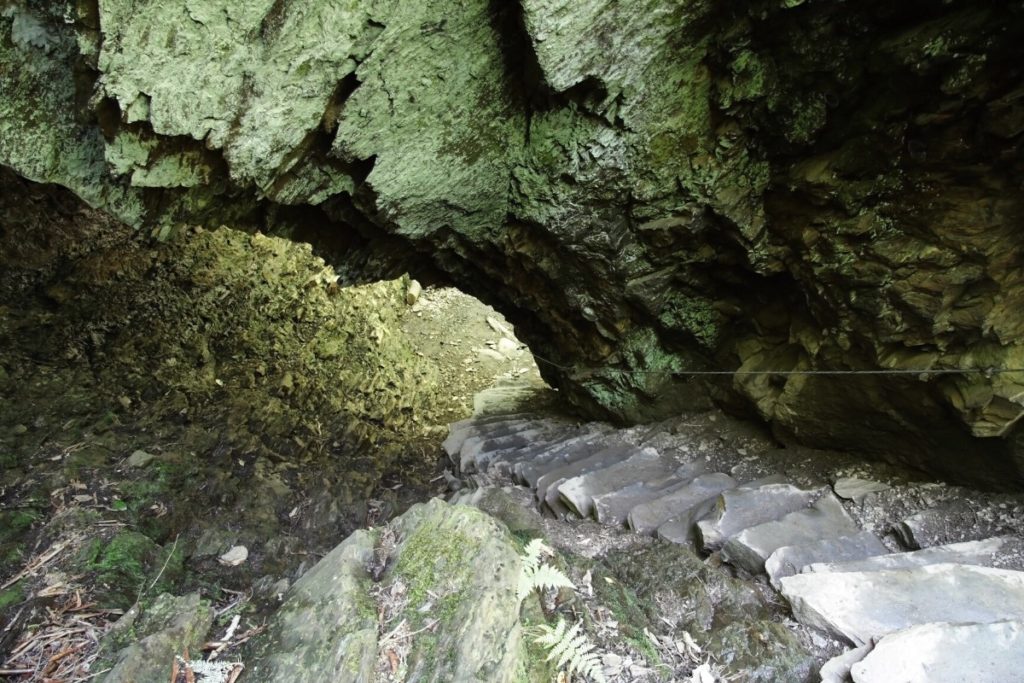
After this hike, if you’re hungry for lunch, I vote lunch break! Again, it’s easiest to pack a lunch so you don’t have to drive in and out of the park a bunch of times.
Clingman’s Dome
Next on the itinerary is Clingman’s Dome. This is the highest point in the Great Smokies and features a manmade observation tower with 360° mountain views. Depending on air quality, you can see up to 100 miles in all directions.
The trail to Clingman’s Dome is paved and only 0.5-miles, however, it is extremely steep. No, seriously…this is the trail that made me think that I had asthma. So even though it’s short in length, bring ample water and take breaks as you need them.
A fun part of this trail is that the Appalachian Trail (AT) crosses the trail to Clingman’s Dome, so if you’ve never hiked the AT, you can step foot on it during this hike.
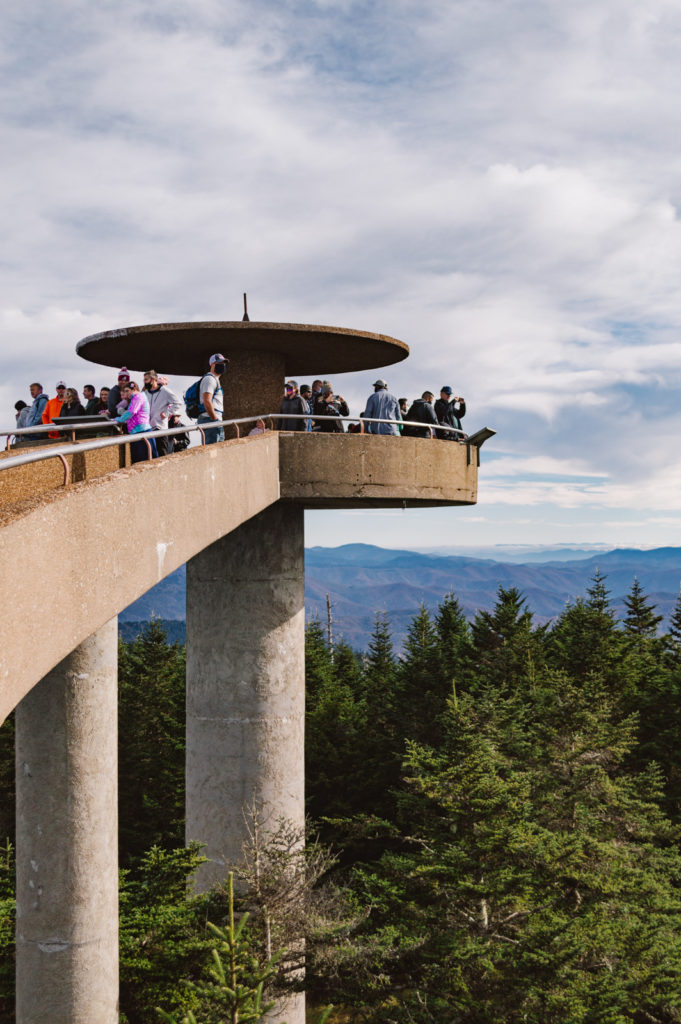
Chimney Tops Trail
The final to-do for today is the Chimney Tops Trail. It’s one of the most popular hikes. It gains 1400-feet in elevation in 2-miles so it’s not for the faint of heart. But, you will be rewarded with some amazing views of not only the mountains but the “chimney tops” rock pinnacles themselves!
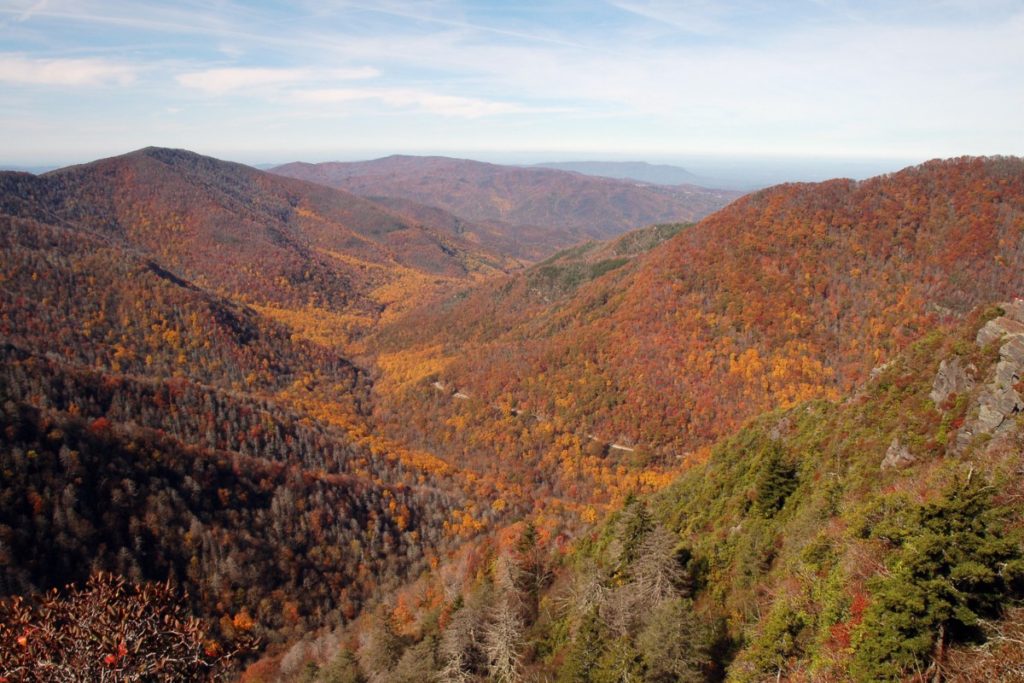
For dinner, if you aren’t camping, again I recommend picking a spot in Gatlinburg. Alternatively, drive a little farther to Pigeon Forge, which has endless options and entertainment.
More Things to Do in the Park
For your final day at the Smokies, there are a few things you can do:
- Hike to Charles Bunion via the Appalachian Trail (4 miles one way) – Charles Bunion is a stone outcrop with sweeping mountain views
- Visit Rainbow Falls (5.4-miles roundtrip) – On sunny afternoons, a rainbow is formed in the mist of this 80-foot waterfall
- Take a driving tour – Drive the length of the park and back to be sure you see it from all angles.
- Make use of the specialty maps to do something tailored to you ! Looking for waterfalls, hikes, history? Those maps will guide you best!
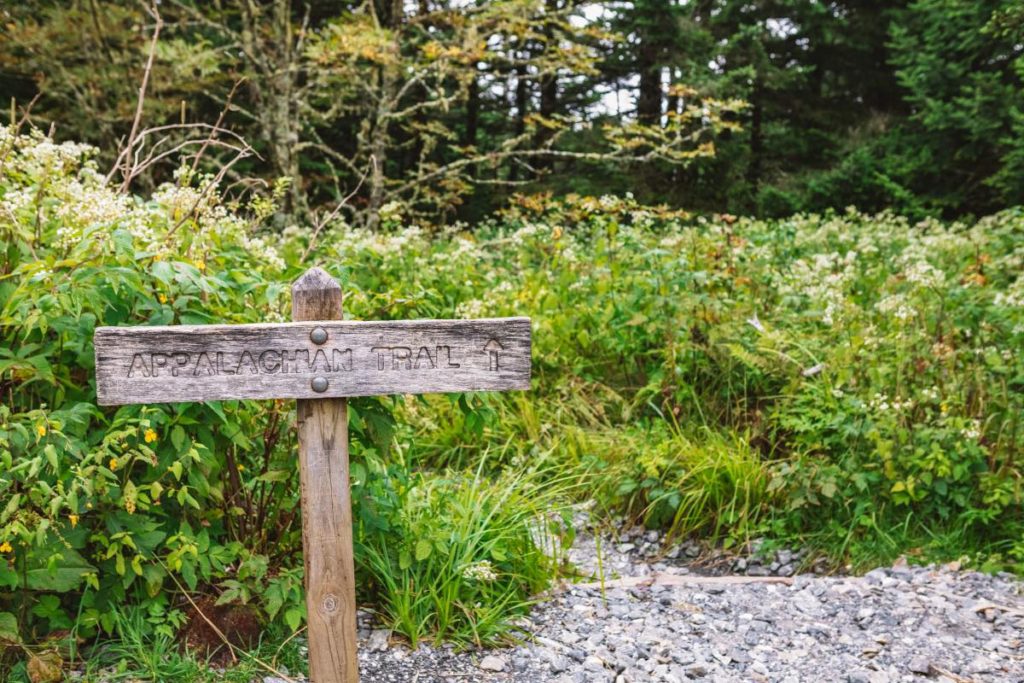
Explore Gatlinburg to the fullest
Alternatively, Gatlinburg has plenty to do so you can easily spend a day or at least an afternoon exploring the town.
One popular spot is Skylift Park, which has the longest pedestrian cable bridge called SkyBridge and a ski lift (called the SkyLift) that you can ride for more scenic views!
Prices for Skylift Park vary seasonally ranging from $35-$50 per person with no student tickets, unfortunately.
Gatlinburg also has some really cute shops to explore. I loved Byrd’s Cookie Company, who makes mini (crunchy) cookies of lots of interesting flavors like toasted pumpkin, rocky road, and cupcake. You can taste before you buy so check them out!

There are also a few museums like Ripley’s Odditorium Museum, Hollywood Star Cars Museum, and even a Salt and Pepper Shaker Museum.
Tips for Visiting Great Smoky Mountains National Park
Here are some tips that will make your trip the Great Smoky Mountains safe, comfy, and just better!
Get gas before entering the park
There are no gas stations inside the park so don’t drive in even close to empty. It’s best (and safest) to start your day with a full tank of gas.
Bring sufficient water and snacks
As with any outdoor adventure, you want to come prepared in the food and water department. Since you’ll have a car, invest in a cooler to hold cold drinks and food. The nearest grocery store is in Pigeon Forge (called Kroger), where you can purchase everything including the cooler and ice.
For hiking snacks, salty foods are helpful in replenishing the salt your body loses when sweating!
And don’t forget drinks with electrolytes like Gatorade.
Be prepared with bear spray
Wildlife is beautiful, but can also be scary so come prepared for the worst. If you are driving in, you can purchase some on Amazon ahead of time.
Unfortunately, you cannot bring bear spray in your checked or carry-on luggage as it typically exceeds the volume limits. If you’re flying in, I recommend stopping at Nantahala Outdoor Center to check for bear spray there. If they don’t have it, hopefully they can recommend where to get it locally.
What to pack for the Smokies
Here are some essentials that you don’t want to forget for your trip to Great Smoky Mountains National Park.
- Bear spray (see above for the best way to go about this if flying in)
- Camelbak or a similar backpack with water bladder . Carrying your water on your back can make hiking easier.
- Cooler for cold drinks and food
- Small first aid kit ( this one can clip onto your backpack)
- Hiking boots
- Biodegradable soap (helpful for washing hands, dishes, hair, etc.)
Check out these related reads:
- A music and BBQ filled Memphis, TN itinerary
- Tips for planning a hiking itinerary
- How to spend a weekend in Asheville, NC
- Fun and inexpensive things to do in Chattanooga, TN
- Travel guide to Johnson City, Tennessee
- Travel guide to Helen, GA
- How to plan a last minute trip
- Ways to spend the fall season in Georgia
- Adventures, history, and food activities in Knoxville, Tennessee
- Enjoy classic Tennessee in Clarksville
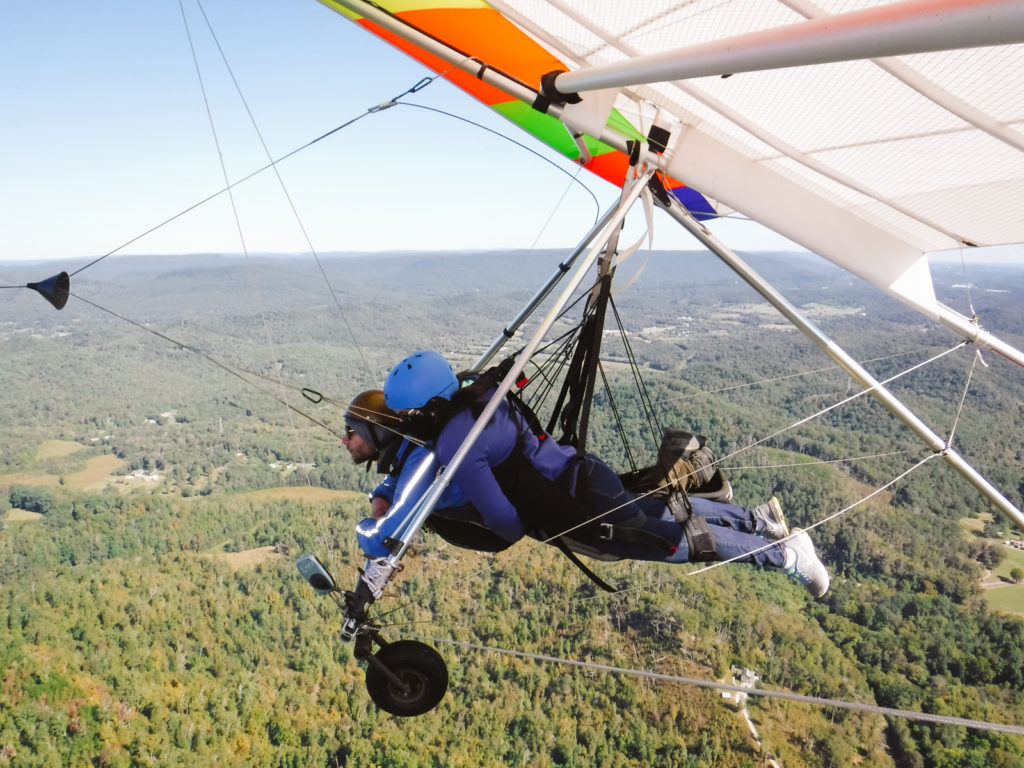
Save to Pinterest

My Travel Essentials
- Travel Insurance – Going on an international trip? Don’t forget travel and medical insurance with SafetyWing .
- Travel Card – If you’re new to travel hacking, fear not! My favorite card for beginners gives you $750 in rewards when you spend $4,000 in the first 3 months, plus lounge access, 10x points on hotel bookings, and free TSA pre-check!
- Get Your Guide – Check out Get Your Guide for a one-stop-shop for booking travel activities.
- Booking.com – This is my favorite hotel search aggregator, specifically for reading reviews. On Booking.com , the reviews can be searched for keywords like WiFi, breakfast, pool, amenities, etc.! So helpful!
- Anti-pickpocket bag – Worried about having your valuables swiped? PacSafe makes the best travel bags with zippers and straps that lock and with mesh steel enforced fabric.
- Give the Gift of Travel – This is the perfect gift for travelers in your life! Tinggly allows you to gift experiences around the world, perfect for birthdays, weddings, or anniversaries.
- Staycation Idea – Check out Resort Pass , which gives you day passes to resorts so you can use their pool, spa, and fitness center, a great staycation idea!
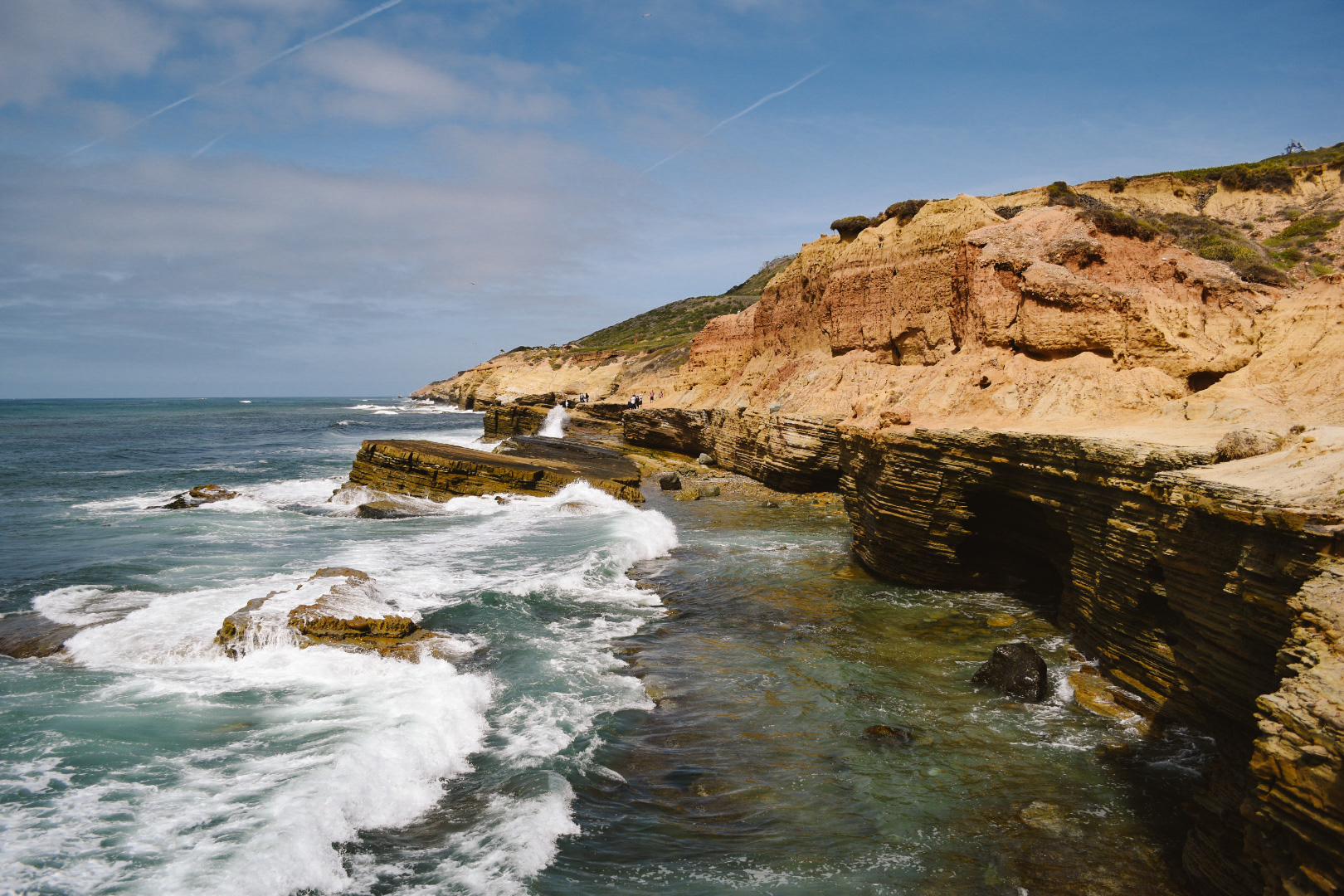
previous post

Alanna Koritzke
Recent PhD graduate and hyper-planner of Periodic Adventures, my goal is to share travel inspiration, budget tips, detailed guides, and fun travel stories!
Related Posts

How to Spend 1 Day in Lisbon, Portugal: Highlights, Culture, and Iconic Eats

Ultimate 7 Day Portugal and Spain Itinerary with a Map
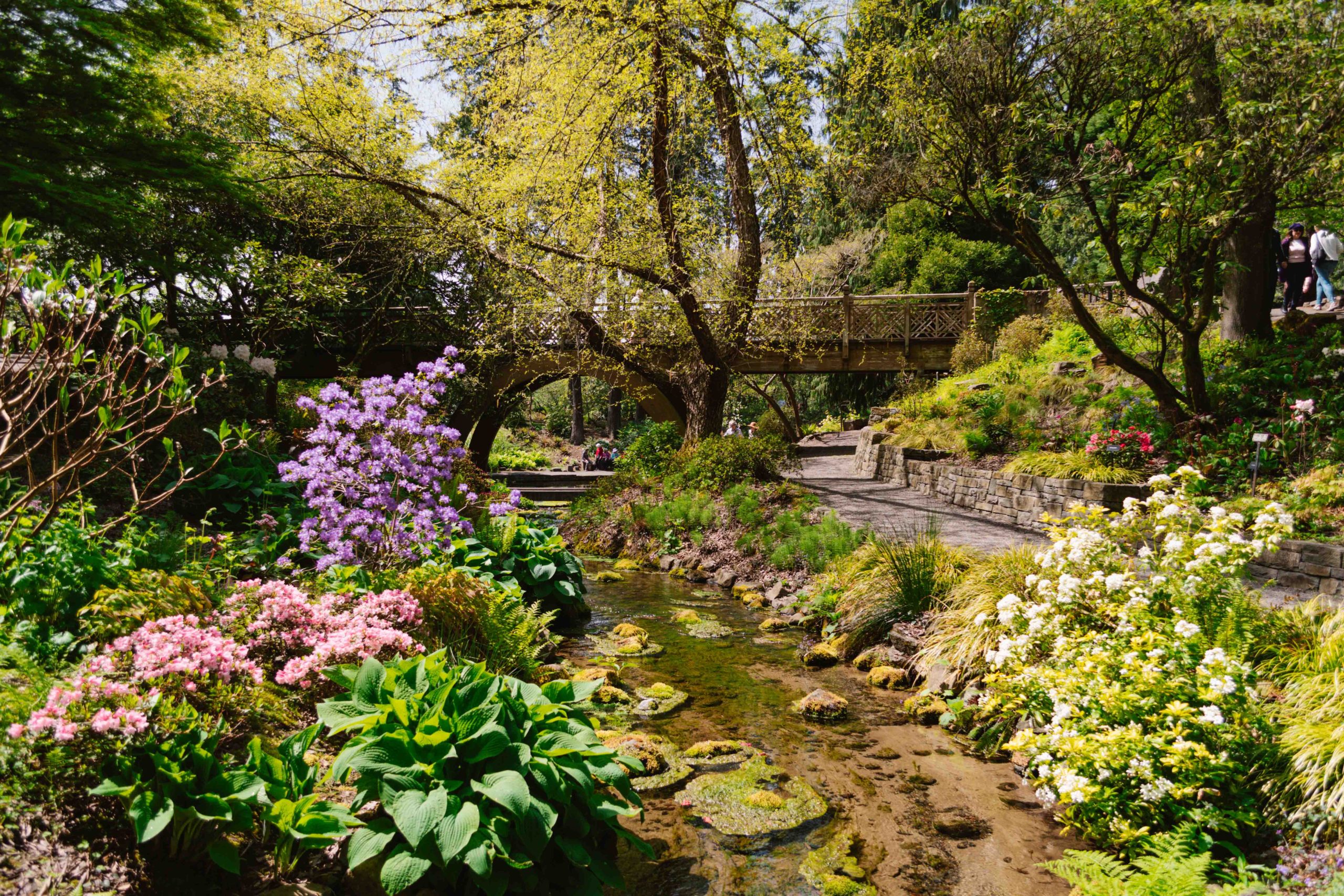
7 Most Beautiful Gardens in Portland Oregon
Pingback: the best waterfalls in tennesse: a magical tennesse waterfall road trip itinerary - the homebody tourist.
Excellent guide Alanna! I’ve visited the Smoky Mountains but didn’t get to everything on your list; I’d love to go back. Great photos!
Thanks Nikki! There’s really so much to explore in the Smokies!
And they are right in my “backyard”!! It’s funny how little time we’ve spent here based on proximity, living in NC. Thanks for the reminder and suggested itinerary!
It’s definitely so easy to forget about local destinations, but I’m happy to be your reminder 😉
I was so bummed out that you are not allowed to bring your dog to hike at Great Smokey NP. I know we could drive through BUT …
That is a bummer! Luckily it can be driven in a day if you did just want to see it!
I love the Smokies! ANd 3 days is a perfect amount of time. The Alum Cave hike is so fun, definitely recommend!
Glad you agree Maggie! Thanks for reading!
Oooh I KNOW I would love to camp and go hiking in the Smoky Mountains. This looks right up my street. I quite like the idea of visiting in the autumn, but I would also be keen to see it in the sprigtime when the trees are bright green and those waterfalls would be gushing! Great post <3
Autumn and spring really are the best times, so you can’t go wrong!
Pingback: 20+ Dreamy Mountain Honeymoon Destinations in the USA
Pingback: 16 best national parks to visit in september - it's not about the miles, pingback: one weekend in gatlinburg, tn: an adventurous 3-day gatlinburg itinerary - the homebody tourist.
Hi, I am interested in doing your Smokey Mountain 3 day itinerary. Is there a way to print it out?
post a comment cancel reply
Save my name, email, and website in this browser for the next time I comment.
This site uses Akismet to reduce spam. Learn how your comment data is processed .
Privacy Overview
- Search Please fill out this field.
- Manage Your Subscription
- Give a Gift Subscription
- Sweepstakes
- National Parks
The Country's Most-visited National Park Has Year-round Wildflowers, Stunning Mountain Views, and Diverse Wildlife
Here's everything you need to know about visiting Great Smoky Mountains National Park.
Evie Carrick is a writer and editor who’s lived in five countries and visited well over 50. She now splits her time between Colorado and Paris, ensuring she doesn't have to live without skiing or L'As du Fallafel.
:max_bytes(150000):strip_icc():format(webp)/evie-carrick-df91be43396540c492c4141c56a71a9e.jpg)
- Planning Your Visit
Best Time to Visit
How to get there, best things to do, wildflowers, places to stay, places to eat.
Inhasker/Getty Images
There’s a reason Great Smoky Mountains National Park sees more visitors than any other national park in the United States. Its sprawling 522,419 acres straddle two states — North Carolina and Tennessee — and the Great Smoky Mountains, part of the Appalachian Mountains. Tucked inside are some of the highest mountains in the eastern U.S. (including Clingmans Dome at 6,643 feet), dense forest, year-round wildflowers, stunning drives, and hiking trails.
Beyond its natural beauty, Great Smoky Mountains National Park is home to southern Appalachian culture and around 1,500 American black bears (that’s approximately two bears per square mile.).
“Each visitor to the park, whether it’s their first time or they’ve been coming for decades, has their own reason for a visit. That’s part of the magic of the Smokies” said Emily Davis, a public affairs specialist for the park, in an interview with Travel + Leisure . “Some people come to see wildflowers and wildlife, some want to challenge themselves on a new trail, some like exploring the park’s history, and some want to take a scenic drive.”
We chatted with Davis and a few other local park experts to put together a comprehensive guide to the park. Here's everything you need to know before visiting Great Smoky Mountains National Park.
Meet the Expert
Emily Davis is a public affairs specialist at Great Smoky Mountains National Park who previously worked in public affairs and as a park ranger at other parks around the country.
Amie Newsome is the social media and content manager for the Haywood County Tourism Development Authority in North Carolina.
Mark Van Osdal is the owner of Carolina Bound Adventures based out of Bryson City, North Carolina, and Sarah Spiro is a lead guide at the tour company.
Alisha Bube/Getty Images
Planning Your Visit
The park is open 24 hours a day, seven days a week, year-round. Some secondary roads will close during the winter, but main routes, like Newfound Gap Road (US-441), Little River Road, and Laurel Creek Road are open all year, depending on the weather.
The park is one of a handful of national parks with no entrance free, meaning it is completely free to visit. That said, if you plan to park your car for longer than 15 minutes within the park boundaries, you will need a parking tag — which is $5 a day, $15 for the week, or $40 for the year. Tags are available for purchase online or can be picked up from most visitor centers in person.
Dogs are allowed in Great Smoky Mountains National Park campgrounds, picnic areas, and roads, but they must be leashed. There are just two dog-friendly walking trails, the Gatlinburg Trail and the Oconaluftee River Trail , since most of the park’s hiking trails are set in the pristine backcountry.
Great Smoky Mountains National Park is busiest during the summer and fall. Amie Newsome, the social media and content manager for Haywood County Tourism Development Authority, recommends pushing your trip to the fall if you’re a wildlife fan, saying, “My favorite time to visit the park would be in the rut season, which is usually September/October. This is when the elk are most active and vocal amidst the beautiful fall foliage. Our section of the park, Cataloochee Valley, is where the elk were reintroduced in 2001.”
Meanwhile, both Davis and lead guide Sarah Spiro with Carolina Bound Adventures (based out of Bryson City, North Carolina) love springtime in the park. “I have never seen the variety of greens anywhere else!” says Davis of springtime in the park, while Spiro says, “The GSMNP (Great Smoky Mountains National Park) is often referred to as the ‘wildflower park’ and for a good reason. Every single week in springtime, a new variety of over 1,500 species of wildflowers begins popping up.”
It’s worth noting that from late October to early May, some secondary roads — including Clingmans Dome Road — can be closed due to weather or closed to certain vehicle types (think buses, motorhomes, long vans, and trailers).
There are plenty of ways to get into Great Smoky Mountains National Park for a hike or to set up camp, but there are only three true entrances. The main entrance is in Gatlinburg, Tennessee on the north side of the park. From Gatlinburg, visitors will quickly come upon Sugarlands Visitor Center, the park’s headquarters. The other Tennessee entrance is in Townsend, which is close to the Cades Cove Visitor Center.
North Carolina's main entrance to the park is in Cherokee, North Carolina, which is part of the Qualla Township and home to the Eastern Band of the Cherokee. The nearby visitor center, Oconaluftee Visitor Center, is the best way to access the park from the south.
No matter which entrance you plan to use, you won’t want to plug it into Google Maps and zone out. Car navigation and GPS don’t always work in the park, and they often lead drivers down one-way roads or to remote areas. Your best bet is to drop by a visitor center to get a paper map or download a free topographic map on your phone.
Todd Ryburn Photography/Getty Images
Scenic Drives
If you want to take it easy and enjoy the beauty, hop in your car and drive the 384 miles of (mostly paved) road inside the park. Davis says, “Driving to Newfound Gap or Clingmans Dome gives a first-time visitor an opportunity to see the Great Smoky Mountains live up to the name.”
Road Biking
If you want to cover some distance and still enjoy the fresh air, make your way to Cades Cove Loop Road. The 11-mile one-way road passes through 19th-century homesites and is so popular with cyclists that it’s closed to cars (bikes only!) every Wednesday from May to September. During peak cycling season (summer and fall), you can rent bikes at the campground store near Cades Cove Campground. There are no mountain biking trails in Great Smoky Mountains National Park.
Great Smoky Mountains National Park is home to one of the last wild trout habitats in the eastern U.S. As such, you’ll find plenty of trout, along with smallmouth bass. Angling in the 2,900 miles of streams within the park boundaries is a popular activity year-round. Before you grab your pole, make sure you have a fishing license from either Tennessee or North Carolina (both state licenses are valid throughout the park). Special permits are required for fishing in Gatlinburg and Cherokee.
Historic Buildings
There are over 90 historic structures in the park, including barns, churches, schools, and homes. The best places to experience the land’s long human history are the Cades Cove, Cataloochee, and Oconaluftee areas. There’s also plenty of history to be had along the Roaring Fork Motor Nature Trail , which provides access to an authentic mountain farmstead along with plenty of waterfalls.
Tammi Mild/Getty Images
If you want to get away from civilization and find your own quiet corner of the park, there are more than 800 miles of trails waiting to be explored. Below are a few local favorites, but if you really want to avoid the crowds, visit one of the less-visited routes outlined on the park's website. As a general rule of thumb, the park notes on their website that “hikers in the Smokies travel about 1.5 miles per hour. Many people travel slower.” So make sure to plan your hike so you will return well before the sun sets.
Deep Creek Loop Trail
If you want to be surrounded by water — both streams and waterfalls — plan a hike on Deep Creek Loop Trail. Spiro, who leads the hiking division at Carolina Bound Adventures, says on the North Carolina side of the park she recommends “the Deep Creek Loop Trail a couple of miles outside Bryson City, where you’ll see three waterfalls within a very short hike.” The trail is also one of the few routes within the park where bicycles are allowed.
Caldwell Fork Trail
If you want to have nature to yourself (for the most part, at least), head to the Cataloochee Valley, which tends to be a bit quieter. The valley was once a Cherokee hunting ground and now has plenty of trails, including the Caldwell Fork Trail , which Newsome enjoys because it “begins with a beautiful, picturesque log bridge crossing.” The entire loop is over 16 miles (and therefore popular with backpackers), but you can cut the route as short as you want.
Appalachian Trail
The Appalachian Trail passes right through the park, topping out at Clingmans Dome, the highest point along its journey from Georgia to Maine. If you’re feeling fit, you can hike part of the famous route to Charlies Bunion, a notable stone outcropping with stunning mountain views. “Hiking the Appalachian Trail to Charlies Bunion is hard, but so worth it if you’re prepared,” said Davis.
Great Smoky Mountains National Park is often called the “Wildflower National Park” because it has over 1,500 kinds of flowering plants (more than any other national park). And while spring is the best time to visit for wildflower viewing (there’s even a weeklong Spring Wildflower Pilgrimage in May), there are blooms year-round — including winter.
Notable blooms include the spring ephemerals — trillium, lady slipper orchids, crested dwarf iris, columbine, bleeding heart, and violets, to name a few — and the summer arrival of red cardinal flowers, purple-fringed orchids, and black-eyed Susans. In the fall, goldenrods, sunflowers, and several varieties of asters begin to bloom, while February marks the arrival of spicebush blossoms, rhododendrons, and flame azaleas. The park has even put together a complete list of wildflower walks .
Beyond the 1,500 blooming plants, Great Smoky Mountains National Park is home to around 65 species of mammals, over 200 varieties of birds, 67 native fish species, and more than 80 types of reptiles and amphibians. The park’s most famous inhabitants are likely the American black bear (with an estimated population of 1,500), but the reintroduced elk population in Cataloochee Valley is also a big draw.
You can see the noble creatures on your own, but for more likely sightings (and information on the animals and their reintroduction), Newsome recommends booking a guide through Cataloochee Valley Elk Tours or Scenic Tours and Rentals .
WerksMedia/Getty Images
Campgrounds
Camping is plentiful within the park, with 10 developed campgrounds , along with a handful of backcountry camping sites for backpackers. For the former, only Cades Cove Campground (on the Tennessee side) and Smokemont Campground (on the North Carolina side) are open year-round. The other three major campgrounds are Elkmont Campground with 211 sites near the Sugarlands Visitor Center, Cosby Campground with 157 sites (and plenty of shade), and Deep Creek Campground with 92 sites and a creekside setting near some of the park’s best hiking.
LeConte Lodge
There is just one lodge within the park’s boundaries, but you have to hike 5 miles to get there. The rustic cabins of LeConte Lodge are in a stunning setting atop Mount LeConte. The lodge is generally open from mid-March to mid-November, closing during the winter season. And when it’s open, demand for a spot is high; people book early, and there’s a running waitlist.
Lodging Near the Park
If you’re not interested in camping or hiking to a backcountry lodge, you will need to stay in one of the towns surrounding the park. On the Tennessee side, people tend to stay in Cosby, Newport, Gatlinburg, Pigeon Forge, Sevierville, or Townsend. On the North Carolina side of the park, check out lodging in Bryson City, Cherokee, Fontana, Graham County, Haywood County, Maggie Valley, or Waynesville.
The Swag in Waynesville, North Carolina was voted the top resort in the South in our 2023 World's Best Awards , and Dollywood’s DreamMore Resort and Spa in Pigeon Forge, Tennessee also made the list.
Mark Van Osdal, co-owner of Carolina Bound Adventures, says “Bryson City is a quiet, quaint, small-town choice and has two main entrances to the national park - Deep Creek and Lakeshore Drive.” We have a soft spot for Fryemont Inn , which is listed on the National Register of Historic Places, and Lakeview at Fontana , which has private soaking cabanas with beautiful views
For glampers interested in a unique stay, book a night in a caboose in Waynesville or a yurt on a peony farm in Clyde, North Carolina. There are also luxury safari tents at Under Canvas ’ Smoky Mountain location 10 miles from Gatlinburg, Tennessee.
Unlike other major national parks, food and drink options are extremely limited within Great Smoky Mountains National Park. You’ll find convenience items in the visitor centers and at the Cades Cove store (in peak season only), but for the most part, people eat outside the park or bring their picnics in.
With that in mind, Newsome and Van Osdal offered some recommendations for dining in the park’s surrounding mountain towns.
Frankie’s Italian Trattoria: An Italian spot with outdoor seating in Maggie Valley, North Carolina, Frankie’s has a full bar and a menu with eats like lasagna, pizza, and veal marsala.
Joey’s Pancake House: This Maggie Valley mainstay is set in a 1966 diner and is known for its comfort food breakfasts and creative pancakes.
Birchwood Hall Southern Kitchen: For elevated, farm-to-table Southern fare, this spot in Waynesville, North Carolina is the place to be (and their cocktail list is out of this world).
Delauder's BBQ: Going to the South and not getting barbecue would be a mistake. Delauder's BBQ is one of the best barbecue spots in Gatlinburg, Tennessee, and its old-school unpretentious vibe somehow makes the food taste even better.
Mountain Perks: This family-run coffee shop in Bryson City, North Carolina has a homey vibe, with outdoor seating and light eats. Van Osdal has one note: “Get the ‘Kirby’!”
Wize Guyz Grille: This counter-serve spot in Cherokee, North Carolina is a long-time local hangout , beloved for their New York-style pizza and burgers.
Dalaya: Dalaya is a beloved Thai restaurant in Sylva, North Carolina. They have all the Thai favorites, including a great massaman curry and Thai-style chicken wings, with lovely outdoor seating.
A beginner’s guide to visiting Great Smoky Mountains National Park

The Great Smoky Mountains National Park, covering the Tennessee-North Carolina border is filled with scenic views, roaming wildlife and Southern charm. The park proudly carries the title of the most-visited national park year after year. Its proximity and drivability from much of the Southeastern United States brings more than 11 million visitors each year while the second-most visited national park, the Grand Canyon, only pulls in around 6 million per year in recent years.
I am a proud East Tennessee native and grew up going to Pigeon Forge and Gatlinburg. I hiked the park's countless trails each summer so I'm excited to dive in and share with you the must-see, must-do attractions the Great Smoky Mountains National Park and surrounding area has to offer.
For more TPG news delivered each morning to your inbox, sign up for our daily newsletter .
What to see and do
There is truly something for everyone in the Great Smoky Mountains. Nature lovers can take advantage of numerous hiking trails, tubing opportunities down the Pigeon River, scenic drives and even a one-of-a-kind synchronous firefly festival. Those that prefer more of the touristy attractions can enjoy the day at Dollywood learning about Appalachia culture and riding some of the best roller coasters in the country, or explore all that Pigeon Forge has to offer in the form of mini-golf and moonshine tastings.
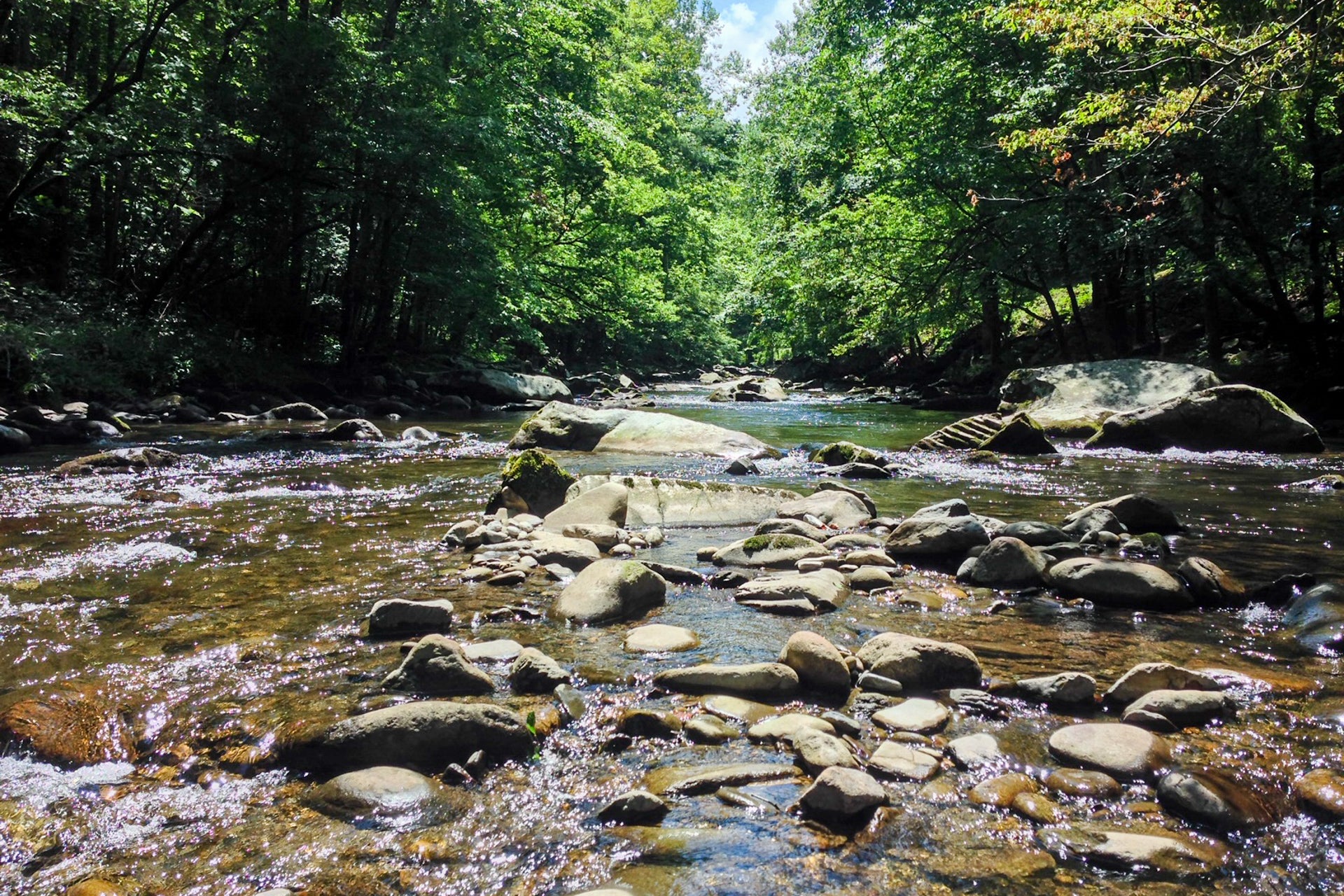
Clingmans Dome (1 mile round-trip) is the highest point in Great Smoky Mountains National Park, at 6,643 feet, with truly unbeatable views. The hike to the peak is only a half-mile from the Clingmans Dome parking area and it's fully paved, but be warned -- it's very steep. It can also be pretty chilly at the top, often 20 degrees cooler than the rest of the park, so bring a jacket. The observation tower at the summit offers sweeping views of both the Tennessee and North Carolina sides of the national park.
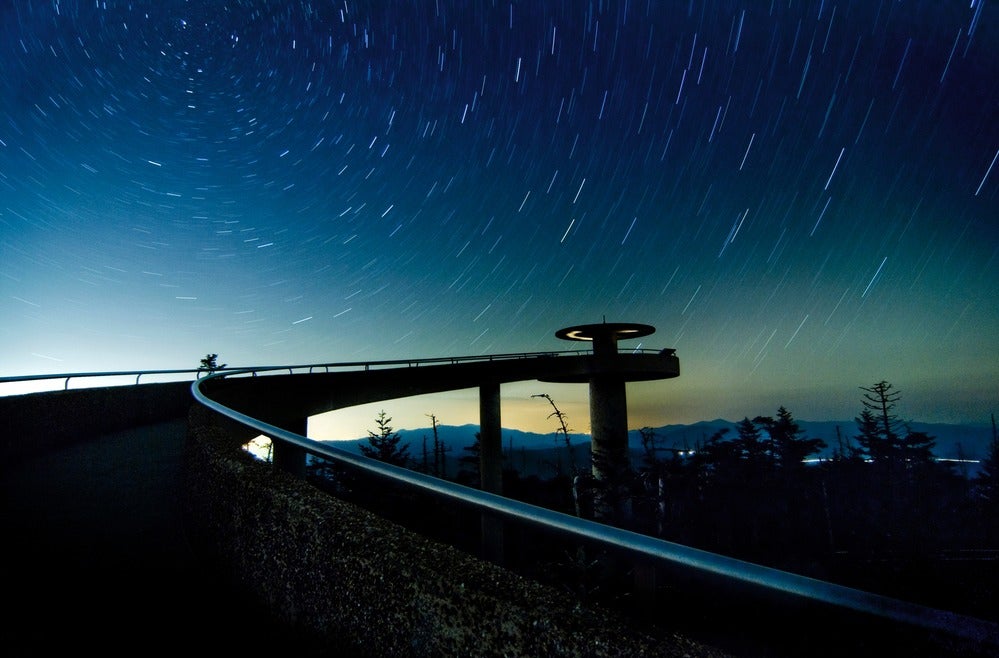
Chimney Tops Trail (3.3 miles round-trip) felt the brunt of the destruction caused by the 2016 wildfires, but it's been mostly restored since reopening in fall 2017. This trail continues to be one of the most popular in the park year after year. It's a great option for more experienced hikers, as it's a pretty short, steep trail that offers incredible panoramic views at the top.
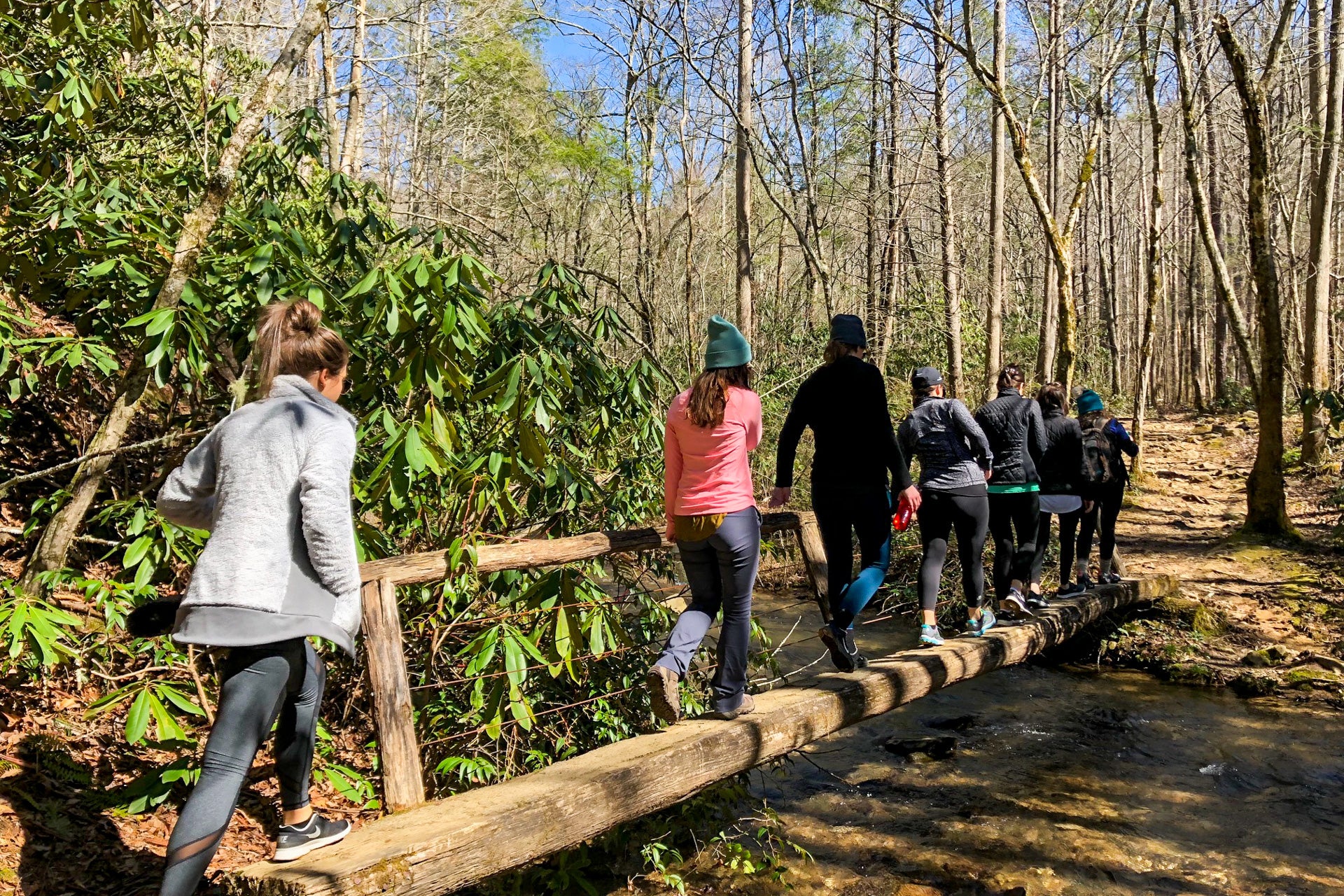
Abrams Falls Trail (5.2 miles round-trip) is a fun, moderate trail that leads to a swimming hole and waterfall at the end -- a perfect spot to take a dip and cool down a bit before hopping back on the trail.
Alum Cave Trail (4.4 miles round-trip) is my personal favorite, and one of the most scenic hikes in the Smokies. This trail offers some beautiful waterfalls and breathtaking views. Follow this trail to the top of Mount LeConte.
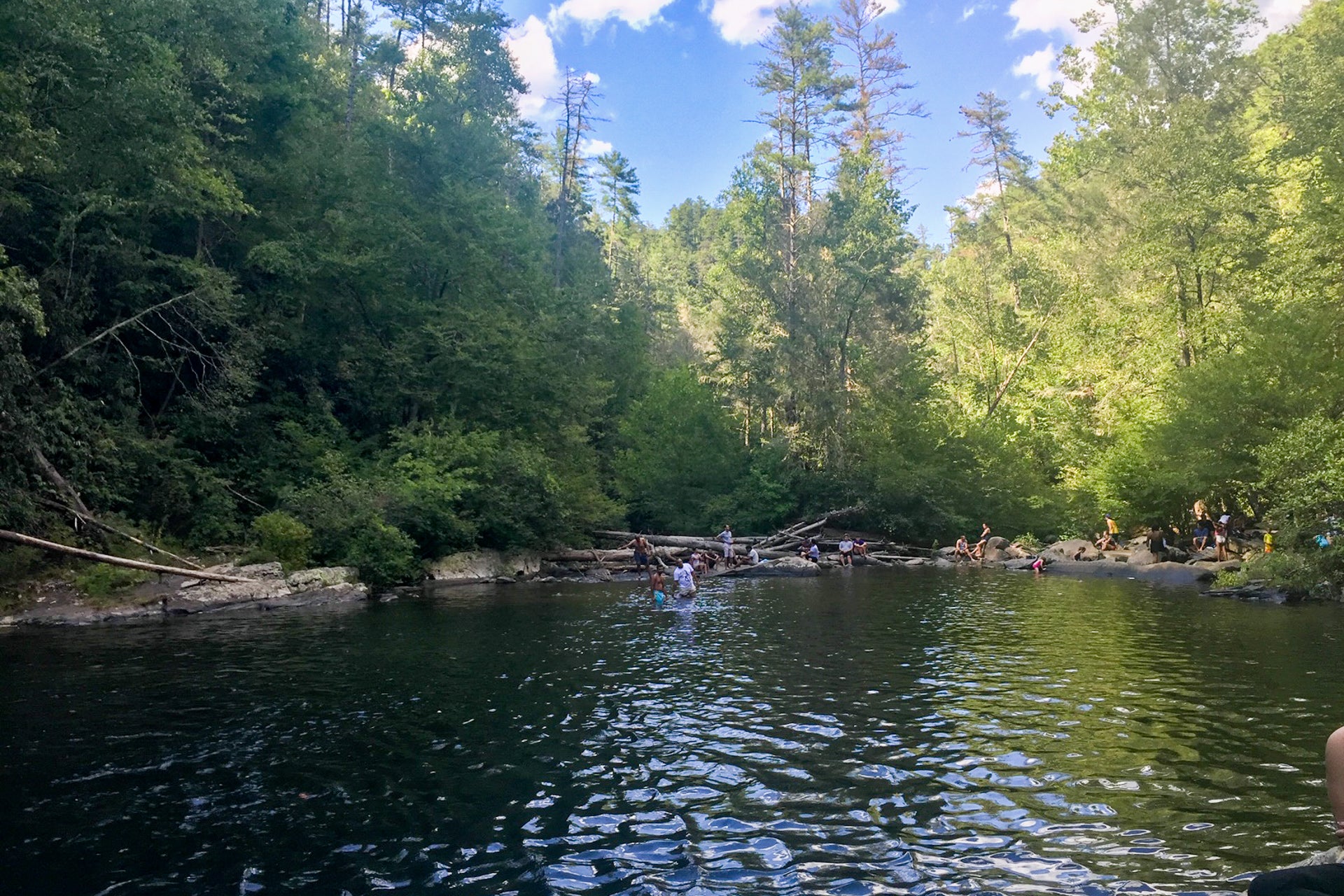
Laurel Falls (2.3 miles round-trip) is widely considered one of the best waterfall hikes in the Smokies. This trail is one of the easiest and most popular roundtrip hikes in the park leading to an 80-foot waterfall with incredible photo opportunities.
Kid-friendly hikes
While I consider Laurel Falls to be pretty accommodating for any hiker, the park also has many kid-friendly hikes highlighted on its website , including Kephart Prong Trail and Porters Creek.
Gatlinburg SkyBridge: It's home to the longest pedestrian suspension bridge in North America and the best views of the Smokies, hands down! There's also a chairlift at the same location since the 1950s -- a true staple in Gatlinburg!
Be sure to consult the National Park Service's official website to make note of any alerts, trail closings or extreme conditions that might affect your hike.
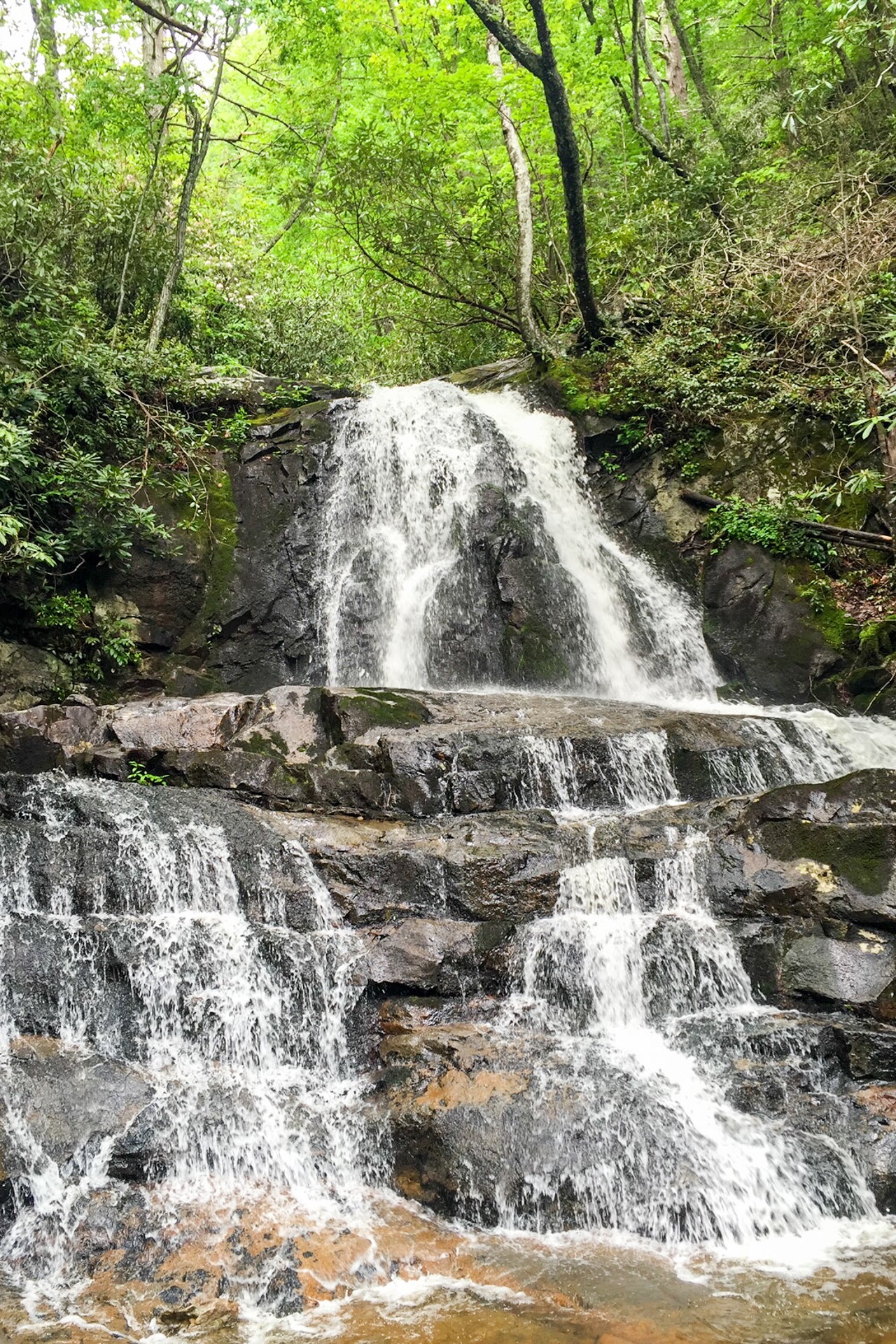
Scenic drives
Cades Cove Loop Road: This scenic 11-mile one-way loop road is perfect to experience the beauty and nature that the Great Smoky Mountains has to offer. The only thing needed to soak up these views is a car or bike and a little bit of patience, as the loop typically doesn't move quickly (especially on high-traffic weekends such as summer and fall holidays). Get your cameras ready and expect to see lots of wildlife. On recent trips through the loop, I've seen bear cubs, deer and more. It's worth noting that the road is closed to motor vehicle traffic on Wednesday and Saturday mornings until 10 a.m. throughout the summer to allow pedestrians and cyclists a chance to enjoy the loop.
"The Tail of the Dragon": Well-known to motorcyclists and car enthusiasts alike, this 11-mile section of Route 129 is infamous for its twists and turns, featuring 318 curves in all. Needless to say, it's not the best bet if you're looking for a nice scenic drive, as this is frequented by experienced motorists and can get dangerous during high season.
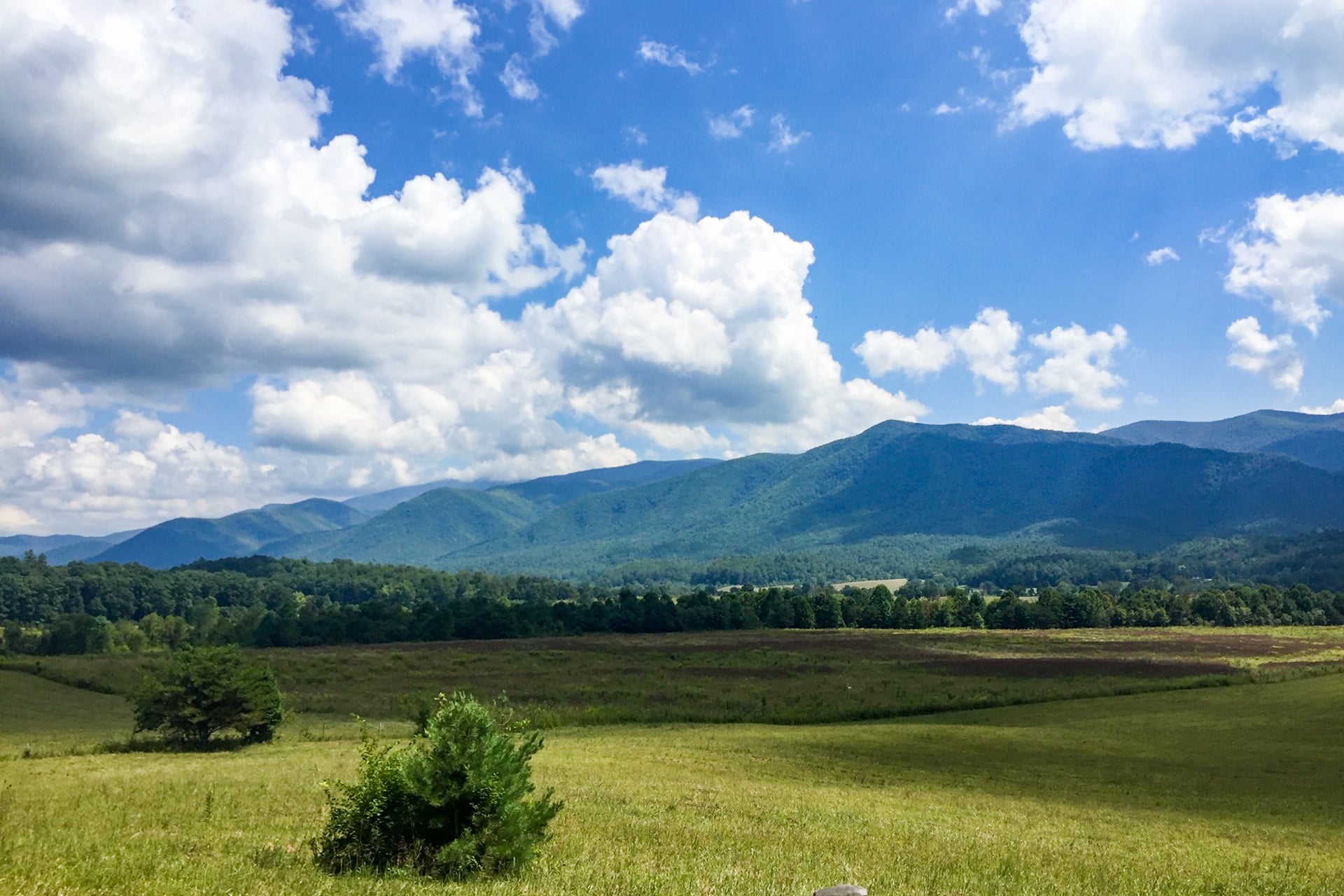
Synchronous firefly festival
This annual event, unique to the Smoky Mountains, should be on everyone's bucket list. I'm embarrassed to admit that I've never been able to snag tickets to this extraordinary display of some of nature's most unusual creatures, but that doesn't stop me from attempting each year. This natural occurrence takes place in late May or early June in the Elkmont area of the park. As you can imagine, the popularity of this event means availability to attend in person is limited. Visitors who would like to view the fireflies in person must enter a lottery for a parking pass to take the shuttle from the Sugarlands Visitor Center. More information can be found on the National Park Service's website.
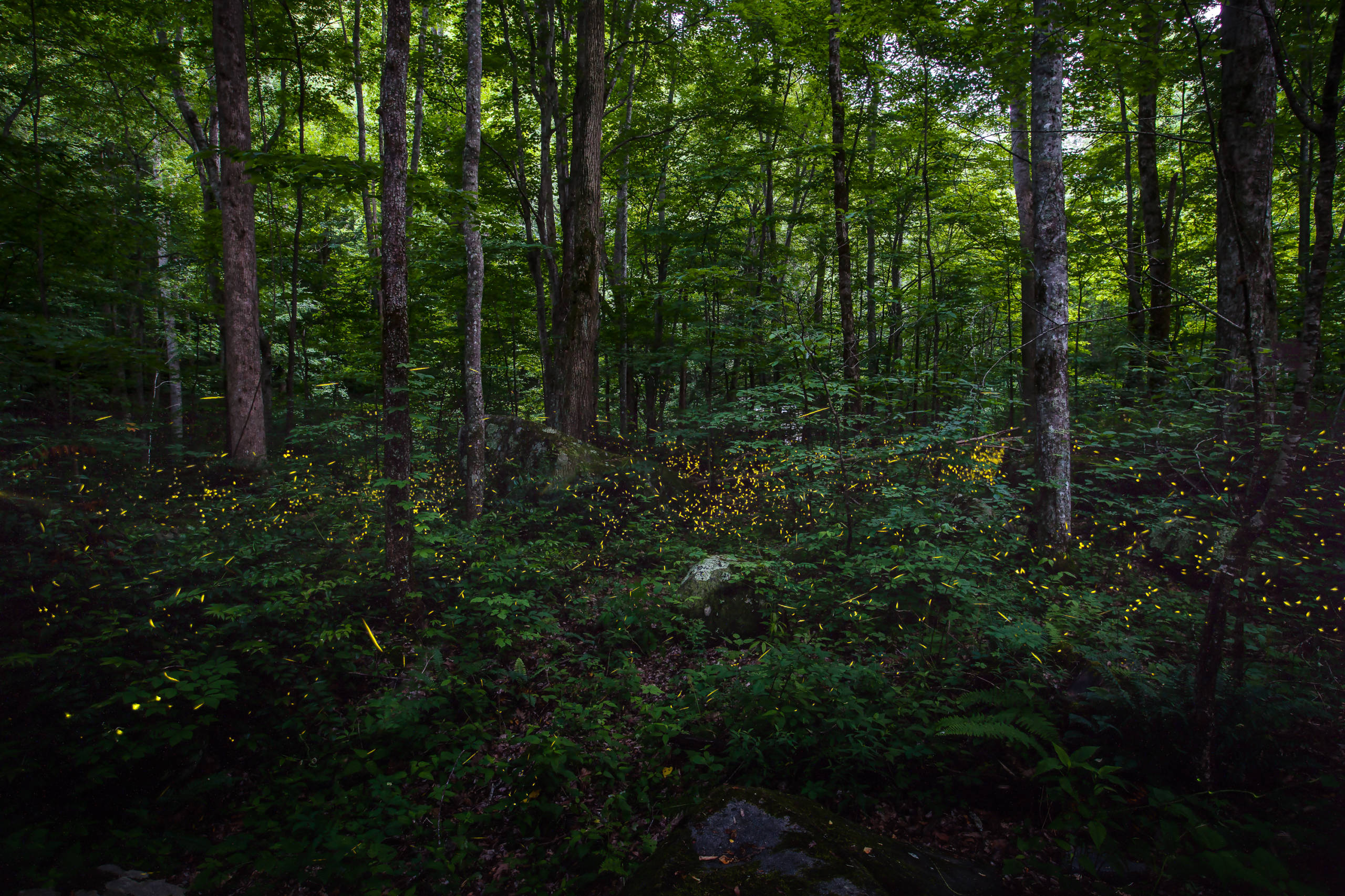
Tubing down rivers
Tubing (aka floating down the river in a raft) is a perfect and easy way to beat the summer heat in the Smokies, and there are two recommended areas on the Tennessee side of the park to do so: the Little Pigeon River in the Pigeon Forge area of town and the Little River in Townsend. Tubing is one of the best ways to take in the scenery, especially in late summer/early fall when the leaves begin to change. Make sure to confirm with the tubing rental company in advance that the water flow is good on the given day you select.
No trip to the Smoky Mountains is complete without a visit to the "eighth wonder of the world," and my favorite theme park in the country: Dollywood. Dolly Parton opened the theme park in Pigeon Forge, Tennessee, a short drive from the entrance to the national park, back in the late 1980s as a tribute to the Smoky Mountain culture that she calls home. It's since become home to some of the most exciting roller coasters, mouth-watering Southern food and annual festivals that attract visitors from far and wide. Check out our full review of Dollywood including when to go and what to expect, and be sure to pencil it into your plans.

Shopping and entertainment
One of the newest additions to the Smoky Mountains area is a mountainside family-friendly adventure park called Anakeesta , right off the Parkway in Pigeon Forge. This destination offers everything from zip lines and scenic gondola rides to a treehouse village adventure and mountainside coaster.
The Island in Pigeon Forge is a newer development right off the Parkway (you can see the Great Smoky Mountain Wheel from miles away). The retail and entertainment center offers something for everyone, including multiple dining options (Paula Deen's Family Kitchen, Margaritaville, Dick's Last Resort and Yee-Haw Brewing Company -- a personal favorite!) and retail vendors (toy stores, cigar shops, hand-blown glass gift gallery and more).
There's never a shortage of entertainment opportunities in Gatlinburg. Stop by Ole Smoky Moonshine or Sugarlands Distilling Company for moonshine tastings. Schedule a game of mountainside mini-golf. Or spend a rainy day at Ripley's Aquarium of the Smokies, featuring more than 10,000 exotic sea creatures. Also, be sure to check out our guide for 10 family-friendly activities in Gatlinburg .
Another great rainy day activity is to hit up the outlet stores at the Tanger Outlet Mall on the Parkway in Sevierville, featuring retailers like Disney, Eddie Bauer, J.Crew, Kate Spade and many others.
Just a short drive from the park, visitors can swing by Cherokee, North Carolina, for a visit to Harrah's Cherokee Casino Resort , a Caesar's property, for some gaming action at the biggest casino in the area.
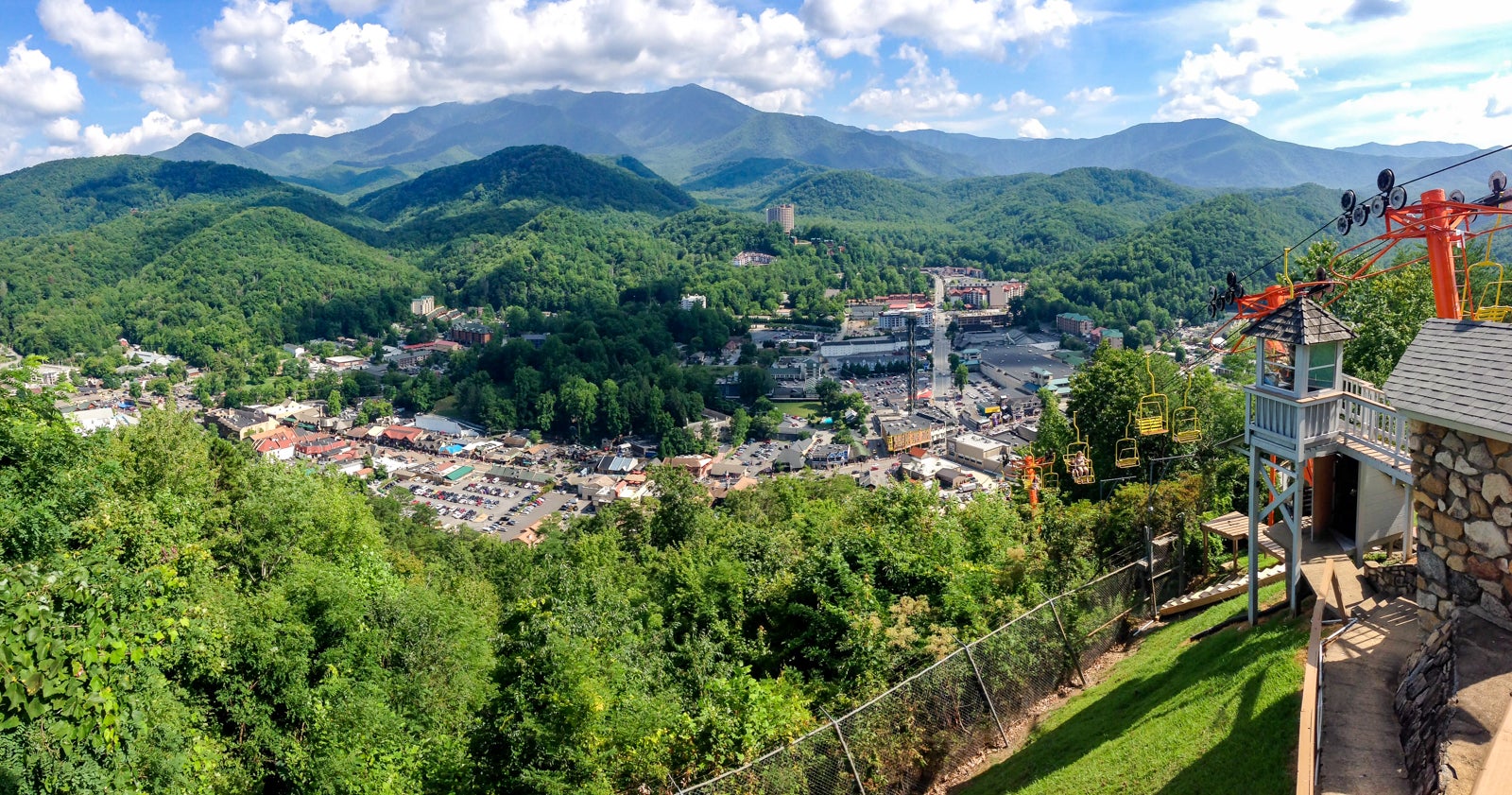
Where to stay
Cabins: For the most authentic experience, I highly recommend a log cabin in the Smokies. There are thousands of cabins to choose from across Pigeon Forge, Gatlinburg, Townsend and more. Be sure to consult our essential guide to renting a cabin in the Smoky Mountains for a list of my favorite cabin rental companies, as well as things to consider when booking a cabin in the area.
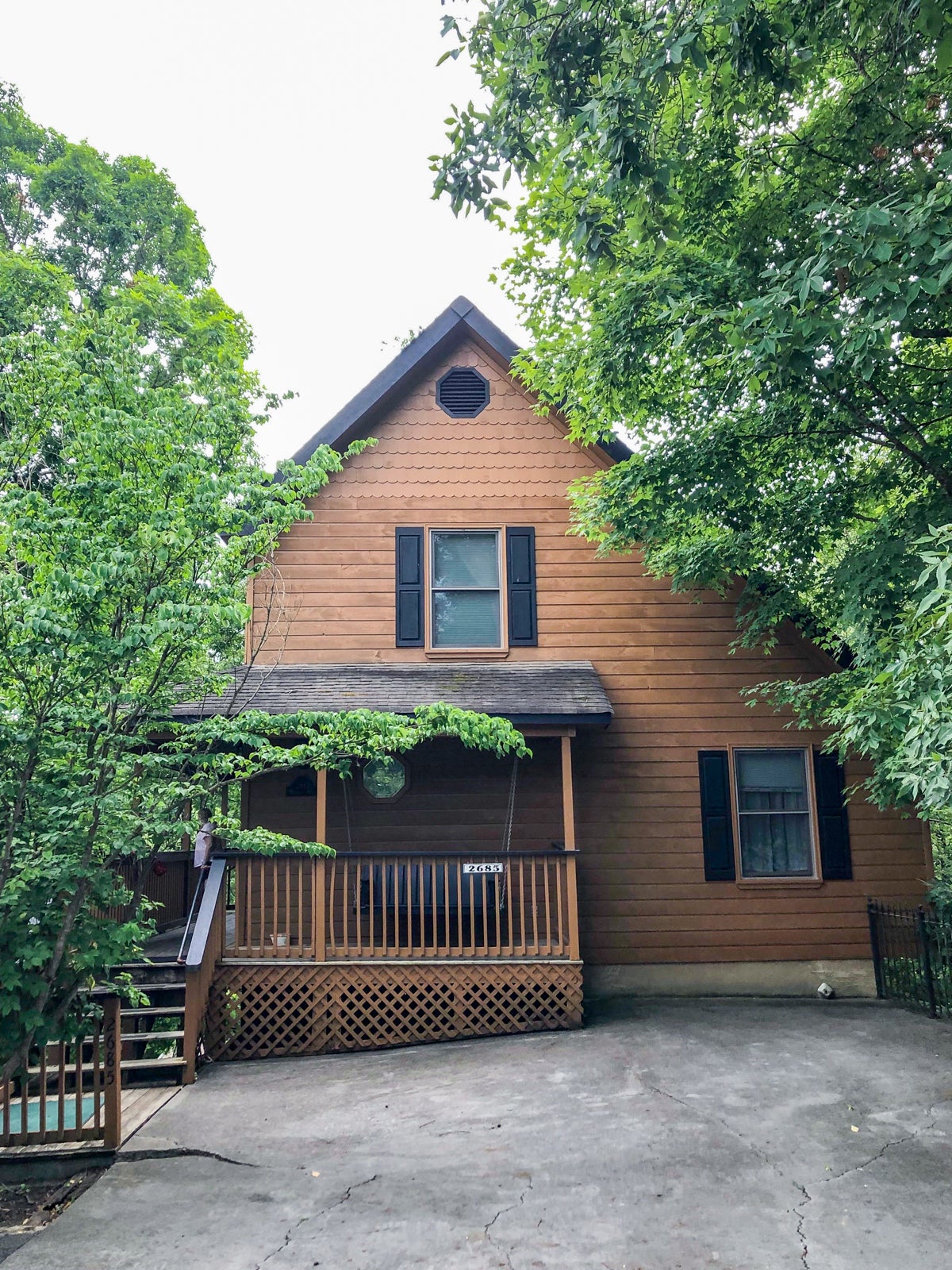
If you're looking to get a little closer to mother nature, the Smokies offer several different options for camping. Make note that most of these areas within the park require reservations in advance.
Backcountry: All backcountry campgrounds in the park require hiking, as well as a permit and reservations.
Frontcountry: Camping closer to your vehicle in front-country campgrounds is available at 10 different spots throughout the park.
Group campgrounds: For groups of seven people or more there are multiple group campgrounds available. These also require advanced reservations.
Horse camps: A unique camping option includes five drive-in horse camps providing ready access to backcountry trails within the park.
Head to the national park's official website for the map of designated camping locations throughout the park.
Blackberry Farm
Arguably the most luxurious accommodations one can experience in the Smoky Mountains, Blackberry Farm , on the Tennessee side of the park in Walland, gives "Southern hospitality" a whole new meaning. Blackberry Farm resort is a James Beard and Southern Living award winner year after year, and for good reason. You'll be hard-pressed to find a more impeccable combination of hospitality, amenities, cuisine, craft brews and wines from around the world. Don't believe us? Check out its impressive list of accolades and start saving for your next getaway. A visit to Blackberry Farm is one you won't soon forget.

Dancing Bear Lodge
In Townsend, Tennessee, also known as "The Peaceful Side of the Smokies," Dancing Bear Lodge is another award-winning resort offering rustic cabins, scenic views and an elevated experience.
LeConte Lodge
The aptly named LeConte Lodge sits atop Mount LeConte , the third tallest peak in the park, and is one of the most distinctive lodging experiences in the Smokies. The only way to get to the lodge is to hike up the mountain via the Alum Cave Trail, which is about a four-hour hike for experienced hikers. If you're looking for a more luxurious experience, this likely isn't it. The lodge is truly back-to-basics. There is no electricity or plumbing, however, there are four flush toilets in outhouses. While the lodge is not points and miles-friendly (no credit cards accepted -- eek!), the service more than makes up for it. One of my close friends, a new mom, visited the lodge with some friends on a girls trip and the staff graciously offered to store her breast milk for her -- a move that made her a loyal fan for life! With some of the most incredible views in all of the national park, it's important to note that reservations are difficult to come by and must be made in October of the previous year.
Asheville, North Carolina
While I'm biased to the Tennessee side of the park, there are a ton of incredible options just over the border in North Carolina as well. Consider a stay in Asheville at the Omni Grove Park Inn -- a personal favorite filled with mountain views and Southern charm (and an incredible spa and golf course to boot!)
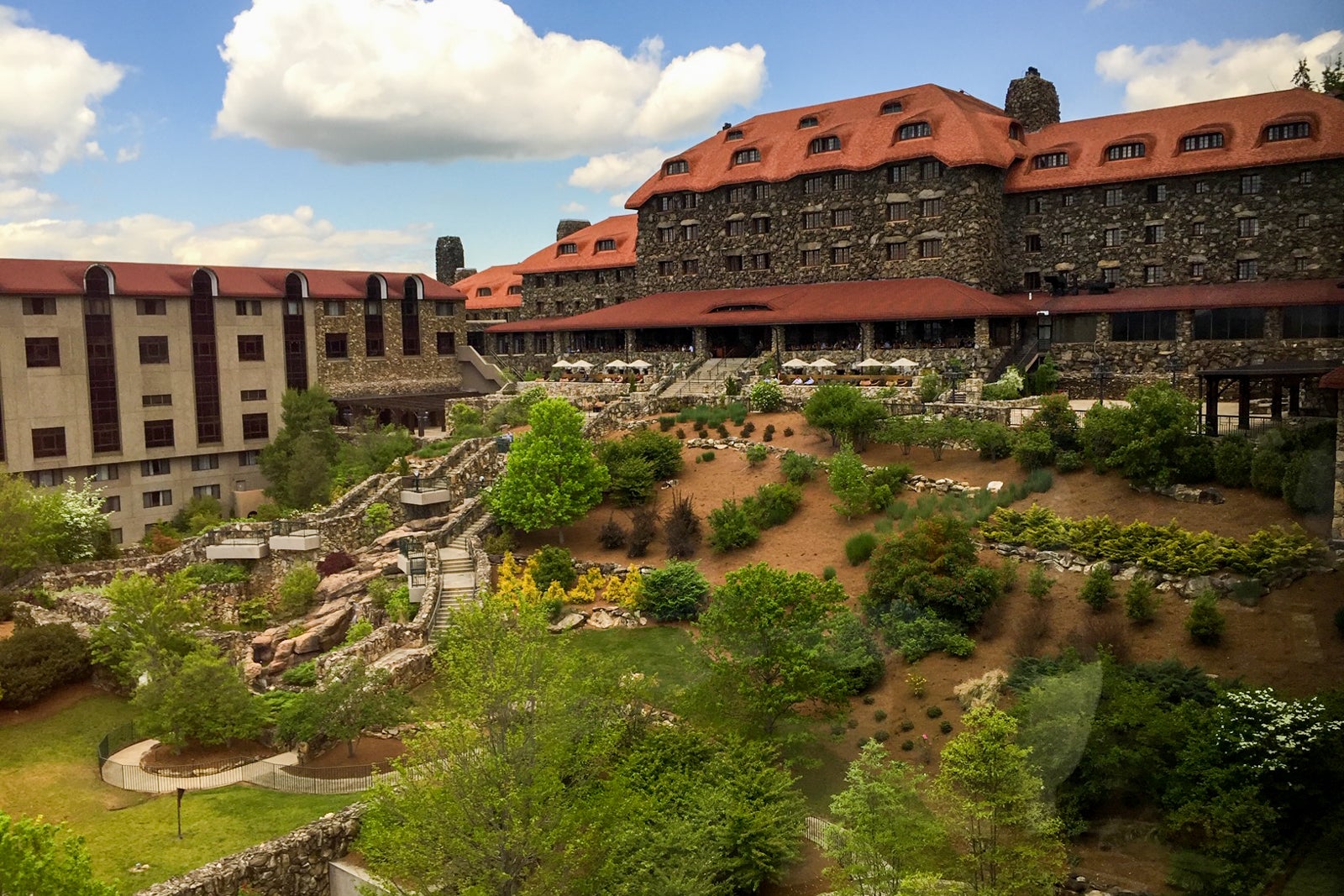
Where to eat
Whether it's shrimp and grits, fried chicken or biscuits and gravy, Southern comfort food fills the senses and just hits differently. There's no better place in the U.S. to find authentic Southern cuisine than at the foothills of the Smoky Mountains. Take note of my favorite spots to feast near the park, but also make sure to swing by a grocery store to pick up picnic fare to pack for your day in the park.
There is no shortage of dining options in Gatlinburg, Sevierville and Pigeon Forge with everything from delicious donut shops, Mexican cantinas, family-owned eateries and lots more! Here are my favorites:
This area is known for having a multitude of pancake houses, and it will seem like there's one on every block, but the most iconic is the Pancake Pantry located on the strip in Gatlinburg. Lines frequently stretch out the door here, so I suggest arriving early and coming hungry.
The Peddler is a rustic, riverfront steakhouse right at the entrance to the park in Gatlinburg and known for its quality and tradition in the area. The restaurant has been around for decades and promises a quality experience for every single patron.
The Apple Barn & Cider Mill , right off the Parkway in Sevierville, is a great stop for multi-generational visitors. I have memories of visiting here with my mom and grandmother when I was much younger, eating mouth-watering apple fritters and stocking up on its delicious jams and kinds of butter. It's a must-visit spot for any out-of-towners.
If there are beer connoisseurs in your group, head over the North Carolina border to Asheville. The city boasts more breweries per capita than any other city in the U.S., including Sierra Nevada, New Belgium, Oskar Blues and more than 40 others.
If you're looking for a unique, kitschy experience check out one of the dinner shows that lines the parkway in Pigeon Forge for a truly entertaining and one-of-a-kind dining experience. Dolly Parton's Stampede and the Hatfield & McCoy shows are both unlike anything you'll find elsewhere in the U.S., packed full of cowboys, bluegrass music, corn on the cob and more!
How to get there
The closest airports to the Smokies are McGhee Tyson Airport in Knoxville on the Tennessee side of the park and Asheville Regional Airport in North Carolina. McGhee Tyson is about 30 minutes to an hour's drive away from the park, depending on where you want to enter. Knoxville is at the crossroads of two major interstates - I40 and I75, which makes it an easy drive from many major cities in the Eastern U.S. The Asheville airport is about an hour's drive away from the park and will bring you in on the east side near Maggie Valley and Cataloochee.
Getting around
The Smokies are very car-friendly and fairly easy to navigate by automobile. With plenty of car rental options at the airports and around town, renting a car is probably your best bet.
As mentioned above, the area is also a hot destination for motorcyclists, with scenic views around each turn of the Blue Ridge Parkway. Be sure to do your research in advance for any restrictions on where you can or can't ride.
The city of Gatlinburg offers trolley service that will pick you up or drop you off at more than 100 different locations around the area, including Dollywood and the national park itself. Costs, routes and hours vary, so check its website in advance to help plan your trip .
When to visit
While fall is peak season for the Smokies (October typically sees the highest visitation on average each year due to the beautiful fall foliage), there's really not a bad time to visit. June through October are the busiest times, with January and February being the slowest. The area experiences pretty mild winters for the most part, so even planning a trip in November or December would be a great time to take in the sights, and likely find discounted accommodations. Gatlinburg, Pigeon Forge and surrounding areas also have a lot to offer in the winter including the annual Winterfest light festival , Dollywood's Smoky Mountain Christmas and more! Just keep in mind that some trails and roads might be closed from November to March, so be sure to do your research in advance on the national park's official website.
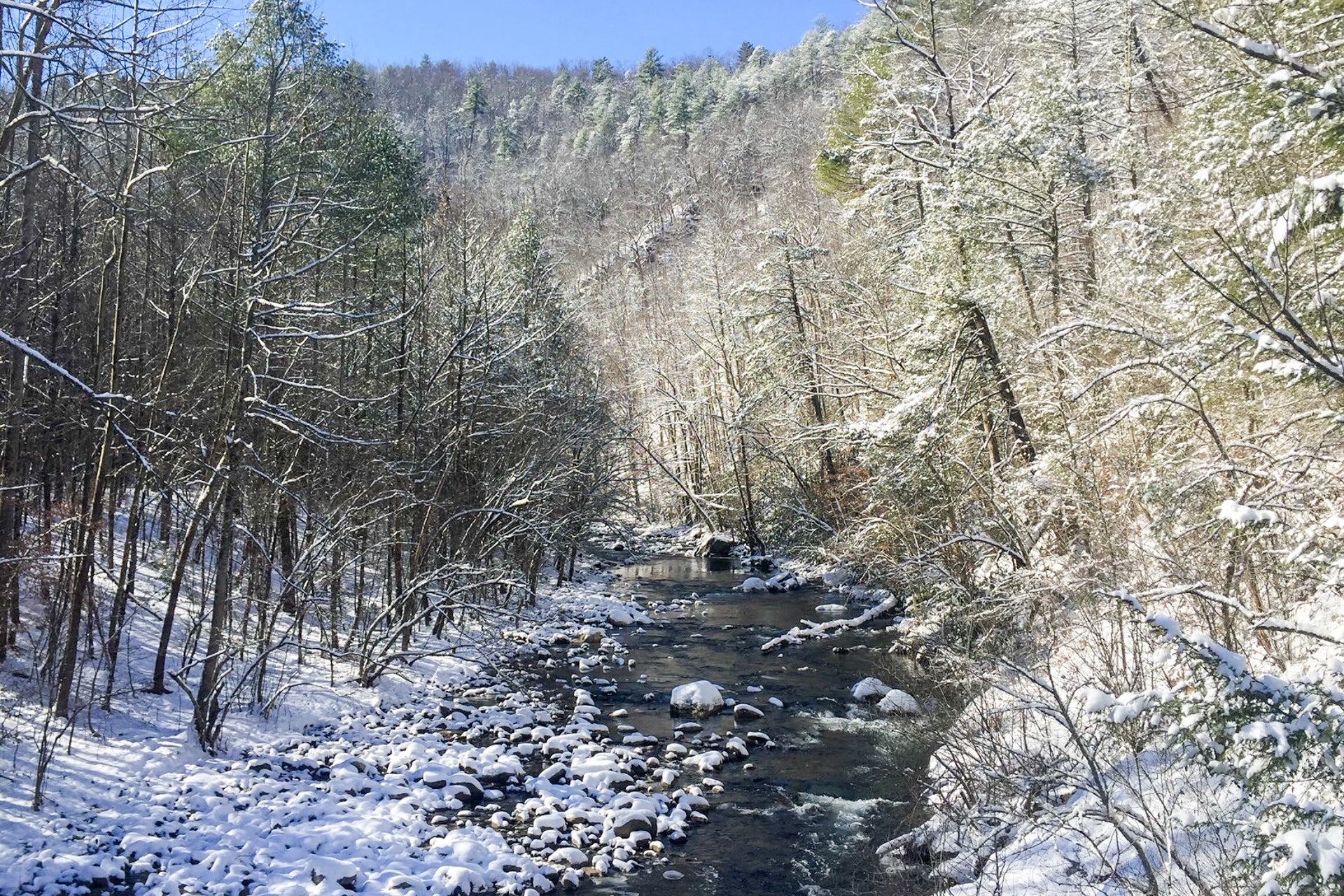
Bottom line
While I may be a little biased as a Tennessee native, the Great Smoky Mountains National Park is somewhere everyone should experience at least once. The truth is there is so much to do and see in the Great Smoky Mountains that we couldn't possibly cover everything here. You'll inevitably find your own favorite off-the-grid trail, scenic overlook, moonshine distiller or pancake eatery that we haven't covered, and when you do, come back here and share it with us so we can add it to our list!
As the most visited national park in the country, it's no secret how much the park and surrounding areas has to offer -- whether it's a family reunion, summer vacation, bachelorette party, destination wedding or just a trip with the guys, the Smokies has something for everyone and they'll have a big ol' glass of sweet tea waiting for ya.
Travel With Me 24 X 7
Travel itinerary, Travel guide and Destination reviews
12 Scenic Drives In Great Smoky Mountains (With Maps + Stopovers)
Great Smoky Mountains is the most visited National Park in the USA, and if you are planning for it, read some of the best scenic drives in Great Smoky Mountains. Most of these scenic drives are unique romantic getaways in Tennessee .

Scenic Drives In Great Smoky Mountains (Great Smoky Mountains Road Trip)
The Great Smoky Mountains border North Carolina and Tennessee with half a million acres of nature landscape covering splendid valleys, huge forests, cool mountain streams, cascading waterfalls, and vast mountain peaks has so many scenic drives too. So read about some of the best scenic drives in Great Smoky Mountains with their highlights and scenic stopovers.
- 7 Best Scenic Drives In Florida (With Scenic Stops + Maps)
- 7 Best California Scenic Drives – Beautiful Road Trips In California

Newfound Gap Road (US-441)
- Total Drive/Miles – 29.2 miles one way (58.4 miles round trip)
- Start and End Point – Between Cherokee and Gatlinburg. This scenic drive in the Smoky Mountains starts at the Sugarlands Visitor Center and ends at the Mountain Farm Museum in North Carolina.
- Scenic Stopovers – Chimney Tops , Campbell Overlook, with amazing views of Mount LeConte, Newfound Gap, Rockefeller Memorial, Morton’s Gap Overlook, Clingmans Dome Road, Oconaluftee Valley Overlook, and Mingus Mill are some of the scenic stopovers on Newfound Gap Road in the Great Smoky Mountains.
Best Newfound Gap Road Trip Itinerary – Newfound Gap Scenic Drive, Trails, Campgrounds

About: This scenic road runs from Gatlinburg, Tennessee, to Cherokee, North Carolina, and crosses the park, offering stunning views of the Smoky Mountains. It is a popular spot for sightseeing, with several vistas/overlooks along the way, including the popular Newfound Gap Overlook. This Overlook offers panoramic views of the Smokies and the surrounding landscape. The beauty of these mountain ranges is the fog coming out from the peak of the mountains, and it looks like the mountain are smoking(pun).
This drive tops the list of best places to visit in Great Smoky mountains.

Clingmans Dome Road
- Total Drive/Miles – 7 Miles
- Start and End Point – Turn off Newfound Gap Road 0.1 mile south of Newfound Gap and ends at Clingmans Dome Observation Tower.
- Scenic Stopovers – Indian Gap, The Fraser Fir Forest, Spruce-Fir Nature Trail, Weeping Wall, Secret Tunnel Under Clingmans Dome.

About – This scenic drive takes you to the highest point in the Great Smoky Mountains National Park, the summit of Clingmans Dome. The 7-mile drive offers breathtaking views of the surrounding mountains and valleys, and if you are lucky, then can spot wildlife such as black bears and wild turkeys. You can take a short hike to the observation tower at the summit for panoramic views of the valley, mountains, and scenic landscape.
Roaring Fork Motor Nature Trail
- Total Drive/Miles – 5.5 Miles
- Start and End Point – This trail starts at the Cherokee Orchard entrance, forms a loop, and ends at Gatlinburg, Tn.
- Scenic Stopovers – This trail is famous for its impressive waterfalls in Gatlinburg, Tn. Look out for Rainbow Falls, Baskins Creek Falls, Grotto Falls, and Place of a Thousand Drips. Also, you will spot the historic mountainous home of Noah “Bud” Ogle Homestead.

About – This Smoky Mountains drive is a 5.5-mile loop road that winds through the National park’s lush forests, stunning waterfalls, and rushing streams is famous for its fantastic mountainous scenery. This loop is narrow; hence, only cars are allowed on this drive. In winter, this trail is closed due to the closure of roads.

Cades Cove Loop Road
- Total Drive/Miles – 11 Miles
- Start and End Point – You can start from these three start points – Laurel Creek Road, Parson Branch Road, or Rich Mountain Road (the last two roads are closed in winter). It is a way loop road that starts from Gatlinburg or Pigeon Forge. In between, you can exit towards Townsend direction if you do not want to go back to start.
- Scenic Stopovers – Best stopovers on this scenic drive is Oliver Cabin, Primitive Baptist Church, Methodist Church, Elijah Oliver Place, Abrams Falls, Cable Mill, Carter Shields Cabin, Becky Cable House Historical Structure, Riding Stables with Ranger Station, and many walkable trails too.
This scenic drive gives you an experience of rural mountainous life in the broad Cades Cove Valley, surrounded by stunning mountains. You can see farm animals initially and then be followed by historic homes. You can spot deer and bears in a lush green forest deep inside. The drive is narrow, and hence drive carefully.

TIP : On Wednesday, this drive is closed to motorists, and only bike riders and hikers can enjoy nature on foot.
The Little River Road

- Total Drive/Miles – 22 Miles
- Start and End Point – It starts from Sugarlands visitor center near Gatlinburg and ends at Cades Cove. It is also known as Laurel Creek Road.
- Scenic Stopovers – Maloney Point, Laurel Falls trail, Elkmont, Metcalf Bottoms, The Sinks, Meigs Falls, and Townsend “Y”, historic Little Greenbrier school, and Walker sisters’ cabin.

This scenic drive takes you along the Little River, past cascading waterfalls, picnic grounds, and narrow streams passing by your side. This drive is on low elevation; hence, you will not see giant Smoky mountains, but you will pass through scenic lush green forests, cascaded streams, and campgrounds.
Heintooga Round Bottom Road
- Total Drive/Miles – 14 Mile
- Start and End Point – It starts at the Blue Ridge Parkway at Milepost 458.2 and ends at Big Cove Road north of Cherokee.
- Scenic Stopovers – Heintooga Overlook, Balsam Mountain Campground, Flat Creek hiking trail, Palmer Creek Trail, Beech Gap Trail.

About – This scenic drive takes you through a remote mountainous region on an unpaved gravel road with beautiful views of the mountains and valleys. This drive is famous for its scenic beauty and opportunities to see wildlife such as elk, bears, and wild turkeys. You will start this curvy drive from an altitude of 5,535 feet and descends to about 2,000 feet.
This drive is one of the best places to visit in Great Smoky Mountains to experience wild rugged mountains with amazing wildlife.
Tip – The drive is one way on an unpaved road and a purely rustic car hike. Therefore be cautious about surprises and adventures in this scenic drive.
Note: This scenic drive in Smoky mountains is open from late May through October.
Foothills Parkway
- Total Drive/Miles – 33 Miles
- Start and End Point – Drive from US 129 to US 321 in Tennessee across the Little Tennesse river. You can start from Walland, TN, and end in Chilhowee, TN, or Sevierville, TN.
- Scenic Stopovers – Caylor Gap Overlook , Look Rock Picnic Area(highest point on Chilhowee Mountain), Great Smoky Mountains Overlook, Emerine Gap Overlook, Maryville Overlook, Gregory Bald Overlook, and Happy Valley Overlook

About – This scenic Smoky Mountains drive offers panoramic views of the Smoky Mountains and the surrounding landscape, with several overlooks and picnic areas along the way. This drive is top-rated in the spring and fall when the wildflowers and foliage bloom.

Tail Of The Dragon – US 129 Drive
- Total Drive/Miles – 11 Miles with 318 Curves
- Start and End Point – It starts from Foothills Parkway and US 129, Chilhowee, TN, and ends at Deals Gap, NC.
- Scenic Stopovers – Robbinsville and Fontana Dam when you start. As this road is known for its beautiful adventure drive, it is best to do it non-stop; therefore, when this drive begins, there are no vista points. If your vehicle needs rest, there are some rest areas, but no scenic overlooks after you start the loop. You can relax at Deals Gap Motorcycle Resort when you finish the drive.
About – This is the most adventurous drive for bikers in the US, with 318 curves on an 11-mile stretch within a forest backdrop. Not only bikers, cars to enjoy the curvy adventure here, and so it is one of the world-famous roads for biking and adventure driving. So the highlights of this drive are turns, twists, and tall trees.
The Blue Ridge Parkway

- Total Drive/Miles – The route is 469 Miles from Virginia to North Carolina, with two national parks on the road.
- Start and End Point – It starts from Rockfish Gap, VA, and ends at Cherokee, NC. You can also do this from Gatlinburg or Pigeon Forge while staying in the Great Smoky mountains range.
- Scenic Stopovers (Gatlinburg – Blue Ridge Parkway Drive) – Mount Pisgah, Julian Price Memorial Park, Fox Hunter’s Paradise where, Ridge Junction Overlook, View Devil’s Courthouse, Waterrock Knob( where you can view the Appalachians and the Smokies at the same spot) and many more stopovers.
- 8 Best Hikes In Blue Ridge Parkway With Campgrounds
About – The Blue Ridge Parkway links Shenandoah National Park to the Great Smoky Mountains National Park with an enchanting view of the Appalachian Mountains in the United States. Technically this scenic drive does not belong to the Smoky mountains but is a beautiful drive to reach the Smoky mountains from Shenandoah. So if you are driving to the Smoky Mountains, this route will be more scenic.
The Blue Ridge Parkway is one of the most iconic drives of the US and hence must be included in your scenic drives in Great smoky mountain. It is in the list of top 10 scenic drives in the USA. If you cannot drive for so long, do a little to get the feel of this fantastic drive in the USA.
Big Creek To Cataloochee Valley Drive
- Total Drive/Miles – 12 Miles
- Start and End Point – Big Creek campground and ends at Cataloochee valley.
- Scenic Stopovers – You can enjoy the attractions at Cataloochee valley, and there is not much to do in between the drive.
About – This historic valley offers a scenic drive through rolling hills, past old homesteads, cabins, and barns, and opportunities to see native wildlife such as elk.

Note: The road is narrow and unpaved; you need a 4×4 drive. Many times this road is closed due to obstacles. So be careful if you are taking this scenic drive.
Rich Mountain Road – Places To Visit In Great Smoky Mountains
- Total Drive/Miles – 7 Miles One way
- Start and End Point – It starts at Cades Cove and ends at Townsend, Tn, with turns and twists.
- Scenic Stopovers – view of the Primitive Baptist Church and many sudden encounters with wildlife.

About – This scenic drive goes through the one-way path on the gravel road with quiet forest surroundings. This laid-back drive is perfect for a picturesque, peaceful experience and to escape the crowd of Cades Cove. If you start this drive, you can return as it is a narrow one-way drive. So fuel your car to complete and be sure to take this drive. In winter, this drive remains closed. Also, you will encounter much wildlife while driving, so do not disturb them or act wildly.
Upper Tremont Road – Smoky Mountains Drive
- Total Drive/Miles – 8 Miles Round Trip
- Start and End Point – Pigeon Forge, TN
- Scenic Stopovers –

About – A secret drive in the forest with an unpaved road. This drive is famous in the fall time due to fantastic foliage colors. This drive is a hidden gem in The Great Smoky Mountains National Park.
Where To stay in the Smoky Mountains – Things To Do In Great Smoky Mountains
- Pigeon Forge .
- Gatlinburg .
- Sevierville .
- Wear Valley .
General Guidelines – Scenic Drives In Great Smoky Mountains
- Fuel up your vehicle whenever you go for these mountainous drives, as sometimes you do not find any gas stations or help.

- Check road closures on official websites or GPS warnings before you start, as these drives are open in the specific season due to natural obstacles.
- For many unpaved drives, you need to drive a 4×4 vehicle; on some of them, RVs and trucks are not allowed.
- Carry food and water with you, as often you do not find any restaurant or eating zones in between.
- It isn’t easy to get Online GPS signals in mountain regions. So download offline maps before you start, as they help navigate when there are no signals.
- Try to cover up your drive before sunset as in the dark, driving in mountains and forests is a little dangerous.
- Spring, summer, and Fall are the best time to visit the Great Smoky Mountains drive.
Where To Stay In Smoky Mountains – Gatlinburg Hotel Video Tour
Now you know some of the best places to visit in Great Smoky mountains. I hope you loved reading about scenic drives in Smoky Mountains National Park or Smoky mountains drive with their highlights.
Read More – USA Scenic Drives
- Best Scenic Drives In Napa Valley (Itinerary + Things To Do)
- Perfect LA to San Francisco Road Trip Itinerary 8 – 10 Days
- Perfect East Coast Road Trip Planner USA
- Places To Visit Near Las Vegas By Car – Day Trips From Las Vegas
- One Day in Yosemite – Yosemite 1 Day Itinerary
- Best San Francisco To LA Road Trip Itinerary
Follow my blog at
Facebook Twitter Instagram Pinterest
All content belong to travelwithme247blog(dot)com and use of content/photos without permission would result in legal action.
DISCLAIMER – The blog’s content is solely my views of a place or a thing. This is not to offend any class, religion, ethnicity, or nation. My views can change from time to time. This blog may contain some advertisements or links to commercial products, so this site is not responsible after you click those advertisements.
There can be slight differences in distances, locations, or some details for which I (owner) am not responsible. This post may contain some affiliate links, which means at no additional cost to you. I will earn if you will click through affiliates and make a purchase
Share this:
- Click to share on Telegram (Opens in new window)
- Click to share on Reddit (Opens in new window)
- Click to share on Twitter (Opens in new window)
- Click to share on WhatsApp (Opens in new window)
- Click to email a link to a friend (Opens in new window)
- Click to share on LinkedIn (Opens in new window)
- Click to print (Opens in new window)
- Click to share on Facebook (Opens in new window)
- Click to share on Flipboard (Opens in new window)
- Click to share on Pinterest (Opens in new window)
Leave a Reply Cancel reply
This site uses Akismet to reduce spam. Learn how your comment data is processed .
Discover more from Travel With Me 24 X 7
Subscribe now to keep reading and get access to the full archive.
Type your email…
Continue reading
2-FOR-1 GA TICKETS WITH OUTSIDE+
Don’t miss Thundercat, Fleet Foxes, and more at the Outside Festival.
GET TICKETS
BEST WEEK EVER
Try out unlimited access with 7 days of Outside+ for free.
Start Your Free Trial
Powered by Outside
5 Best Road Trips
Getting there can be as fun as the park itself. Enjoy these scenic drives and road trips to Great Smoky Mountains National Park and other spots in Tennessee and North Carolina.
>", "path": "https://www.mysmokymountainpark.com/road-trips/road-trip-itineraries/atlanta-to-great-smoky-mountains-road-trip/", "listing_type": "category", "location": "list", "title": "Atlanta to Great Smoky Mountains Loop Road Trip"}}'> Atlanta to Great Smoky Mountains Loop Road Trip
>", "path": "https://www.mysmokymountainpark.com/road-trips/road-trip-itineraries/blue-ridge-parkway-road-trip/", "listing_type": "category", "location": "list", "title": "blue ridge parkway road trip from shenandoah to great smoky"}}'> blue ridge parkway road trip from shenandoah to great smoky, >", "path": "https://www.mysmokymountainpark.com/road-trips/road-trip-itineraries/charlotte-asheville-smoky-mountains-road-trip/", "listing_type": "category", "location": "list", "title": "charlotte to asheville to great smoky mountains loop road trip"}}'> charlotte to asheville to great smoky mountains loop road trip, >", "path": "https://www.mysmokymountainpark.com/road-trips/road-trip-itineraries/chicago-great-smoky-mountains-road-trip/", "listing_type": "category", "location": "list", "title": "chicago to nashville and great smoky mountains road trip"}}'> chicago to nashville and great smoky mountains road trip, >", "path": "https://www.mysmokymountainpark.com/road-trips/road-trip-itineraries/nashville-knoxville-smoky-road-trip/", "listing_type": "category", "location": "list", "title": "nashville to knoxville to great smoky mountains road trip"}}'> nashville to knoxville to great smoky mountains road trip.

- 1-Day the Great Smoky Mountains National Park Itinerary
Navigate forward to interact with the calendar and select a date. Press the question mark key to get the keyboard shortcuts for changing dates.
Navigate backward to interact with the calendar and select a date. Press the question mark key to get the keyboard shortcuts for changing dates.
- the Great Smoky Mountains National Park in 1 day
- 2-Day the Great Smoky Mountains National Park Itinerary
- 3-Day the Great Smoky Mountains National Park Itinerary
- 4-Day the Great Smoky Mountains National Park Itinerary
- 5-Day the Great Smoky Mountains National Park Itinerary

Table of contents
1-day itinerary, great smoky mountains national park.
Clingmans Dome

Clingmans Dome Visitor Contact Station
Nantahala outdoor center gatlinburg, ober mountain tramway mall, hollywood star cars museum, ripley's believe it or not, where to eat, mellow mushroom gatlinburg, the park grill, luigi's pizza, the melting pot.

Track your travel spending and split costs with friends
Plan your trip. Keep your budget organized. Split the cost between tripmates. Wanderlog does it all.

Popular road trips from Great Smoky Mountains National Park
What's the weather like in the great smoky mountains national park.
It depends on when you visit! We've compiled data from NASA on what the weather is like in the Great Smoky Mountains National Park for each month of the year: see the links below for more information.
- Weather in the Great Smoky Mountains National Park in January
- Weather in the Great Smoky Mountains National Park in February
- Weather in the Great Smoky Mountains National Park in March
- Weather in the Great Smoky Mountains National Park in April
- Weather in the Great Smoky Mountains National Park in May
- Weather in the Great Smoky Mountains National Park in June
- Weather in the Great Smoky Mountains National Park in July
- Weather in the Great Smoky Mountains National Park in August
- Weather in the Great Smoky Mountains National Park in September
- Weather in the Great Smoky Mountains National Park in October
- Weather in the Great Smoky Mountains National Park in November
- Weather in the Great Smoky Mountains National Park in December
All road trips from Great Smoky Mountains National Park
- Great Smoky Mountains National Park to New York City drive
- Great Smoky Mountains National Park to Orlando drive
- Great Smoky Mountains National Park to Washington DC drive
- Great Smoky Mountains National Park to Atlanta drive
- Great Smoky Mountains National Park to Nashville drive
- Great Smoky Mountains National Park to Chicago drive
- Great Smoky Mountains National Park to New Orleans drive
- Great Smoky Mountains National Park to Savannah drive
- Great Smoky Mountains National Park to Chattanooga drive
- Great Smoky Mountains National Park to Toronto drive
- Great Smoky Mountains National Park to Charleston drive
- Great Smoky Mountains National Park to Asheville drive
- Great Smoky Mountains National Park to Boston drive
- Great Smoky Mountains National Park to Memphis drive
- Great Smoky Mountains National Park to St. Augustine drive
- Great Smoky Mountains National Park to Louisville drive
- Great Smoky Mountains National Park to Philadelphia drive
- Great Smoky Mountains National Park to Niagara Falls drive
- Great Smoky Mountains National Park to Myrtle Beach drive
- Great Smoky Mountains National Park to Baltimore drive
- Great Smoky Mountains National Park to Saint Louis drive
- Great Smoky Mountains National Park to Charlotte drive
- Great Smoky Mountains National Park to Branson drive
- Great Smoky Mountains National Park to Montreal drive
- Great Smoky Mountains National Park to Miami Beach drive
- Great Smoky Mountains National Park to Cincinnati drive
- Great Smoky Mountains National Park to Greenville drive
- Great Smoky Mountains National Park to Tampa drive
- Great Smoky Mountains National Park to Williamsburg drive
- Great Smoky Mountains National Park to Pittsburgh drive
Explore nearby places
- the Great Smoky Mountains National Park
- Bryson City
- the Wears Valley
- Pigeon Forge
- Nantahala Township
- Fontana Dam
- Sevierville
- the Maggie Valley
- Robbinsville
- Lake Santeetlah
- Chestnut Hill
All related maps of the Great Smoky Mountains National Park
- Map of the Great Smoky Mountains National Park
- Map of Gatlinburg
- Map of Tremont
- Map of Bryson City
- Map of Cherokee
- Map of Whittier
- Map of the Wears Valley
- Map of Almond
- Map of Pigeon Forge
- Map of Townsend
- Map of Nantahala Township
- Map of Dillsboro
- Map of Fontana Dam
- Map of Sylva
- Map of Sevierville
- Map of Walland
- Map of Cosby
- Map of the Maggie Valley
- Map of Robbinsville
- Map of Cullowhee
- Map of Balsam
- Map of Topton
- Map of Lake Santeetlah
- Map of Hartford
- Map of Chestnut Hill
- Map of Seymour
- Map of Franklin
- Map of Kodak
- Map of Tuckasegee
- Map of Maryville
the Great Smoky Mountains National Park throughout the year
- the Great Smoky Mountains National Park in January
- the Great Smoky Mountains National Park in February
- the Great Smoky Mountains National Park in March
- the Great Smoky Mountains National Park in April
- the Great Smoky Mountains National Park in May
- the Great Smoky Mountains National Park in June
- the Great Smoky Mountains National Park in July
- the Great Smoky Mountains National Park in August
- the Great Smoky Mountains National Park in September
- the Great Smoky Mountains National Park in October
- the Great Smoky Mountains National Park in November
- the Great Smoky Mountains National Park in December
Looking for other day-by-day itineraries in the Great Smoky Mountains National Park?
Check out our other curated itineraries that are also filled with jam-packed days:
Day itineraries for nearby cities
- 1-Day Gatlinburg Itinerary
- 1-Day Pigeon Forge Itinerary
- 1-Day Sevierville Itinerary
- 1-Day Franklin Itinerary
- 1-Day Townsend Itinerary
- 1-Day Cosby Itinerary
- 1-Day Kodak Itinerary

- Itinerary + map in one view
- Live collaboration
- Auto-import hotels and reservations
- Optimize your route
- Offline access on mobile
- See time and distance between all your places

How to Spend Three Days in the Great Smoky Mountains
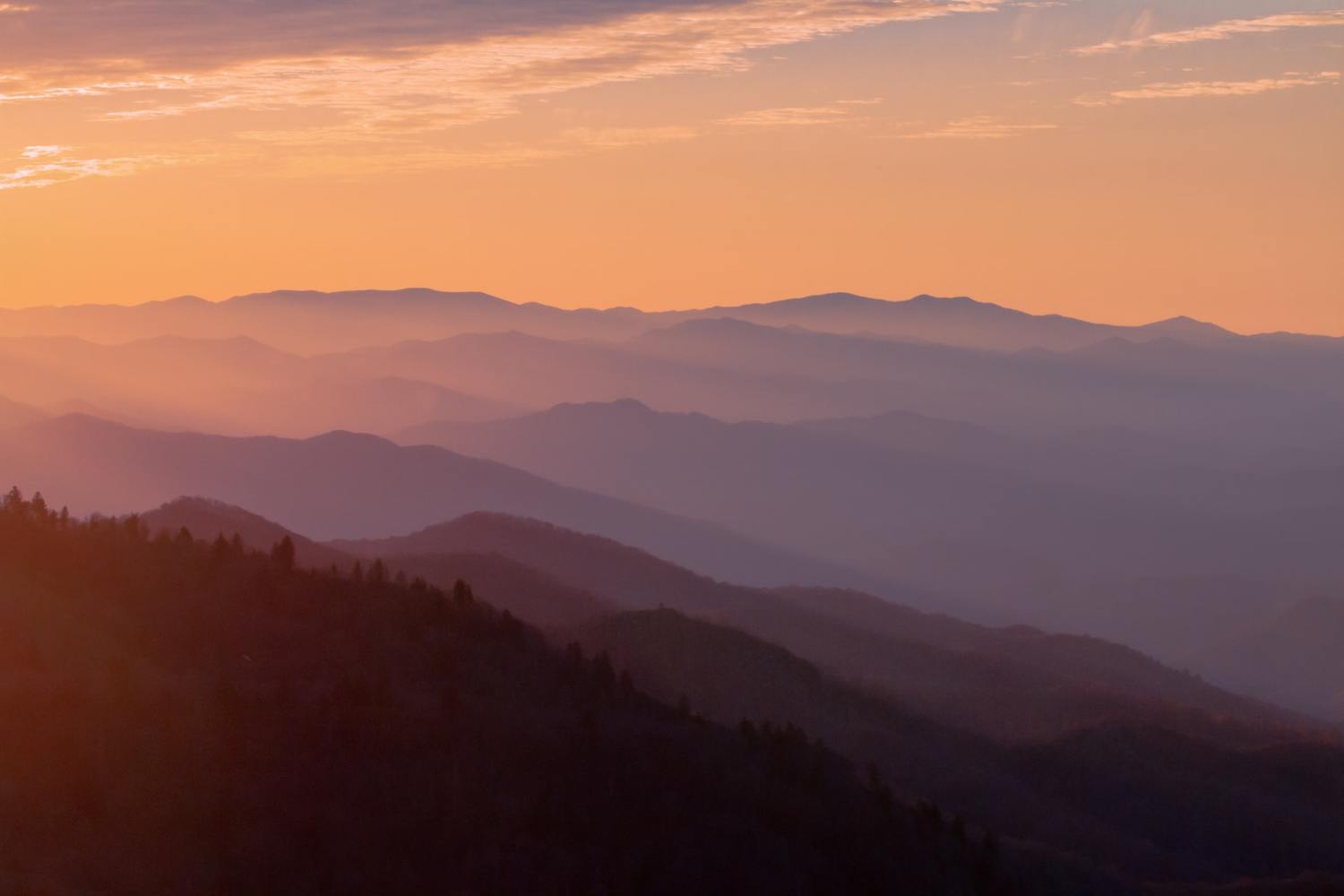
Nestled in a subrange of the Appalachian Mountains, one of only three major mountain ranges in the United States, lies Great Smoky Mountains National Park.
The Cherokee Nation, the original inhabitants of the land, referred to it as the, “Place of blue smoke” and for good reason! The park actually gets its blue haze from the moisture of its waterfalls and rivers interacting with the dense vegetation.
While you may think of parks like Yosemite , Yellowstone , or Zion when you think of national parks, Great Smoky Mountains is actually the most visited national park in the US! This may be due to the park’s lack of entrance fee. Head into the Great Smokies without paying a dime!
Unlike parks such as Yosemite, Great Smoky Mountains has a split “peak season.” Highest visitation rates for the park are mid-June to mid-August as well as the entire month of October. If you’re looking to avoid the crowds, you may have a larger offseason in which to do so than many other parks.
If you’re looking to find solitude while visiting the Great Smokies, the same rules apply as with all other popular parks. Assuming you’re able to, planning a trip during the off-season is your best bet. With the split peak season in this park, September could be a great time to plan a visit! If you only have time during the summer, don’t fret! You can still start your days early and plan ahead to avoid headaches of long lines and short staffs.
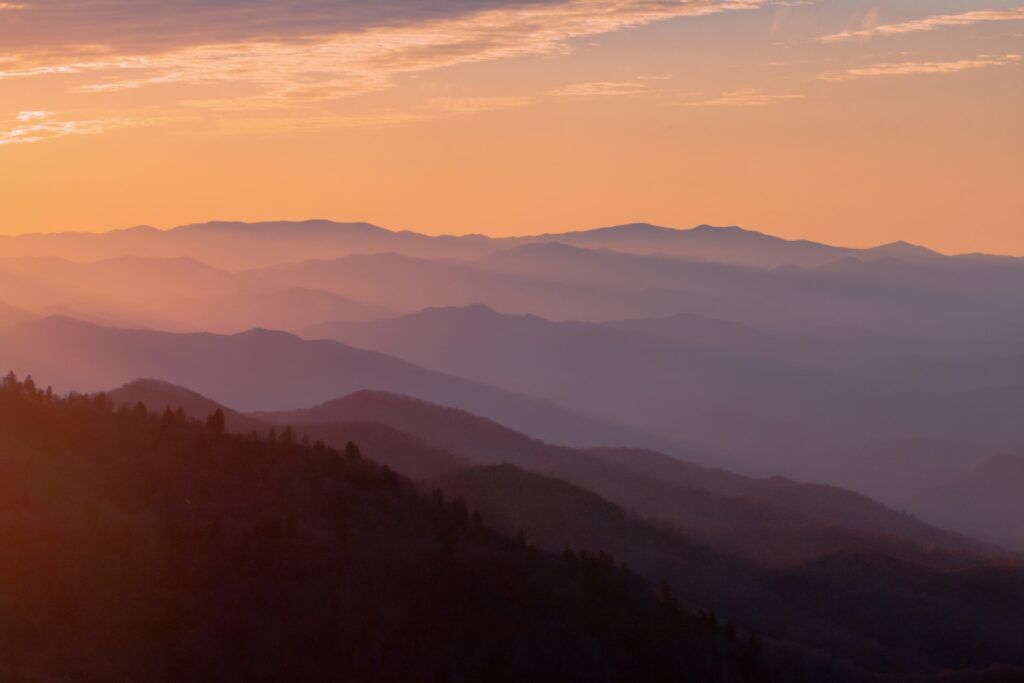
Before Entering the Park
Great Smoky Mountains is open year-round, 24 hours a day (weather permitting). Major roads stay open year-round, however secondary roads close seasonally once fall hits and open back up in the spring. Make sure you check the park’s website for the most up to date information if visiting during the winter!
Major roads close intermittently as, even though the park straddles Tennessee and North Carolina, the higher elevations do get snow throughout the winter months. While lower elevations get a few dustings a year, higher elevations may see as much as five feet annually.
Be especially aware if travelling via US-441, also known as Newfound Gap Road, as that tends to close a double-digit number of times throughout the colder months. During the peak of the summer, there is no daytime lane closures, so you can trade crowds for lack of road delays if you’re an extrovert who hates traffic. Closures are ever-changing, so always check with the park’s website for new announcements.
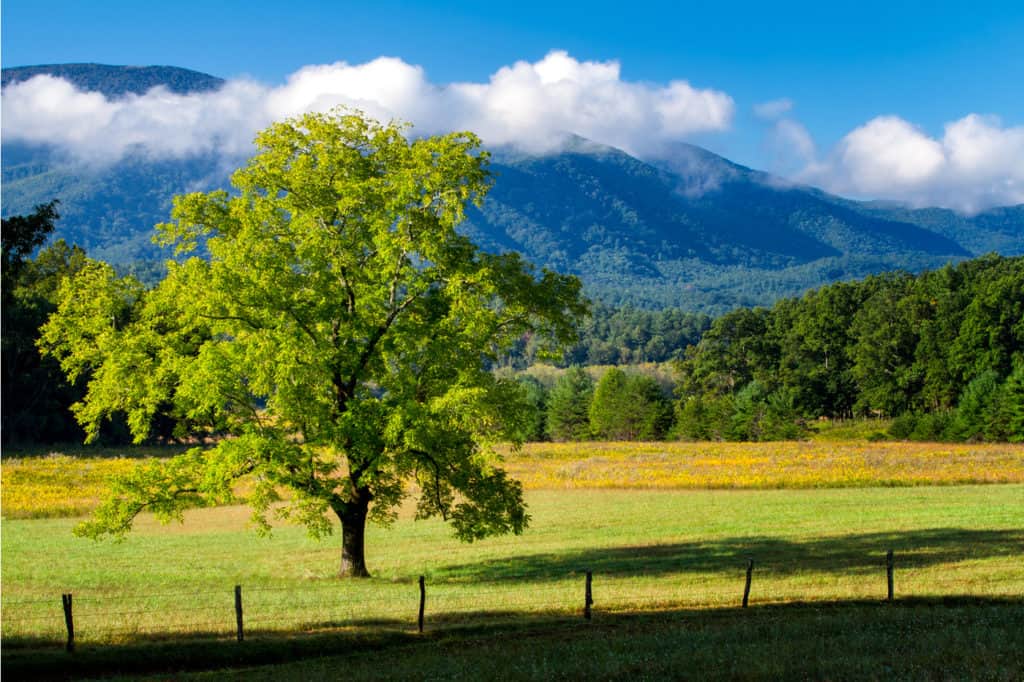
Day One in the Park
Usually, your first day is going to be the most flexible depending on what time you enter the park. If you enter later in the day, you can cut out some of the hikes and just pick the ones that sounds most interesting. Of course, starting in the morning will allow you to experience the full itinerary and take your time while doing it!
Day one is based around the Cades Cove area of Great Smoky Mountains, an idyllic section of the park with interesting historical finds and fun, approachable hikes! This is most convenient if you’re entering from the Townsend, TN entrance . You can also go through the Sugarland entrance, near Gatlinburg , which is the most popular (and crowded) option into the park.
You can of course mix and match the days to your liking, especially if you don’t plan to enter from the north side of the park.
Stop 1: Pine Oak Nature Trail
Length: 0.8 miles Elevation Gain: 203 feet Type: Loop Difficulty: Easy Estimated Time to Complete: 30 minutes
If you’re coming in from the Townsend entrance, this will be easy to find. Follow State Route 73 will take you into the park and become the Townsend Entrance Road. Follow that until the road forks and turn right onto the Laurel Creek Road. From there, just follow the road until you see the Cades Cove Campground area (a conveniently located place to spend the night if you plan to bring out the tents). You’ll find a number of parking lots in the area and will be located near a number of great hikes!
Turn left onto the Cades Cove Campground Entrance Road and take that towards the trail head. You should see a couple of parking areas near the ranger station. Once you’re situated, the Pine Oak Nature Trail is a great way to stretch your legs and start seeing the park!
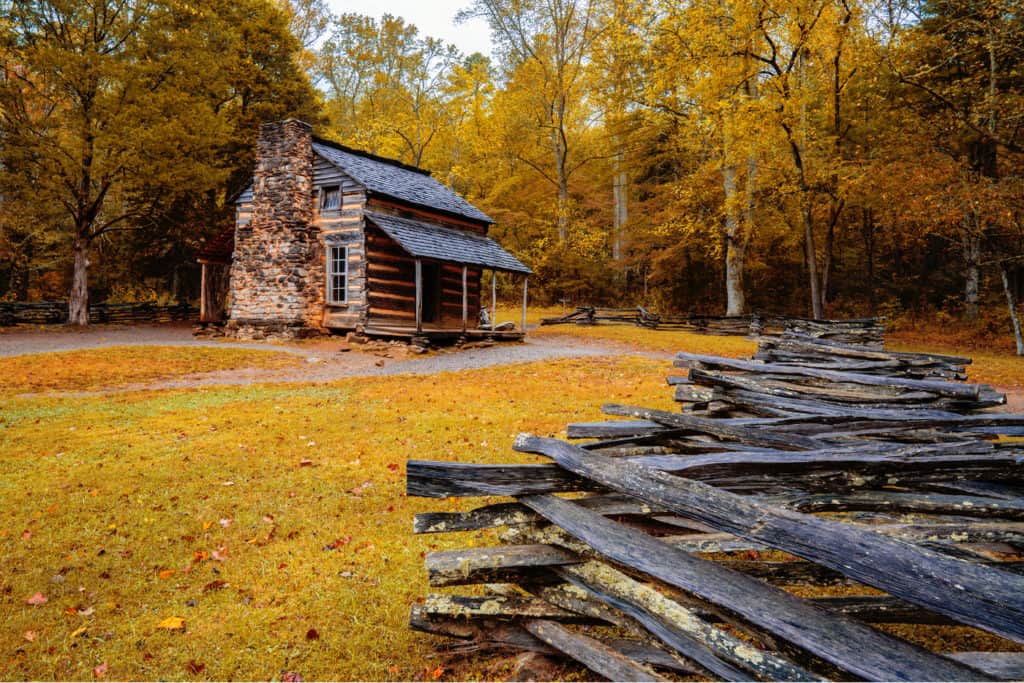
Stop 2: John Oliver Cabin
Length: 0.5 miles Elevation Gain: 39 feet Type: Loop Difficulty: Easy Estimated Time to Complete: 15 minutes
If you’re thinking the late-night TV host from across the pond lived in this cabin, I have some bad news for you. This historical cabin dates back to the 1820s and is an easy half mile loop trail. Parking is conveniently located at the trailhead and there are informational signs by the cabin if you’re interested in learning about a part of the park’s history!
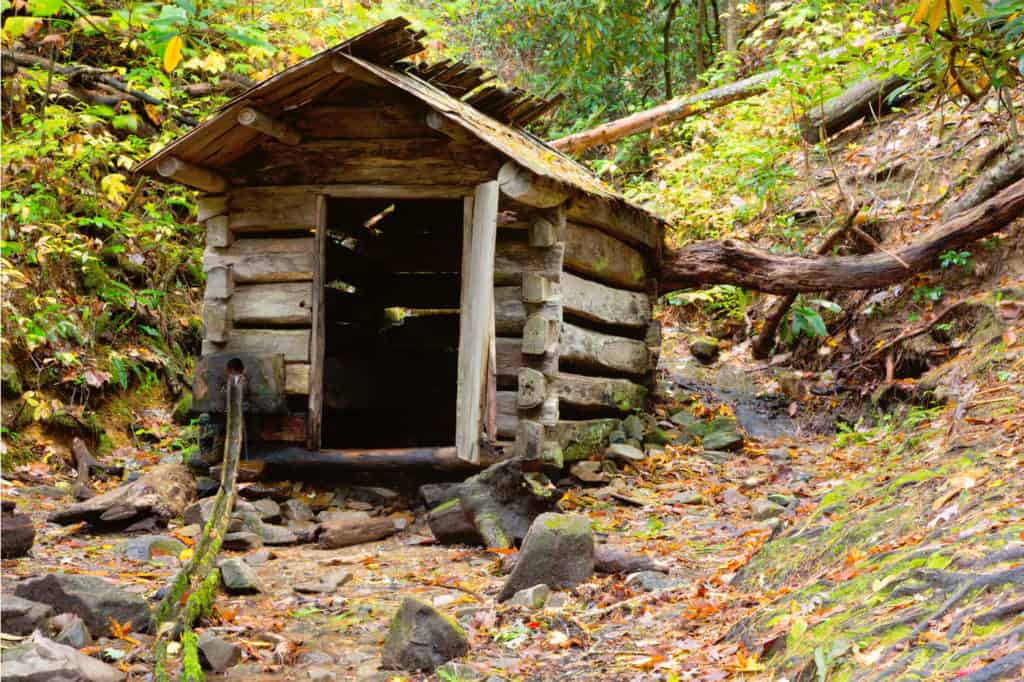
Stop 3: Elijah Oliver Place Trail
Length: 1.2 miles Elevation Gain: 98 feet Type: Out and Back Difficulty: Easy Estimated Time to Complete: 30 minutes
The great thing about Cades Cove is if you follow the Cades Cove Loop Road, you can find some great hikes all in a row and end up back where you started! Convenient whether you’re camping at Cades Cove or heading out of the park to stay in one of the surrounding cities.
Third up is the Elijah Oliver Place Trail. A quick jaunt to some more cabins with a small river crossing, this is an approachable hike for all skill levels. While it isn’t incredibly likely you’ll see bears on this hike, Elijah Oliver Place does get reports of bear activity, so just be aware and you’ll be set! There’s a bit of a decline just over half a mile into the trail as you start your return trip, but other than that it’s flat and easy.
Parking is right next to the trailhead in a pull-off, with the trailhead at the far end of the parking area.
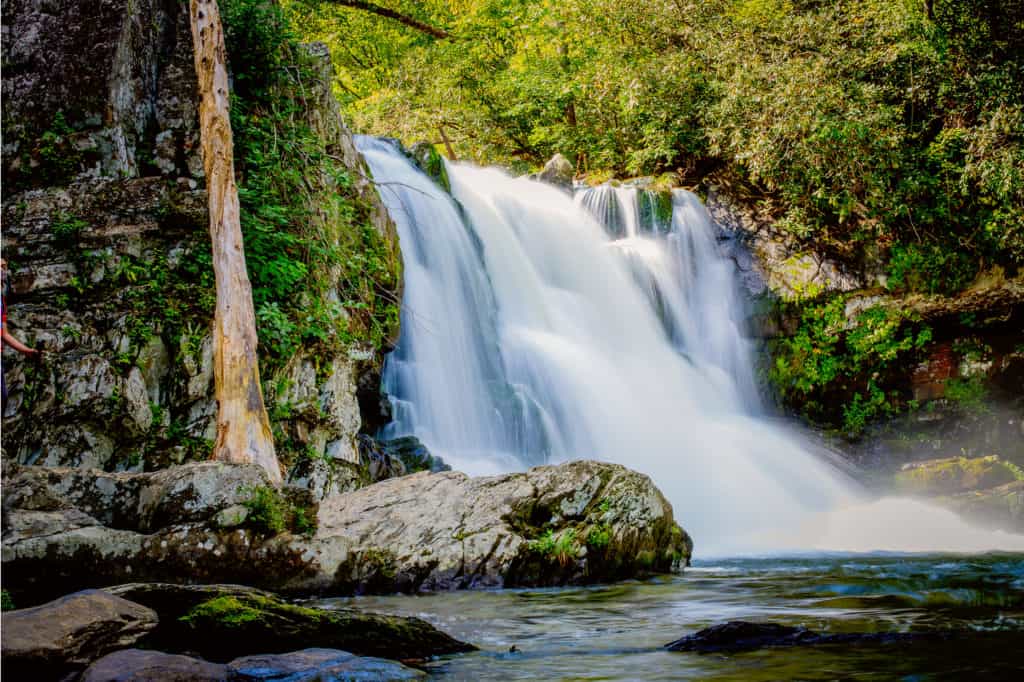
Stop 4: Abrams Falls Trail
Length: 5.5 miles Elevation Gain: 629 feet Type: Out and Back Difficulty: Moderate Estimated Time to Complete: 2.5 hours
Possibly the best hike in Cades Cove, Abrams Falls Trail is an out and back that greets you with a waterfall and an opportunity for a swim! Bring a towel and some flip flops if you want to get into the water (and you definitely do)! While you can hike the trail in around two and a half hours, you’ll definitely want to budget some time to enjoy the waterfalls!
The tenth of a mile or so leading to the falls is a fairly steep downhill and the trek back out, therefore is a decently steep uphill. There are a couple of steep spots early in the trail (and those, of course, become steep descents on the way back), but all of the ups and downs are entirely manageable and shouldn’t put you off!
While this is definitely the most strenuous trail you’ll see on day 1, it is by far the most rewarding as well! Luckily, parking is right by the trailhead after turning onto Abrams Falls Road.
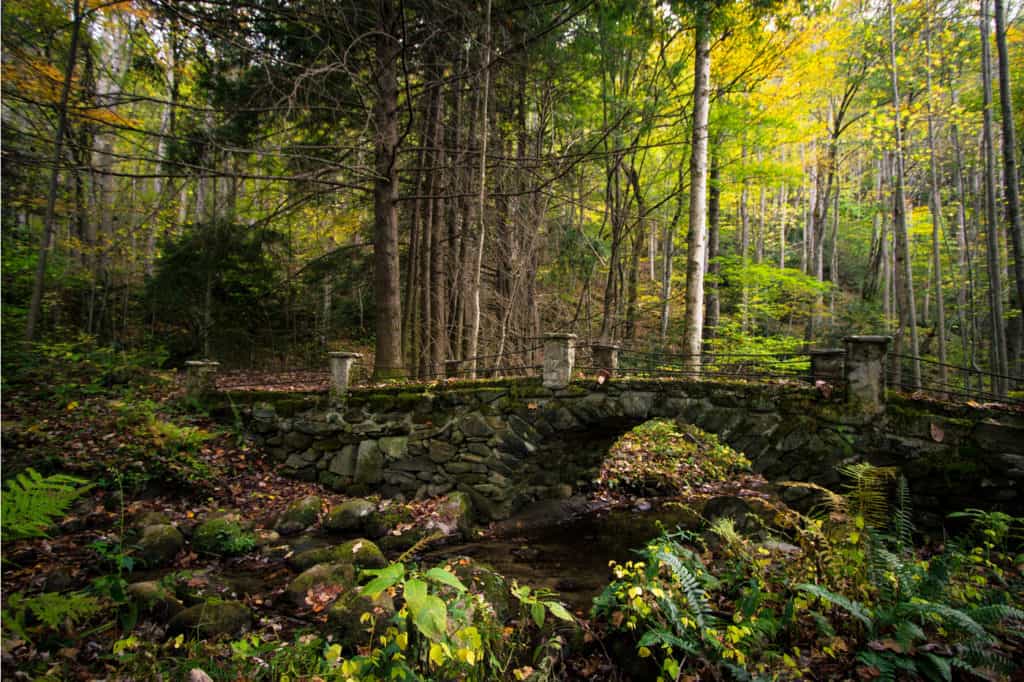
Day Two in the Great Smoky Mountains
Day 2 starts with a drive from Cades Cove to Elkmont. If you decided to camp (and Great Smoky Mountains is a great place to camp), it’ll take you about 45 minutes to get there. If you opted to stay in town, plan accordingly as you’ll need to re-enter the park, most likely through the popular Sugarland entrance.
Elkmont is a former logging community and, you guessed it, former home to many elk. Elkmont is one of the most popular parts of the park and for good reason! It holds the busiest and largest campground area in the entire park with 200 sites available for tents and RVs.
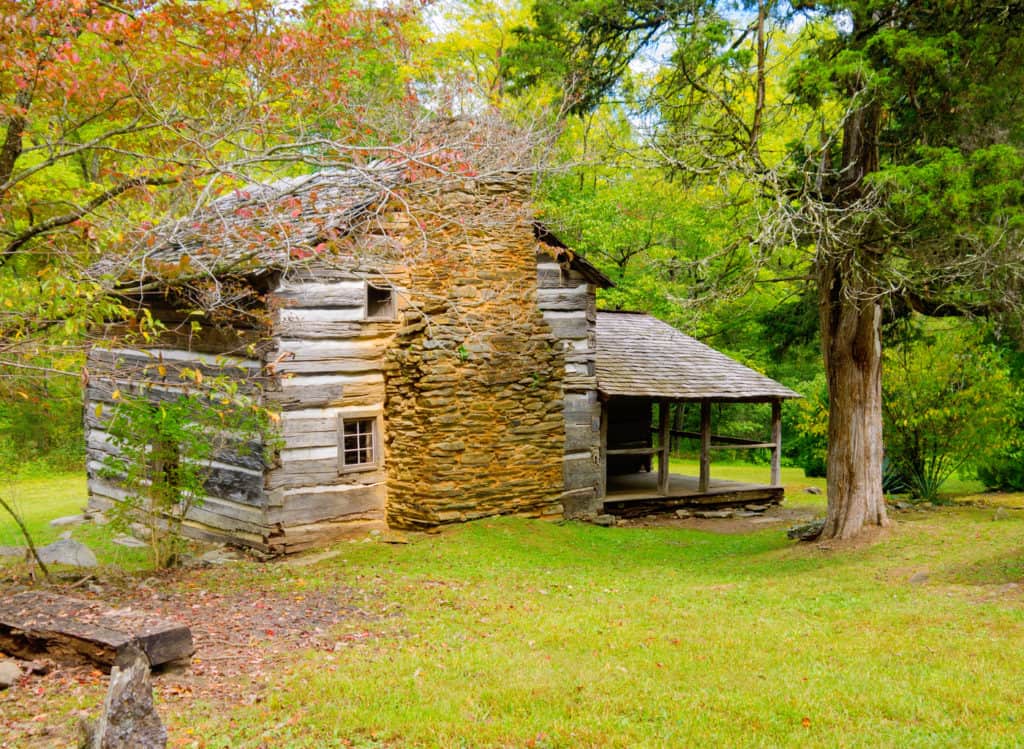
Stop 1: Walker Sisters Home via Little Brier Gap Trail
Length: 4 miles Elevation Gain: 465 feet Type: Out and Back Difficulty: Easy Estimated Time to Complete: 1.5 hours
If coming from Cades Cove, you’ll take Laurel Creek Road back the way you come until it becomes Little River Gorge Road after you pass the fork for the Townsend Entrance Road. Your first stop on day 2 isn’t actually in Elkmont itself, but about halfway between Cades Cove and your destination.
The Walker Sisters Home hike is an easy and pleasant one and will break up the drive if you’ve got impatient passengers! If you start early, you may only have a few other hikers with you. This trail is semi-popular but going early will avoid most other hikers. As may be suggested by the name, you’ll get to experience more of the park’s history with the home and schoolhouse buildings on this trail.
Make sure you look for the Wear Cove Gap Road to turn onto, then turn onto the Metcalf Bottoms Picnic Area Road S. You’ll park in the picnic area and then cross the bridge to get to the trailhead.
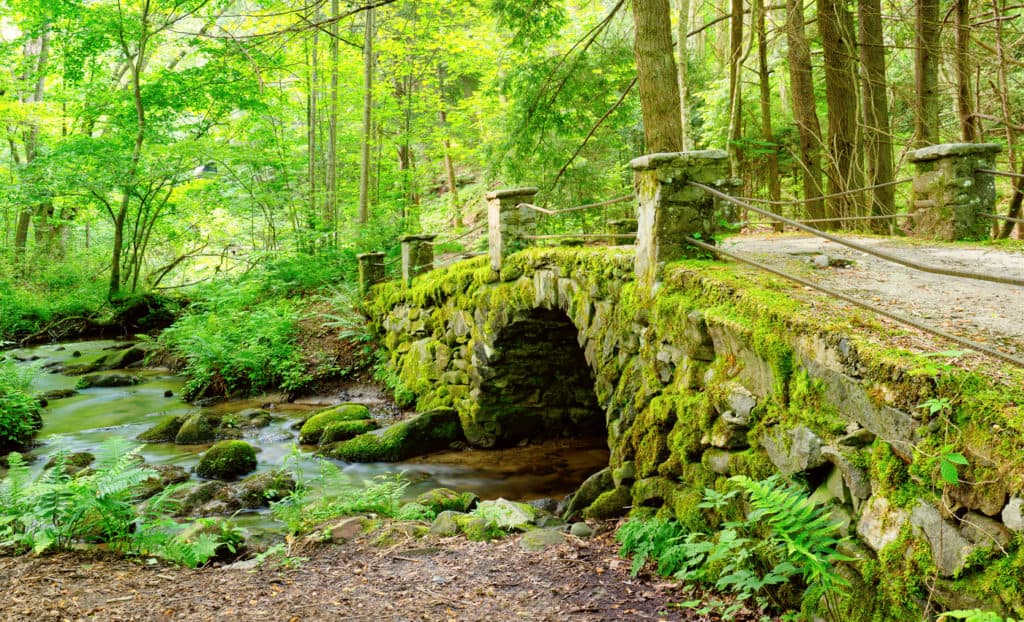
Stop 2: Elkmont Nature Trail
Length: 0.8 miles Elevation Gain: 95 feet Type: Loop Difficulty: Easy Estimated Time to Complete: 30 minutes
If you’re looking for a convenient trail to explore the Elkmont area (or didn’t feel like stopping along the way) then the Elkmont Nature Trail is for you. A simple trail, accessible for all levels of hiking prowess, it’s a great way to start your time at Elkmont.
Since you’re in the campground area, you’ll have plenty of parking options, although there is parking right by the trailhead for the Elkmont Nature Trail.
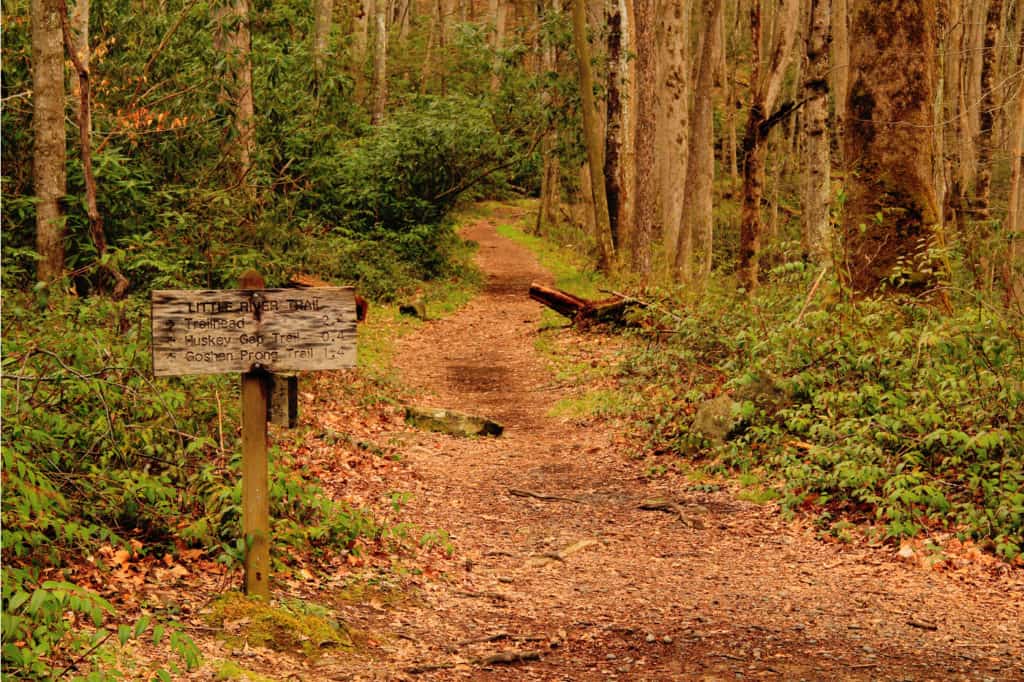
Stop 3: Huskey Branch Falls Trail (or Cucumber Gap and Little River Loop Trail)
Length: 4.7 miles Elevation Gain: 383 feet Type: Out and Back Difficulty: Moderate Estimated Time to Complete: 2 hours and 15 minutes
Just down the Little River Road is Huskey Branch Falls. While not the largest falls by any means, this trek is a relaxing one that is definitely worth your time.
If you get to the turnaround point and feel that you could go a bit further, you can take a sharp turn to your right and follow the Cucumber Gap Trail , adding on roughly three quarters of a mile, but taking about the same amount of time that doing the out and back would, turning the trail into a loop and making it the Cucumber Gap Trail and Little River Loop Trail .
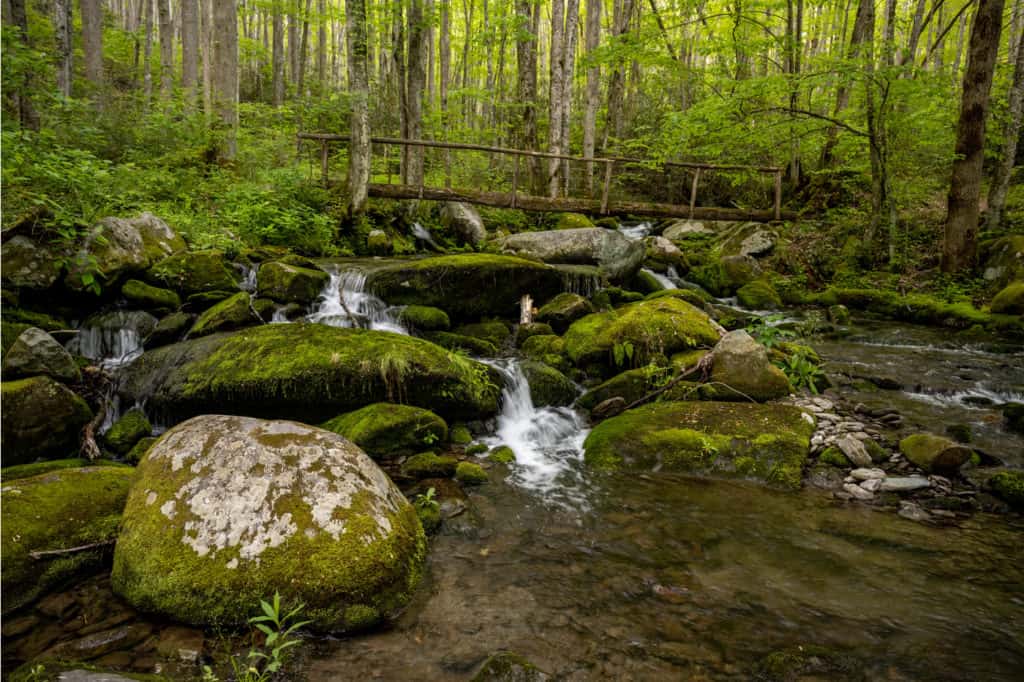
Stop 4: Jakes Creek Trail to Avent Cabin
Length: 2.7 miles Elevation Gain: 482 feet Type: Out and Back Difficulty: Easy Estimated Time to Complete: 1.5 hours
If you have some extra time and energy to spare, the Jakes Creek Trail is a great way to cap off day 2. While it takes an hour and a half or so, being that it’s an out and back, you can always cut it a bit short. However, if you make it to the Avent Cabin, you get an opportunity to put your name in the guest book located in the kitchen! You’ll also be rewarded with some of the Great Smokies’ best forest to walk through!
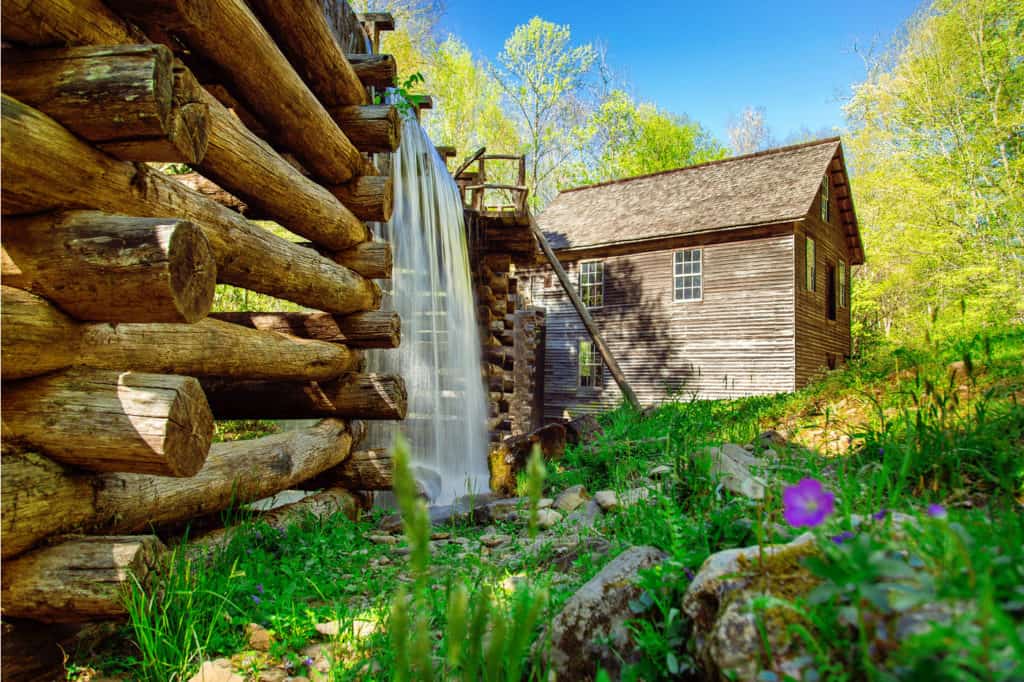
Day Three in the Great Smoky Mountains
If you only have three days to spend in the Great Smokies, the best way to end your trip is by going to Smokemont . With lots of amenities, Smokemont is a great place to use as a base for your last day.
If you’re leaving from Elkmont, take Elkmont Road out of the campground area and make a right onto Fighting Creek Gap Road to head towards Smokemont. Follow this road until you pas the Sugarland Visitors Center and come to a T intersection. Turn right onto US-441 (Newfound Gap Road) and follow that until you reach Smokemont.
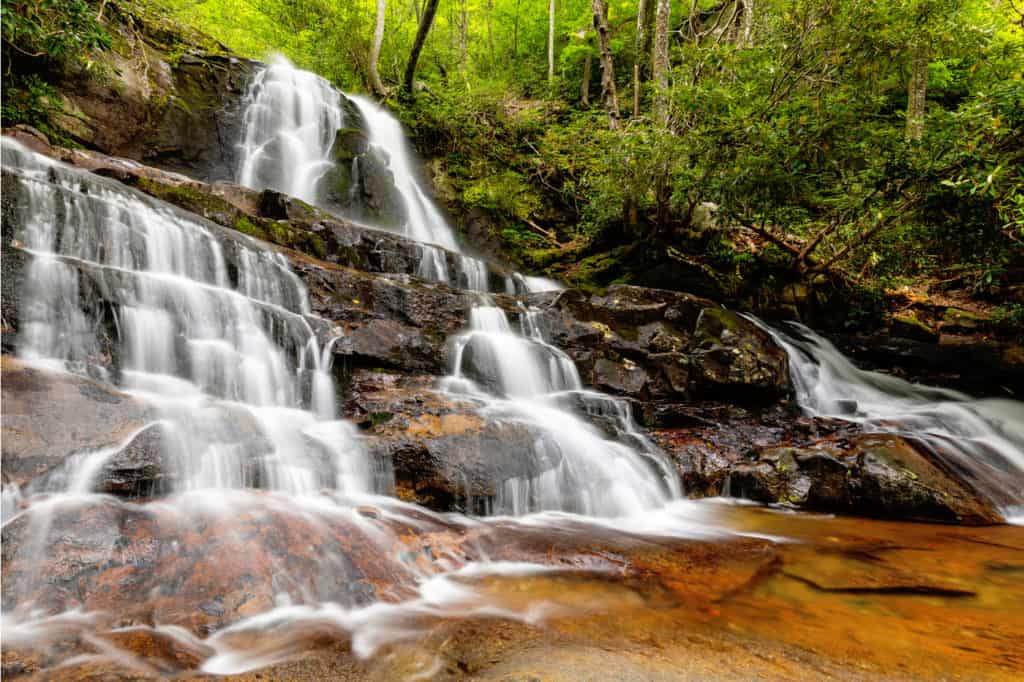
Stop 1: Laurel Falls Trail
Length: 2.4 miles Elevation Gain: 396 feet Type: Out and Back Difficulty: Easy Estimated Time to Complete: 1 hour and 15 minutes
Like yesterday, the first stop is actually before you get to the focus of the day. This one isn’t too far beyond the Elkmont campground, but conveniently located on the way to Smokemont. At just under two and a half miles, it’s a great way to stretch your legs early in the morning. If you don’t have a full day to spend, you can omit this trail and head straight for Smokemont.
If you have the time, this out and back is a gradual uphill and gradual downhill, which should be doable for all hikers. With parking on both sides of the road near the trailhead, you shouldn’t have problems finding a spot, especially if you leave early.
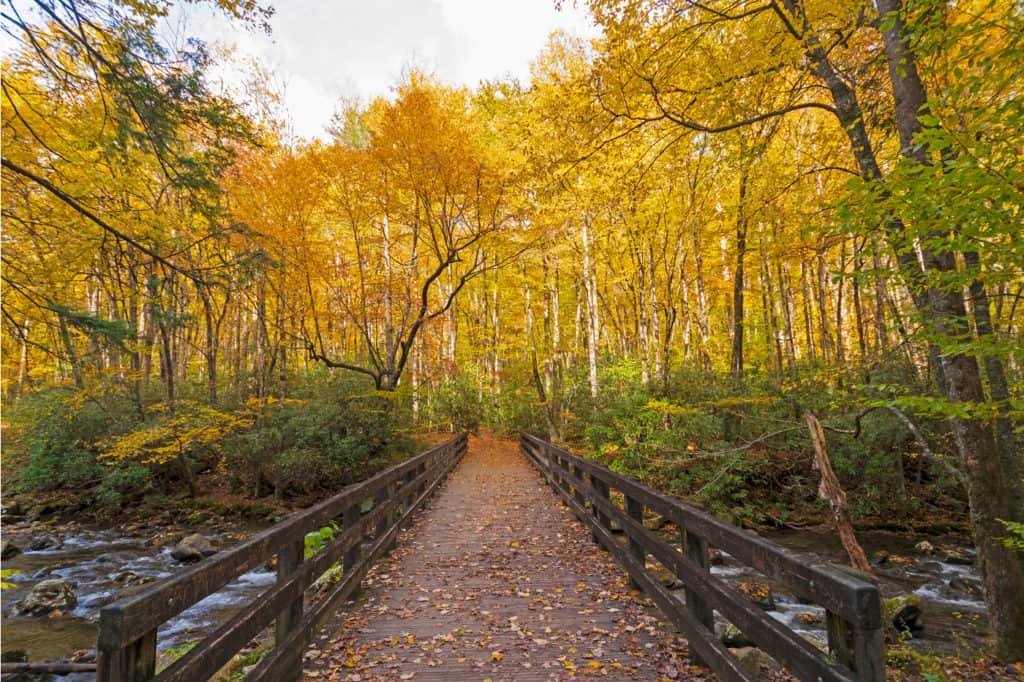
Stop 2: Kephart Shelter via Kephart Prong Trail
Length: 3.9 miles Elevation Gain: 833 feet Type: Out and Back Difficulty: Easy Estimated Time to Complete: 2 hours
Just outside of Smokemont itself is the Kephart Shelter hike. At just under four miles, this hike is good for most all hikers, even those with kids. With a creek beside you throughout, this trail is a lot of fun to explore and promises some great early morning hiking. It is a quite popular trail, so you may want to pick this or the Laurel Falls Trail if you’re short on time. As with many other Great Smoky Mountains trails, this one has parking on both sides of the trailhead.
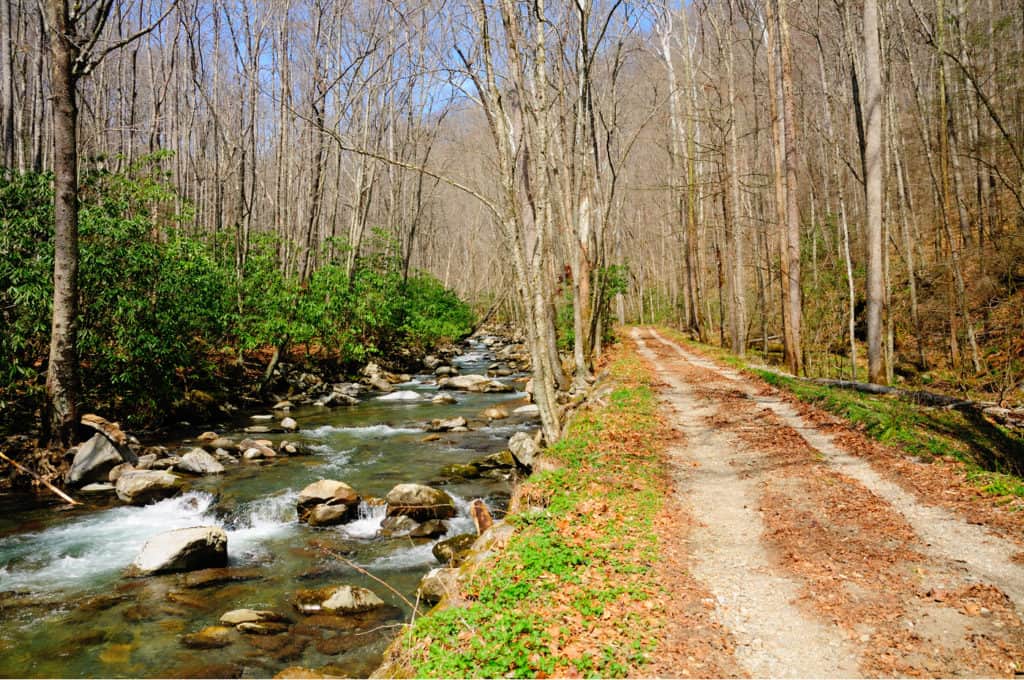
Stop 3: Smokemont Self-Guided Nature Trail
Length: 0.6 miles Elevation Gain: 157 feet Type: Loop Difficulty: Easy Estimated Time to Complete: 20 minutes
A fun way to start out your Smokemont area hikes, especially if you have kids in tow, this short loop is easy and starts and ends by the Bradley Fork River. Expect to have shade and lots of greenery throughout.
Stop 4: Smokemont Loop Trail
Length: 5.9 miles Elevation Gain: 1,407 feet Type: Loop Difficulty: Moderate Estimated Time to Complete: 3.5 hours
If the Self-Guided Nature Trail got you excited about Smokemont, this is just the trail for you! The first two miles are a fairly gradual uphill, however the next two are a gradual downhill and the last two are flat. If you take your time (and bring some snacks), this is the perfect way to cap your time in the Great Smokies.
Follow US-441 until you see a left turn for Smokemont Road to cross the Oconaluftee River. Make your first left and head up Smokemont Road until you come to the fork. Follow it to the right and head towards the Smokemont Camping Area for parking. You’ll pass a ranger station on your left heading into the camping area if you have any questions.
If you have a short day, you can edit this itinerary to suit your needs, but you can’t go wrong with any of these hikes.
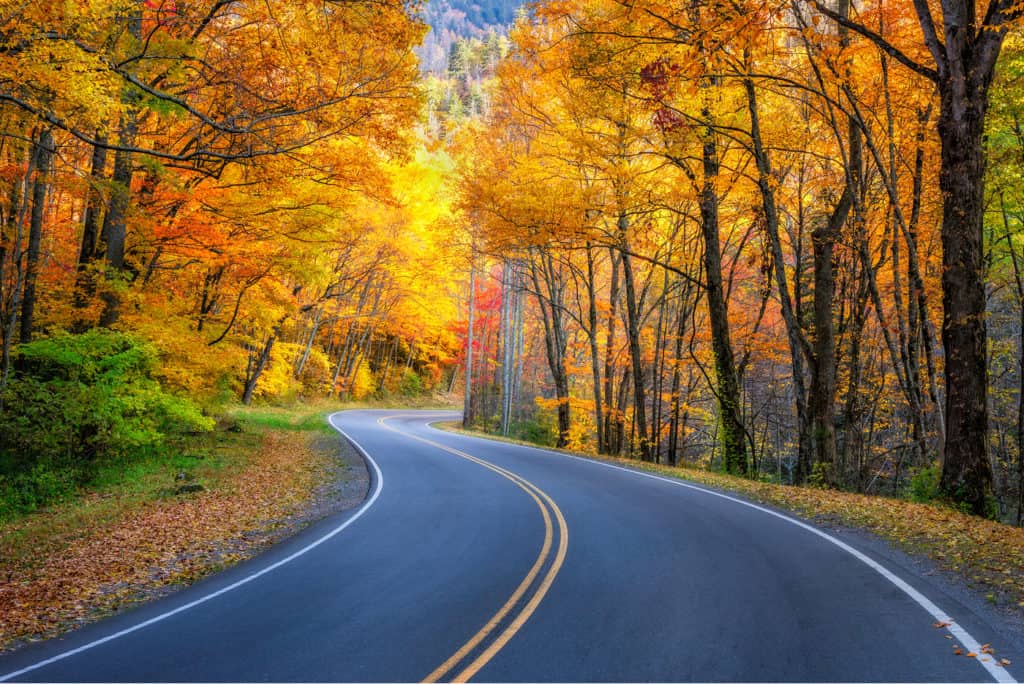
Hopefully this itinerary has helped inspire your next trip to the US’s most visited national park! We can’t wait to hear all about it!
Lauren Juliff
Lauren Juliff is a published author and travel expert who founded Never Ending Footsteps in 2011. She has spent over 12 years travelling the world, sharing in-depth advice from more than 100 countries across six continents. Lauren's travel advice has been featured in publications like the BBC, Wall Street Journal, USA Today, and Cosmopolitan, and her work is read by 200,000 readers each month. Her travel memoir can be found in bookstores across the planet.
Related Posts

How to Spend One Week in Mauritius: An Itinerary for First-Time Visitors

How to Spend Two Weeks in Belize: An Itinerary for First-time Visitors
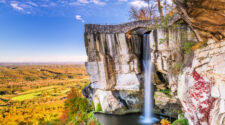
21 Thrilling Things to Do in Tennessee

How to Spend Three Magnificent Days in Tbilisi, Georgia: A 2023 Itinerary

How to Spend Three Perfect Days in Delhi: An In-Depth Itinerary

How to Spend Three Magical Days in Cusco, Peru: A 2023 Itinerary
Leave a reply cancel reply.
Your email address will not be published. Required fields are marked *
Meet Lauren Juliff

Nantahala Gorge
March 2 - October 31, 2024
Starting at $59
Tuckasegee River
June 12, 2024 - January 12, 2025
July 3 - December 31, 2024
Starting at $69
February 9 - July 28, 2024
Starting at $169
Smoky Mountain Beer Run
March 16 - August 31, 2024
Starting at $114
Polar Express
November 7 - December 31, 2024
Starting at $44
Moonshine Experience
May 17 - November 2, 2024
Starting at $124
Fall Trains
September 21 - October 31, 2024
Raft n' Rail
April 2 - October 27, 2024
Starting at $142.75/adult
Starting at $125.75/child
Rail n' Trail
Kidzip train.
Starting at $130.95/adult
Starting at $113.95/child
Tarzan Train
Starting at $180.95/adult
Starting at $163.95/child
A Proud Member of the American Heritage Railways Family
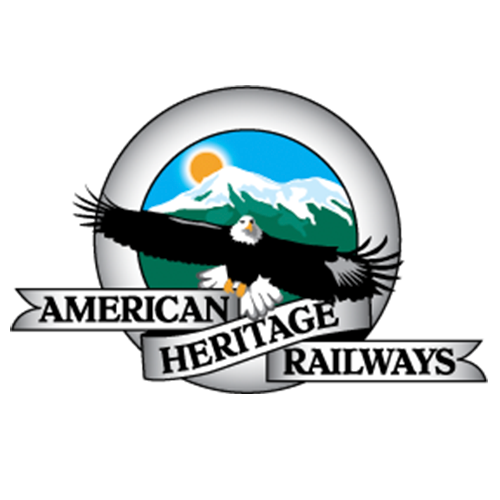
Great Smoky Mountain Railroad. All Rights Reserved.
Powered by ROCKHOUSE PARTNERS an ETIX company.
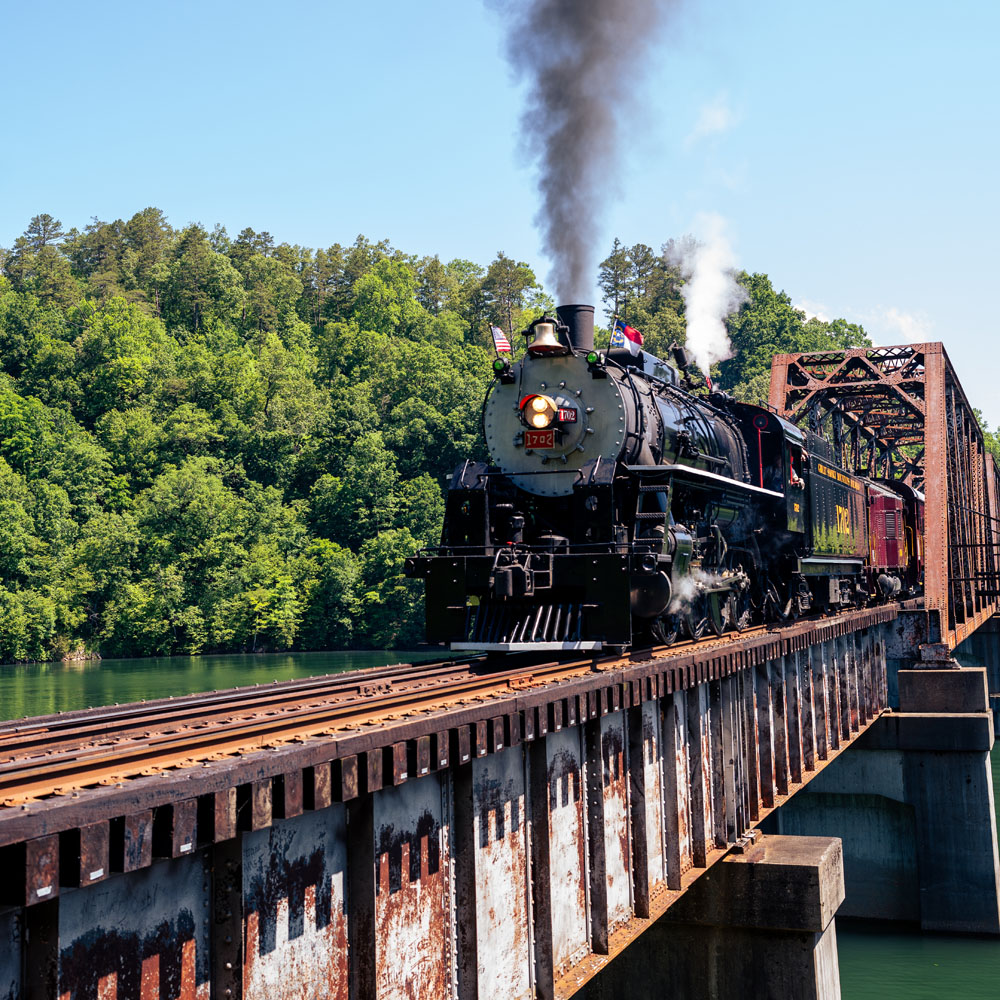
Take a train ride along side the beautiful Nantahala River on our Nantahala Gorge Excursion! Departing from Bryson City, this 4 1/2 hour roundtrip excursion carries you 44 miles to the Nantahala Gorge and back again arriving at our Bryson City Depot.
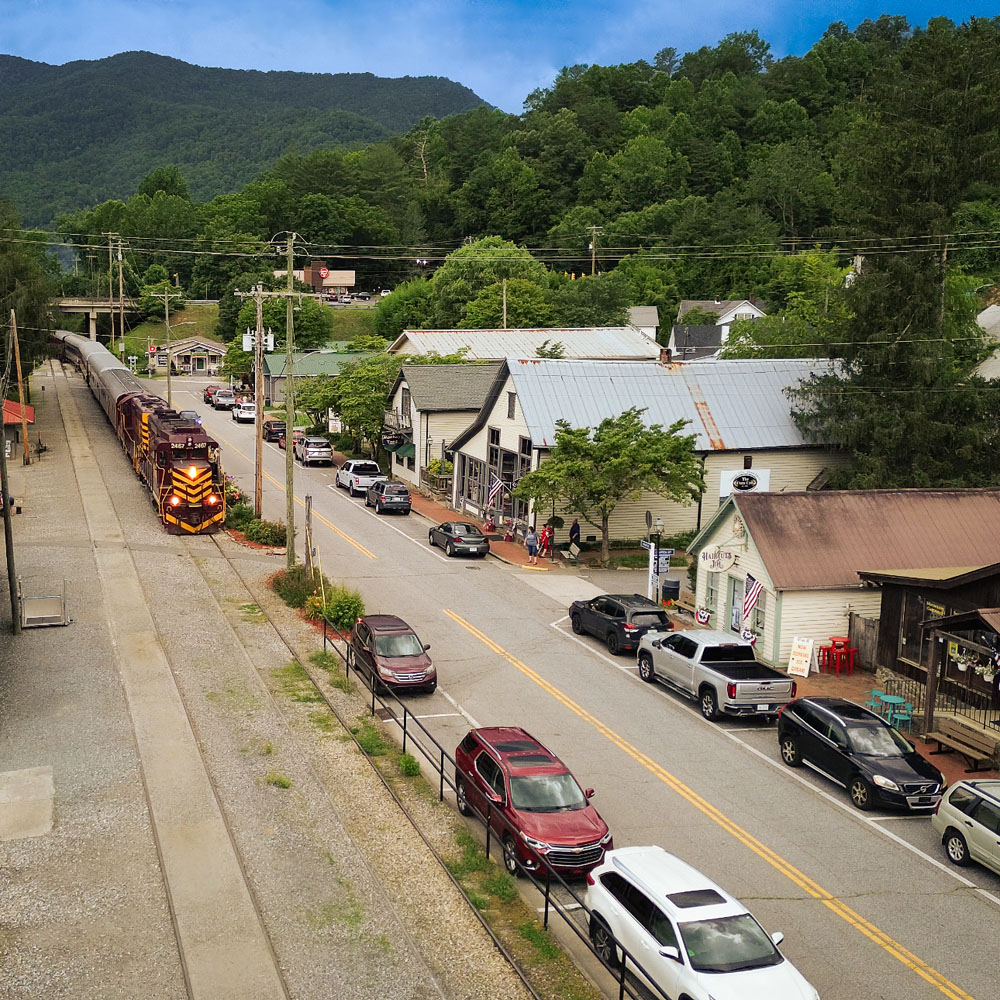
TUCKASEGEE RIVER
Join us for a relaxing ride through quiet countryside on your way to small-town life in Western North Carolina on the Tuckasegee River Excursion. Departing from Bryson City, this 4-hour excursion travels 32 miles round-trip to Dillsboro and back to the Bryson City Depot. Pass by the famous movie set of The Fugitive starring Harrison Ford!

Don’t care where you’re going or what you’re doing as long as No. 1702 is on the train? This one’s for you. Choose from several steam operated train excursions.

Uncorked Booking
Passengers will enjoy a full service All-Adult First Class ride in our First Class cars with a private attendant and plush well-appointed dining seating. A narrator will accompany the ride to present each pour to guests and share knowledge and history of the wines selected. Passengers on this specialty car will enjoy an exclusive sampling of cheeses and a surf and turf meal prepared fresh. We have carefully selected our wine samples to accompany the meal.

The Polar Express

The original Raft & Rail since 1988: enjoy the two best adventures in the region in one day, great for families. Southern Living Magazine calls this “an ideal adventure for families, first-timers, young or old.” This full-day guided adventure starts with a Wildwater staff member greeting you at the train depot, followed by a scenic train trip, deli lunch with all the fixings, and a Nantahala River whitewater trip with a guide in every boat. Hot showers and a photo show follow immediately after your 8-mile Nantahala River trip. All transportation is included to and from the Bryson City Train Depot. Available April–October with the morning departure of the Nantahala Gorge Excursion departing Bryson City, NC. Train seating in Open Air Gondola.
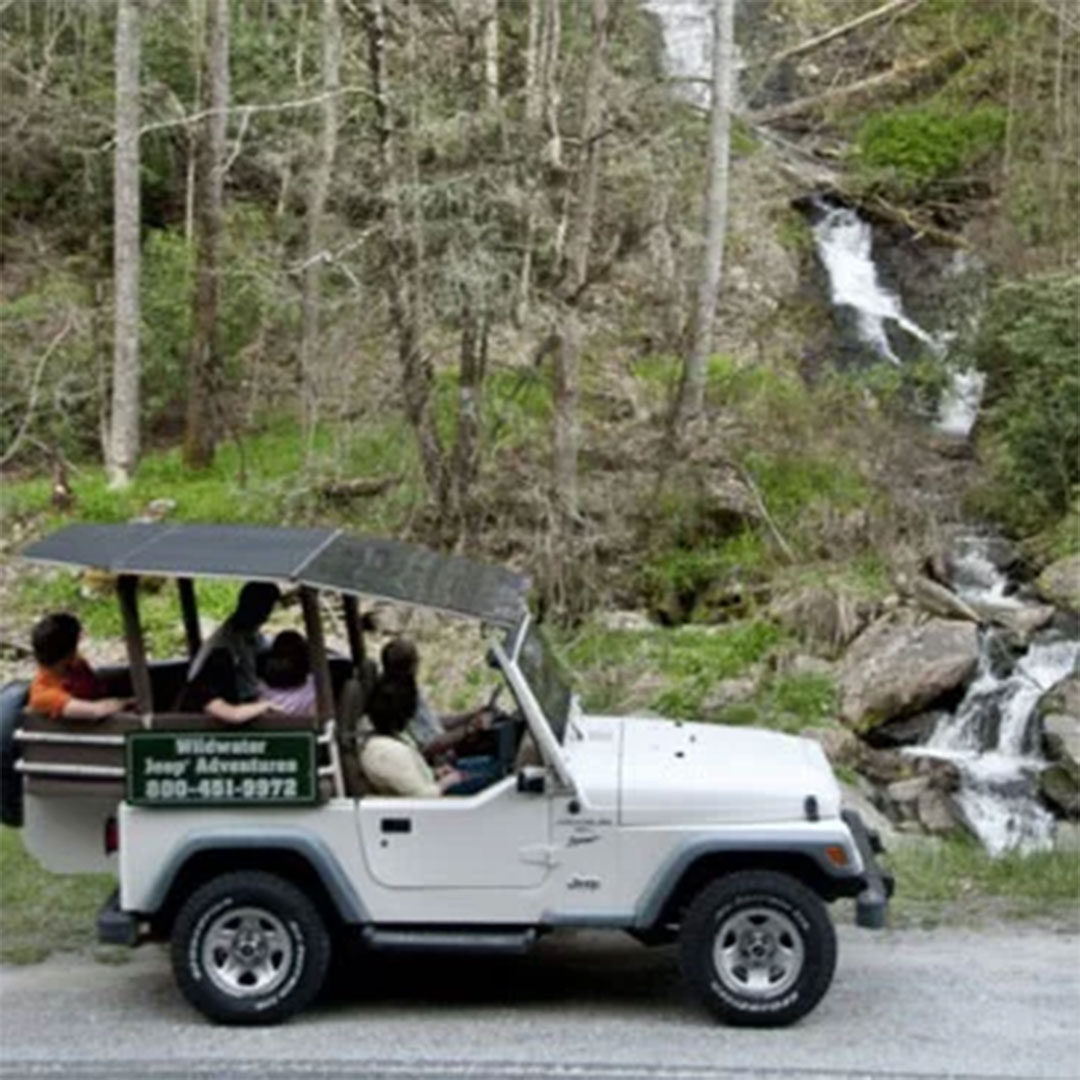
Rail N' Trail
Enjoy this trip combining the Great Smoky Mountains Railroads trip with the Waterfall Jeep® tour. You’ll begin your trip in Bryson City, NC, with a 2 hour (approximate) railroad excursion over Fontana Lake and into the Nantahala Gorge. As you travel on the train, watch paddlers challenge the rapids. At the top of the line, disembark from the train and climb aboard Wildwater’s customized Jeep® for a 2-hour (approximate) personal exploration up the mountain, past waterfalls and lakes, up to the Appalachian Trail and back. A delicious deli lunch is included.
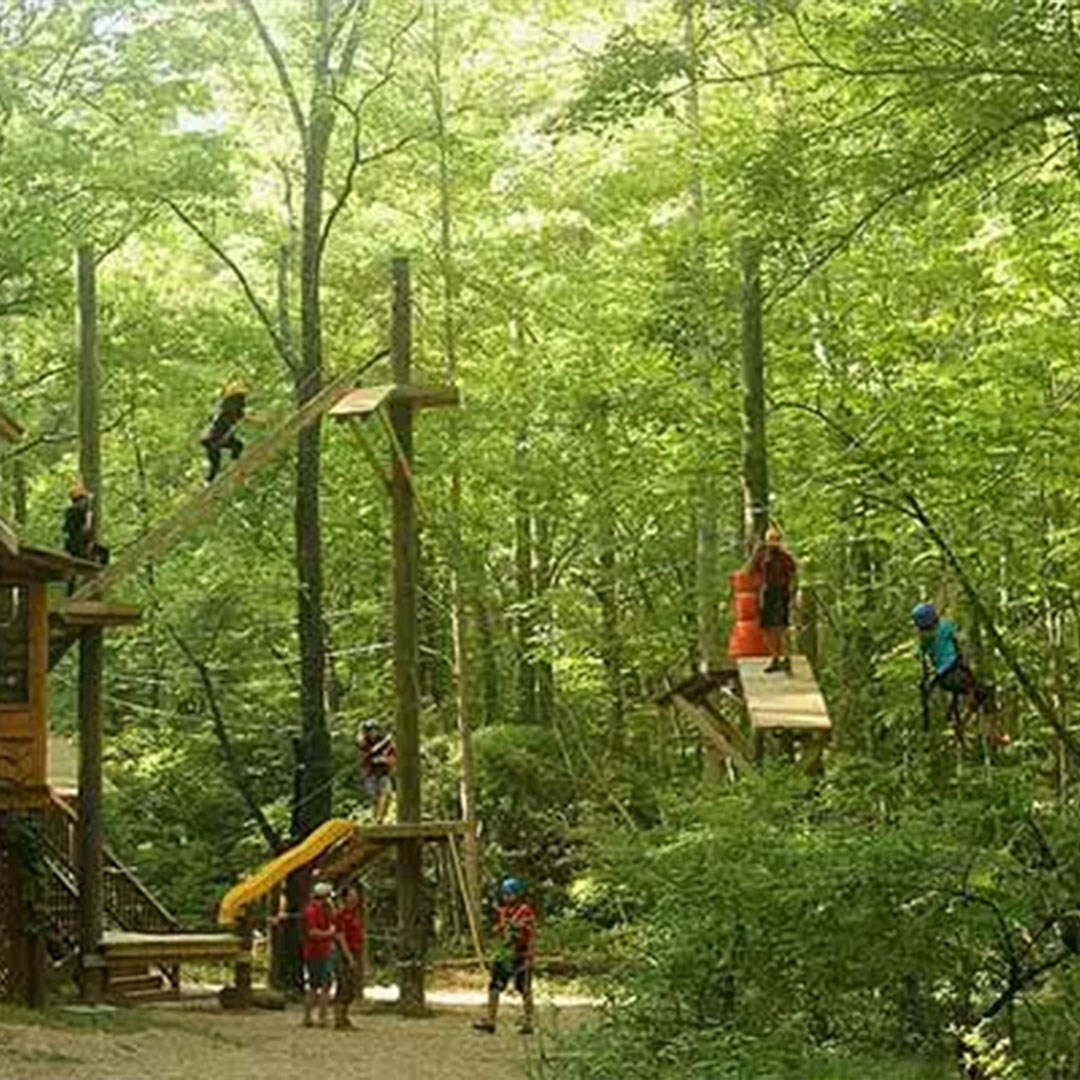
For kids 4-12 years old, ride the Great Smoky Mountains Railroad in an open air car viewing the Nantahala Gorge, enjoying lunch, and then exploring in a scenic wooded adventure setting within view of parents. With a continuous cable system, there is no clipping and unclipping for the participants. Participants 4-6 years old must have a paying adult accompany them on the course. Equipment Furnished: Helmet, Harness, gloves.
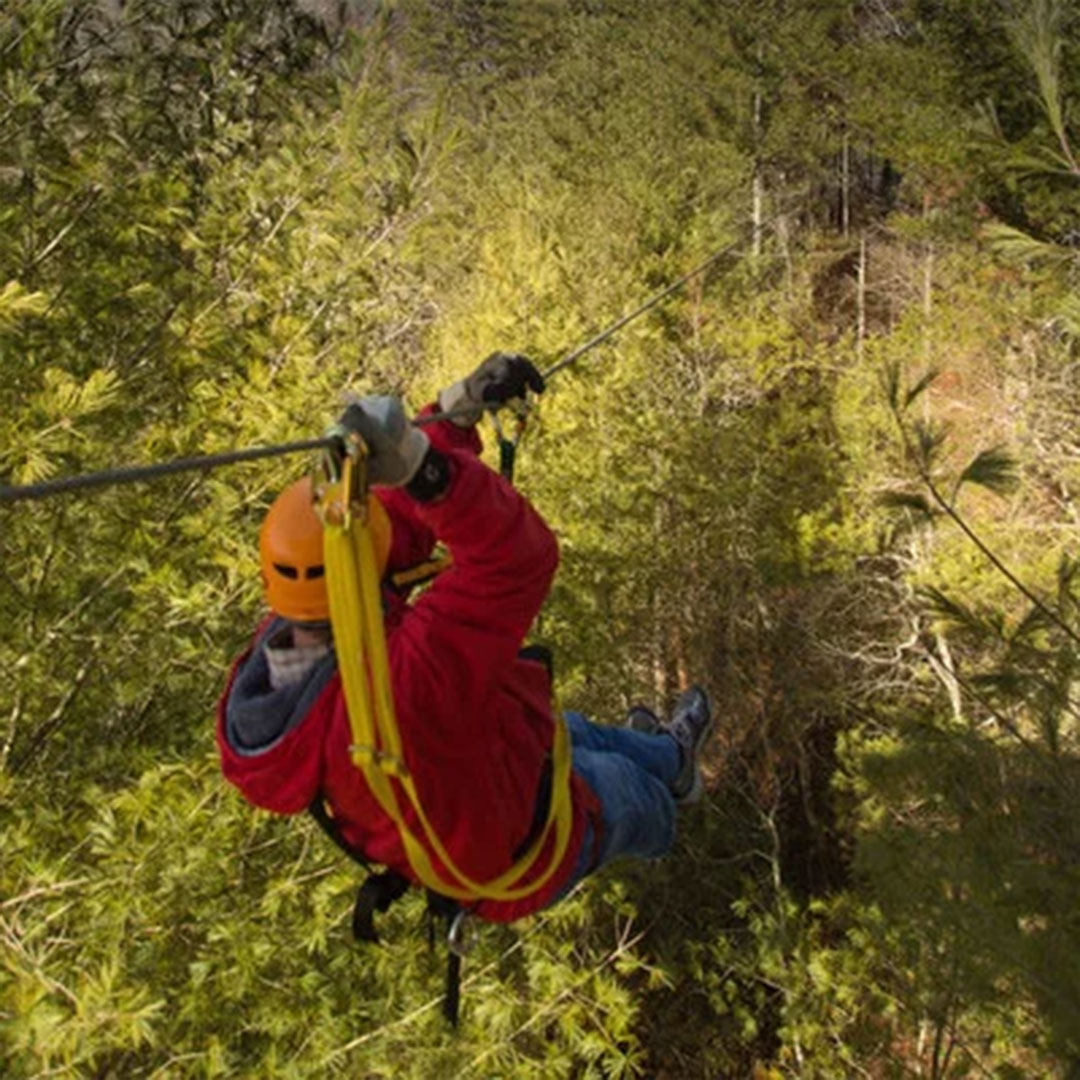
Our train and canopy combo trip will start in Bryson City at the Great Smoky Mountain Railroad train depot. You will ride through the Smoky Mountains, along Fontana Lake and up into the Nantahala Gorge. On your 2-hour train ride, watch paddlers challenge the rapids on the Nantahala River. A delicious Deli Sandwich lunch is included. At the top-of-the-line, you will disembark the train and travel a short distance to Wildwater’s Nantahala Gorge Canopy Tours. The original zip line canopy tour in Western North Carolina, Wildwater’s Nantahala Gorge Canopy Tours offers 13 different zip lines and 8 sky bridges. Our two highest platforms have unbelievable views of Clingman’s Dome, Fontana Lake and waterfalls. This gliding experience, naturally fueled by a gradual elevation change, takes you through multiple ecosystems, past hemlocks, into hardwoods and through a deciduous forest packed with native flowering plants. All Canopy Tour Rangers are trained to – and all courses are built and inspected to – ACCT Standards to provide for your well-being and fun. This is a great experience for families. After enjoying the fully guided zip line tour, check out your photos and buy a t-shirt in Wildwater’s store. Your adventure will end later in the afternoon back at your car in Bryson City, NC. All transportation is included. Members of your party who can’t – or don’t want to – go on the canopy tour can ride the train round trip. You’ll all meet up shortly after the train’s return in Bryson City, NC.
Tuckasegee River Excursion
- Train Schedule
- Steam Powered
- Diesel Powered
Nantahala Gorge Excursion
- Carolina Shine Moonshine Experience
- Boxed Lunches
- Raft & Rail
- Rail & Trail
- Tarzan Train
- KidZip Train
- Serene Relaxation At Stonebrook Lodge
- Private Caboose Party
- THE POLAR EXPRESS™
- Smoky Mountain Beer Run
- Bunny Hopper Express
- Map & Directions
- Great Smoky Mountains Railroad Model Train Museum
- 722 Rebuild Blog
- Southern Highlands Attractions
- Health & Safety Tips
- Andrews Valley Rail Tour
- Weather and Road Closures
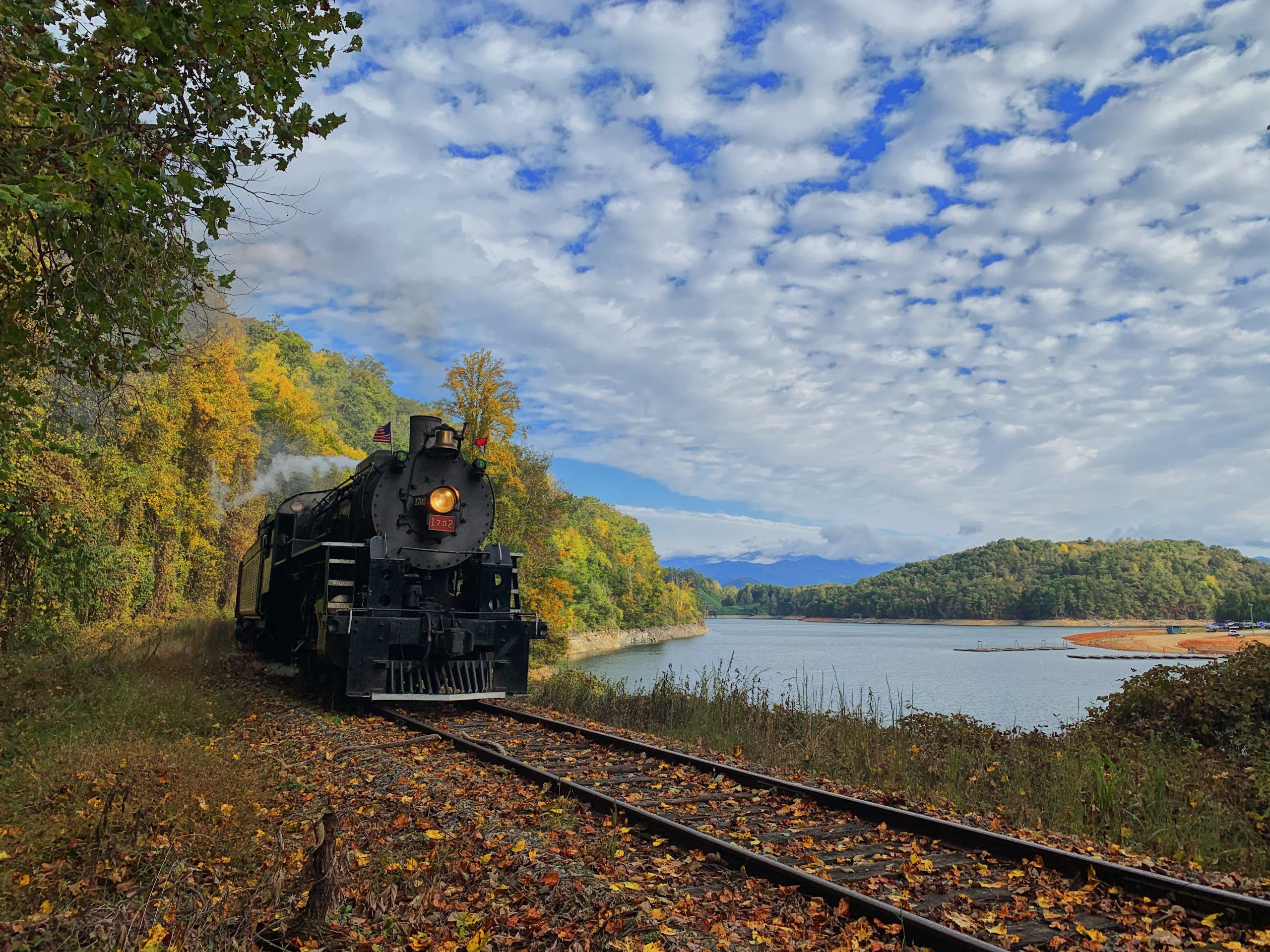
Welcome to Your Next Greatest Adventure
The Great Smoky Mountains Railroad historic train depot sits in the heart of Bryson City, North Carolina, and is a favorite regional attraction for family fun. A round-trip on the train is an ideal way to see extraordinary places that you can’t get to by car. Get a front-row view of Fontana Lake, the historic Fontana Trestle, the Great Smoky Mountains National Park, the Nantahala National Forest, the Nantahala and Tuckasegee Rivers, historical structures, and stunning foliage.
Choose from steam-powered with the official “Steam of the Smokies” or climb onboard an excursion powered by diesel locomotives. A variety of passenger round-trip train options and special event trains — including THE POLAR EXPRESS™ Train Ride — makes this the perfect attraction for making memories and experiencing the true form of railroading.
Climb aboard for your next unforgettable adventure today.

Make Plans for 2024!
Regardless of the season, you can expect a truly exceptional experience when you climb aboard one of our historic trains. Our excursions run year round offering our guests with incredible access to this beautiful, yet remote region of North Carolina and the Great Smoky Mountains.
Purchase your trip in advance to secure the best seats and dates!
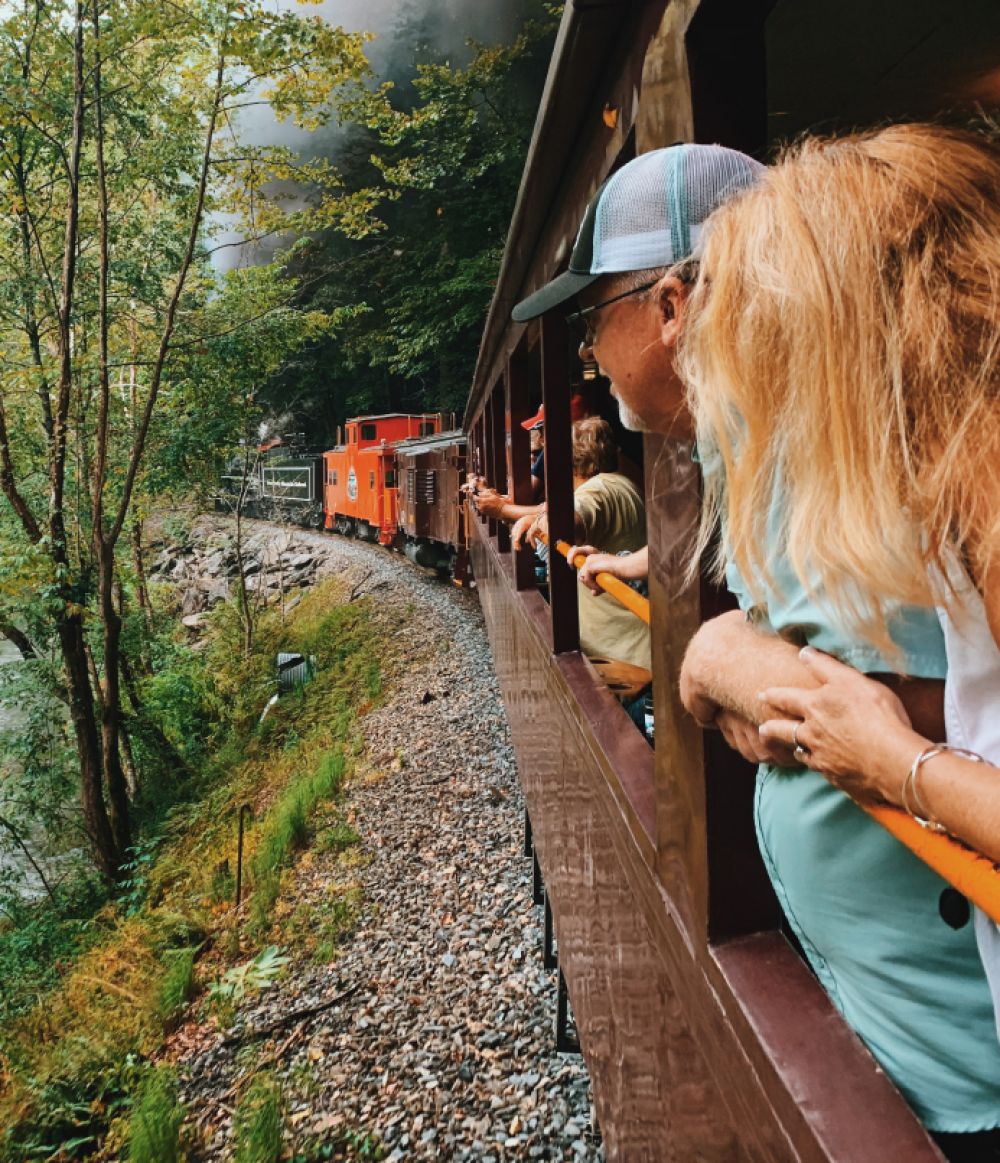
So Much To See & Do
When you come to ride the train, we hope you’ll plan to stay awhile. You’ll enjoy the country inns, lodges, resorts, quaint shops, places to dine, historic sites, museums, and amenities. This is America as it used to be; a treasury of friendly people, a restful environment, and the beauty of nature everywhere. There’s a reason why Bryson City is one of the top family-friendly destinations in North Carolina!
Scenic Train Rides & Special Excursions
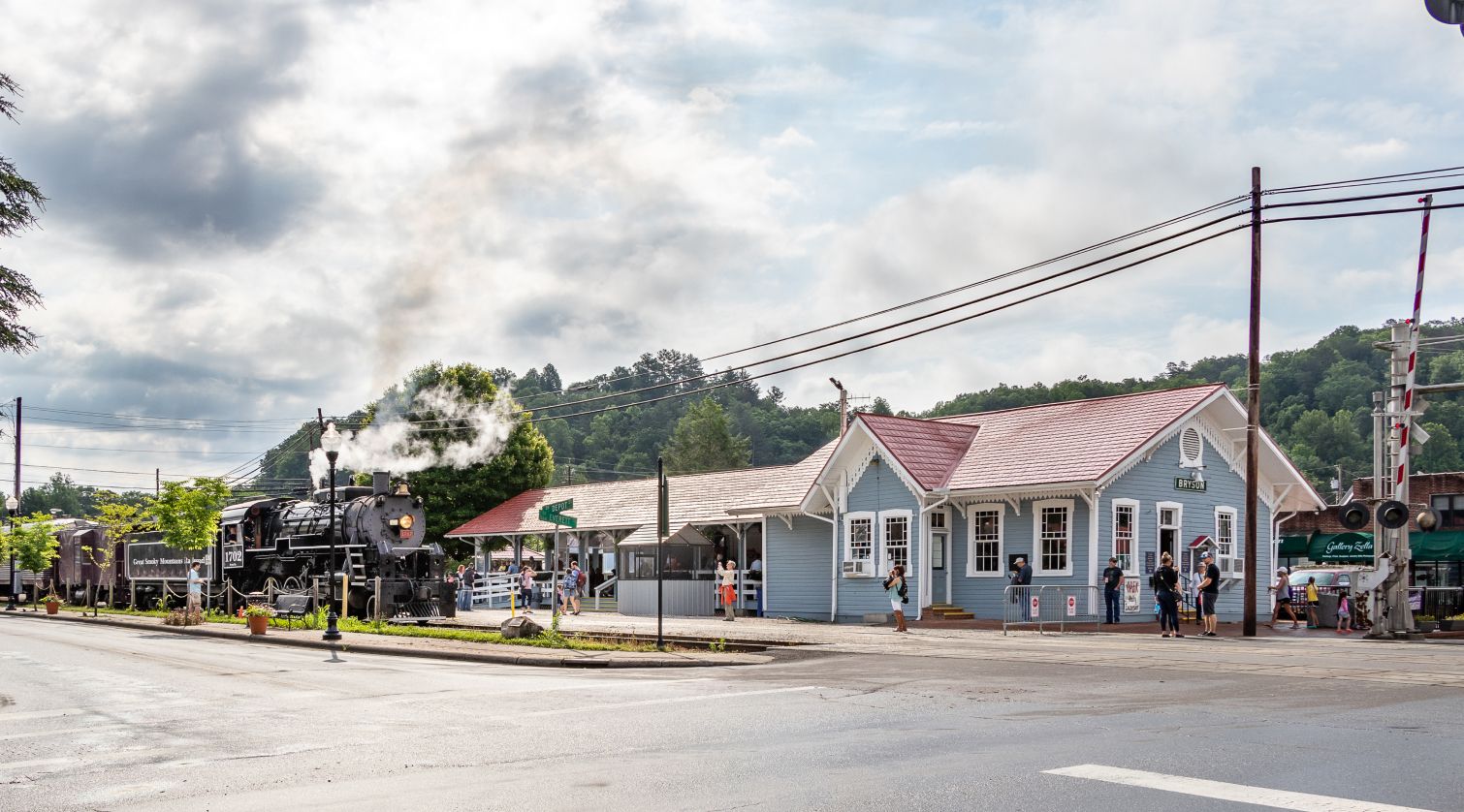
Take a train ride alongside the beautiful Nantahala River on our Nantahala Gorge Excursion! Departing from Bryson City, this 4½-hour roundtrip excursion carries you 44 miles to the Nantahala Gorge.
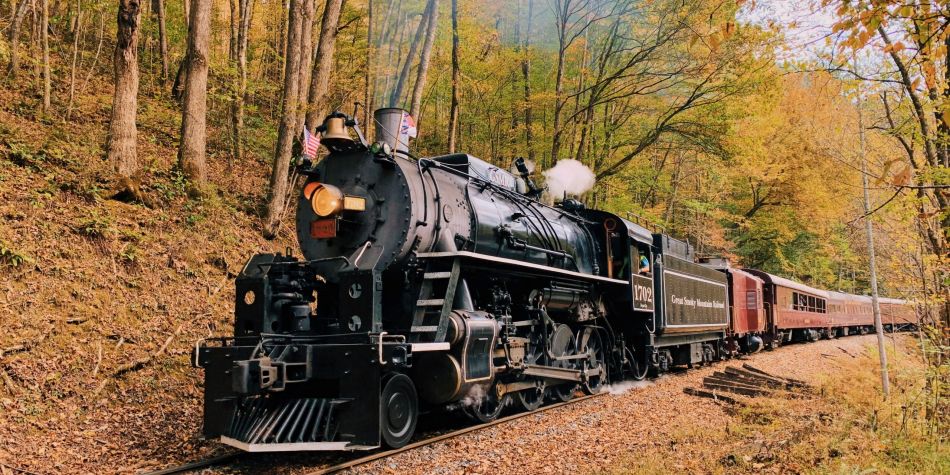
Join us for a relaxing ride through the quiet countryside on your way to small-town life in western North Carolina on the Tuckasegee River Excursion.

Special Events
Check out the upcoming special events such as The Carolina Moonshine Experience. We will be proudly serving hand-crafted, triple-distilled, craft moonshine.

Group Sales: 800-872-4681 Option 3
Reservations line: 800-872-4681 option 1.

Subscribe to our mailing list
Thanks for joining our mailing list.
You’ve been successfully subscribed – thanks!

© 2024 Great Smoky Mountain Railroad. All Rights Reserved. Privacy Policy
We Need Your Vote! Help Us Win USA Today Readers’ Choice for Top Scenic Train Ride!


When to See Fireflies in the Great Smoky Mountains in 2024
T he Great Smoky Mountains National Park is gearing up for its annual synchronous fireflies event-the largest gathering of synchronous fireflies in the Western Hemisphere. During the annual phenomenon, swarms of lightning bugs will light up the park at night. The incredible flashing display is so popular that a lottery system has been established for obtaining the coveted parking passes required to attend. Here's how to get one and what to expect.
How to see the Great Smoky Mountains synchronous fireflies
In 2024, the lottery to see the synchronous fireflies in the Great Smoky Mountains National Park opens on April 26, at 10 a.m. EST, and will close on April 29, 2024, at 11:59 p.m. EST. Those interested in seeing the annual display can enter the lottery at Recreation.gov , and will be charged a $1 lottery application fee.
The 2024 viewing dates for the Great Smoky Mountain synchronous fireflies will be June 3 to June 10. Some time in mid-May, lottery applicants will be notified about whether their application was accepted or rejected.
Lottery winners will automatically obtain (and be charged for) the vehicle pass necessary to access the viewing area. The Great Smoky Mountains National Park will be handing out a total of 1,120 vehicle passes for the eight-day event (140 per day). Lottery winners will be charged $24 per vehicle and can bring a maximum of seven passengers in their car.
Attending the event
Each pass is valid only for a specified date, and an arrival time between 6:00 p.m. and 8:00 p.m. will be assigned. No additional passes beyond those assigned during the lottery will be made available.
Attendees will be asked to cover their flashlights with red or blue cellophane so they don't disrupt the viewing experience, turn them off altogether when they have found a viewing spot, and stay on designated trails or paved surfaces at all times. And remember: No firefly-catching allowed, so leave those Ball jars at home, folks.
After visitors check in, parking attendants will direct vehicles into designated parking areas, where visitors can then leave their cars during the viewing. A designated number of ADA parking spaces will be available on a first-come, first-served basis. Primary viewing areas are Jakes Creek and Little River trails.
What are synchronous fireflies?
Synchronous fireflies are a unique species of firefly (which is a type of beetle also known as a lightning bug) that can actually synchronize their flashing light displays. Their light patterns, which are produced in "lanterns" along their abdomens, are part of a mating ritual that helps males and females recognize each other. The males will fly and flash their light and the typically stationary females will respond with a flash, according to the Great Smoky Mountains National Park's dedicated synchronous fireflies page .
No one is exactly sure why the fireflies flash their lights in unison, and they don't always do so. When they do, a burst of light ends with an abrupt period of darkness.
The peak mating season lasts for approximately two weeks each year, and the dates of the display vary from one year to the next. Scientists predict the dates based on factors such as temperature and the moisture in the soil. Even during the peak season, attendees aren't guaranteed a perfect display, the park has cautioned. Environmental factors such as rainfall or cooler temperatures that fall below 50 degrees can shut down the display on any given night.
Other places to see synchronous fireflies in the USA
While the Great Smoky Mountains may have one of the most well-known firefly displays, other U.S. parks also welcome synchronous fireflies each year. While the lottery for these parks are now closed, those interested in attending should take note for 2025.
Congaree National Park
This year's annual synchronous firefly viewing event at Congaree National Park will take place from May 16 to 25, 2024. Similarly to Great Smoky Mountains, visitors need to win parking passes via a lottery system to attend. The lottery opened on April 4 and closed on April 10. Winners were notified on April 16. Parking passes cost $24 per vehicle for this event.
Allegheny National Forest
There are 15 species of firefly in Pennsylvania, and June is prime time to see them. The PA Firefly Festival takes place annually in Tionesta and is scheduled for Friday, June 28, and Saturday, June 29, in 2024. Registration for the 2024 lottery is now closed.
This article originally appeared online in 2019. It was most recently updated on April 24, 2024, to include current information.

- Atlanta Tourism
- Atlanta Hotels
- Atlanta Bed and Breakfast
- Atlanta Vacation Rentals
- Flights to Atlanta
- Atlanta Restaurants
- Things to Do in Atlanta
- Atlanta Travel Forum
- Atlanta Photos
- Atlanta Map
- All Atlanta Hotels
- Atlanta Hotel Deals
- Last Minute Hotels in Atlanta
- Things to Do
- Restaurants
- Vacation Rentals
- Travel Stories
- Rental Cars
- Add a Place
- Travel Forum
- Travelers' Choice
- Help Center
Help with Atlanta to smoky mountain national park itinerary - Atlanta Forum
- United States
- Georgia (GA)
- Atlanta
Help with Atlanta to smoky mountain national park itinerary
- United States Forums
- Europe Forums
- Canada Forums
- Asia Forums
- Central America Forums
- Africa Forums
- Caribbean Forums
- Mexico Forums
- South Pacific Forums
- South America Forums
- Middle East Forums
- Honeymoons and Romance
- Business Travel
- Train Travel
- Traveling With Disabilities
- Tripadvisor Support
- Solo Travel
- Bargain Travel
- Timeshares / Vacation Rentals
- Georgia forums
- Atlanta forum

Me and my wife are going to visit the SMNP late May for 3 days – except travel days. Reading through materials here in earlier posts, here is what I was thinking but any advice will be great:
May 29: Leave early morning and drive to Bryson City - shall we make it a night stop? Or move to Townsend? We won’t be able to take the train ride though. What else can we do the rest of the day? Deep creek? Hikes near Blue Ridge parkway
May 30: Wears Valley, Townsend, Cades Cove, Clingsman Dome (stay in Townsend?)
June1: Roaring Fork Motor trail, Clayton, back to Atlanta by evening (can we add something?) – stay close to the airport.
June2: Fly back 7 AM
Happy to add/remove anything. We are more into nature and less into shops/dining and pretty much anything touristy and crowded, without disrespecting anyone who likes such things.
Any specific treks we must consider?
We are average Houston drivers – not reckless, over cautious and definitely not pro. So, any advice there will be super helpful.
Many thanks!
13 replies to this topic

https://www.explorebrysoncity.com/?gad_source=1&gclid=CjwKCAjwxLKxBhA7EiwAXO0R0FpP3CXkddkk8_sP5qVwk8q5aGm6PijF4WMWFcAvUvhLSTCr8hU-gBoCcacQAvD_BwE
Google search link
Here's a Tripadvisor link t ok bryson city too
https://www.tripadvisor.com/Tourism-g48984-Bryson_City_North_Carolina-Vacations.html
On June 1 are you driving back thru the park and exiting at Cherokee and continuing thru to Clayton GA and taking route by Tallulah Falls and on to I 985 and I 85 back to airport?
That route I put in post #3 is very scenic. I would take a quick detour in Franklin NC on Hwy 28 and head to Highlands NC. This road has 5 beautiful waterfalls right on the road. From Highlands head to Clayton GA. It has world class food options like Fortify Pi.
This is the route we use from Smoky mountains.
Hi PeachBelle8288,
Awesome! Does this modification for or just stuffed to death. Happy to clip anything as you suggest,
May 31st: Leave Bryson City early morning, stop at Oconaluftee Visitor center (is it open early?) or come back after Mingo falls hike, Newfound Gap, Clingmans Dome; skip roaring fork road for another time and move to Townsend via Wears Valley by lunch. Check in and eat. Go for Metcalf bottom and Laurel falls, and roaring fork may be?, come back to Townsend and sleep.
June1: Leave early and go to Cedar Cove, the exit the park through Cherokee, Take a detour to Highlands and then reach Clayton for late lunch. Do the last stretch to reach close to Atlanta airport for overnight stay. Dine, drop car etc.
June2: Fly back early morning
Does this make sense or I am just cramming a bunch of stuff. Happy to modify if needed.
Great reply peach .no onevhad replied so thought I'd give them some general knowledge
Clayton is great suggestion too
Stop for lunch in Franklin NC. It has a great diner and French restaurant but that is open only at night.
I don't know how early you will get there but I would just see what you can see that day. The BRP is beautiful but very slow.
Other days look good. In Townsend we like Trailhead Steak and Trout restaurant. Do Cades Cove in early morning as a better chance to see wildlife.
- Help with Atlanta to smoky mountain national park itinerary Apr 27, 2024
- 2-2.5 days in Atlanta - itinerary suggestions? Apr 27, 2024
- Day trip from Atlanta for a Family Apr 26, 2024
- Where's good that's accessible into Central ATL by public tr Apr 24, 2024
- Drive from Atlanta to Chattanooga…. Apr 24, 2024
- Good restaurants near Georgia Tech Apr 24, 2024
- Marriott hotel at Atlanta airport Apr 23, 2024
- Sheraton Atlanta Perimeter North Apr 22, 2024
- Atlanta Transport with kids Apr 21, 2024
- Customs and Immigration for International Arrivals at ATL Apr 20, 2024
- Truist Park - Must Do’s Apr 15, 2024
- What to do on a Monday after the Aquarium? Apr 15, 2024
- Tickets for Atlanta braves Apr 14, 2024
- Atlanta to Great Smoky Mountains Tour Apr 14, 2024
- closest beach to Atlanta 5 replies
- Driving from ATlanta to Savannah 11 replies
- Hotel with rooftop or decent outdoor pool in Atlanta please 3 replies
- Downtown, Midtown or Buckhead? 7 replies
- Best area to stay 2 replies
- Atlanta to Destin Florida - Driving Time/Route 6 replies
- How long driving from atlanta to Orlando 16 replies
- Where to stay in Atlanta 8 replies
- A nice beach near Atlanta for family of two young children 12 replies
- Hotel located IN the Atlanta airport? 4 replies
Atlanta Hotels and Places to Stay
- Neighborhood Recommendations
- Less Expensive Neighborhood Recommendations
- Favorite restaurants in Midtown
- Suggested connection times through ATL
- Managing a tight connection at ATL
- Customs & Immigration at ATL
- Getting from Terminal S (or N) to Terminal I
- Getting from Terminal I to Terminal S (or N)
- Why LESS than 2 hours is NOT enough for international connections -First Hand account
- Transportation from the airport to the city
- Do I need to rent a car?
- Favorite Southern Restaurants, Restaurants Unique to Atlanta, and Coffee Shops?
- Riding the Atlanta Streetcar - route and rates
- Hotels Offering Park Sleep Fly at ATL Airport
- TRIP REPORTS - Ideas of things to see and do
- What activities are recommended for young children?
- tailgating at new Mercedes stadium
- What to do downtown
- City vs airport car rental issues
- Walking route thru atlanta 10 miles
- Restaurants for a Large Group
- Trip to Nashville
- parking around Mercedes Benz
- Left Luggage
- Best places for southern cooking in (and around) Atlanta

Most Smoky Mountain hikers go missing by going off trail. New analysis shows how they survived

It seems counter-intuitive. How can anyone go missing in the most visited national park in the country? But given the size of Great Smoky Mountains National Park − 522,419 acres − and the sheer number of people inside its boundaries with 13.3 million visitors in 2023, it is actually surprising there are so few lost hikers .
Great Smoky Mountains National Park averages 103 search and rescue missions annually, relatively few of which are for missing people.
Since the park was established in 1934, there have been only five documented cases of people who went missing in the park and were never found.
New analysis from Smoky Mountains website looks at wilderness survival stories
What is the best way to prevent that worst-case scenario from ever happening to you or your loved ones? Researchers at SmokyMountains.com have your back . They analyzed more than 100 reports to discover how survivors got lost in the first place; if and how they found warmth, shelter, food, and water; whether they stayed put or kept moving; and whether they found their own way out or were rescued.
The survivors in the data pool were lost anywhere from less than a day to an astonishing 90 days, with survival tactics that included finding shelter and rationing food. Only one of the cases involved someone in the Great Smoky Mountains National Park: Austin Bohanan, who was lost for 11 days in 2017 .
The most common way that hikers got lost was by wandering off the trail (41%). In 17% of cases, bad weather was to blame, while 16% of news reports analyzed cited falling off the trail as the cause.
To find a way back to safety, survivors were faced with an important decision: whether they should stay put and wait to be rescued, or if they should keep moving in order to find their own way out. The research found that two-thirds decided to keep moving (65%), while just a third chose to stay put (35%). Just under a quarter found a way out themselves (23%), and the remaining 77% were rescued.
Lost hikers detail most important considerations for survival
In the cases examined by SmokyMountains.com, survival often hinged on the ability to find a combination of four basic things: warmth, shelter, food and water.
In order to stay warm, 10% built fires and a further 10% used camping gear. Other methods of keeping warm included the body heat of fellow hikers (including dogs), exercise and digging in.
For shelter, 11% of survivors used camping gear. Some 9% were able to discover caves and other existing shelters, while 8% took shelter beneath trees.
In order to stay hydrated, survivors needed a reliable source of water. Almost a quarter found a natural body of water (24%), 16% used snow, rain or puddles, and 13% rationed their own water. Other sources of water that were named included drinking urine or licking leaves, moss and grass for hydration.
Survivors also needed to find food. Over a third were able to ration their own supplies (35%) and 9% ate berries and fruit. A number of hikers also ate plants and insects.
Expert offers wilderness survival tips
Andrew Herrington, who is a survival instructor, search and rescue team leader and wildlife ranger in the Smokies, shared his top hiking advice with SmokyMountains.com. Not surprisingly, his best advice involved preparation:
- Carry the 10 essentials : Navigation aids, sun protection, insulation (good clothing), illumination (flashlights etc.), first aid supplies, fire-making supplies, repair kit, nutrition, hydration and emergency shelter.
- Leave a trip plan and check-in time with two trusted people.
- Study your maps and identify a “bailout” direction in the area you’re exploring.
- Check the weather forecast (including overnight in case you’re forced to stay out).
- Practice lightweight tarp shelter building at home.
- Print off free maps at sartopo.com .
- Download a backup GPS app, like Avenza.
- Practice fire-making and carry the gear (including petroleum jelly-soaked cotton balls and fatwood sticks).
- Look into personal locator beacons and satellite messengers for cutting-edge signaling options.
Liz Kellar is a Tennessee Connect reporter. Email [email protected] .
Support strong local journalism by subscribing at knoxnews.com/subscribe .
- Share full article
Advertisement
Supported by
What to Know Before Booking a National Park Trip This Summer
Additional routes in popular parks now require reservations, the annual pass gets a big change, Juneteenth is now a new free entrance day and more changes for 2024.

By Lauren Matison
In 2023, the seashores, lakeshores, battlefields, historic sites, monuments and more that make up the National Park Service had 325.5 million visits , an increase of 4 percent from the year before.
The National Park Service director, Charles F. Sams III, praised the surge of interest in “learning our shared American story throughout the hidden gems of the National Parks System.”
Expecting an even greater turnout in 2024, the Park Service and Recreation.gov , the booking platform for federal land reservations, have implemented new measures to streamline the park experience, manage overcrowding and safeguard the environment.
More parks are requiring reservations
To better avoid congested trails, packed parking lots and overflowing trash cans, additional parks are joining Rocky Mountain , Arches and Glacier National Parks this year in requiring day-use permits, timed entries and other reservations for travelers who wish to visit, particularly during peak hours, holidays and the parks’ high seasons. Yosemite National Park is reinstating a timed-entry system it instituted in 2020, but paused in 2022.
Many park enthusiasts expressed mixed feelings about the reservation policies, with some lamenting a lack of first-come, first-served campsites while others find comfort in knowing they have a confirmed booking. As nearly 75 percent of visitors each year descend on national parks from May to October (and often on weekends), park officials stand by the system.
“In some parks, the level of demand is exceeding the capacity for which infrastructure was designed or is outpacing the National Park Service’s ability to sustainably support visitation,” said Kathy Kupper, a public affairs specialist for the service. “This trend is resulting in the need to explore new strategies to protect natural and cultural resources and provide opportunities for safe and meaningful visitor experiences.”
It can be confusing.
New to implementing timed-entry reservations for vehicles is Mount Rainier National Park , in Washington, for its popular Paradise and Sunrise Corridors during certain times in the summer season. Reservations cost $2, are valid for one day and must be purchased along with the park ticket, but do not apply for visitors with wilderness permits or camping or lodge reservations. Similar vehicle reservations are now required for certain periods for viewing the sunrise at Haleakalā National Park in Maui, Hawaii , and driving the Cadillac Summit Road in Maine’s Acadia National Park .
Visitors wishing to hike Old Rag Mountain in Virginia’s Shenandoah National Park must obtain a day-use ticket between March 1 and Nov. 30, and in Zion National Park, in Utah, hikers wishing to visit Angels Landing , the dramatic 1,488-foot-tall rock formation, also need to purchase a permit. Fees range from $1 to $6, in addition to the parks’ entrance fees.
As each destination is managed differently, check the park’s webpage for the type of reservation required. Although most bookings can be made through Recreation.gov, some sites, such as Muir Woods National Monument, use a different system.
New features on Recreation.gov
In 2023, Recreation.gov reported that more than 4 million camping reservations and 2 million timed-entry reservations were booked online, and 1.5 million permits were issued. Some 2.9 million new users signed up for the site. With its expanding user base, the booking platform has added 58 reservable national park locations — including 17 campgrounds — such as Central Avenue Walk-in Sites at Indiana Dunes National Lakeshore and Bluff Hike In Camping in South Carolina’s Congaree National Park.
Recreation.gov has also improved an alerts feature, piloted in July 2023, that can notify users through email or mobile push notifications when a sold-out campsite becomes available. After Recreation.gov notifies you of availability, you must book the campsite yourself online — and quickly, as you’ll be shown how many other people (possibly hundreds) have received the same alert.
While its customer support center and mobile app are still only available in English, Recreation.gov recently introduced a Spanish language translation option. The Park Service partners with Latino Conservation Week , which hosts nationwide hikes and events on environmental education and in-park stewardship, and will celebrate its 10th year in September.
A limit to the annual America the Beautiful pass
The 2024 America the Beautiful pass no longer allows two owners. The annual interagency pass, which costs $80 and covers the entrance fees for more than 2,000 federal recreation sites (of which roughly 100 do not charge for admission year-round), is now marked by a single signature line on the back of the card. The pass owner must show I.D. and be present with any accompanying travelers wishing to access the park with the pass. (Annual passes issued in 2023 will still be valid until their expiration date.) The pass covers all passengers in a vehicle — up to four adults, and children under 16 are admitted free — or up to four cyclists riding together. Active military or veterans and people with permanent disabilities are eligible for a free lifetime pass; 4th grade students may receive a free annual pass; and senior citizens may purchase a $20 annual pass or pay $80 for a lifetime pass.
At the parks, more accessible features, E.V. chargers and new lodging
To better protect against global warming, the Park Service is putting more than $65 million from the Inflation Reduction Act and Great American Outdoors Act into climate mitigation and ecosystem restoration.
Using $15.9 million budgeted for zero-emission vehicle deployment, charging capacity and infrastructure, the Park Service is prioritizing a reduction in carbon emissions, said Mr. Sams, by installing new electric-vehicle charging stations and running electric buses.
An interactive online locator tool created in 2023 shows E.V. charging stations throughout 27 national parks and the type of chargers available. In addition to the tool, every national park page displays alerts on road closures, parking lot capacities, construction work and other incidents.
Mr. Sams also said the Park Service is investing $1.3 billion from the Great American Outdoors Act to improve accessibility features, ranging from a new A.D.A.-compliant visitor center at Morristown National Historic Park in New Jersey to new beach wheelchairs at Sleeping Bear Dunes , Channel Islands and Virgin Islands National Parks . Each destination’s website has an accessibility tab to help visitors plan their trip, and Recreation.gov now has a search filter on its homepage to make it easier to locate accessible accommodations.
New lodging options now available across the country include the Flamingo Lodge , which opened inside Everglades National Park last fall with 24 guest rooms built from repurposed shipping containers. In March, along the southeastern border of Great Smoky Mountains National Park, the Cataloochee Ranch reopened with 11 renovated cabins and a new restaurant. This spring, the Clubhouse Hotel & Suites will welcome its first guests in Rapid City, S.D., the closest major town to Badlands National Park , and opening in May in Idaho is the Yellowstone Peaks Hotel , a 30-minute-drive from Yellowstone National Park. This fall, California-bound travelers planning a visit to General Sherman, the largest known tree on Earth, might book at AutoCamp Sequoia , just outside Sequoia and Kings Canyon National Park .
Also in California: Those who don’t score a highly coveted (and contentious) spot at the newly reopened High Sierra Camps in Yosemite could book Wildhaven Yosemite in Mariposa, which offers more affordable rates, hiking trails and views of the Sierra Nevadas. Reservations for its first season are available beginning May 1.
Celebrating milestones and a new free entrance day
On the 60th anniversary of the Civil Rights Act, visitors can pay tribute to African American heritage at over 100 parks , including the Frederick Douglass National Historic Site in Washington, D.C., Birmingham Civil Rights National Monument , and the Selma to Montgomery National Historic Trail . This year also marks 100 years since Indigenous people were recognized as United States citizens. Although many parks have Indigenous programming , Mr. Sams, who is the first Native American to serve as N.P.S. director , suggested visiting Hopewell Cultural Historical Park in Ohio and Whitman Mission Historic National Historic Site in Washington, where he recently brought his daughter.
“In order to celebrate the diversity that makes our country great, we must share the complete story of America, which includes both the successes and challenges encountered on the way to form a more perfect union,” Mr. Sams said.
Juneteenth National Independence Day is the National Park Service’s newest free entrance day . Visitors can also take advantage of free admission on April 20, the first day of National Park Week; Aug. 4, the four-year anniversary of the Great American Outdoors Act ; Sept. 28 on National Public Lands Day ; and Nov. 11 for Veterans Day .
Follow New York Times Travel on Instagram and sign up for our weekly Travel Dispatch newsletter to get expert tips on traveling smarter and inspiration for your next vacation. Dreaming up a future getaway or just armchair traveling? Check out our 52 Places to Go in 2024 .
An earlier version of this article misstated the location of the Flamingo Lodge. It is inside Everglades National Park, not outside the park.
How we handle corrections
Seven people who influenced our national parks

The national parks system represents one of the largest and most well-known examples of environmental protection in the United States, and yet — from Acadia to Zion — the popular version of this story often begins and ends with familiar figures (ahem, Theodore Roosevelt) championing the majesty of its landscapes.
In reality, of course, these incredible places were known and cared for long before ranger stations welcomed the lines of cars rolling into them on a packed summer day. All 63 national parks sit on what were once Indigenous lands. And for thousands of years, before the National Park Service was created, people carefully tended these ecosystems and stewarded these resources.
In the course of my research and reporting for The Post’s “Field Trip” podcast , I discovered many people whose efforts during more than over 150 years of land management helped change how these fragile and dynamic landscapes will be protected into the future. Out of them, here are seven whose unique contributions captivated me.
George Meléndez Wright
One of the first Hispanic park rangers, George Meléndez Wright had studied zoology at the University of California at Berkeley and was appalled at what he saw in Yosemite during the 1920s: The National Park Service was feeding bears from trash cans for visitors’ entertainment. Park employees were also killing mountain lions as part of a broader predator eradication effort across U.S. public lands.

Podcast episode
“For him, that was all so completely unnatural and against why national parks were created,” said Jerry Emory, author of the biography “George Meléndez Wright: The Fight for Wildlife and Wilderness in the National Parks.”
Although only in his early 20s, Wright became one of the first major surveyors of wildlife in the national parks. In addition to Yosemite, he traveled across the western United States, using his own money to finance the National Park Service’s first coordinated wildlife survey. He documented those findings in a seminal report called “Fauna No. 1.”
In 1933, the National Park Service appointed Wright the leader of its new Wildlife Division, and he thus also became the first Hispanic person to hold a leadership role within the service. A few years later, at the age of 31, he died in a car accident when leaving what would become Big Bend National Park in Texas.
Despite his brief career, Wright’s recommendations laid the foundation for many of the core wildlife conservation policies the Park Service has adopted.
Mardy Murie
In many ways, Mardy Murie continued Wright’s efforts, advocating for the National Park Service to make wildlife its central priority and to preserve ecosystems for their own sake.
“In order to be successful in protecting wildlife, you have to protect land,” said Bill Meadows, former president of the Wilderness Society. “And she knew this.”
Murie initially found her way into conservation work through her husband, a prominent wildlife biologist named Olaus Murie who studied the migration of elk and caribou. Together, they became vocal advocates both for adding new areas to the national park system — such as the Grand Tetons — and for redrawing the boundaries of existing national parks to keep whole ecosystems intact.
An expedition the Muries led in 1956 to northeastern Alaska helped convince President Dwight D. Eisenhower to establish what is now called the Arctic National Wildlife Refuge. After Murie’s husband died in 1963, she began lobbying for legislation — later signed into law by President Jimmy Carter in 1980 — that turned enormous parts of Alaska into federally protected lands, doubling the total footprint managed by the National Park Service. And in 1998, at the age of 96, she was awarded the Presidential Medal of Freedom for her decades of work to protect wildlife.
“She was in awe of her husband and those around him,” Meadows said, “and grew to a place where people were in awe of her.”
George Masa
Many know the work of Ansel Adams and the role his stunning landscape photography played in helping to protect Yosemite National Park, but few people are aware of similar efforts on the other side of the country at around the same time.
George Masa, a Japanese immigrant living in North Carolina during the 1920s, spent years hiking deep into the woods with his large-format cameras and documenting the beauty of the Great Smoky Mountains: storm clouds gathering over an undulating ridgeline of mountains, sunshine glaring off a still lake.
“Anyone who’s spent time in the Smokies knows the haze, knows the rain showers,” said Janet McCue, co-author of an upcoming biography of Masa. “Not unless you’ve been there do you understand how hard they are to photograph and also how hard Masa worked in order to get those views.”
At a time when trails were barely marked, camera equipment was extremely heavy and even a modest photograph demanded exact conditions, Masa was able to create images that stirred a public reverence for Appalachia. His photographs accompanied numerous articles advocating for protecting the Smokies from the logging industry. They played an important role in persuading President Calvin Coolidge and Congress to establish the Great Smoky Mountains as a national park, and they also played a crucial role in convincing donors like the Rockefellers to spend millions of dollars to purchase the land and then turn it over to the federal government.
Today, roughly 100 years after Masa hiked among its oaks and hemlocks, Great Smoky Mountains National Park is the most popular of all 63 national parks in the system. More than 13 million people visited it in 2023, experiencing much of the same magic in its ever-shifting forests. As McCue said, “It was Masa who was able to capture that better than anyone else.”
For national park aficionados, Polly Dyer’s name is synonymous with environmental activism in the Pacific Northwest. Starting in the 1950s, she became a central champion of the region’s natural wonders — from its dramatic coastlines to its temperate rainforests to its subalpine meadows.
“Polly was a very strong, articulate, forceful advocate for doing the right thing,” said Destry Jarvis, a former assistant director for the National Park Service. “She was a presence.”
In 1953, Dyer’s powers of persuasion helped end an effort to open part of Olympic National Park to logging. In 1958, she also helped quash a proposal for a road in the park that would have damaged miles of Pacific coastline.
As a founding member of the North Cascades Conservation Council, she convinced members of Congress to create North Cascades National Park in 1968, protecting more than 500,000 acres of mountains, glaciers and alpine forest.
“There was a fair amount of opposition to establishing North Cascades,” Jarvis said. But, he added, “she was extremely persistent.”
Howard Zahniser
There are few pieces of conservation legislation as significant as the Wilderness Act, which created high levels of protection for some of the most pristine areas in the United States. Howard Zahniser envisioned the plan, wrote the legislation and then advocated for it.
Working at the Wilderness Society, Zahniser drafted the bill in 1956 after he had participated in an effort to prevent a dam from being built within Dinosaur National Monument, a landscape of rivers, deserts and canyons on the border between Colorado and Utah. The political struggle convinced him that better legal safeguards should exist to protect land from development.
The road to establishing the Wilderness Act was a long one, though. Zahniser would spend eight years revising the potential bill’s language. He wrote 66 drafts before Congress finally passed it in 1964 — just a few months after his death.
“He didn’t give up,” said Meadows, the former Wilderness Society president. “And he did it through words. Some people call it the most lyrical legislation that’s ever been passed.”
Thanks to the Wilderness Act, more than 100 million acres of land — many of which sit within national parks — are now off-limits to any development, including industrial projects like dams but also basic infrastructure such as visitor centers, roads and even campgrounds.
Designated wilderness areas currently make up more than 80 percent of all land managed by the National Park Service. So even as visitation to the national parks continues to increase, large parts of their ecosystems remain shielded from excessive human impact.
“This has affected the makeup of the Park Service,” Meadows said. “It really put in place the values that parks need to be protected, as well as open to the public.”
Carl Stokes
Carl Stokes was the mayor of Cleveland, and the first elected Black mayor of a major U.S. city, when the Cuyahoga River caught fire in 1969 because of pollution. A story in Time magazine that summer described the river as “chocolate-brown, oily, bubbling with subsurface gases, it oozes rather than flows.”
While the fire did relatively minimal damage, Stokes used the incident to help draw national media attention to the environmental hazards facing urban and minority communities, including the lack of clean water. His outspokenness about the state of the Cuyahoga River helped push forward the Clean Water Act a couple of years later and also set the stage for the nearby Cuyahoga Valley to be managed by the National Park Service starting in 1974 as a national recreation area. (It would later become the rare national park to have a superfund site within it.)
And yet, on the first Earth Day, which occurred less than a year after the Cuyahoga River fire, Stokes also urged that current environmental efforts not “come at the expense” of other priorities that affect low-income communities. An early voice in the environmental justice movement, Stokes convinced people that urban places deserve just as much protection as remote places of unadulterated beauty.
Gerard Baker
The National Park Service manages roughly 400 areas other than the 63 large national parks. They include places that have historical as well as environmental significance, including Montana’s Little Bighorn Battlefield National Monument — the site of a famous showdown between the U.S. Army and several tribes of Plains Indians.
For nearly 50 years, it bore the name Custer Battlefield National Monument, commemorating the Army officer and his troops on the losing side of the fight. Then in 1989, Barbara Sutteer became the first Native American superintendent of the site and began the process of changing its name. That work continued under the following superintendent, Gerard Baker, a member of the Mandan-Hidatsa Tribe of the Fort Berthold Indian Reservation, who oversaw both the official renaming and several additional efforts to make the park unit more inclusive of Indigenous perspectives.
“He got the first serious recognition of the native role, the native presence, the native impact,” said Jarvis, the former assistant Park Service director. “And that was a huge change for the Park Service in direction.”
In 2004, Baker became the first Native superintendent of Mount Rushmore, another Park Service site where he helped surface Indigenous history that had long been obscured. (The Black Hills, where four presidents’ faces are chiseled into the rock, are highly sacred to the Lakota Sioux.)
Native people were the original environmental stewards of all the lands that now make up the national park system. Today, there is a greater effort within the National Park Service both to acknowledge that fact and to better incorporate Indigenous knowledge into park management. In 2021, Charles Sams III was appointed as the first Native American director of the National Park Service.
“We’re seeing the Park Service open its doors much more widely,” Jarvis said. “Gerard was the first person, really, to set that whole move in motion.”
More on climate change
Understanding our climate: Global warming is a real phenomenon , and weather disasters are undeniably linked to it . As temperatures rise, heat waves are more often sweeping the globe — and parts of the world are becoming too hot to survive .
What can be done? The Post is tracking a variety of climate solutions , as well as the Biden administration’s actions on environmental issues . It can feel overwhelming facing the impacts of climate change, but there are ways to cope with climate anxiety .
Inventive solutions: Some people have built off-the-grid homes from trash to stand up to a changing climate. As seas rise, others are exploring how to harness marine energy .
What about your role in climate change? Our climate coach Michael J. Coren is answering questions about environmental choices in our everyday lives. Submit yours here. You can also sign up for our Climate Coach newsletter .
- Pollution fueling a sex imbalance among endangered green sea turtles November 26, 2023 Pollution fueling a sex imbalance among endangered green sea turtles November 26, 2023
- This Fox News host gives climate skeptics airtime but went solar at home October 25, 2023 This Fox News host gives climate skeptics airtime but went solar at home October 25, 2023
- How humans have altered the Earth enough to start a new chapter of geologic time June 20, 2023 How humans have altered the Earth enough to start a new chapter of geologic time June 20, 2023


IMAGES
VIDEO
COMMENTS
As early as the end of the 19th century, concerned residents of the area advocated for preservation of the land. By 1925, the federal government was ready to move forward and create one of the first national parks in the eastern United States, along with Shenandoah National Park to the north. The land for Great Smoky Mountains National Park was ...
Map of Smoky Mountains Itinerary. Itinerary Day 1: North Carolina - Charlotte to Waynesville. Itinerary Day 2: North Carolina - Valley and Dome. Itinerary Day 3: North Carolina - Raft and Rail. Itinerary Day 4: North Carolina & Tennessee - Waterfalls, Mountains and Zorbs. Itinerary Day 5: Tennessee - Roaring and Pink.
Plan Your Smoky Mountain Vacation to Gatlinburg, Pigeon Forge and Sevierville. Whether you're planning a family vacation, couples getaway, reunion, honeymoon or retreat, a Smoky Mountain vacation has everything you need, including more than 1,600 cabins, chalets, condos, campgrounds and bed & breakfast inns to choose from in Gatlinburg, Sevierville and Pigeon Forge TN.
Holly Johnson December 1, 2023. Ranking of the top 15 things to do in Great Smoky Mountains National Park. Travelers favorites include #1 Newfound Gap, #2 Sugarlands Visitor Center and more.
Here are some interesting facts about Great Smoky Mountains National Park to help you get to know the Park a little better before your trip. Entrance to Great Smoky Mountains National Park is free, and it's open 24 hours a day all year round. (Effective March 1, 2023, parking tags are required to park in GSMNP for more than 15 minutes.)
Plan Your Visit. From black bears to salamanders, old-growth forests to spring wildflowers, log cabins to gristmills... the park offers myriad opportunities for exploring and discovering both the natural and cultural history of these ancient mountains.
Within Great Smoky Mountains National Park, there are two options: camping or hiking up to LeConte Lodge. Great Smoky Mountains maintains 10 campgrounds within the park. Cades Cove and Smokemont campgrounds are open year-round, and the rest are open seasonally. All campgrounds have running water, flush toilets, picnic tables, and firepits ...
Day 2 — Newfound Gap Road. Every Great Smoky Mountains itinerary should include a scenic drive on Newfound Gap Road, which spans about 35 miles between Gatlinburg, Tennessee, and Cherokee, North Carolina, through the middle of the park. The highway climbs some 3,000 feet through forests of pine, oak and spruce.
All visitors who park for more than 15 minutes in Great Smoky Mountains, including at trailheads, scenic points, Visitor Centers, ect. must purchase and display a paid Parking Tag. One Parking Tag is required per vehicle. Parking Tag fees are $5 per day, $15 per week, and $40 annually.
2. Newfound Gap Road from Gatlinburg to Cherokee. Best road trip for first timers. Sugarlands Visitor Center-Oconaluftee Visitor Center; 29 miles. Look at any map of Great Smoky Mountains National Park and there's a north-south route that beautifully cuts right through the middle of the park - that would be the Newfound Gap Route.
Welcome to the Ultimate Great Smoky Mountains Trip Planning Guide. Great Smoky Mountains National Park is a mystical place that embraces the historic charm and beauty of a landscape that means so much to so many. Explore antique cabins, stunning forests, sparkling waterfalls, and of course, those famous Smoky Mountains.
8.2 Clingman's Dome. 8.3 Chimney Tops Trail. 9 Day 3. 9.1 More Things to Do in the Park. 9.2 Explore Gatlinburg to the fullest. 10 Tips for Visiting Great Smoky Mountains National Park. 10.1 Get gas before entering the park. 10.2 Bring sufficient water and snacks. 10.3 Be prepared with bear spray.
Beyond the 1,500 blooming plants, Great Smoky Mountains National Park is home to around 65 species of mammals, over 200 varieties of birds, 67 native fish species, and more than 80 types of ...
Great Smoky Mountains National Park (Photo by Caitlin Riddell/The Points Guy) Hiking. Clingmans Dome (1 mile round-trip) is the highest point in Great Smoky Mountains National Park, at 6,643 feet, with truly unbeatable views. The hike to the peak is only a half-mile from the Clingmans Dome parking area and it's fully paved, but be warned -- it ...
Total Drive/Miles - 29.2 miles one way (58.4 miles round trip) Start and End Point - Between Cherokee and Gatlinburg. This scenic drive in the Smoky Mountains starts at the Sugarlands Visitor Center and ends at the Mountain Farm Museum in North Carolina. Scenic Stopovers - Chimney Tops, Campbell Overlook, with amazing views of Mount ...
Nashville to Knoxville to Great Smoky Mountains Road Trip. Get Yours. Getting there can be fun as the park itself. Enjoy these scenic drives and road trips to Great Smoky Mountains National Park and other spots in TN and NC.
This 3-day Great Smoky Mountains itinerary features gushing waterfalls, misty peaks, scenic drives, and the best hikes in the popular national park. Located on the border of Tennessee and North Carolina, the park offers over 800 miles of trails, dozens of falls, and historic settlements in areas lik ... The 5.9-mile, round-trip Mingus Creek ...
Jun 29, 2023 - Are you planning a trip to the Smoky Mountains or Gatlinburg? We have 2,000 rentals including Gatlinburg cabins and vacation rentals. If you only have a single day in the Great Smoky Mountains, a scenic drive is the best option for getting a broad sample of the park's magic. ... The 384-some miles of road in Great Smoky ...
1-Day Cosby Itinerary. 1-Day Kodak Itinerary. 1-Day the Great Smoky Mountains National Park Itinerary. Make the most out of your 1 day in Great Smoky Mountains National Park by exploring these top visited places: Great Smoky Mountains National Park, Clingmans Dome, Mellow Mushroom Gatlinburg, and The Park Grill.
Lauren Juliff Published on January 10, 2023. Nestled in a subrange of the Appalachian Mountains, one of only three major mountain ranges in the United States, lies Great Smoky Mountains National Park. The Cherokee Nation, the original inhabitants of the land, referred to it as the, "Place of blue smoke" and for good reason!
Our train and canopy combo trip will start in Bryson City at the Great Smoky Mountain Railroad train depot. You will ride through the Smoky Mountains, along Fontana Lake and up into the Nantahala Gorge. On your 2-hour train ride, watch paddlers challenge the rapids on the Nantahala River. A delicious Deli Sandwich lunch is included.
A round-trip on the train is an ideal way to see extraordinary places that you can't get to by car. Get a front-row view of Fontana Lake, the historic Fontana Trestle, the Great Smoky Mountains National Park, the Nantahala National Forest, the Nantahala and Tuckasegee Rivers, historical structures, and stunning foliage.
The Great Smoky Mountains National Park will be handing out a total of 1,120 vehicle passes for the eight-day event (140 per day). Lottery winners will be charged $24 per vehicle and can bring a ...
Help with Atlanta to smoky mountain national park itinerary Apr 27, 2024; 2-2.5 days in Atlanta - itinerary suggestions? Apr 27, 2024; Day trip from Atlanta for a Family Apr 26, 2024; Where's good that's accessible into Central ATL by public tr Apr 24, 2024; Drive from Atlanta to Chattanooga…. Apr 24, 2024; Good restaurants near Georgia Tech ...
But given the size of Great Smoky Mountains National Park − 522,419 acres − and the sheer number of people inside its boundaries with 13.3 ... Leave a trip plan and check-in time with two ...
Visitors wishing to hike Old Rag Mountain in Virginia's Shenandoah National Park must obtain a day-use ticket between March 1 and Nov. 30, and in Zion National Park, in Utah, hikers wishing to ...
Today, roughly 100 years after Masa hiked among its oaks and hemlocks, Great Smoky Mountains National Park is the most popular of all 63 national parks in the system.